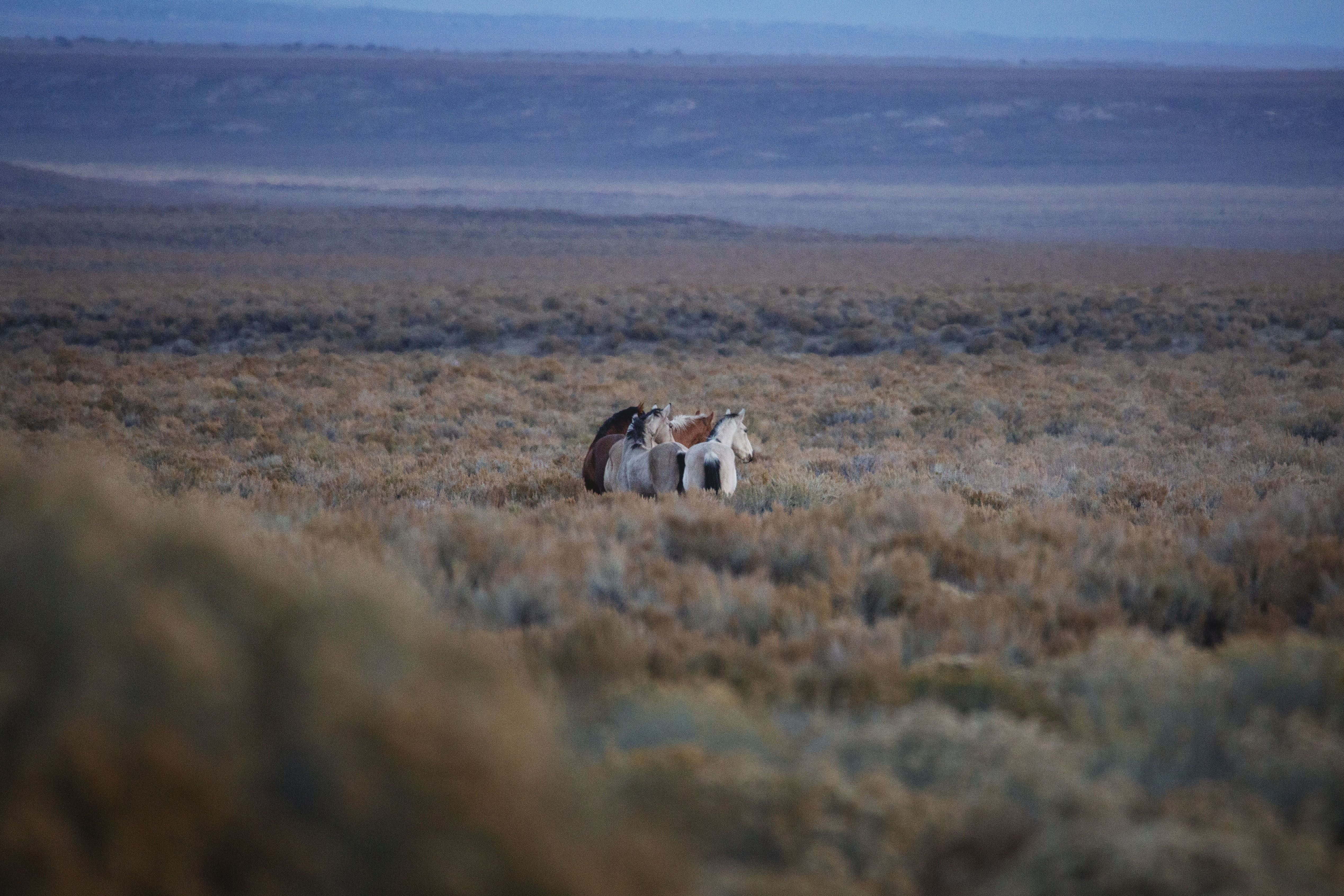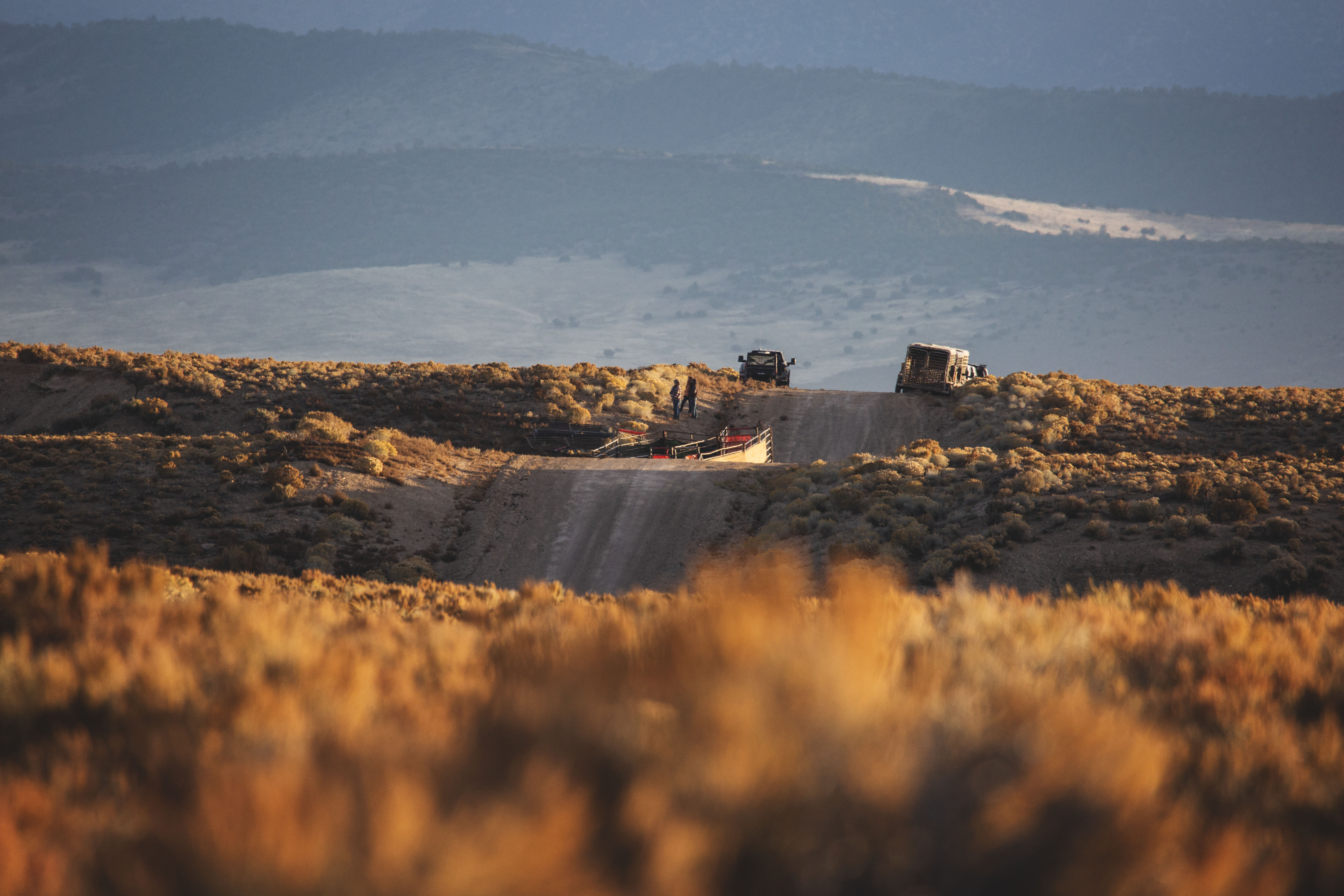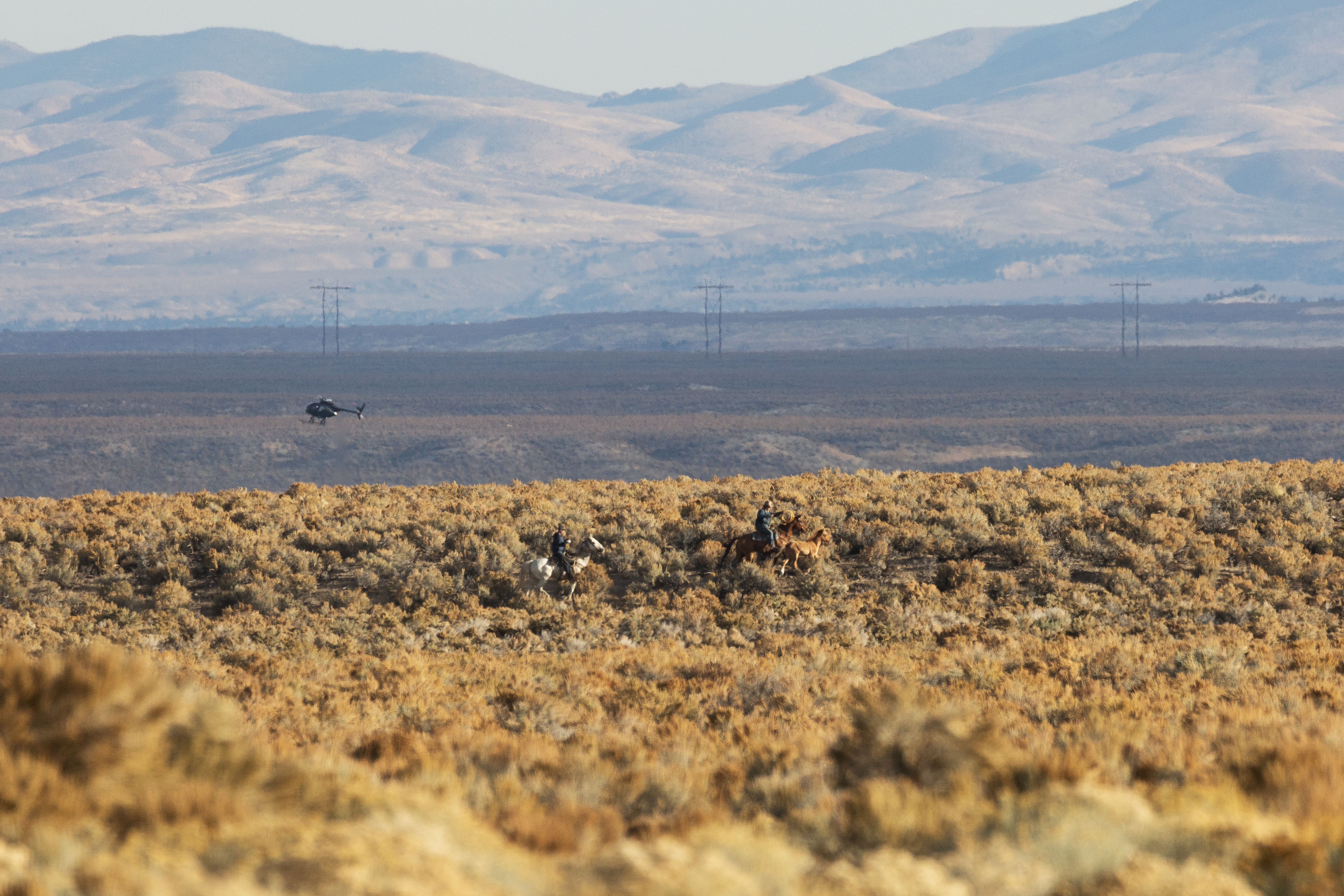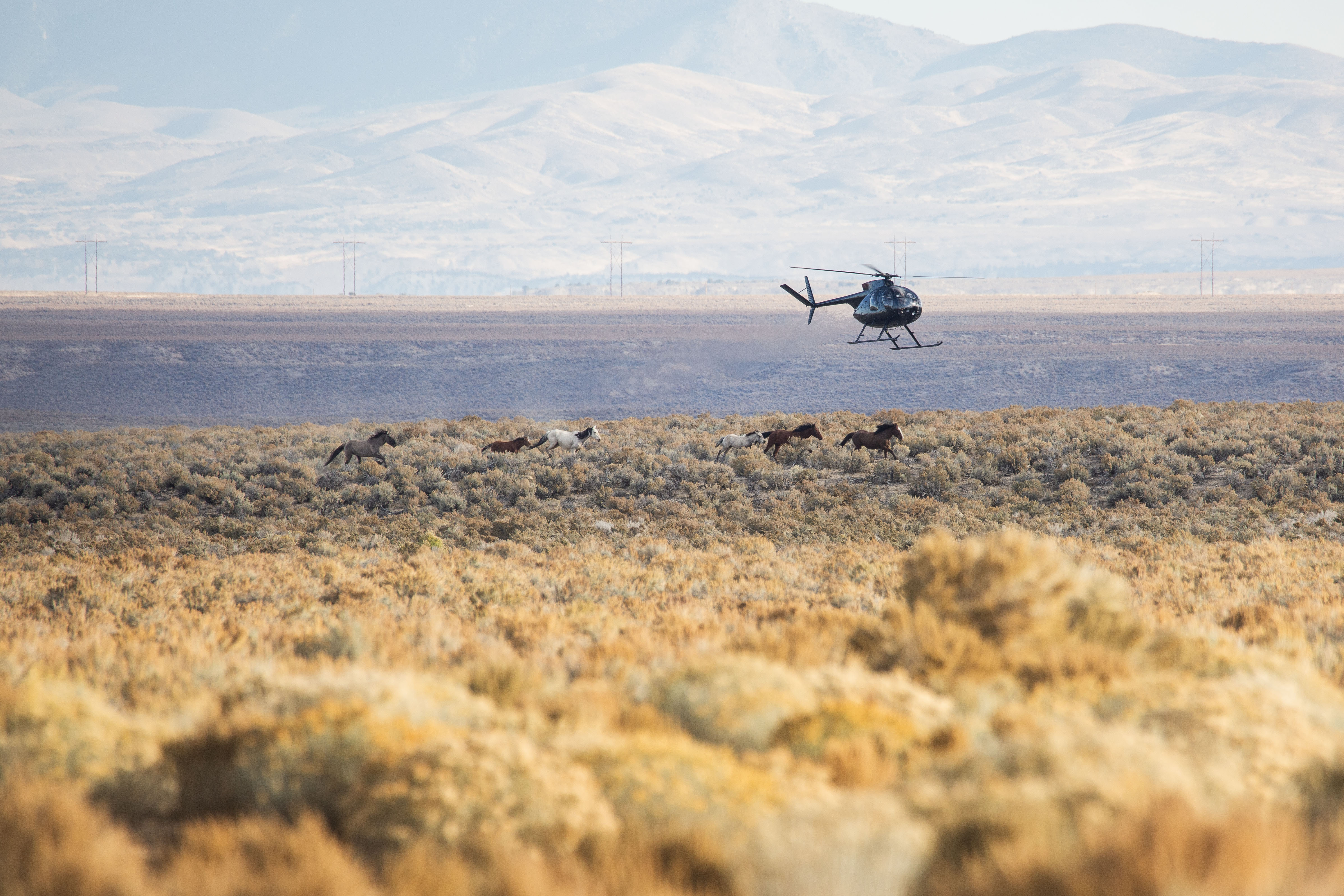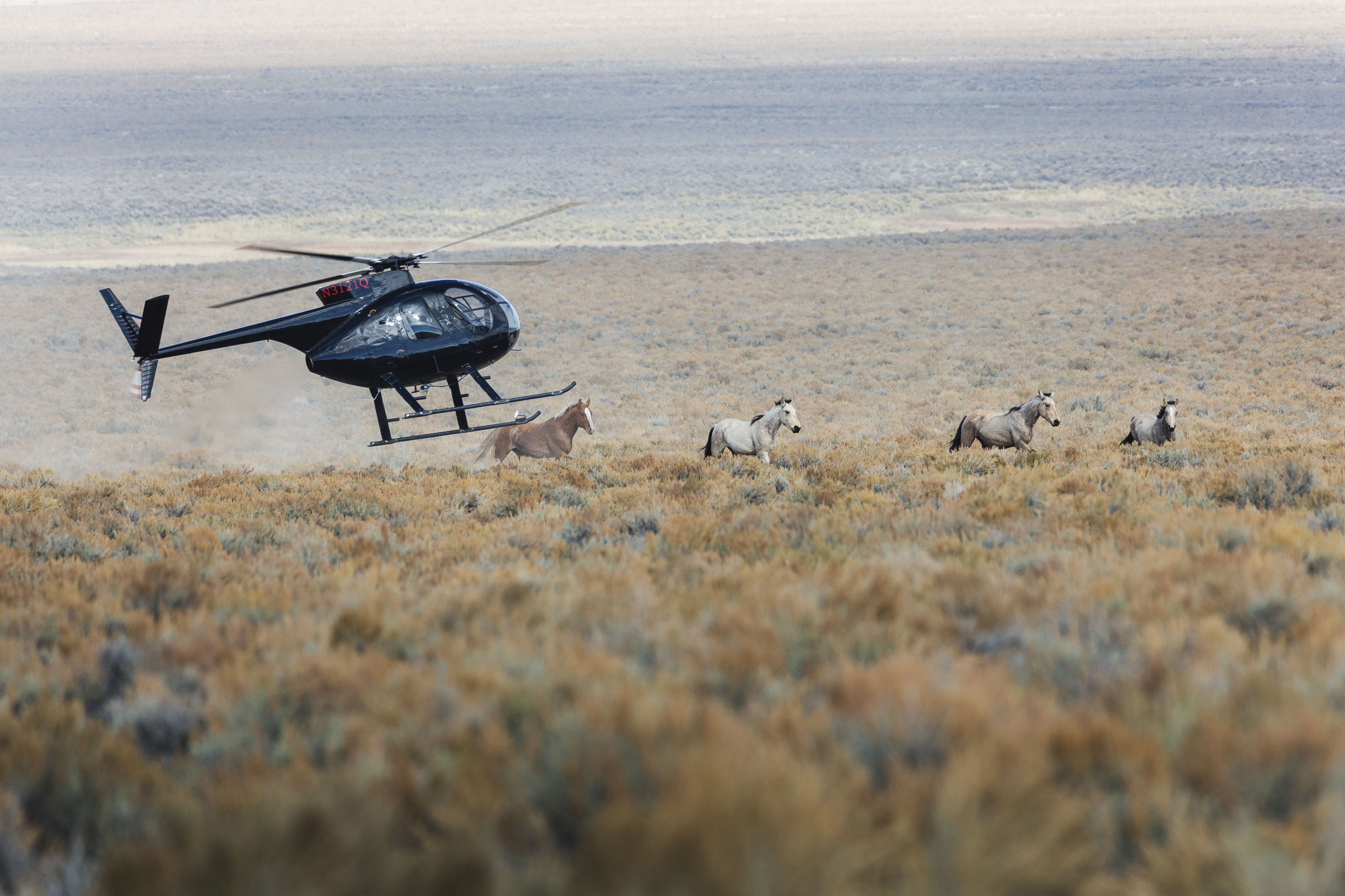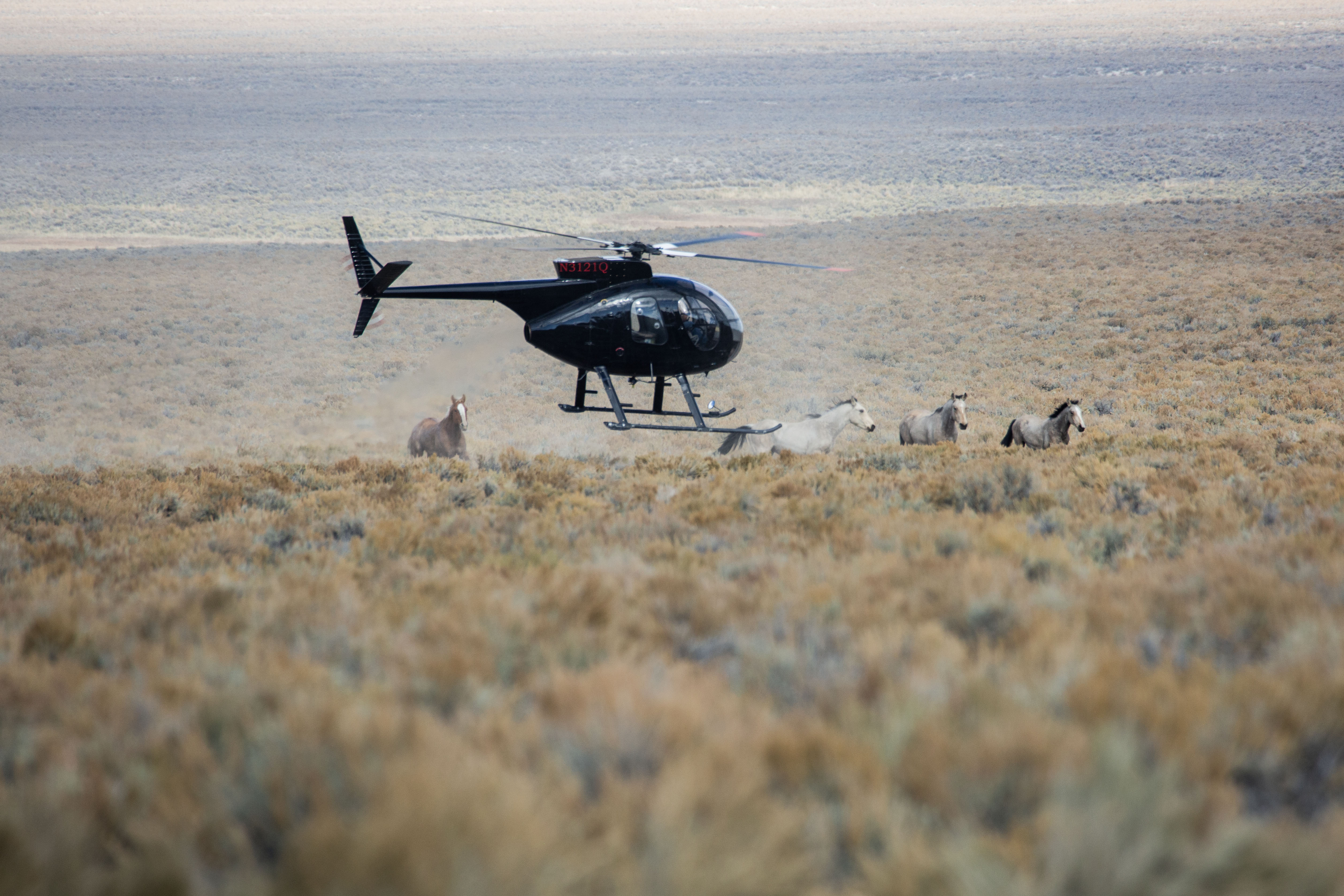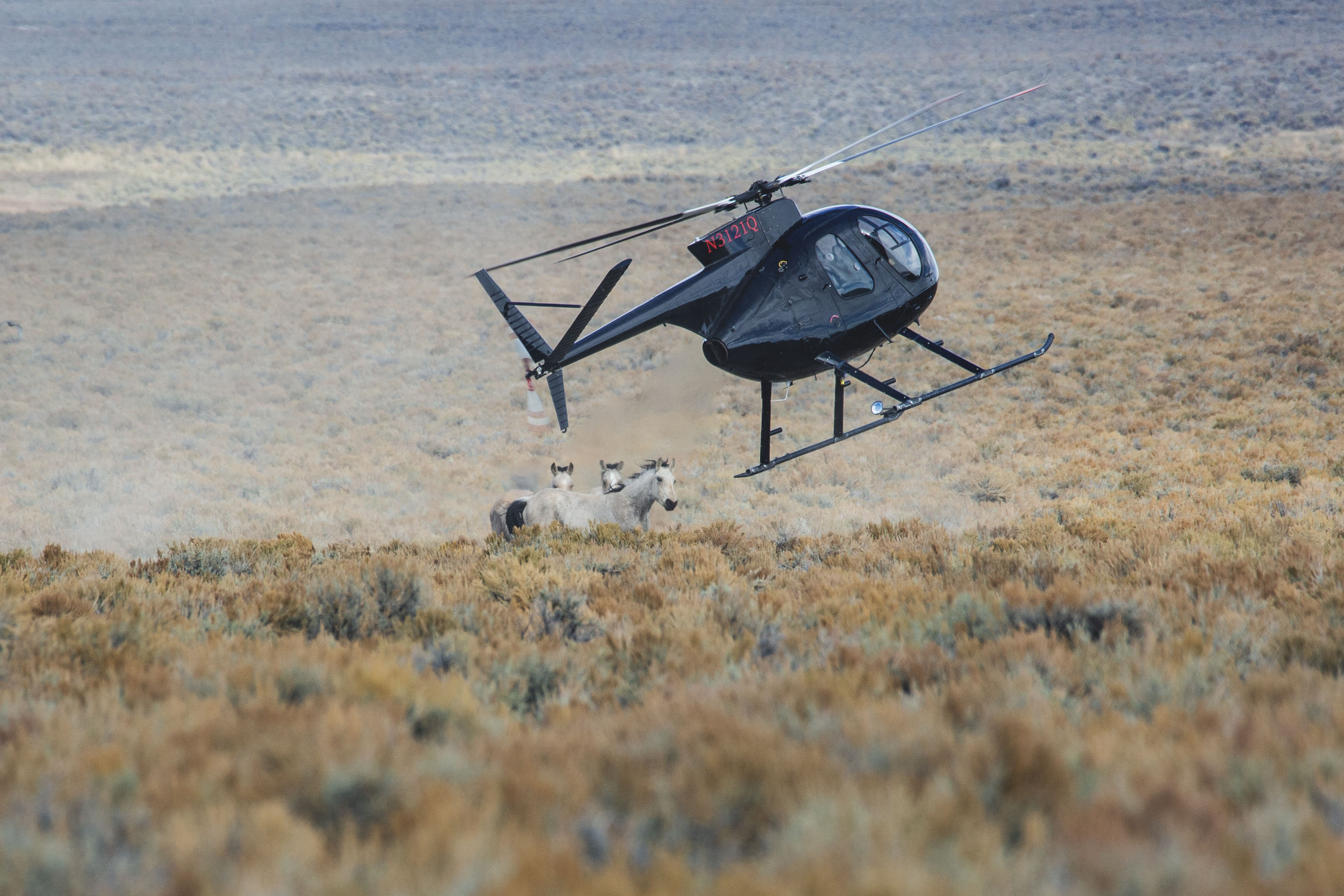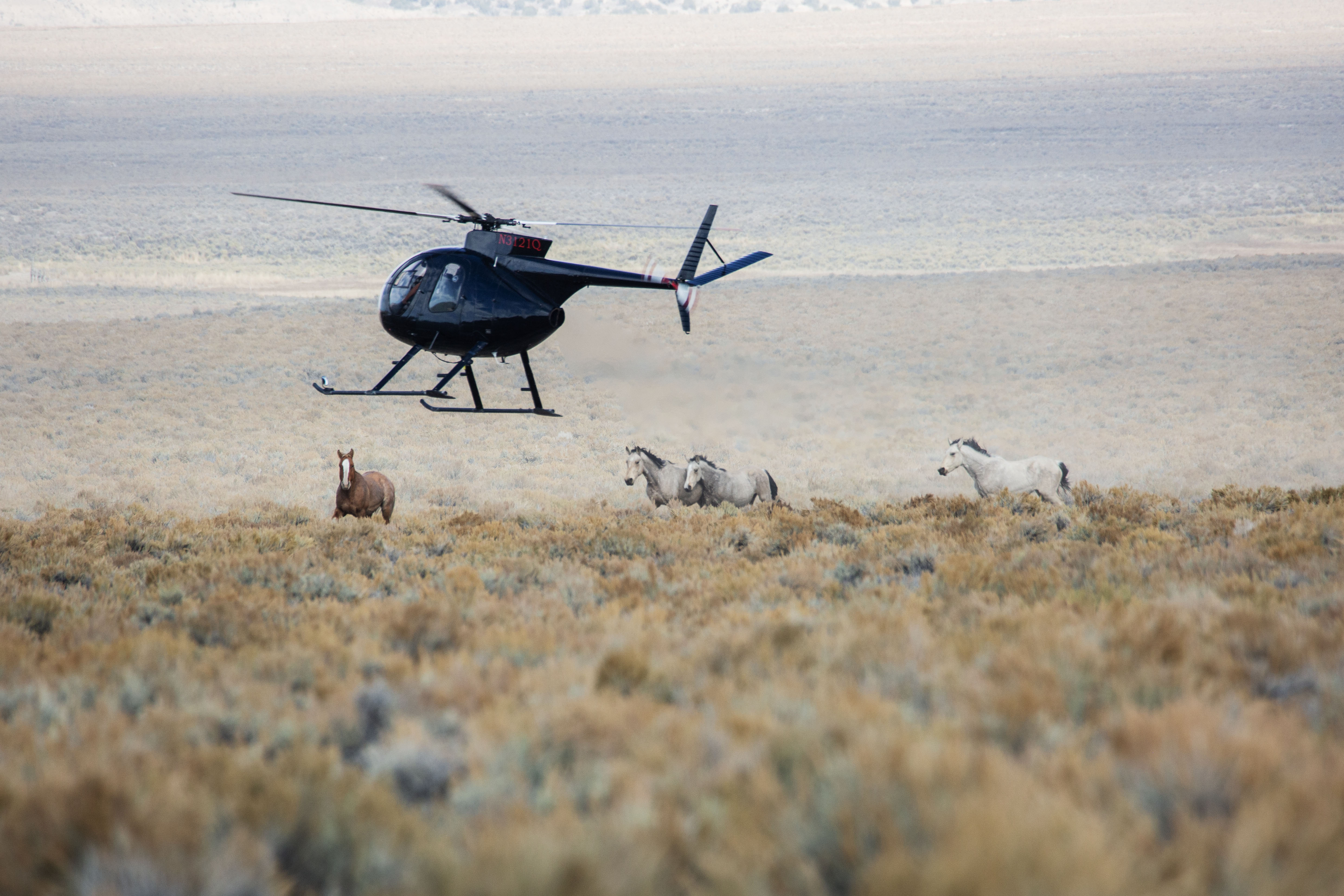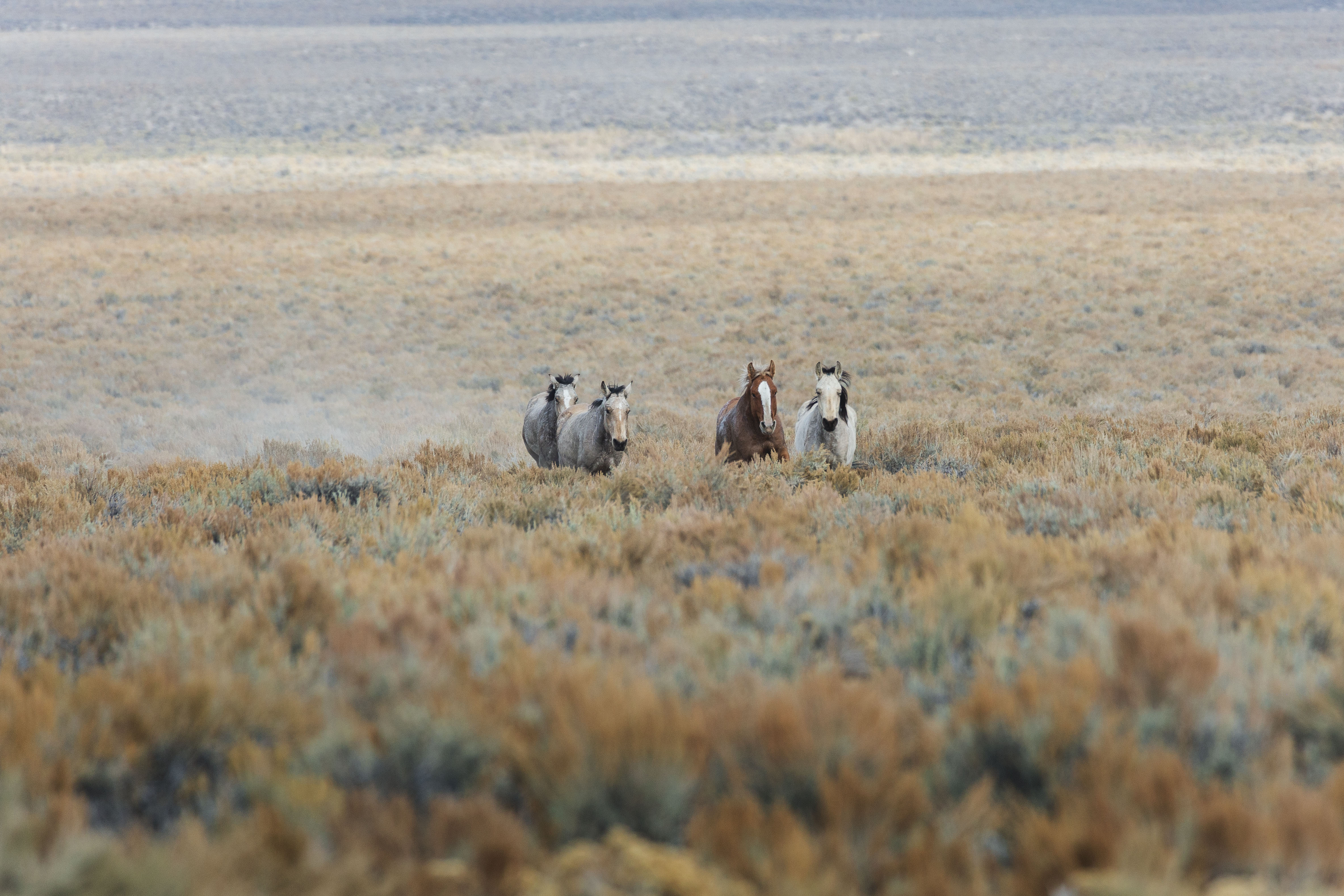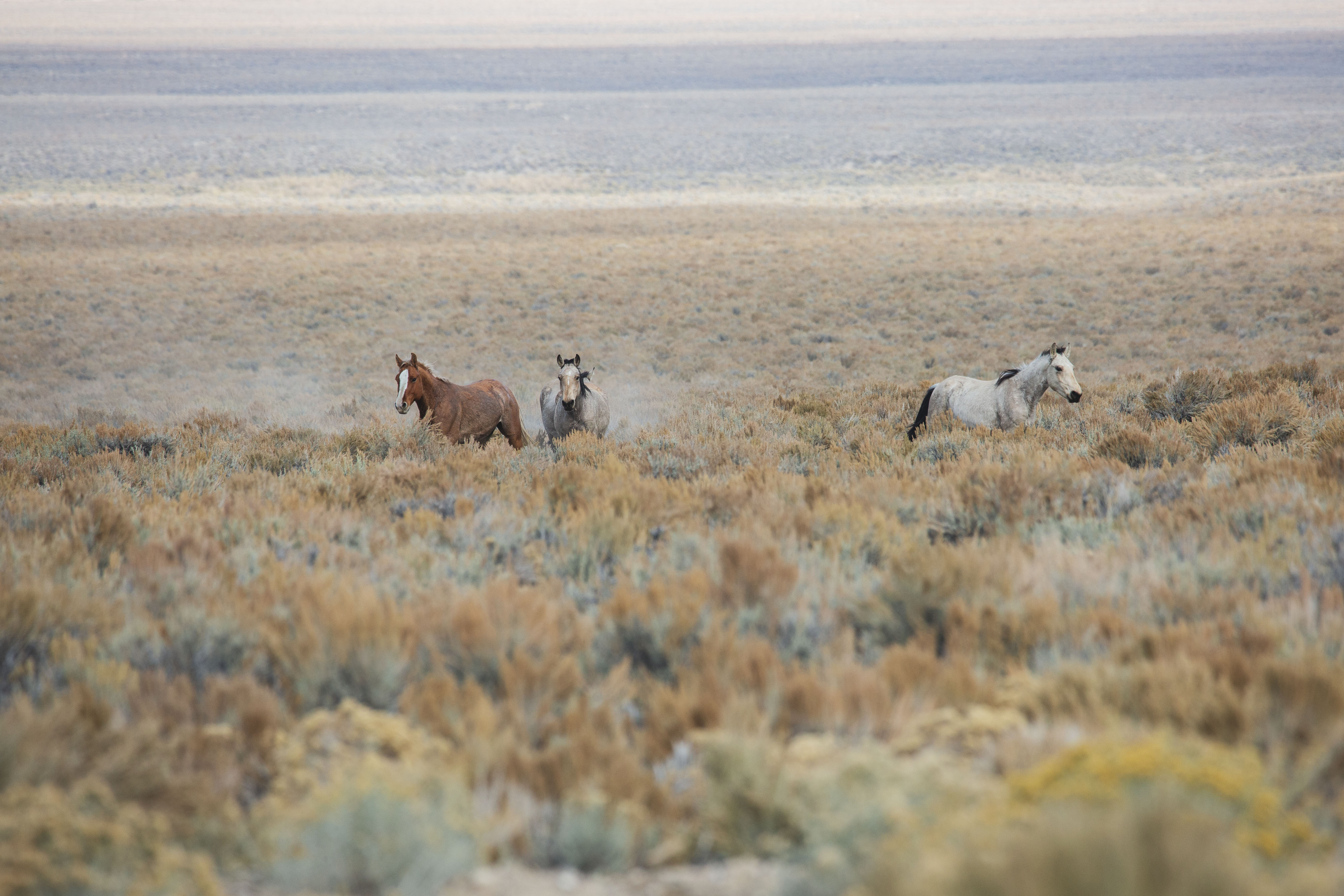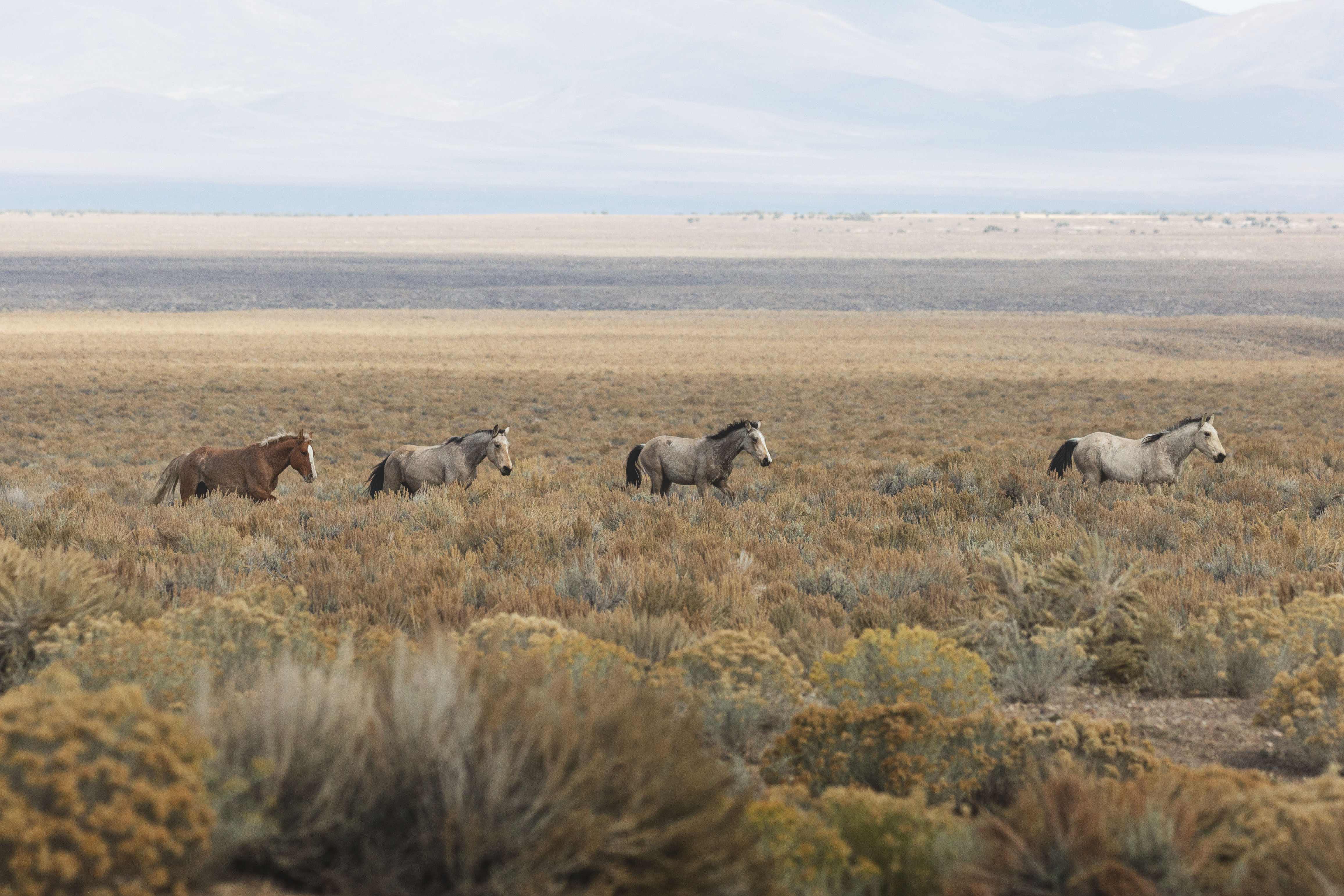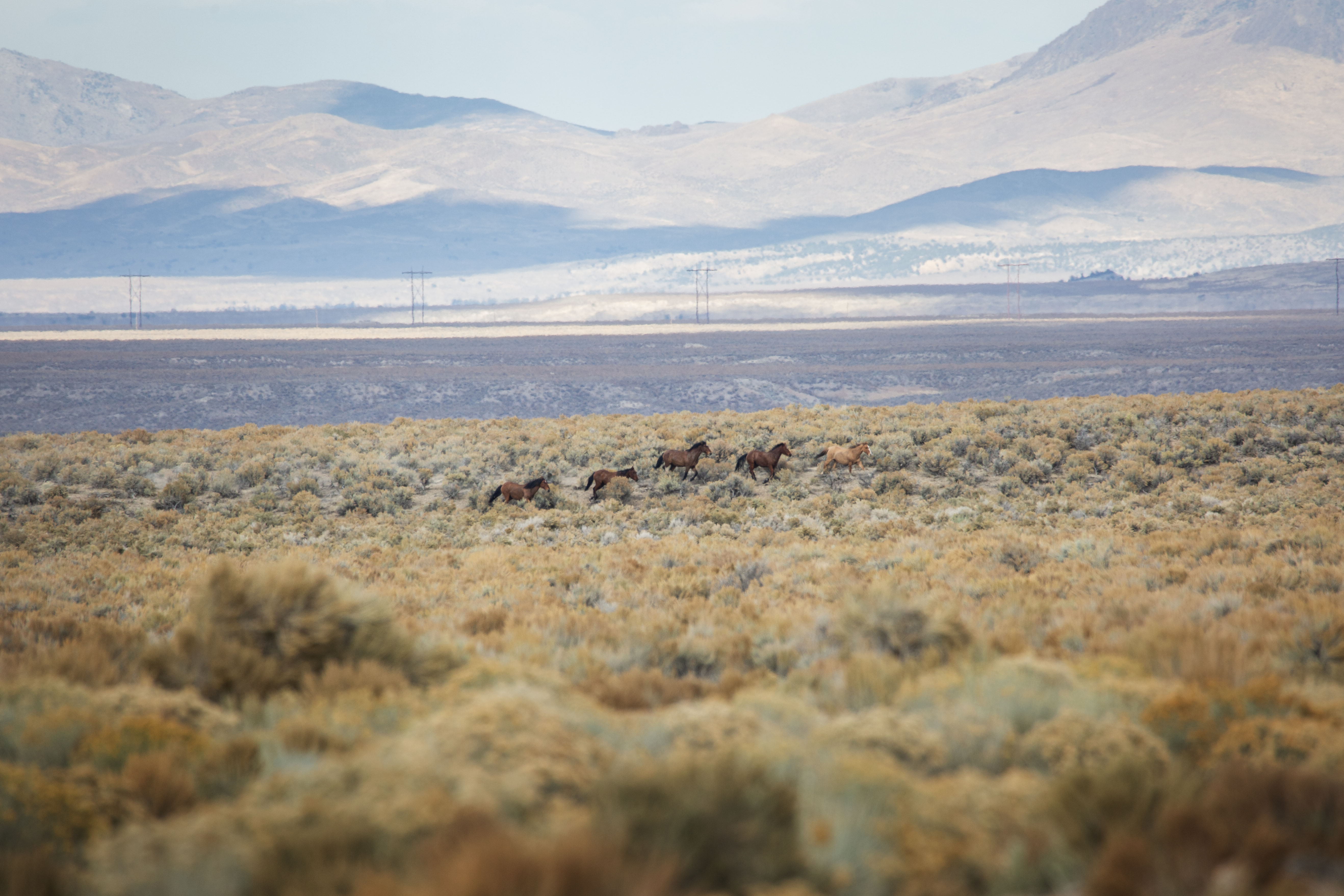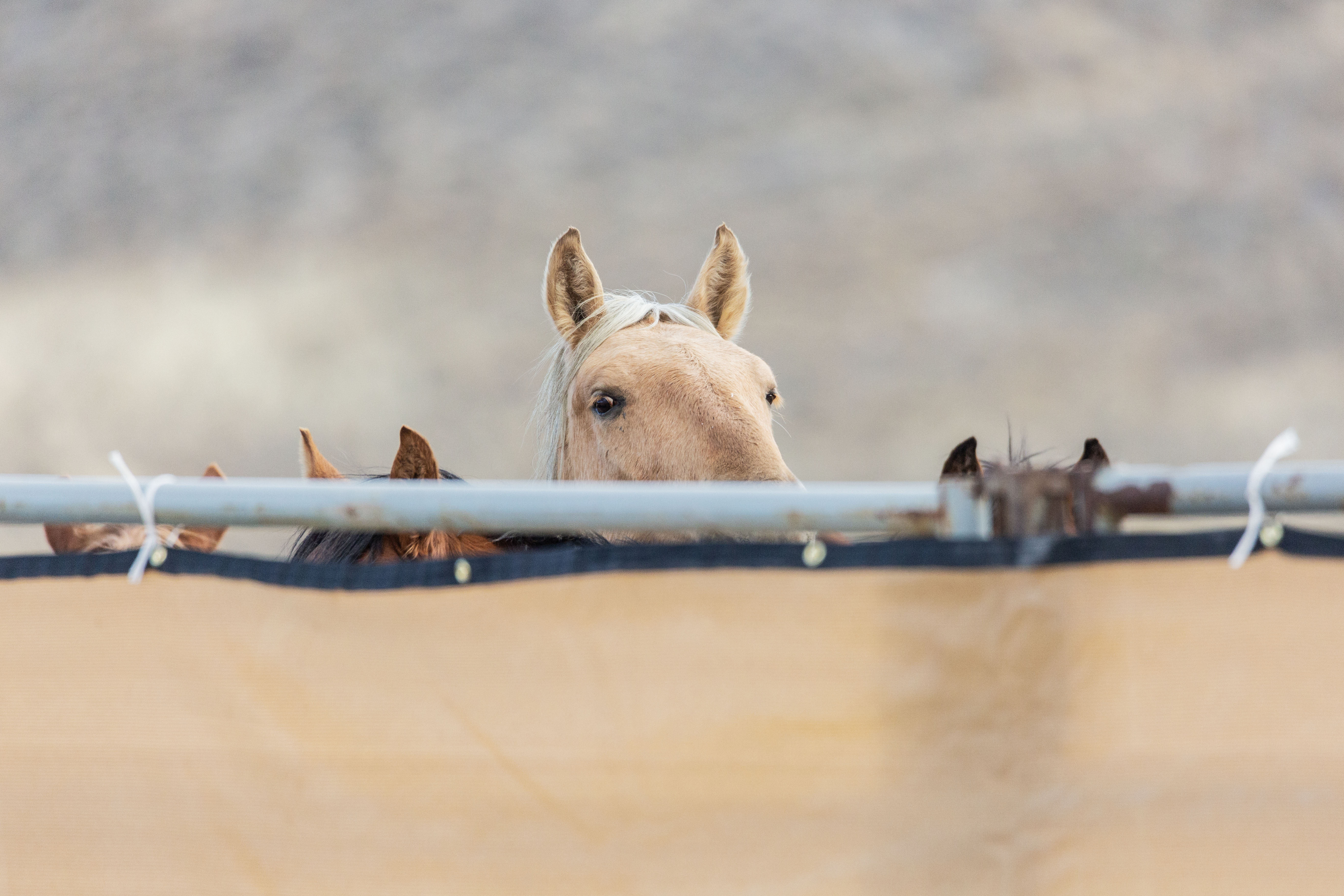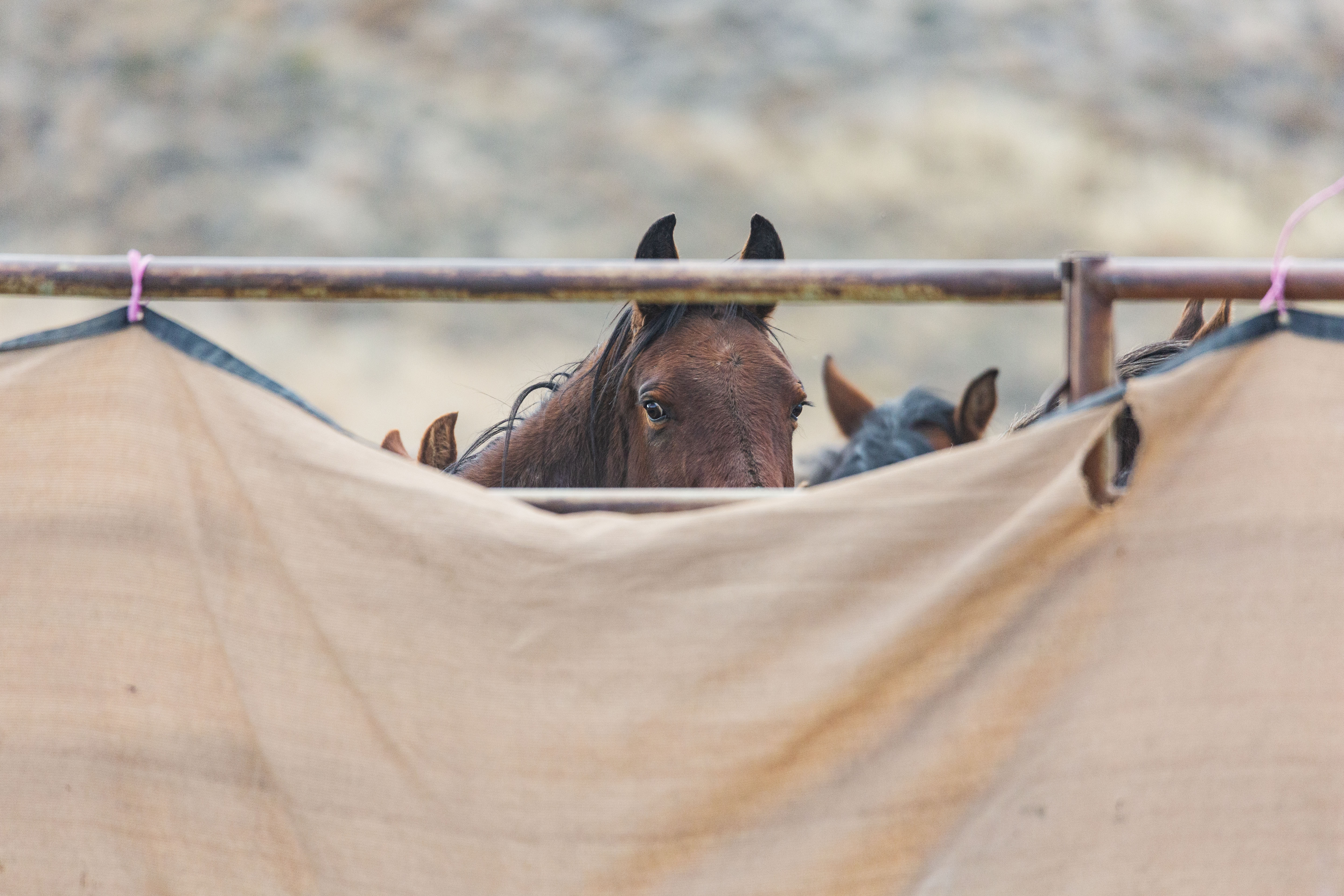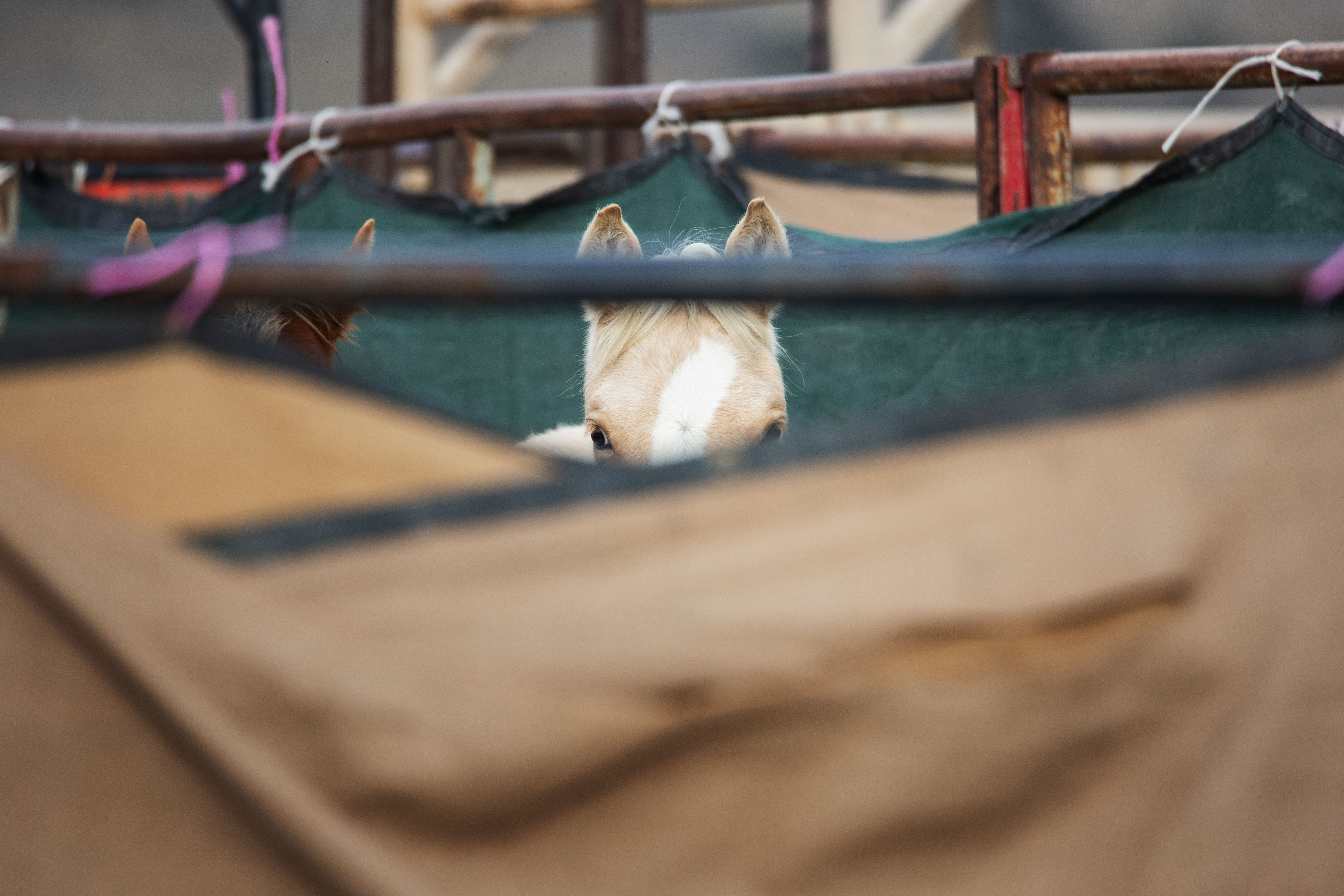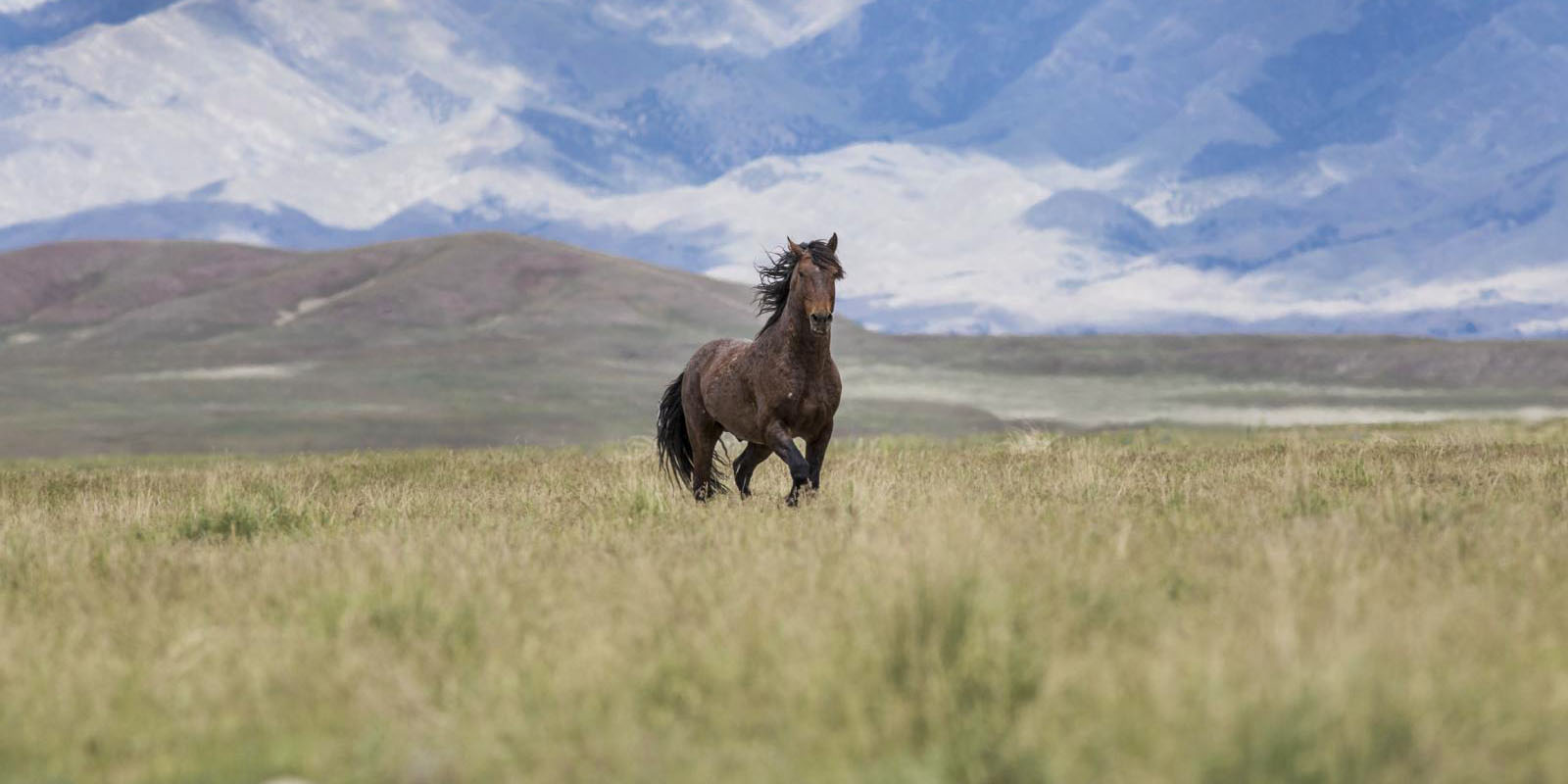Starting around October 22, 2023, the Bureau of Land Management (BLM) intends to conduct a wild horse roundup in the Roberts Mountain Complex area of Eureka County, Nevada. This area is located about 20 miles northwest of Eureka, west of State Highway 278, and north of U.S. Highway 50. The Roberts Mountain Complex covers approximately 556,500 acres of both public and private lands. The designated Appropriate Management Level for wild horses in this area is between 110 and 184 – or 1 horse for every 3,000+ acres. The BLM plans to stampede the horses with a helicopter to capture around 1,106 wild horses during this operation. They aim to remove approximately 1,068 excess wild horses and administer the controversial GonaCon Equine vaccine to up to 19 mares as a population suppression fertility control measure. After treatment, these mares, along with up to 19 stallions, will be released back into the range.
Roundup Report
November 4, 2023: Approximately 10 wild horses were rounded up from the Roberts Mountain Complex
Today we left Eureka at 8:15 to the new trap site (trap 6). This trap is located far outside the HMA just outside Eureka County (in Lander County) by Ackerman Canyon.
We arrived at the trap site at 9:20 a.m. after the first run had already occurred. We had a very good view of the trap and wings.
The first run consisted of 3 horses and I was told they were hanging out close to where the trap site was set up.
At 10:45 I saw a group of 4 and 3 coming down the mountain. They had split up and the 4 headed south into a big valley. The remaining 3 were all buckskins and did not want to cooperate and they scattered all over the place multiple times giving the pilot a very hard time. At one point the pilot decided to pursue a single mare. She would not back down and go the opposite way of where the pilot wanted her to go. The pilot came so close (several times) that her mane and tail were caught by the high wind velocities the helicopter created.
Three wranglers came out and ended up roping the mare while the helicopter was still low flying trying to keep her from getting away. They did a professional job roping the mare but she didn’t go without putting up a fight.
As they were walking her to the trap, the pilot managed to capture the remaining two buckskins. After all three of them were in the trap site the pilot went out to get the remaining 4 horses who had run to the big valley. All of them made it into the trap safely.
A total of just 10 horses were captured today. The trap site is moving tomorrow.
November 3, 2023: Approximately 14 wild horses were captured.
Today was a short day with only around 14 horses captured in total. We left Eureka around 6:30 to the same trap site (trap 5) located in the SW corner of the Roberts Mountain HMA. I heard the helicopter in the air at around 8 a.m. It took him 3 hours to scout for horses and bring in a total of 6. An hour later 8 more horses were found and pushed into the trap. I noticed they were quite sweaty, though the high reached was 60ºF.
All the horses were loaded up in one trailer and shipped to temporary holding. The condition of the roads has been very good because of the mining traffic, but they are still driving these trailers way too fast for my liking. I was notified that the trap site would be moved the next day
November 2, 2023: 44 horses were captured. One 9-year-old mare was euthanized due to a pre-existing blind left eye.
I arrived at Trap Site 5 in the early morning, accompanying the BLM as they set out from Eureka, Nevada, around 6:30 AM.
The first two runs I documented consisted of seven and four horses. The group of 4 horses gave the pilot a hard time and one of the horses broke off from the the group and bolted up the hill. After the pilot had brought the three remaining horses into the trap, he tried to get the single horse to turn around but didn’t succeed so the wranglers were deployed. Now there was a helicopter and three wranglers out to capture one horse. Once the pilot was able to push the horse towards the wranglers and they got him within just a few minutes. From what I could see the horse didn’t put up much of a fight and they did a clean job roping him. He was then walked to the trap site.
Two hours later six horses came safely into the trap site. At 1 pm another 6 horses came in making a total of 24 now. They all loaded onto the trailer with no issues. The pilot took off looking for horses in a big valley to the northwest of us. He managed to get several bands to group together with a total of 20 horses. The horses traveled through the valley mostly at their own pace as the pilot stayed back at a safe distance as long as they were traveling in the right direction. They arrived at the trap around 2 pm. Right before entering the wings some of the horses scattered and I saw a band take off up on the hill while he pushed in most of the horses. All 20 horses ended up making it into the trap site safely.
Interestingly, today the contractors had to go out and open up fencing/gates so they were able to push the horses through towards the trap site. This has happened a lot in this particular roundup.
After the conclusion of the roundup, as we arrived at the temporary holding they were still sorting some horses. After the horses were all sorted they were given fresh hay and water. We can only do a walk around when they are done with feeding and watering so we had to wait quite a bit. Some of the pens were quite loud and the horses seemed agitated but it’s normal since new horses just came in and there was a lot going on.
November 1, 2023: Between 35-58 wild horses were captured (the BLM has not updated its number at the time of this report)
The new trap site (trap 5) is located on the far southwest side of the Roberts Mountain HMA about a 50 minute drive from Eureka.
The initial location for observation was 1.5 miles away, but efforts were made to get us closer. We ended up having a good view of the wings and the trap. Distance in combination with the “heat” distortion still makes it challenging.
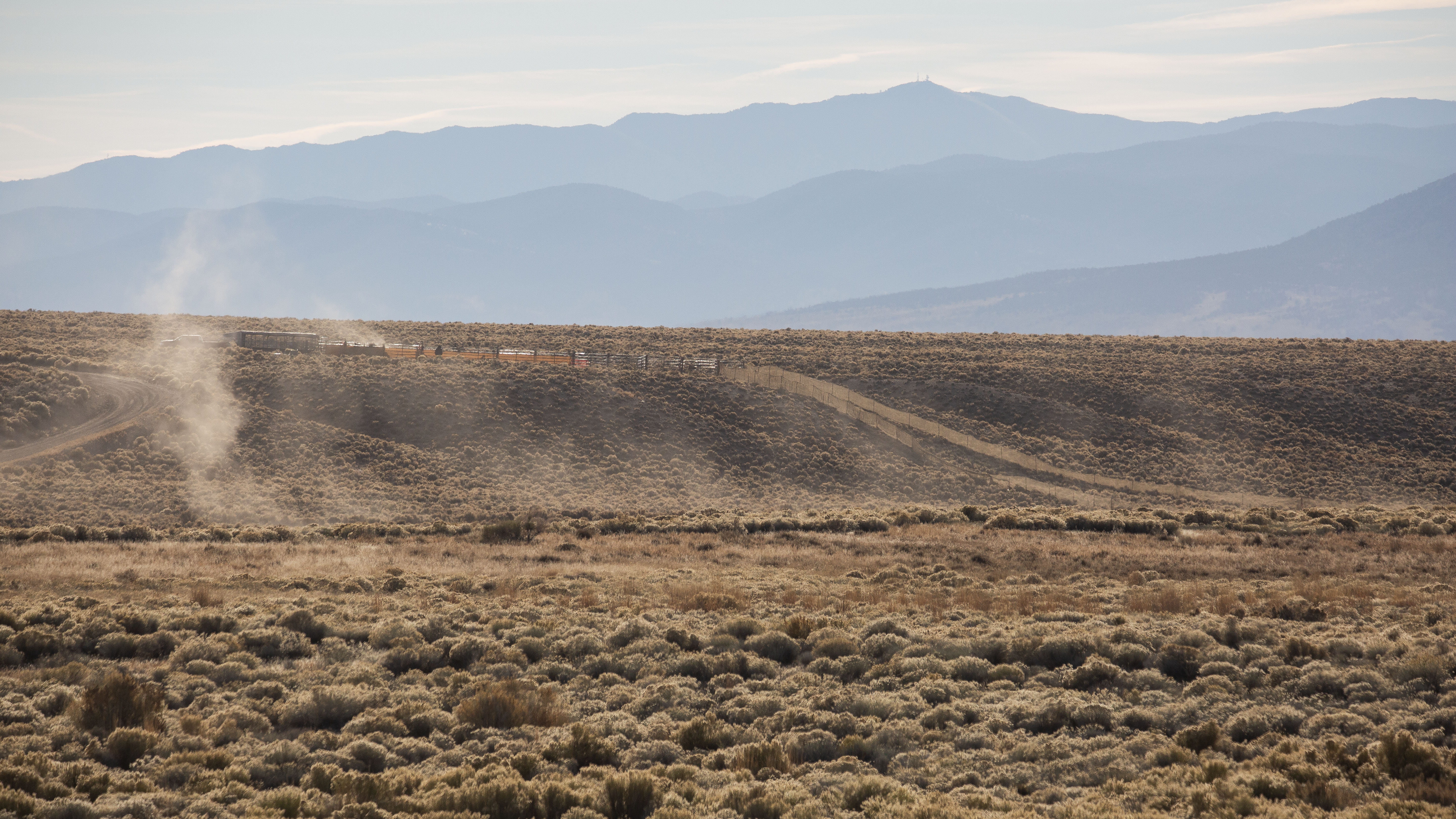
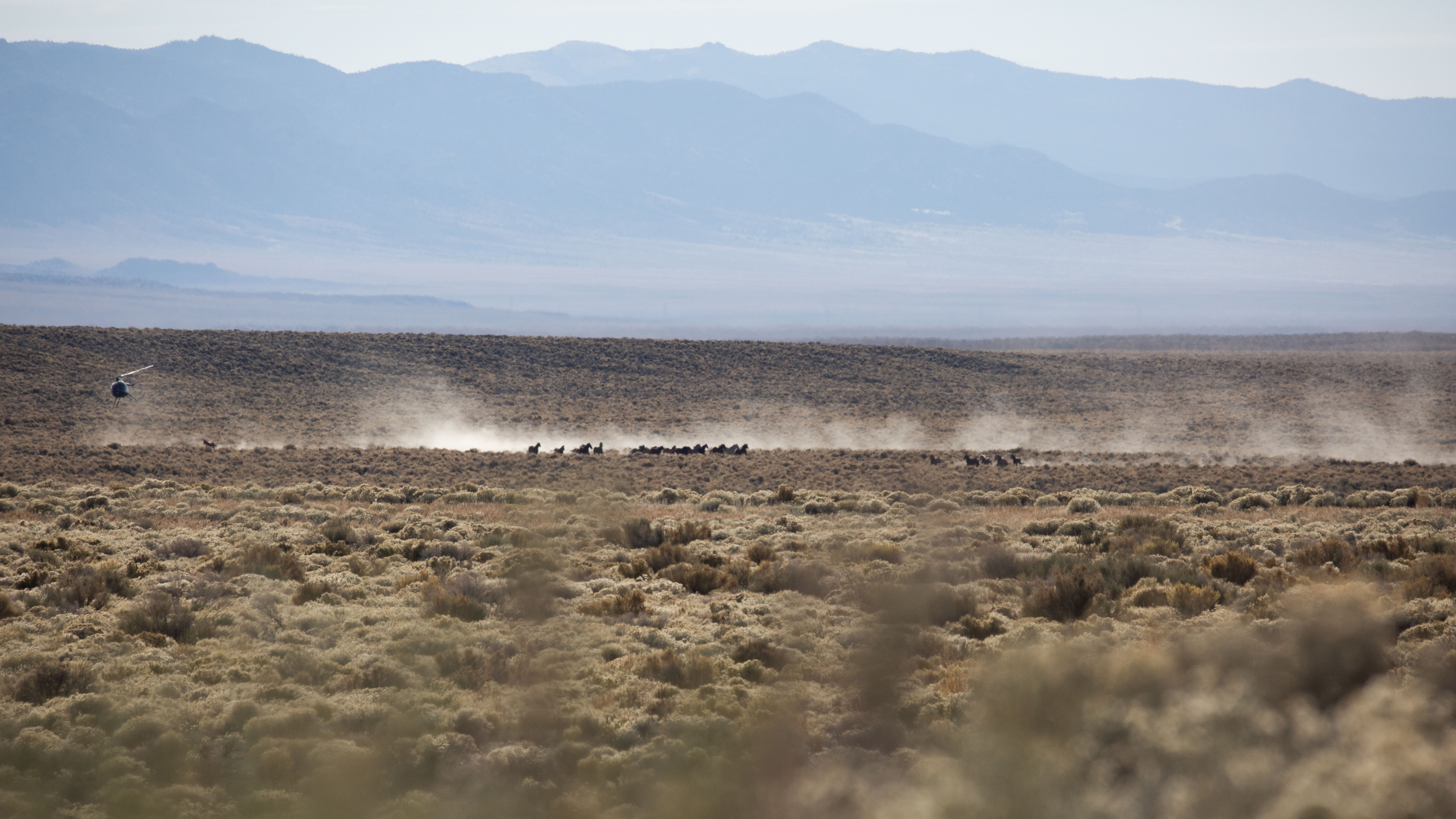
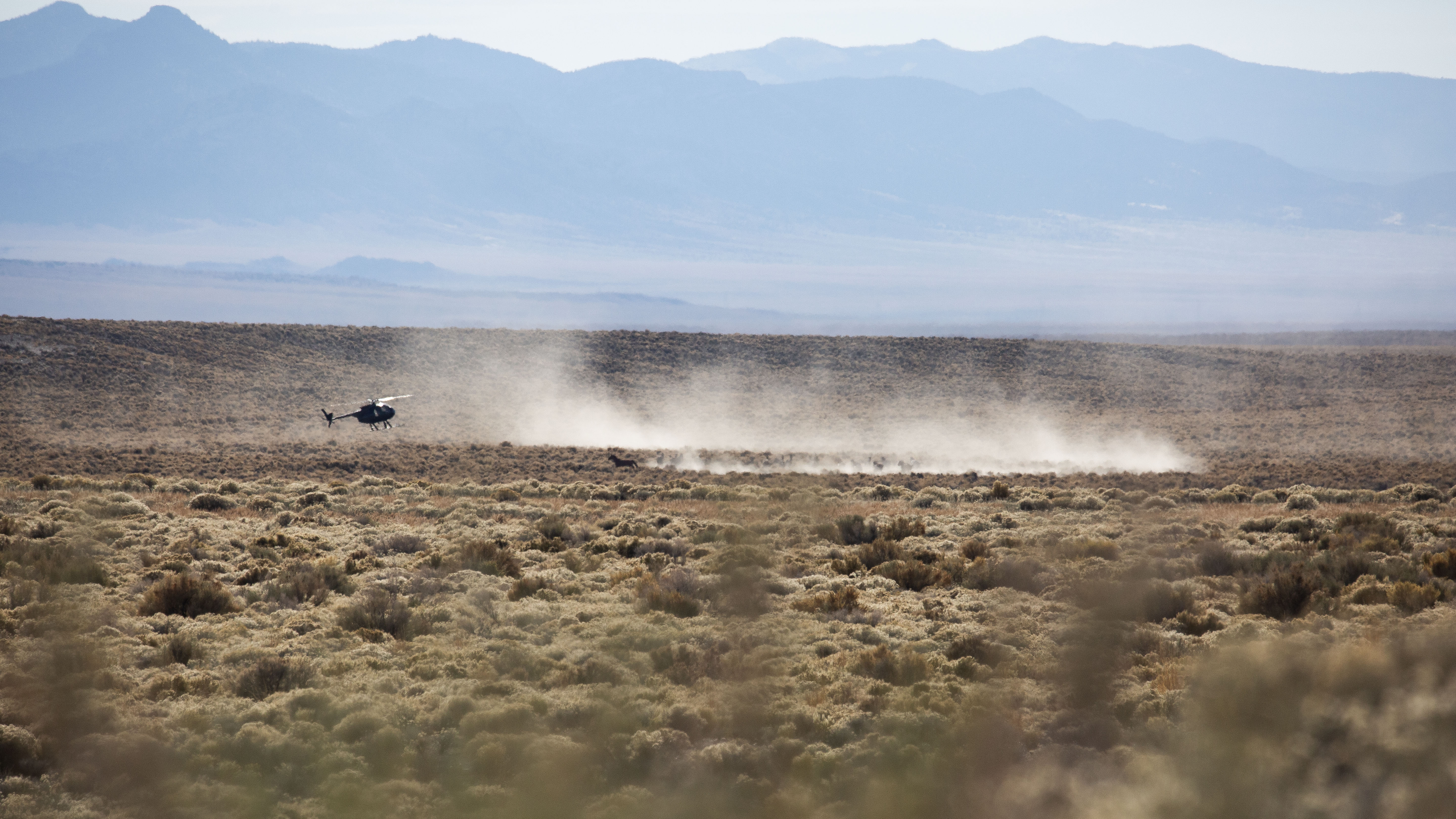
The first run came in at 9 am with less than 10 horses. And at 9:20 a large group of 30-40 horses came in. The horses all entered trap safely and they seemed to be having adequate space. A large group was being kept in the catch pen as trailer loads were going out.
The first trailer load passed us on the road and I noticed one of the horses was sitting down and unable to get up. Reviewing my photos there appears to be another horse that was sitting down. They were stuck at the back of the trailer unable to get up because of the other horses.
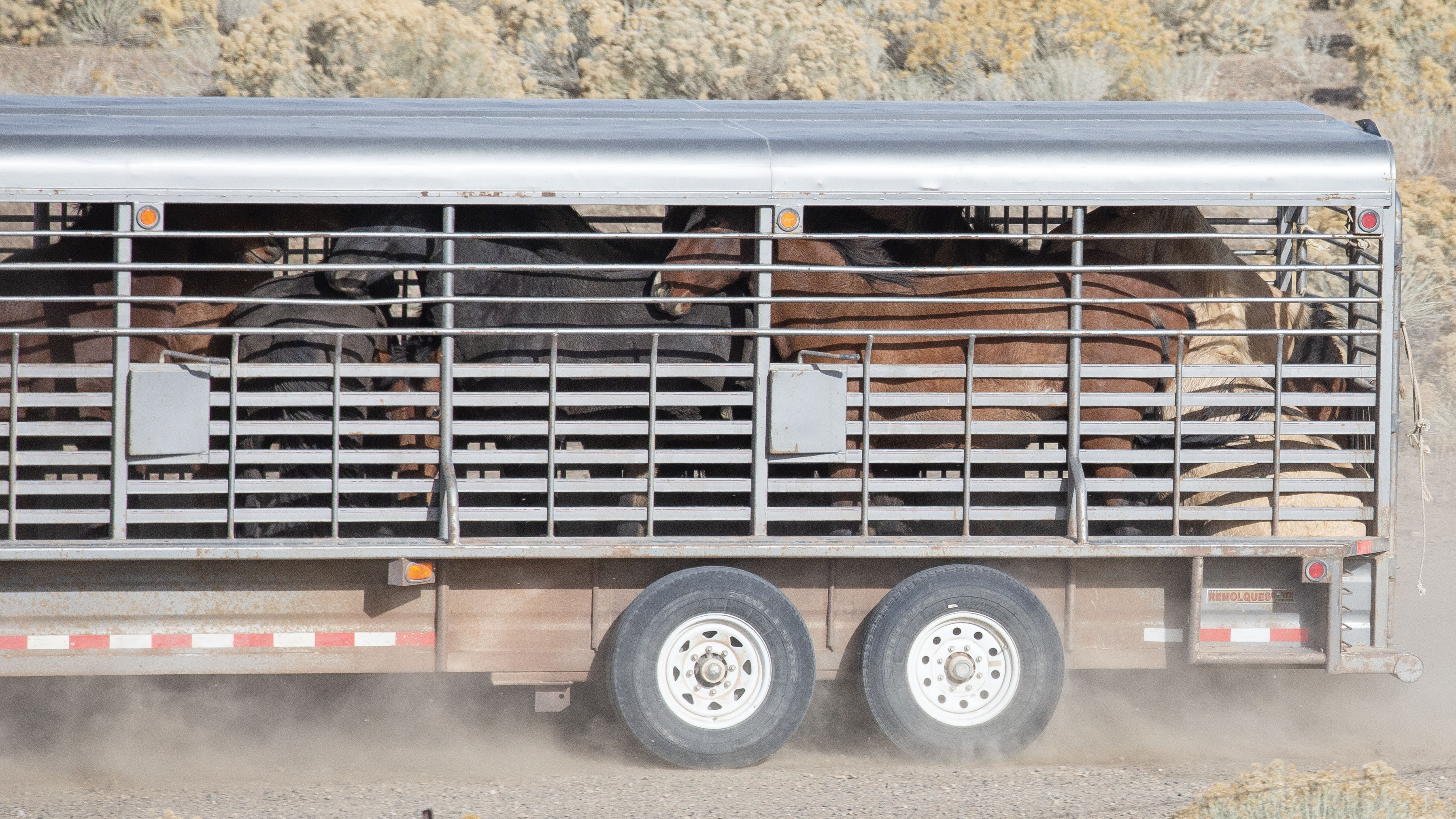
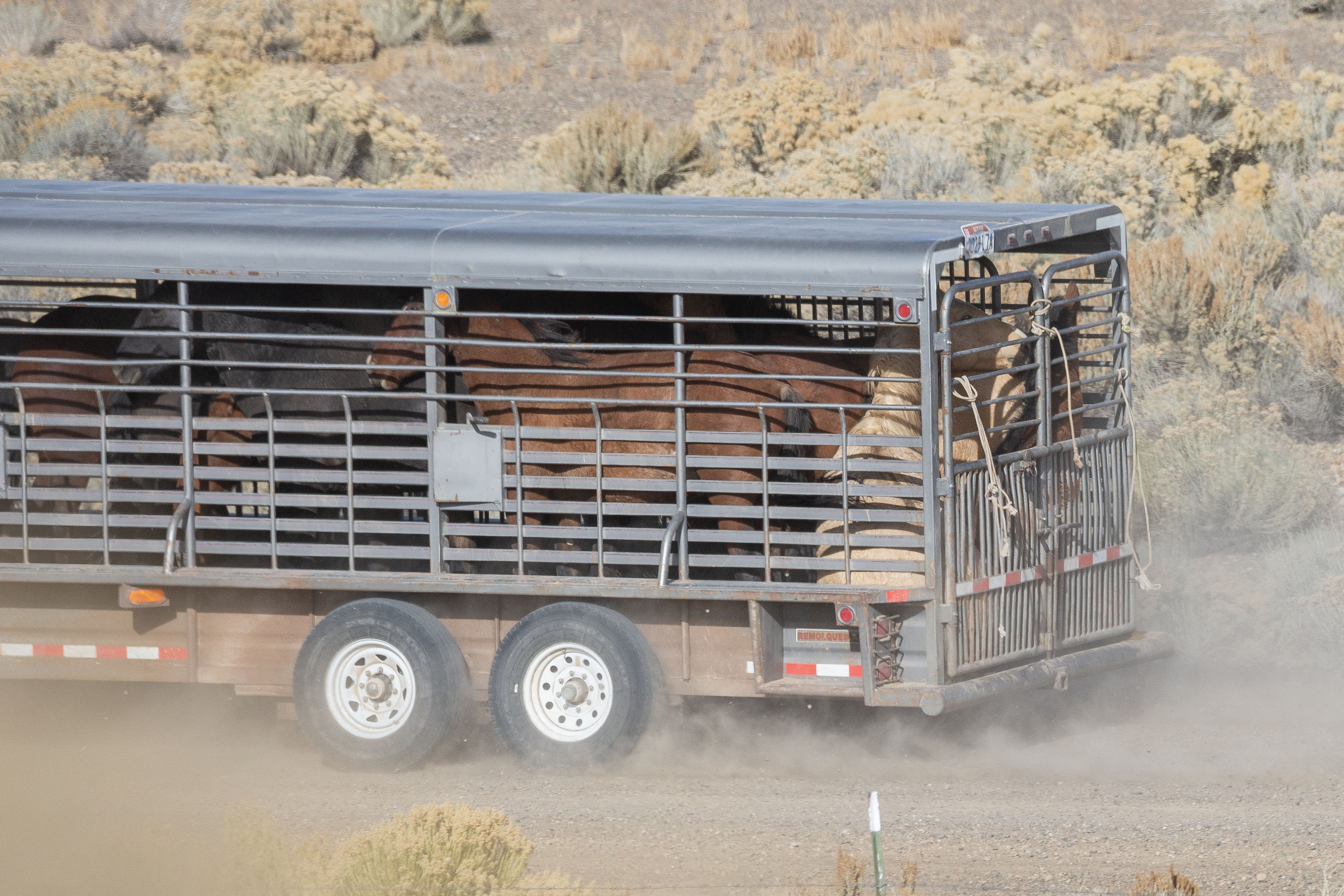
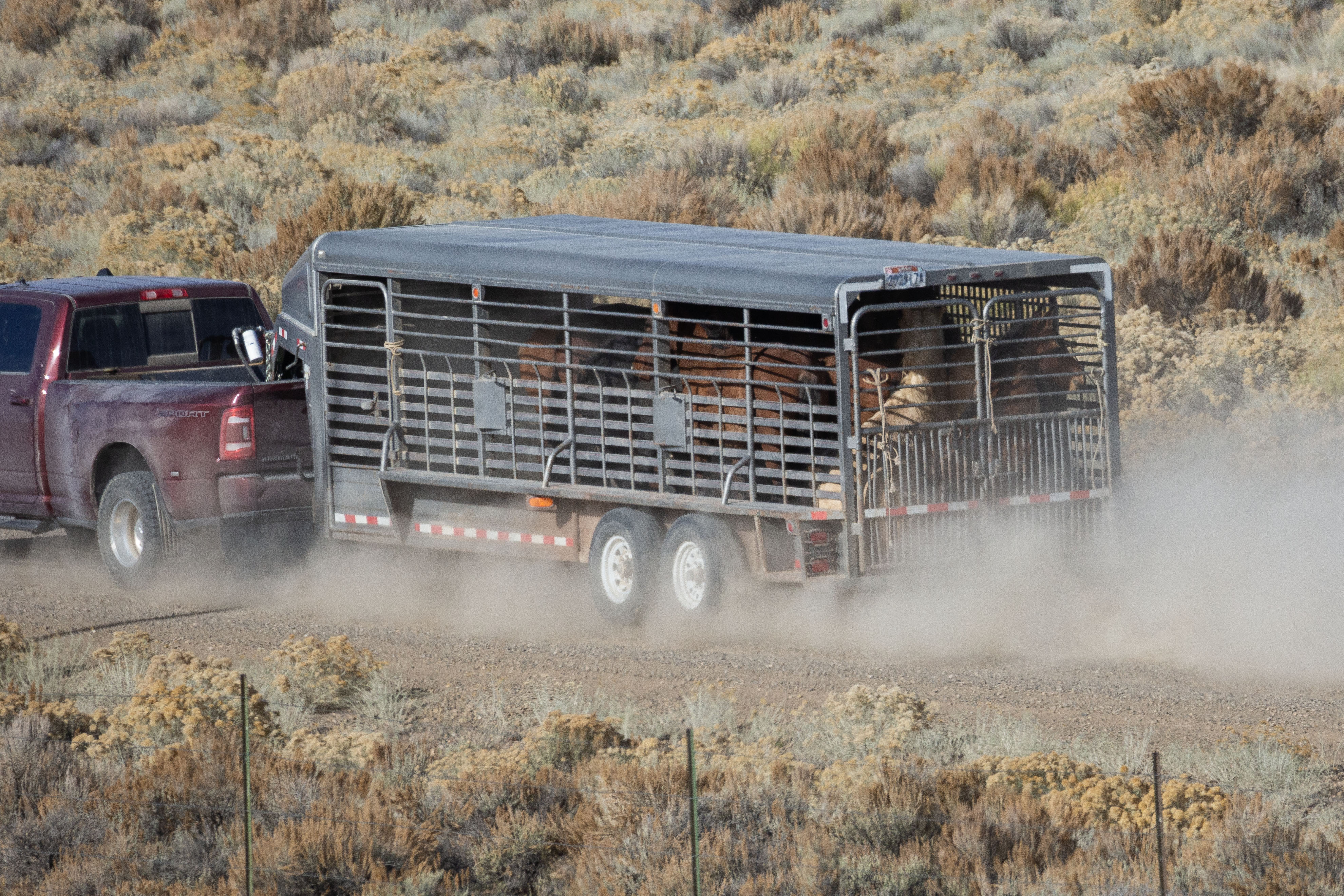
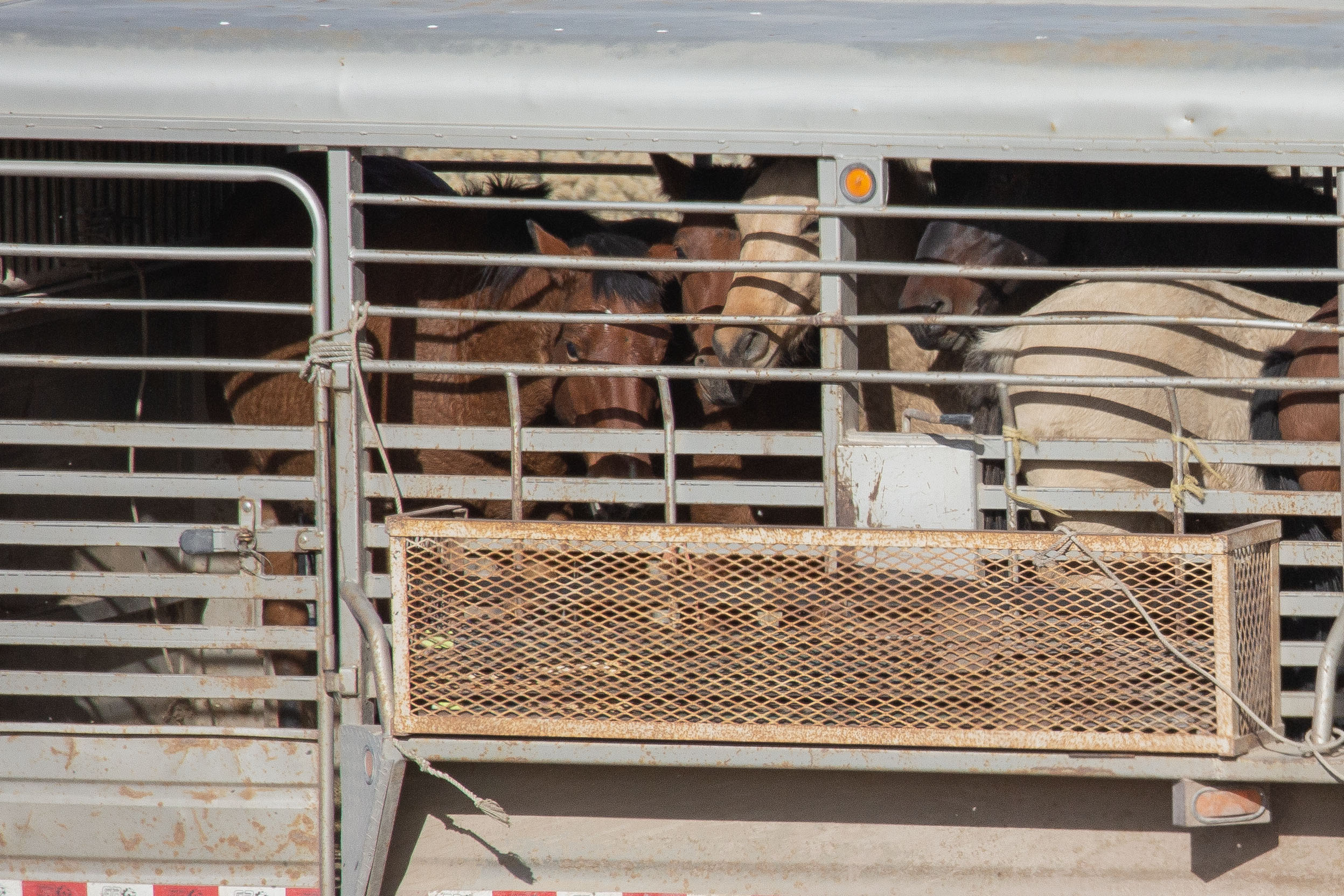
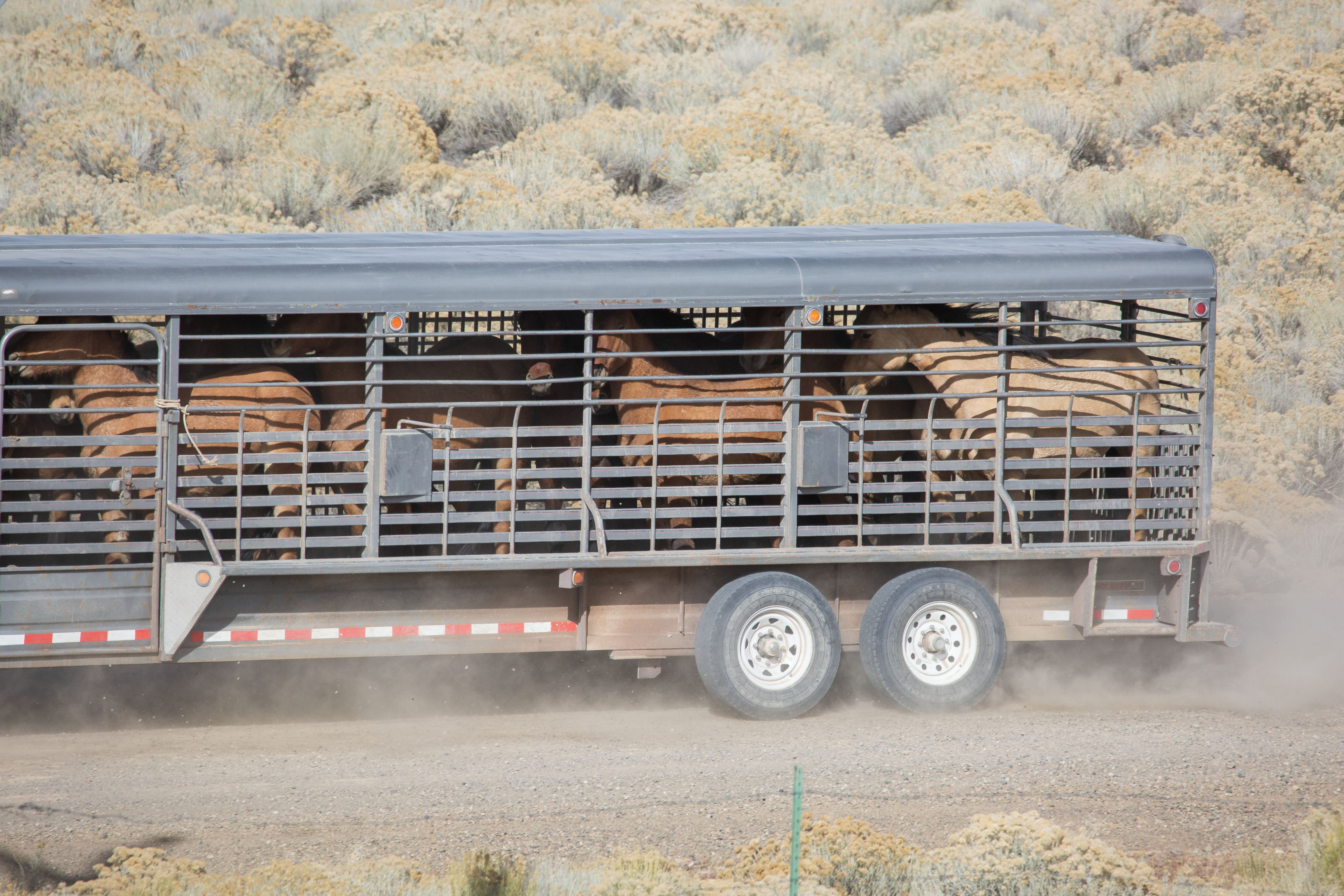
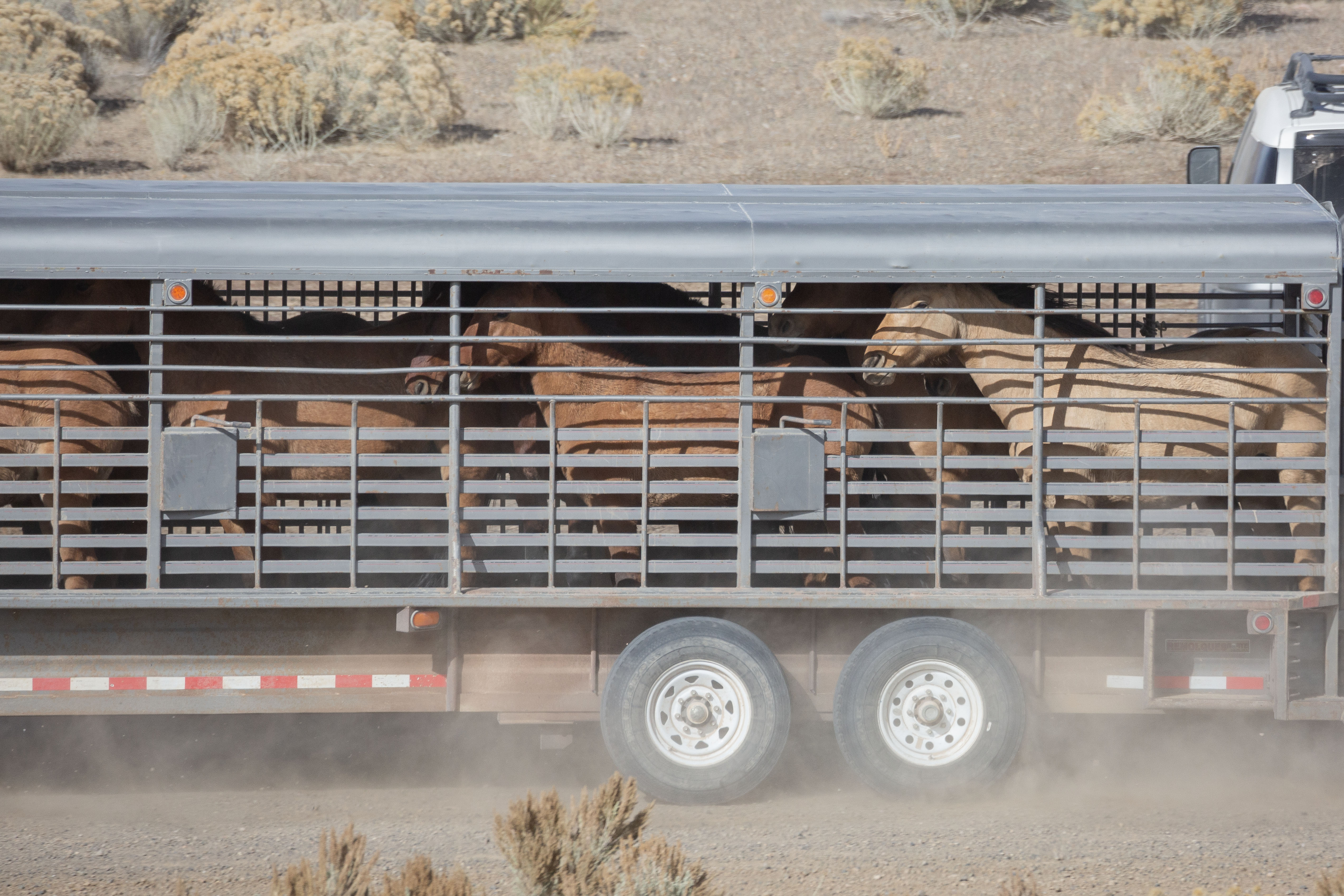
The IC was notified and the driver had stopped to check on them and reported he got them back up again. After this I noticed they checked every trailer load shortly after departure right before passing us. An hour after the last run the pilot came in with the next group of just 5 horses.
And then 2.5 hours later a group of 9 horses came in. Between 3 and 4 am the pilot made two more runs of 4 and 11 horses. Overall everything went well today (as far as I could see). On my way back to town I noticed a lone stallion hanging out at the foot of Lone Mountain off of HWY 50.
They were just done rounding up the horses in this area, other than this stallion I haven’t seen any horses that are left out here. This was also the same horse I saw hanging out by the highway before the roundup started.
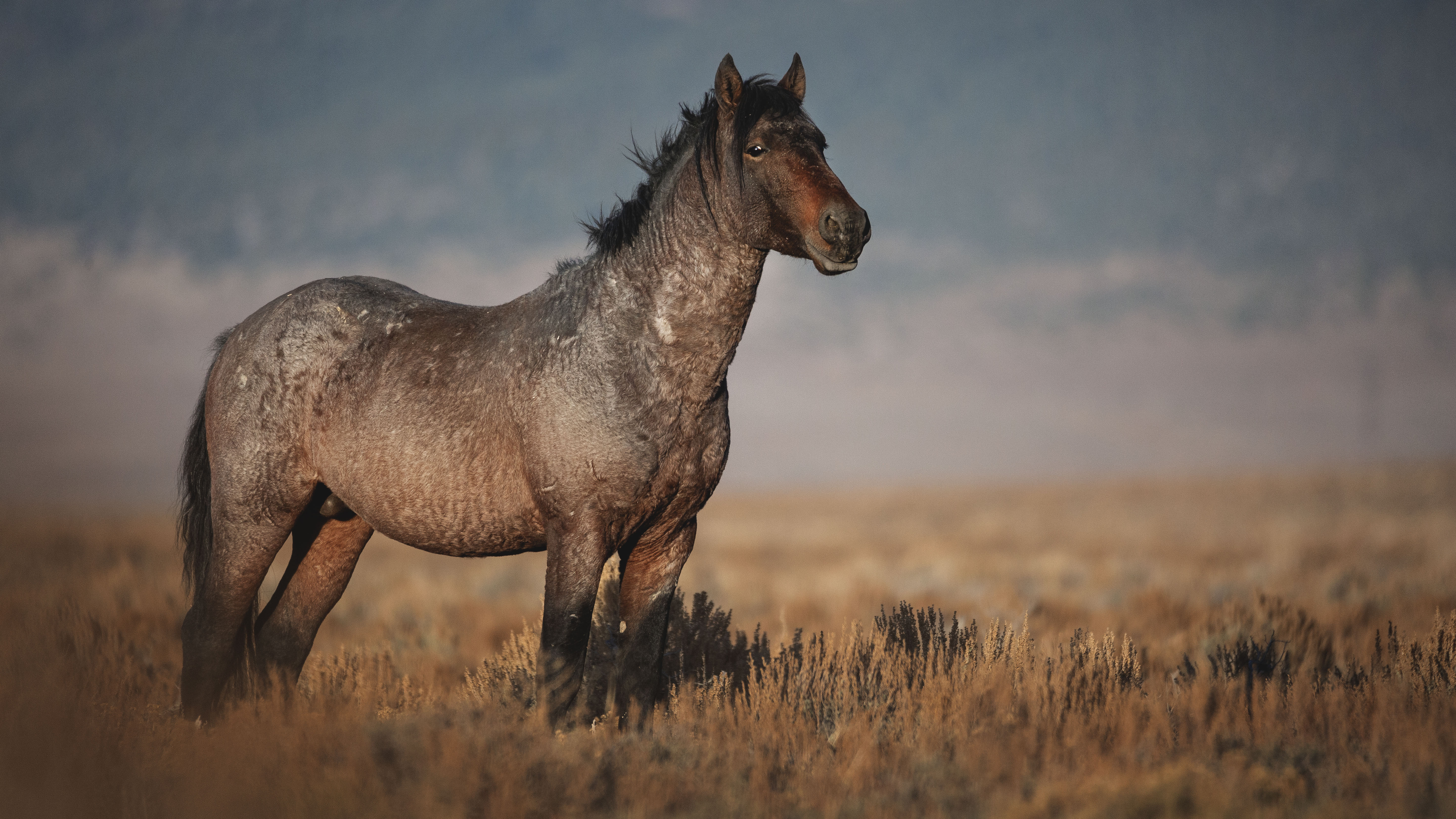
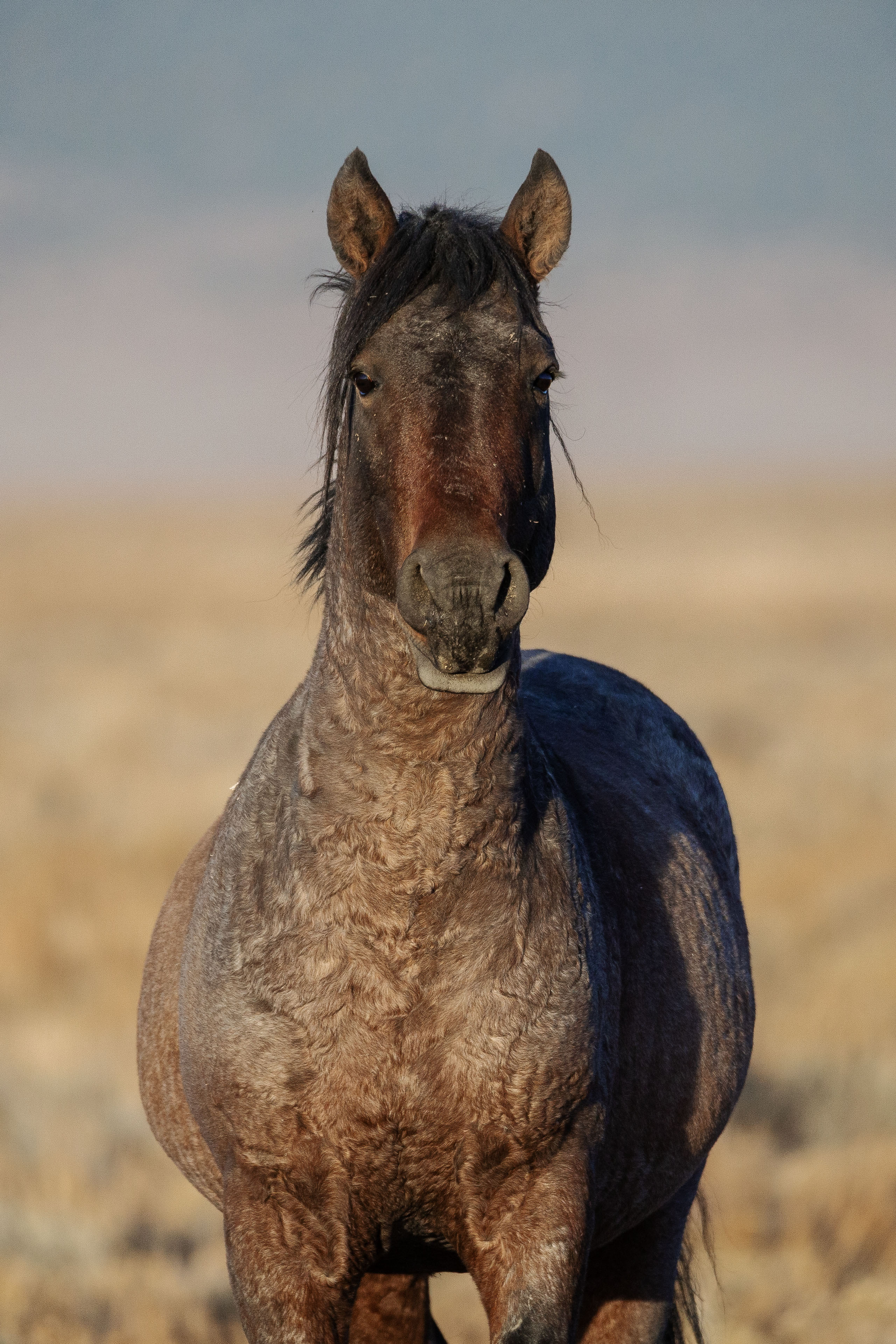
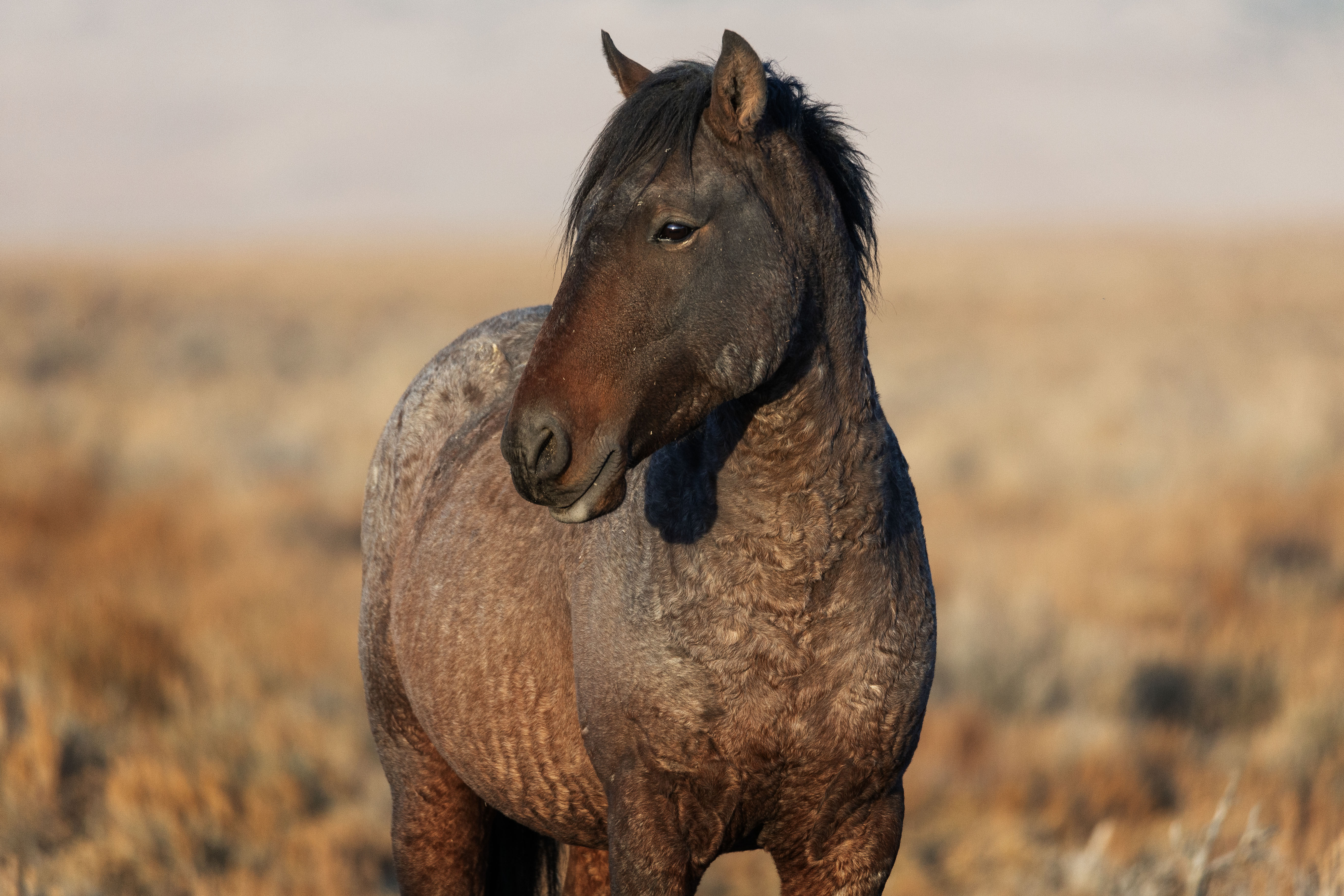
October 31, 2023: 69 wild horses were captured.
We had a late start today since they were finalizing the next trap site (trap 4) and we left the Eureka Fairgrounds at 8:30. The new trap is located just 7 miles off of HWY 50, targeting the north portion of Fish Creek HMA (Kobeh Valley HA). These were the horses I visited prior to the roundup. Today we are at least a mile away from the trap site with little to no visibility. Parking our vehicles so that the sun reflecting off the windshields wouldn’t be a distraction, while the horses are being run right by fairly busy (dirt) road used by mostly mining traffic. The traffic was stopped by rangers on both sides and let through between the runs.
The first run consisted of the most horses. I estimated the number to be around 35. At around 9:40 am most of the horses entered the trap. There was a horse that escaped the trap and he appeared to be uninjured. It’s unclear if he was recaptured or not.
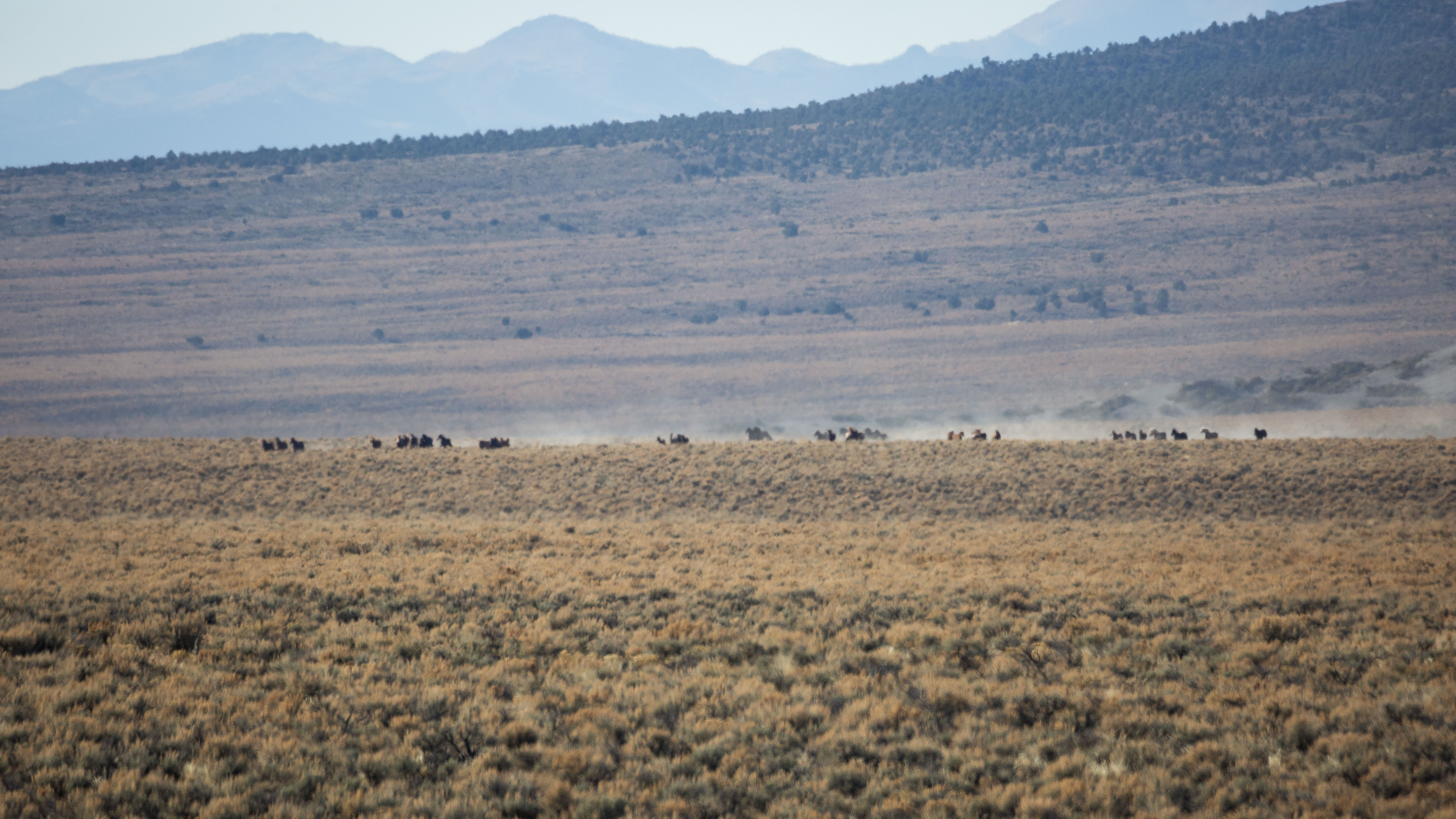
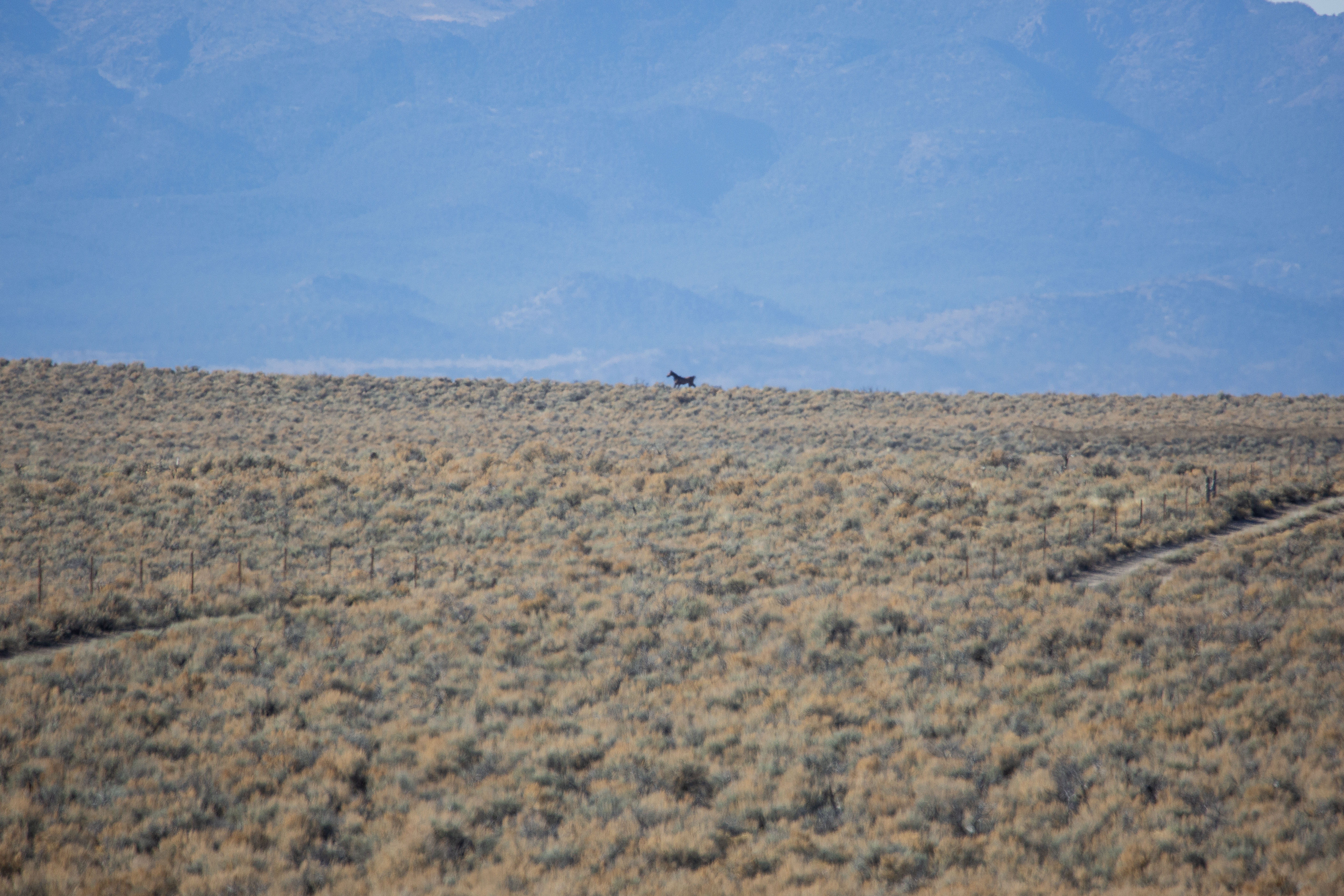
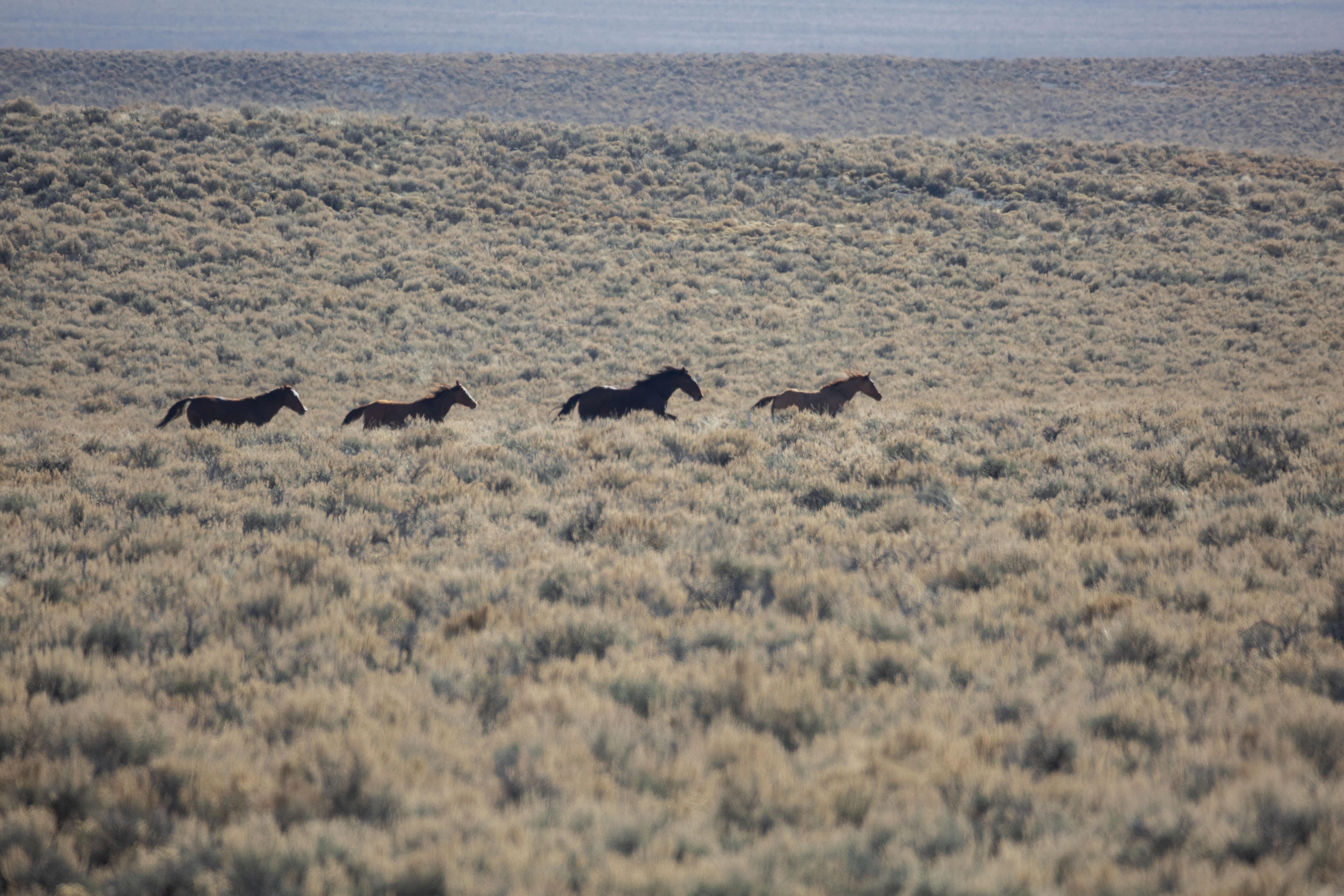
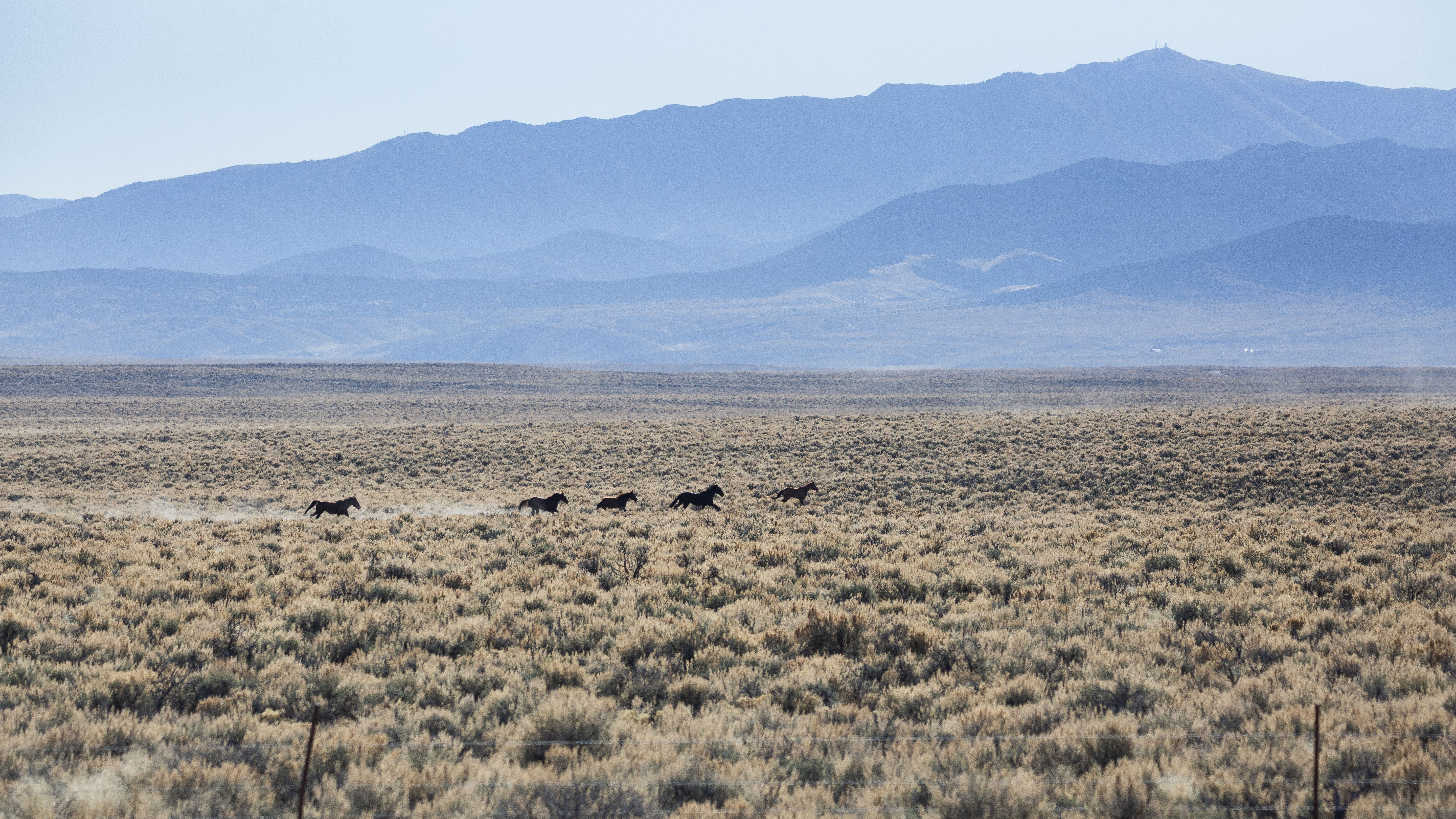
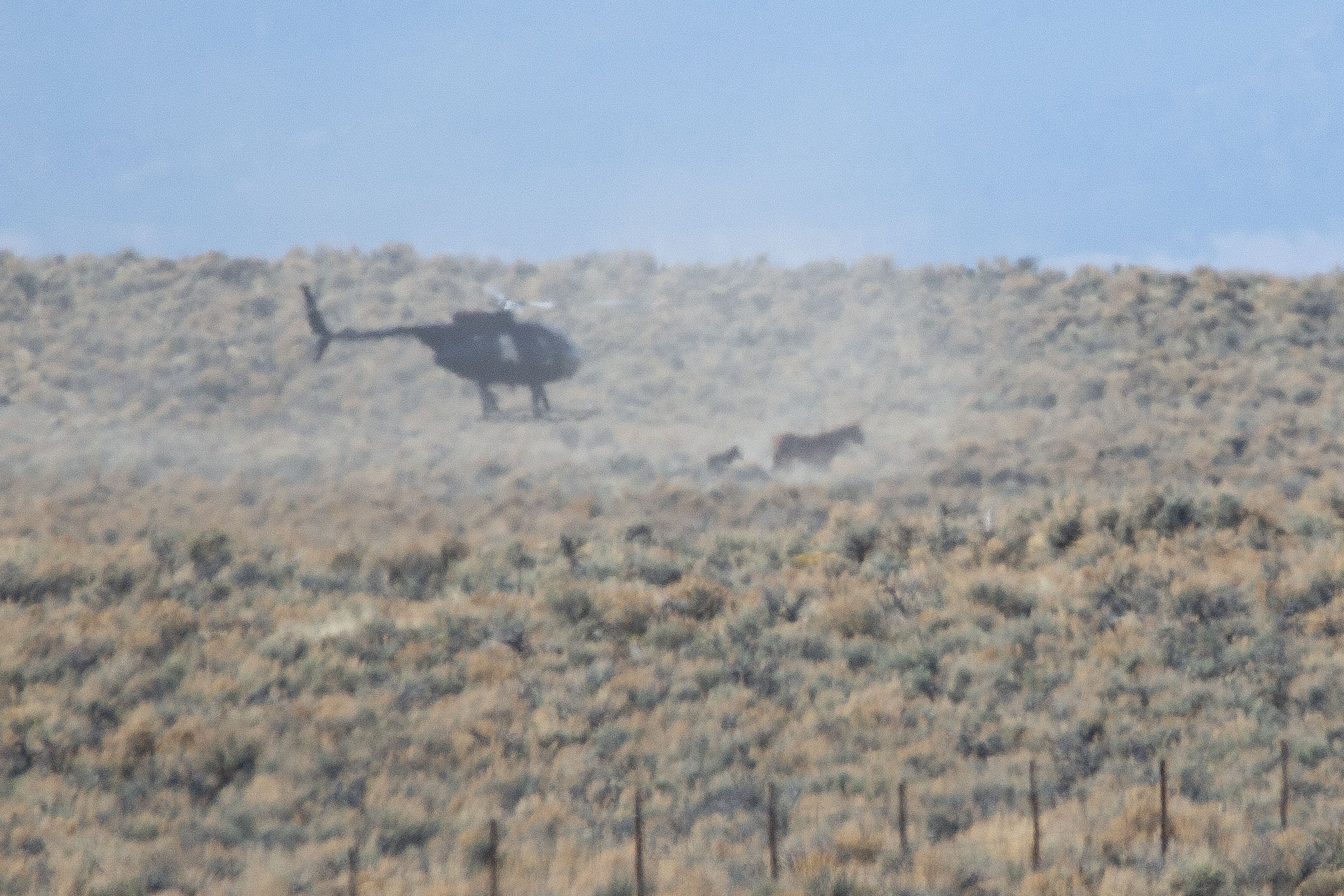
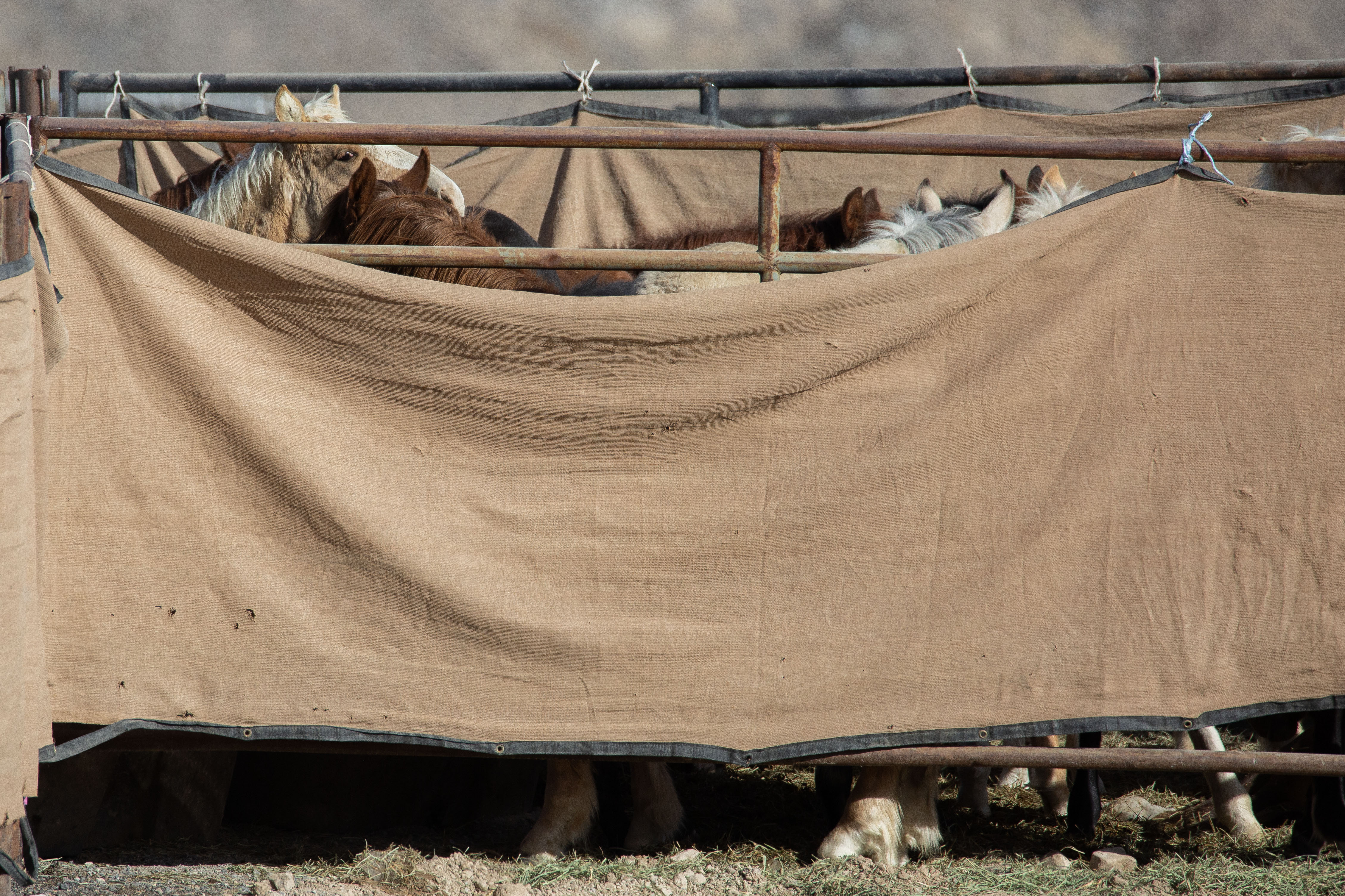
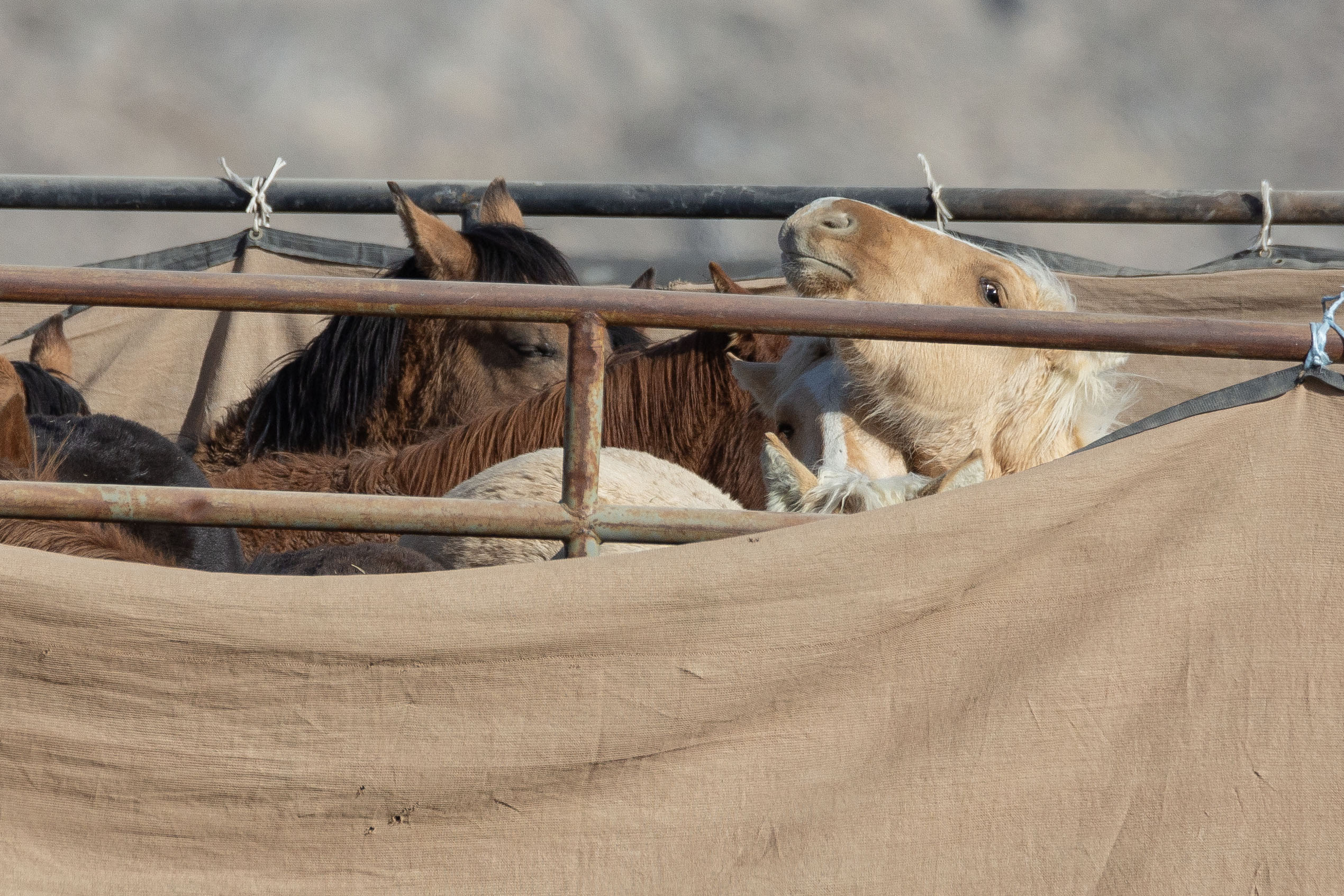
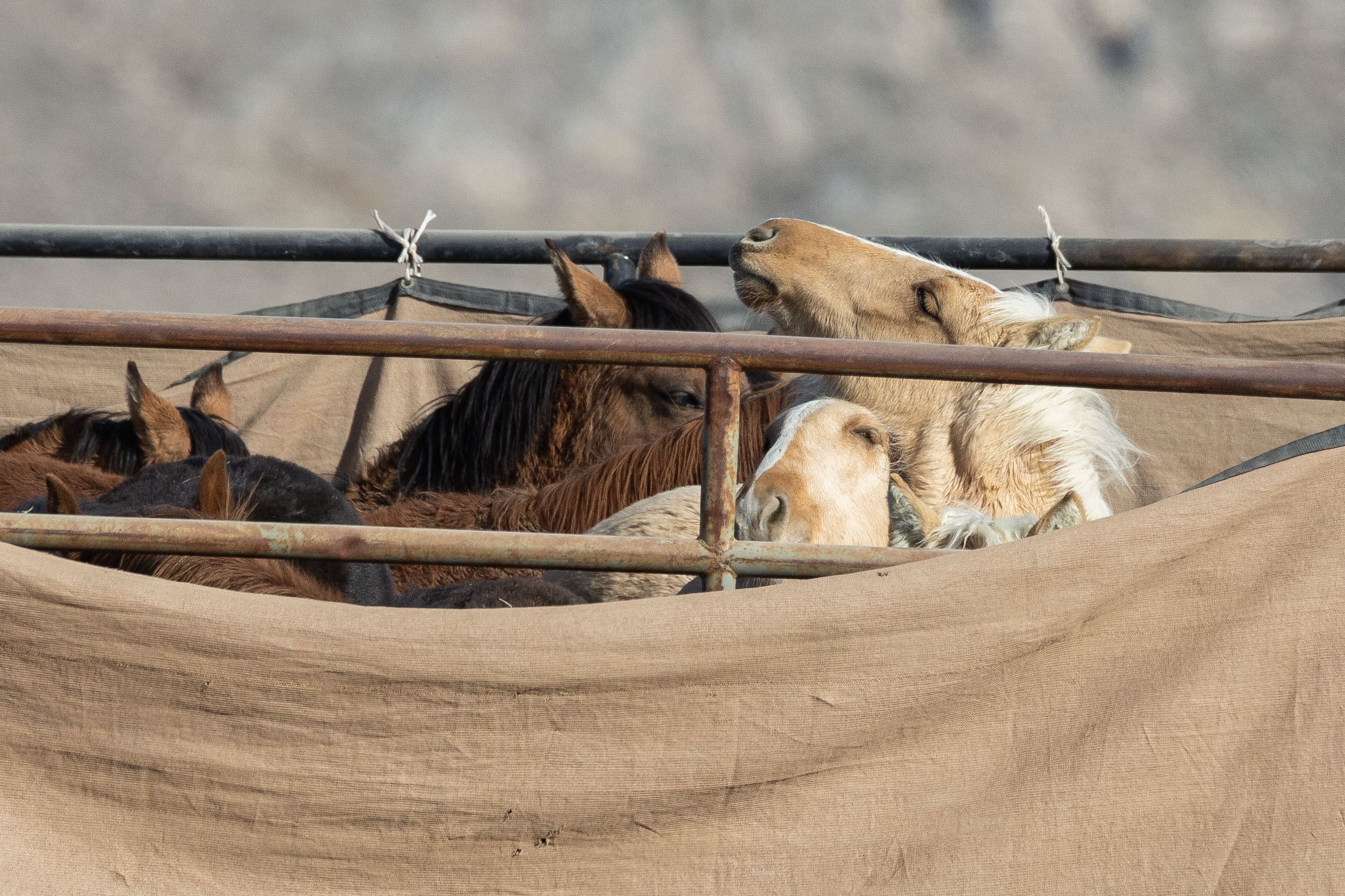
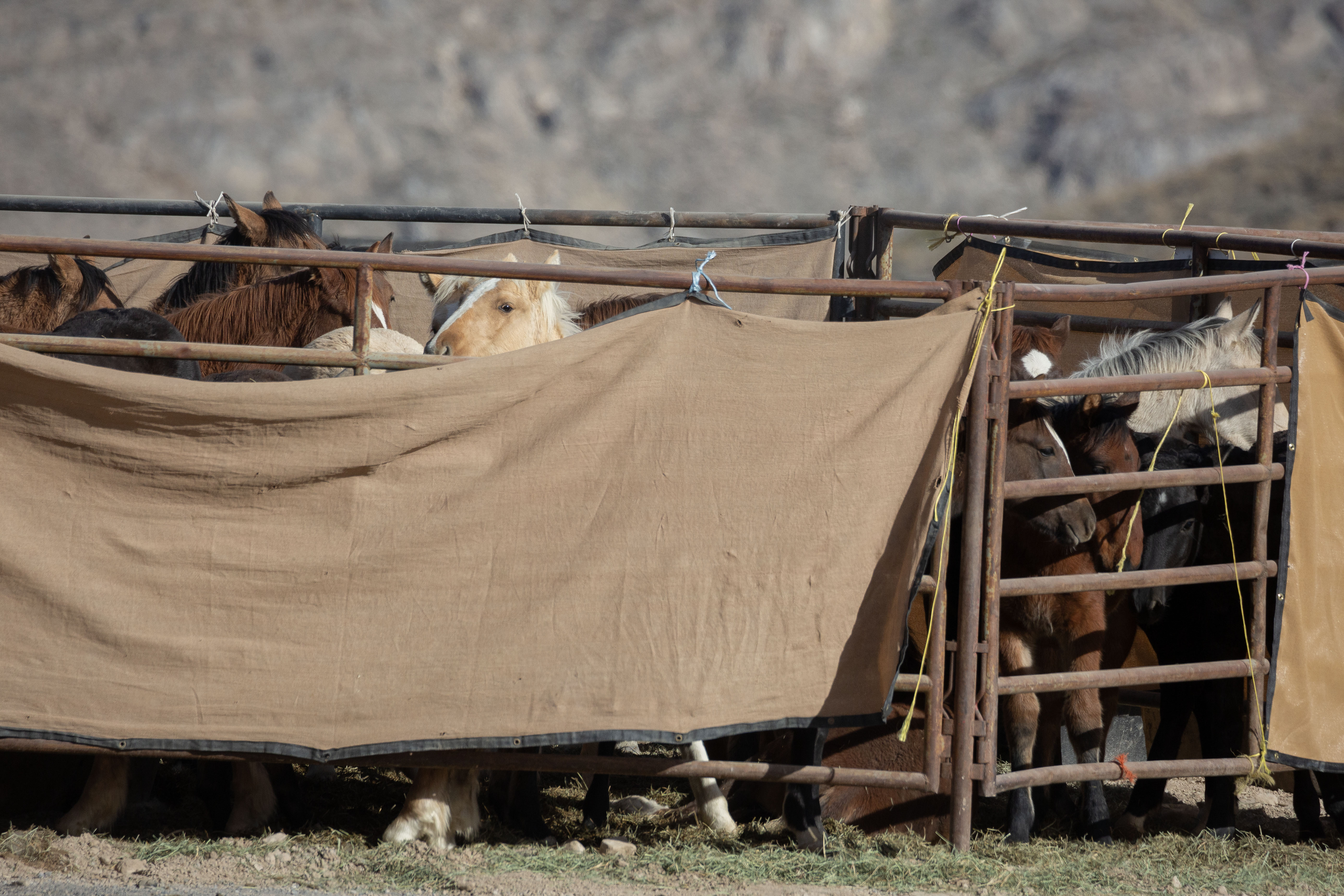
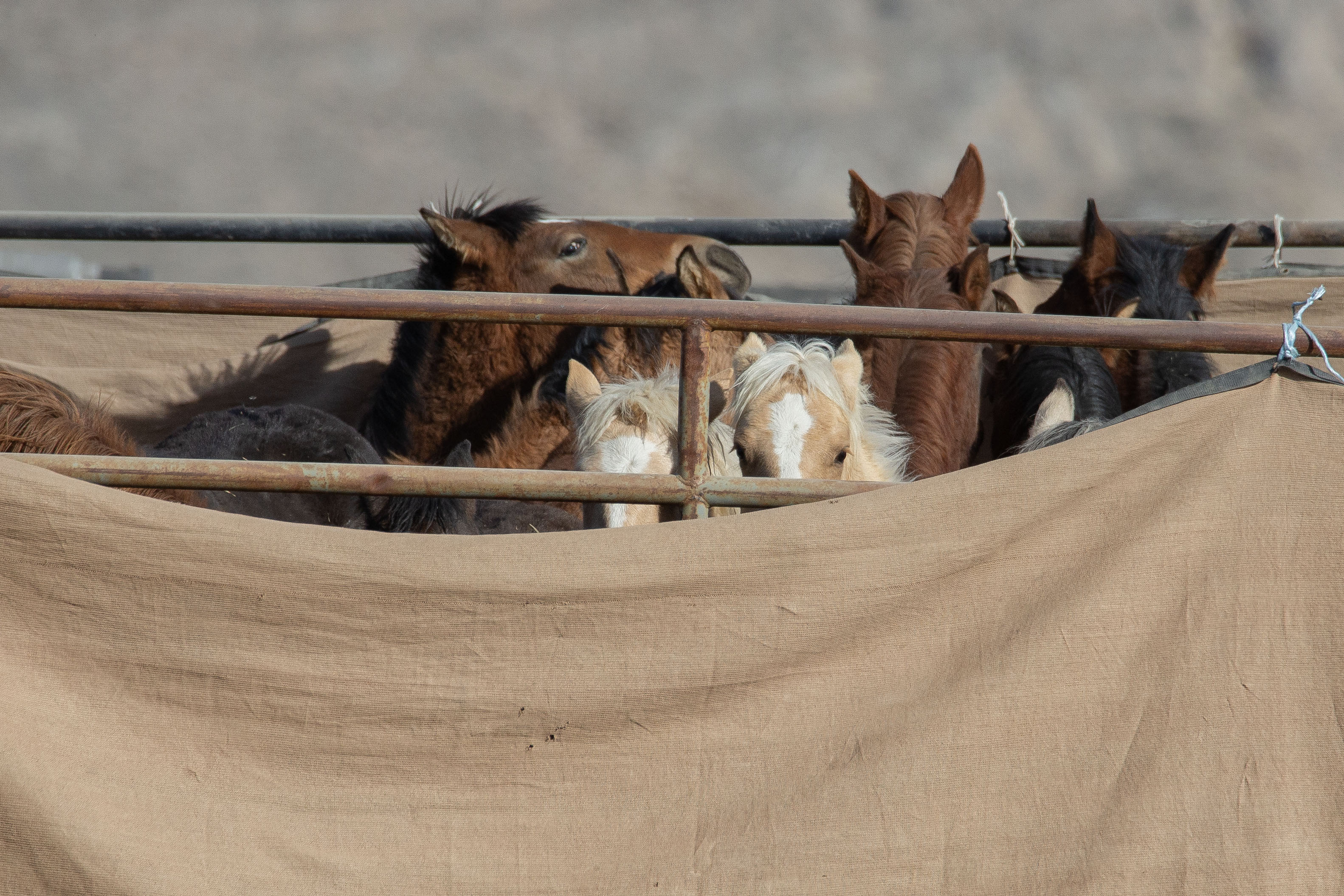
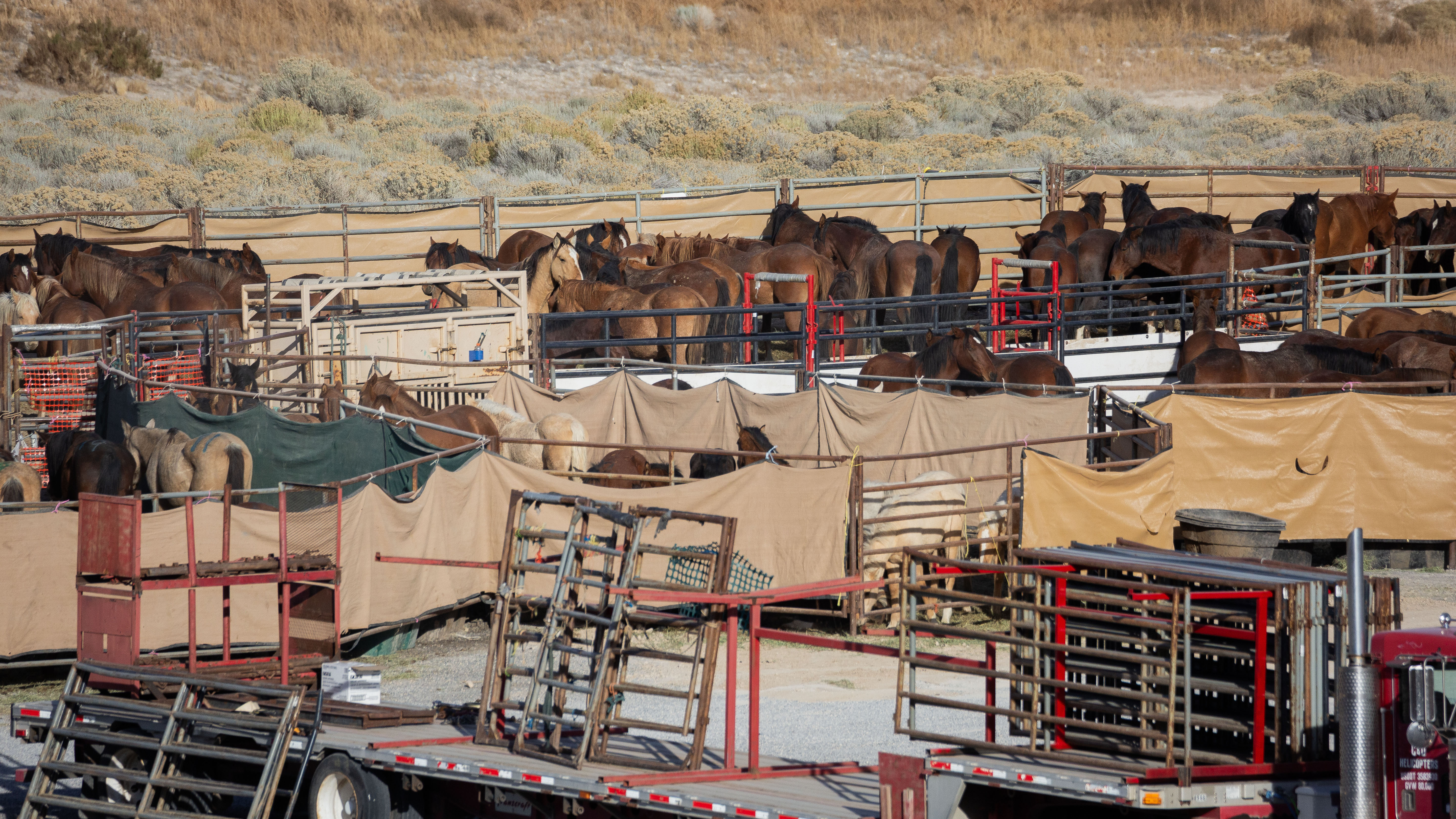
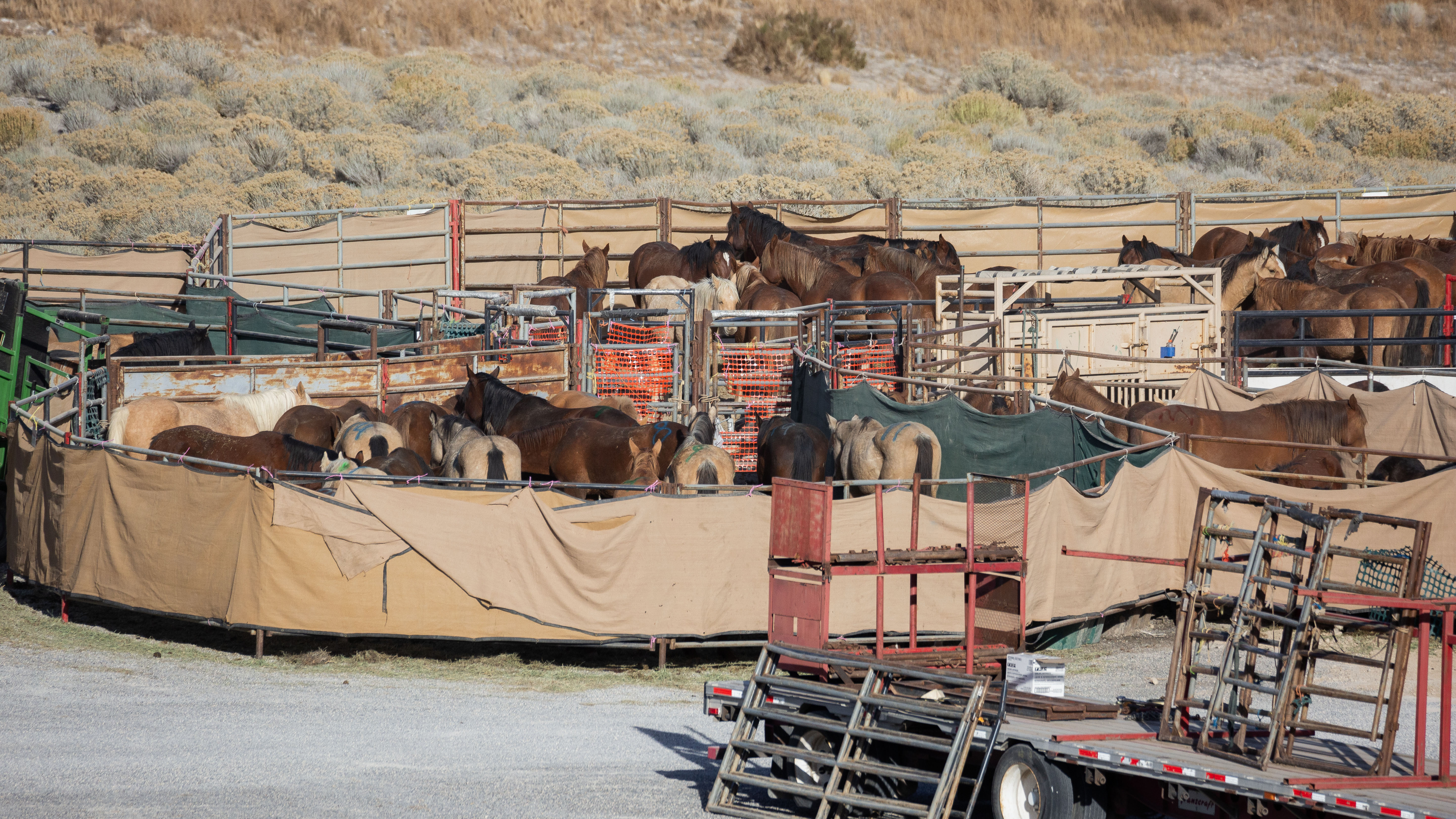
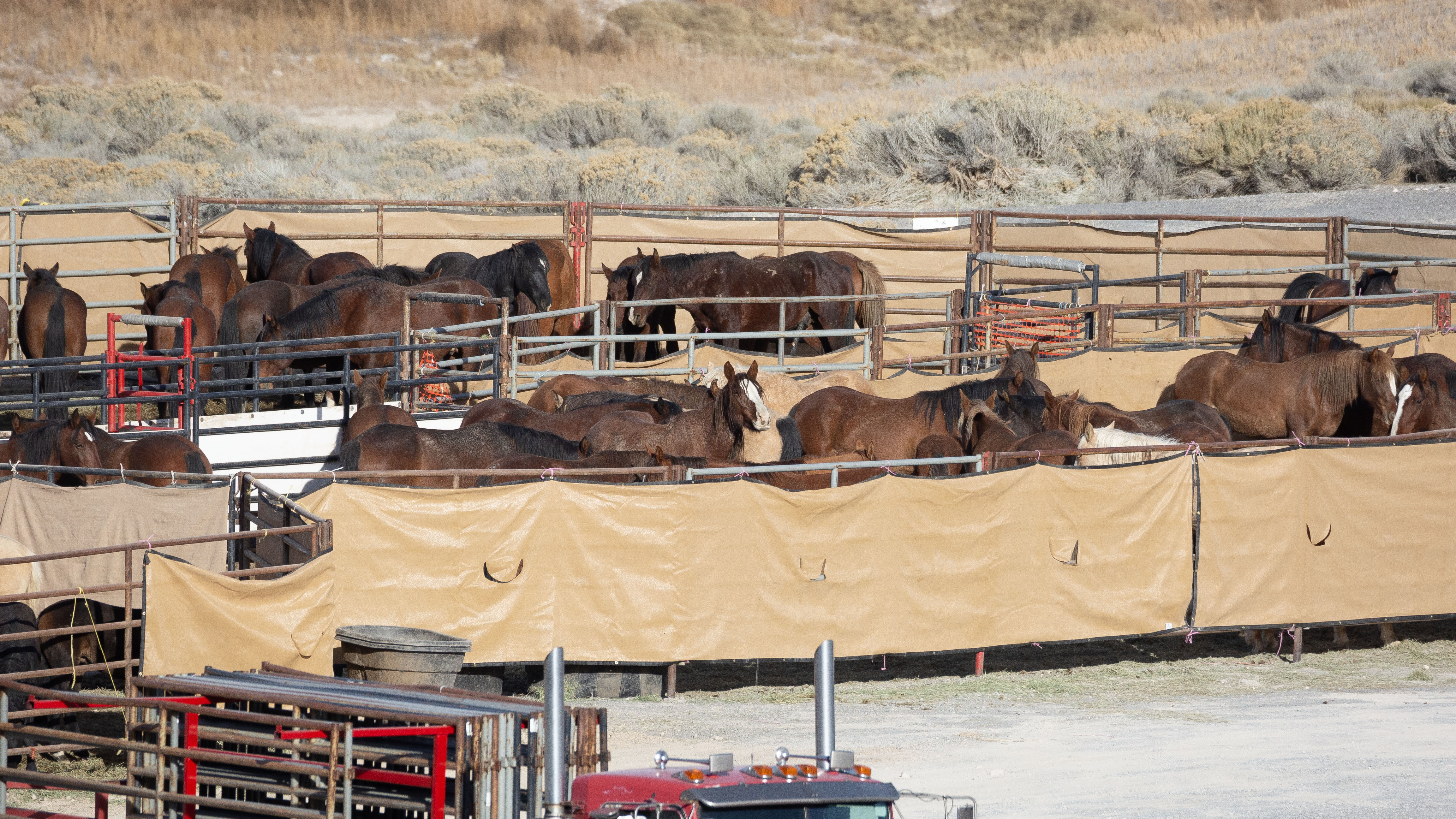
Around 10:15 the pilot pushed two bands together but they split up right before the wings so he had to push them in separately. When the second band came in, an older stallion had tripped and fell to the ground. He was unable to get back up and had to be “assisted” to trap by roping him. I asked about him and he appeared to be doing fine at temporary holding.
At 10:45 I noticed a mare and her very tiny foal being pushed by the helicopter. I imagine they must have fell behind from one of the larger bands. The pilot was flying low and had to constantly pressure the pair, they were either tired or unwilling to move fast. At one point I noticed they were walking with the helicopter close behind them. When they made it halfway into the wings, a wrangler came out and chased them into trap. The foal & mare are doing good at temporary holding.
Two and a half hours later, at 1:15 the next band of 10 horses came in. The roundup concluded for today and they are moving trap site tomorrow.
October 30, 2023: 25 wild horses were captured
October 29, 2023: Approximately 54 wild horses were captured
We left the Eureka Fairgrounds at 6:30 am and made it to observation about 40 minutes later. We were at the same trap site again. I heard the helicopter in the air around 8 am and at 8:50 the first run came in.
I could see the steam coming from the horse’s bodies, indicating a very cold morning (the temperature in the truck measured at 11ºF, however this could be off). Just in a little less than an hour the second run of around 7 horses came in. Some of the horses looked panicky as they are going through the sorting pens. 11 am: a group of 7 horses came into trap. 11:45 another 7 horses came from the mountains.
The pilot had a hard time and had to start doing intense and low maneuvers long before even coming close. Overall he has been good with pressure and release but when the horses are not wanting to travel to the direction of the trap, that’s when he has to start flying low and the pressure comes in.
The band made it safely into the trap site but a little later as they moved forward into the sorting pens I saw a bay stallion jump out of the trap just before I started recording. He was down for a good minute and a half (I was later told he got stuck in a panel), the staff stayed calm and the stallion all of a sudden jumped up and sprinted away up the hill. He was not injured. A wrangler made an attempt to rope him but he got away.
The next run was at 12:30. a group of 7 horses entered the trap safely. At 1:15 the pilot was pushing 6 horses. I noticed a buckskin mare with a foal in tow (however, it appeared to be an older foal). The band scattered a few times while making their way close to trap. They all banded together again but right at the start of the wings they scattered once again.
At that point I noticed that all of the saddle horses were gone. The pilot managed to get just 3 horses, I noticed the foal come in with two bay horses. Then the pilot was working together with 3 wranglers to rope any horses they could. They managed to only rope one adult bay horse. At 2:35 a band of 4 horses made it into trap safely.
The roundup concluded for today. After they were done flying for today we were able to see the trap site (trap 2). Temporary holding: the horses were much louder than the previous day and there was a lot of back and forth whinnying.
The small foal from yesterday was doing good with the mom when they last checked them after arriving at the holding facility in Axtell, UT. There is two pens with studs and mares who will potentially return to the range (they keep more in the pens than will return so they can make a final selection). The markings you see on them are the estimated age they are. The mares that are currently selected to return (after being treated with Gonacon) are ranging from 4 to 20 years old.
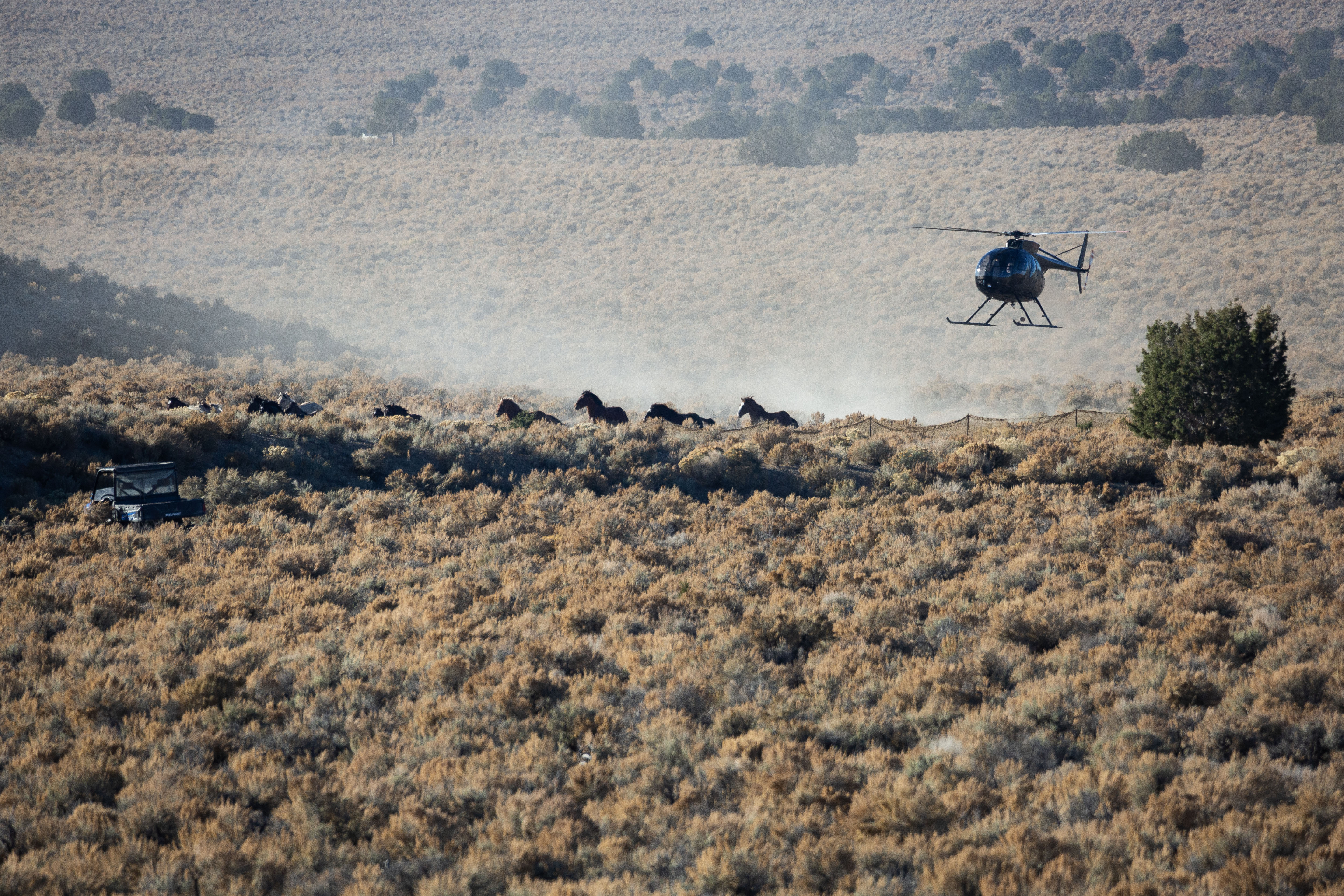
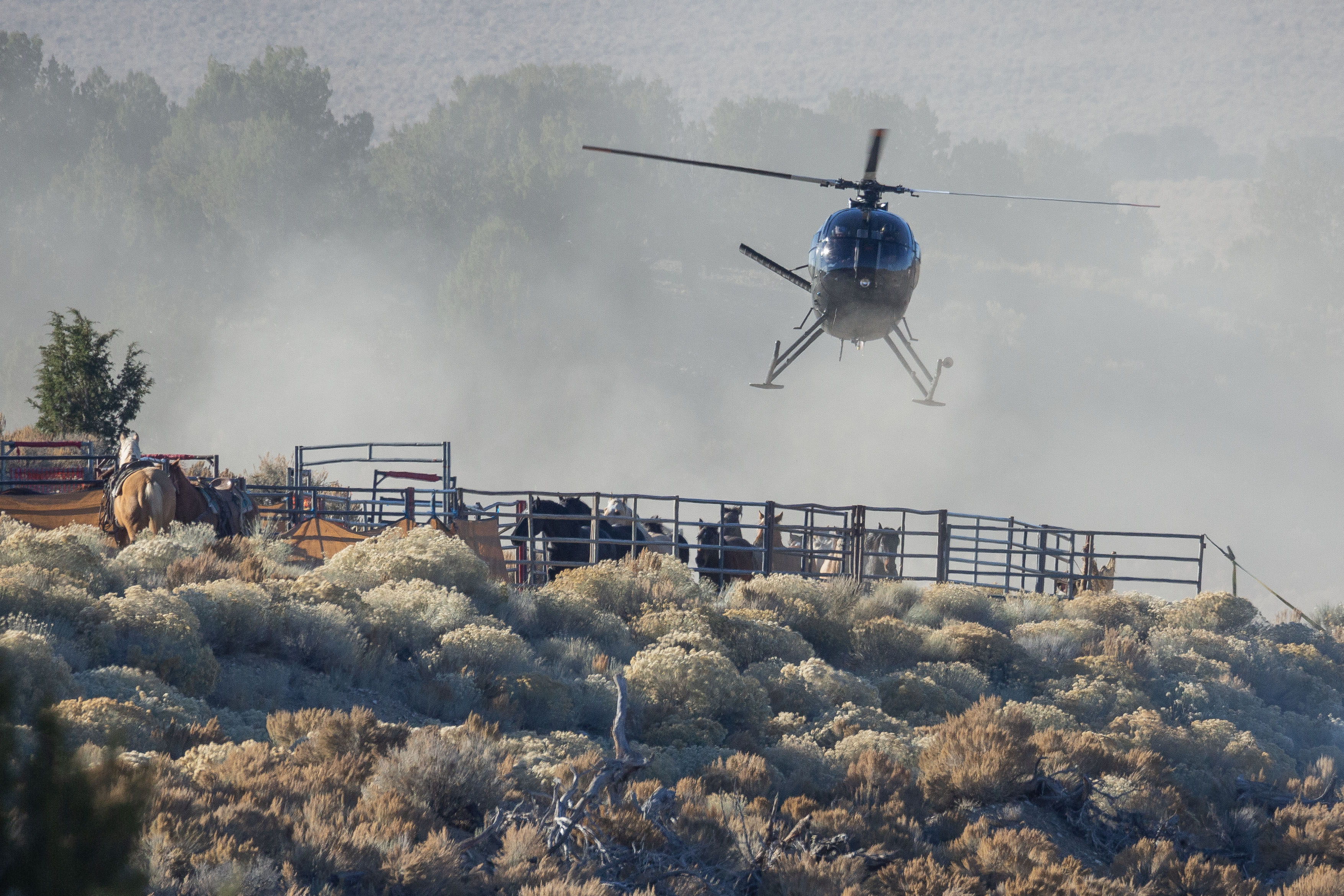
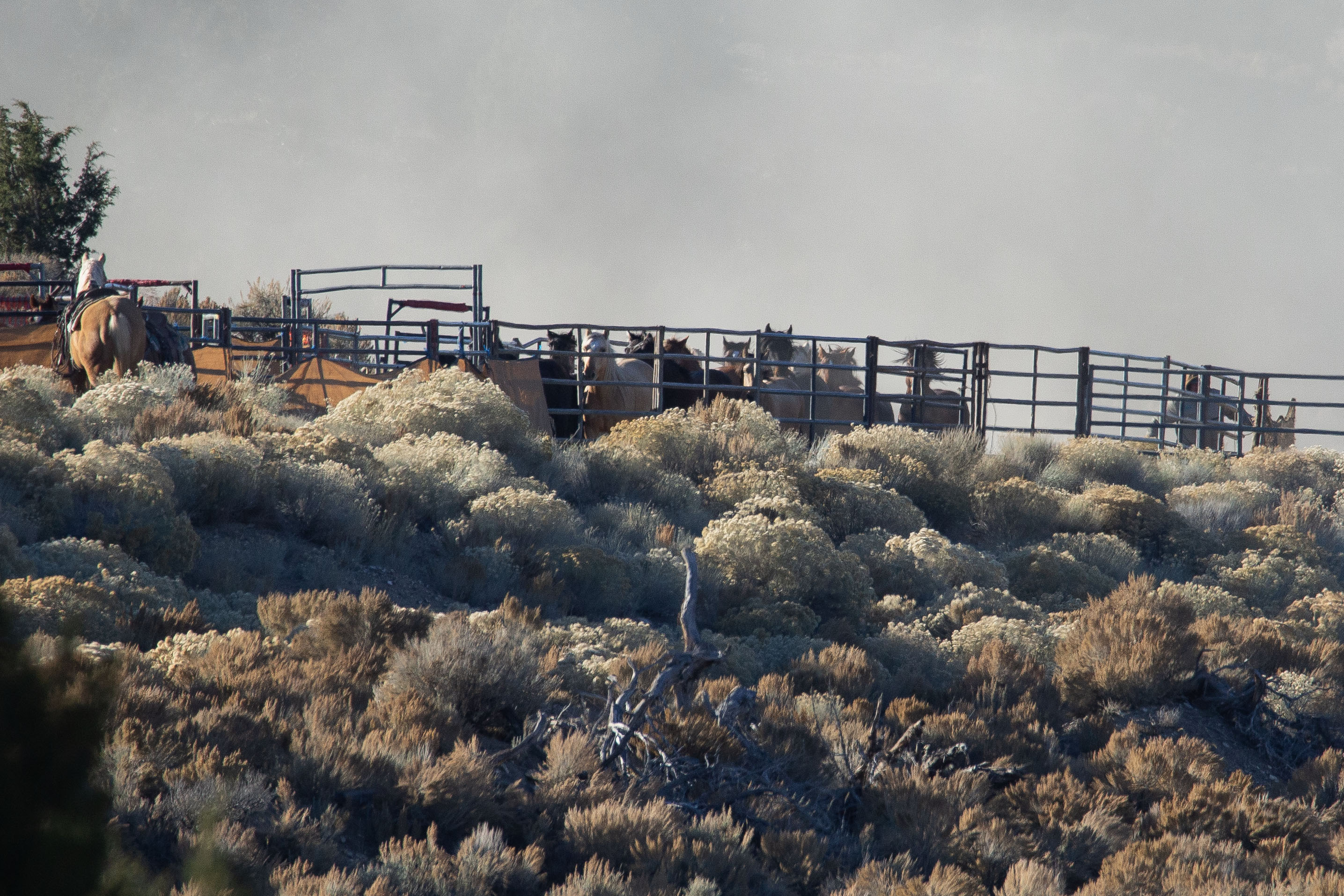
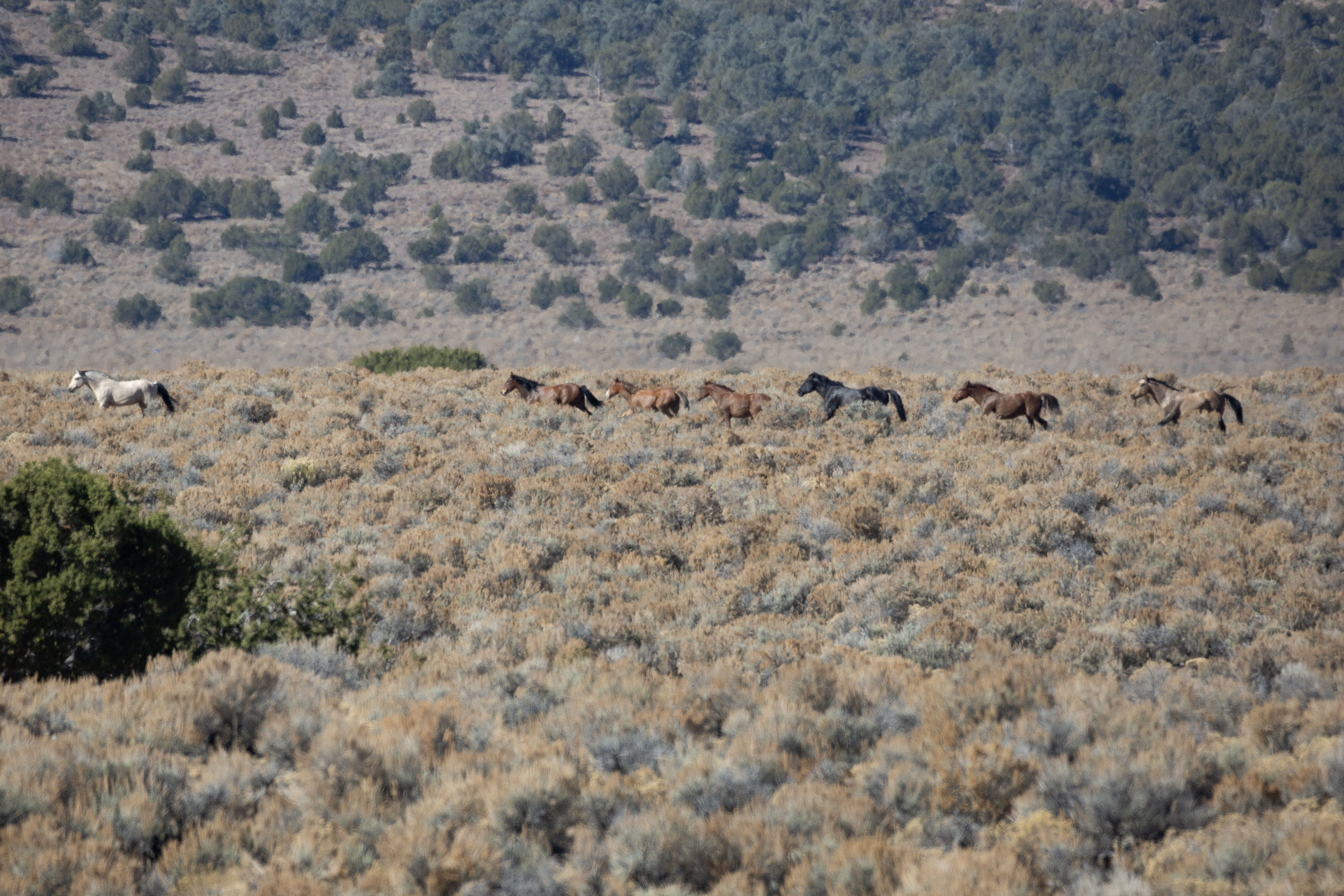
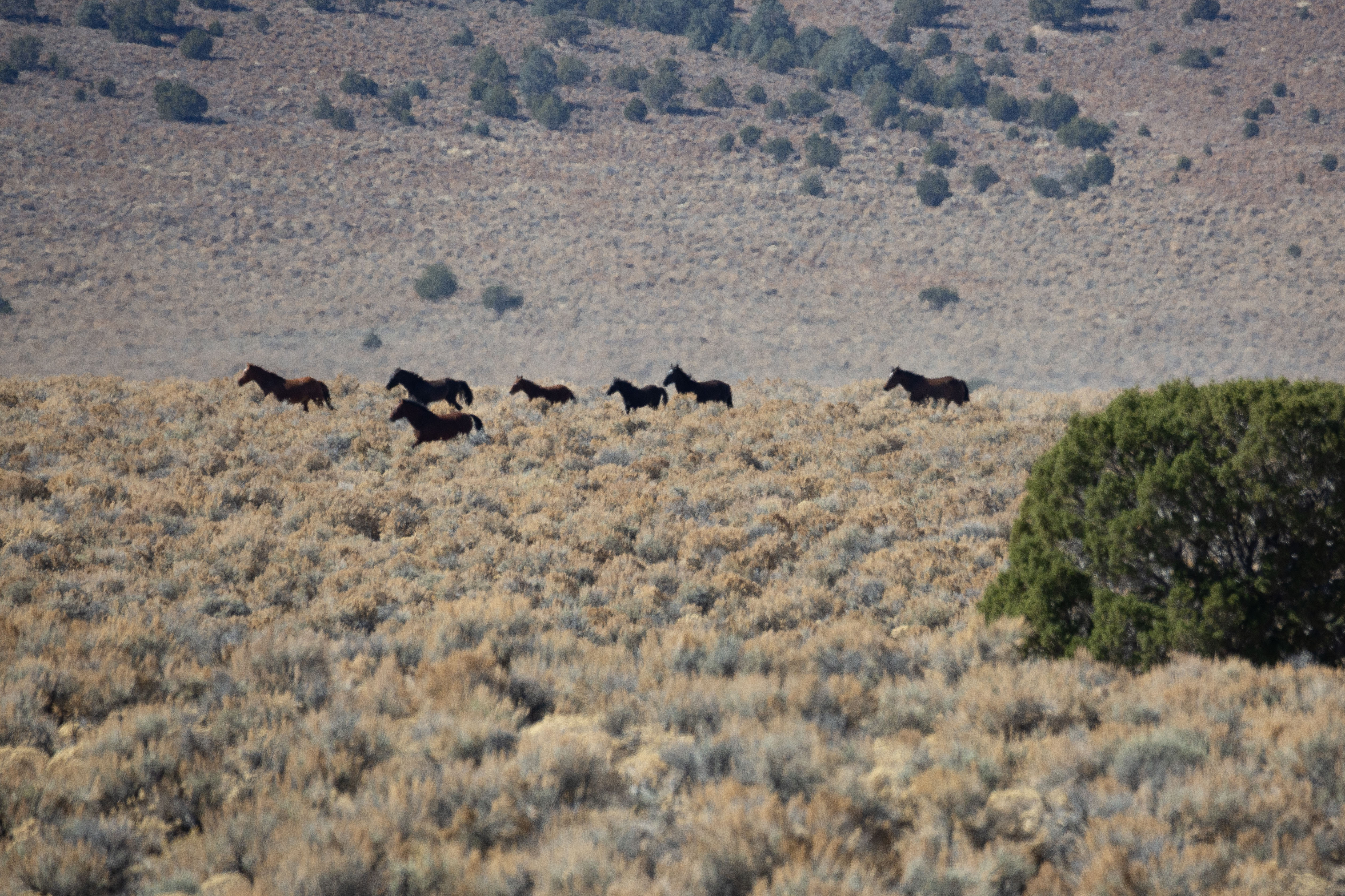
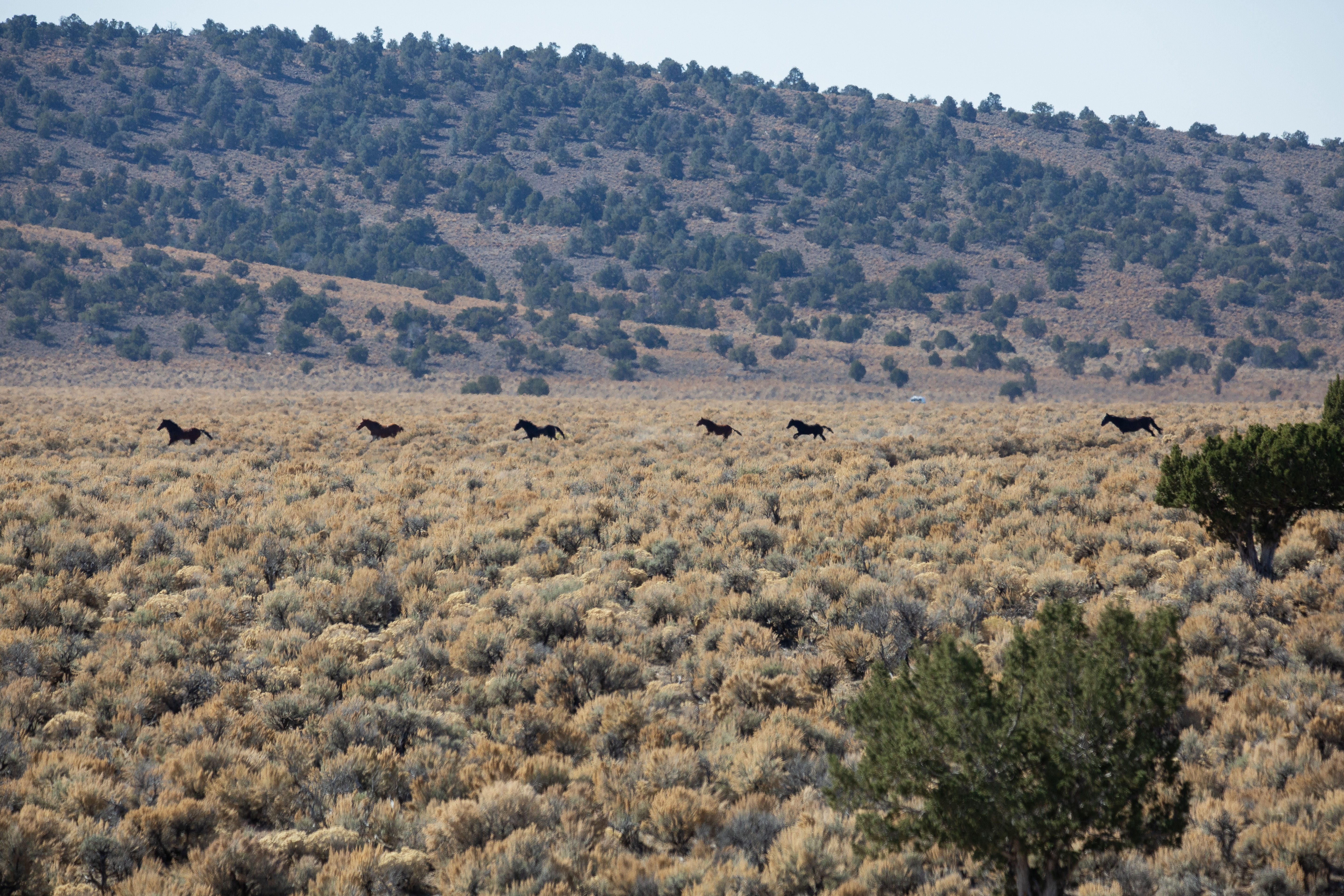
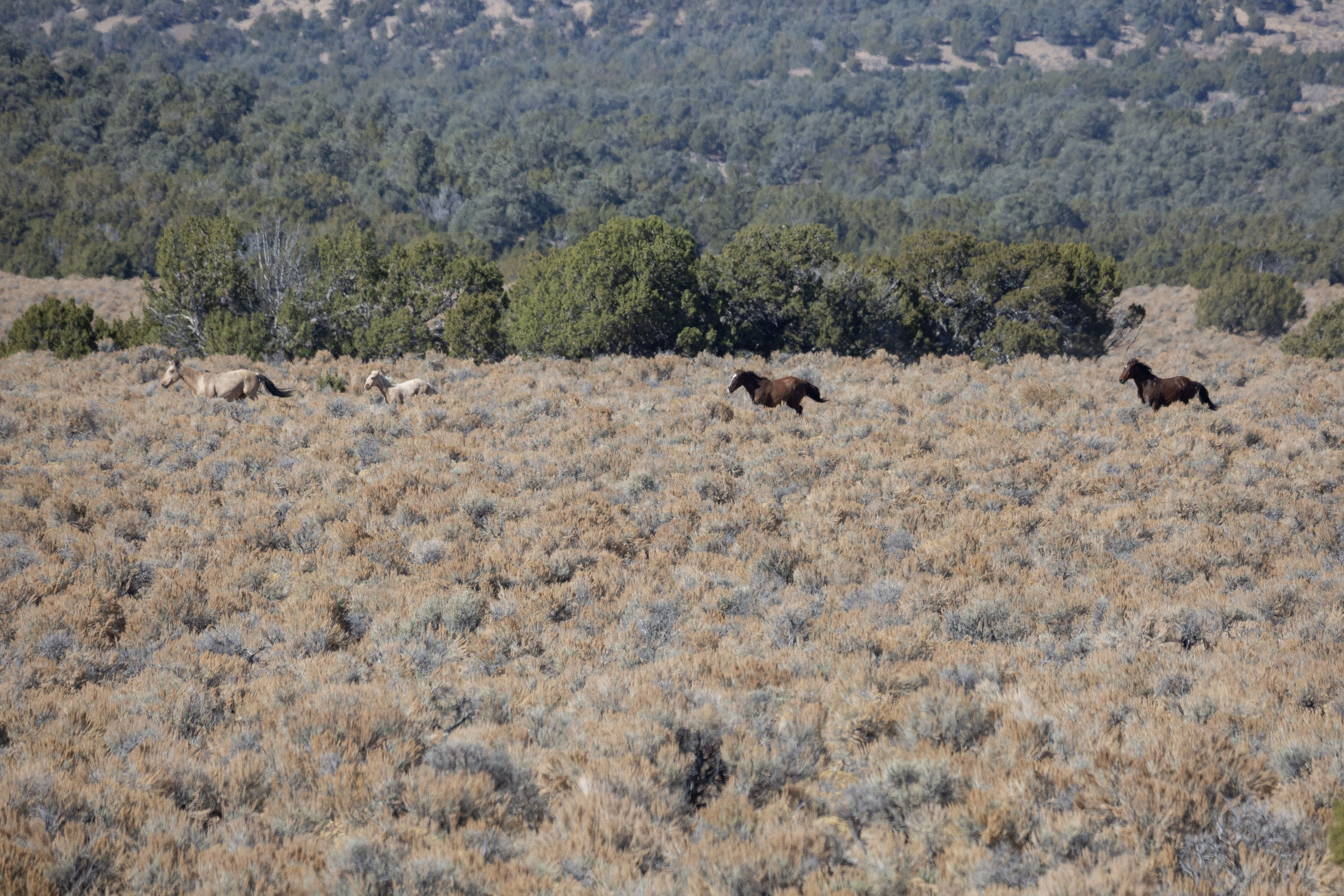
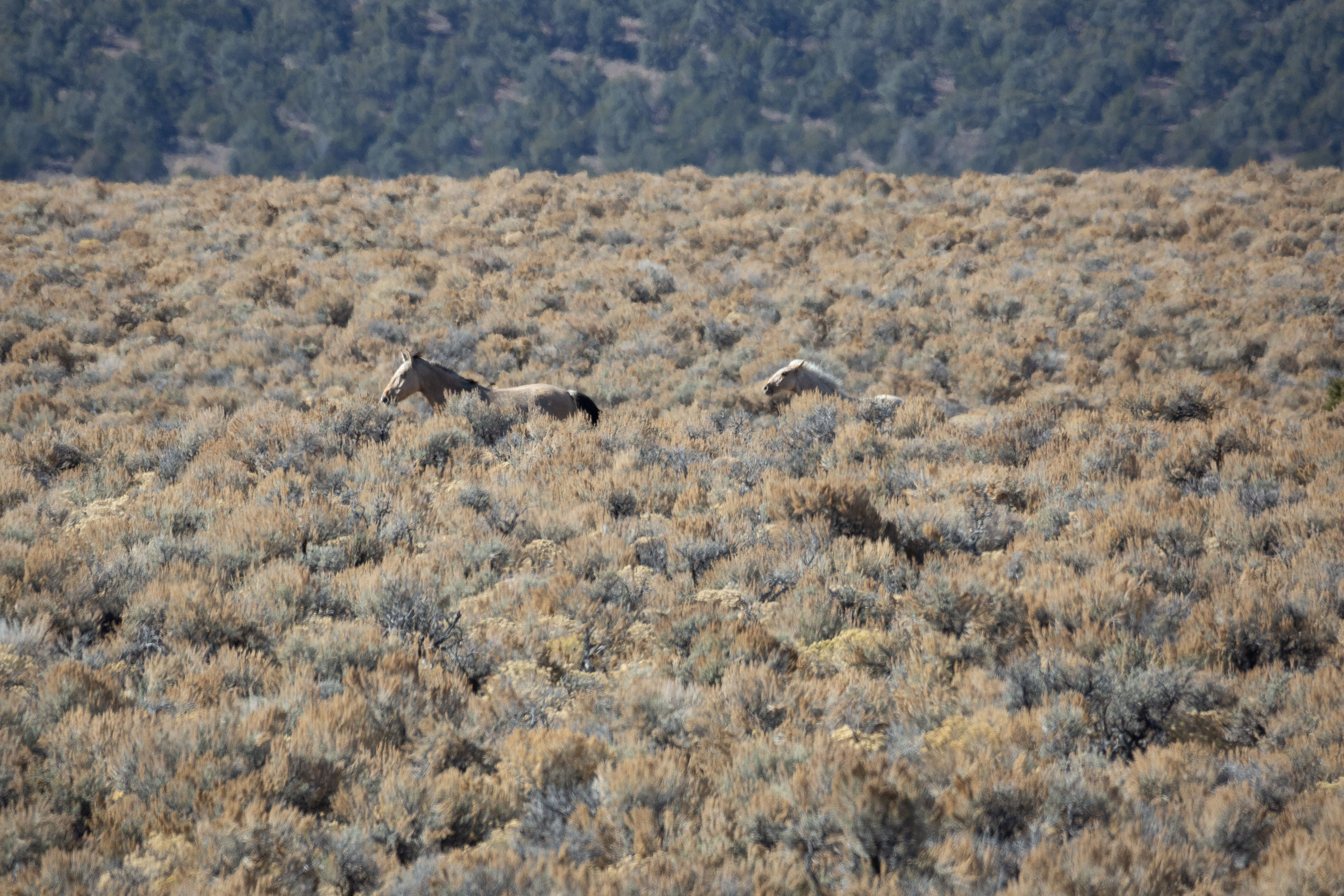
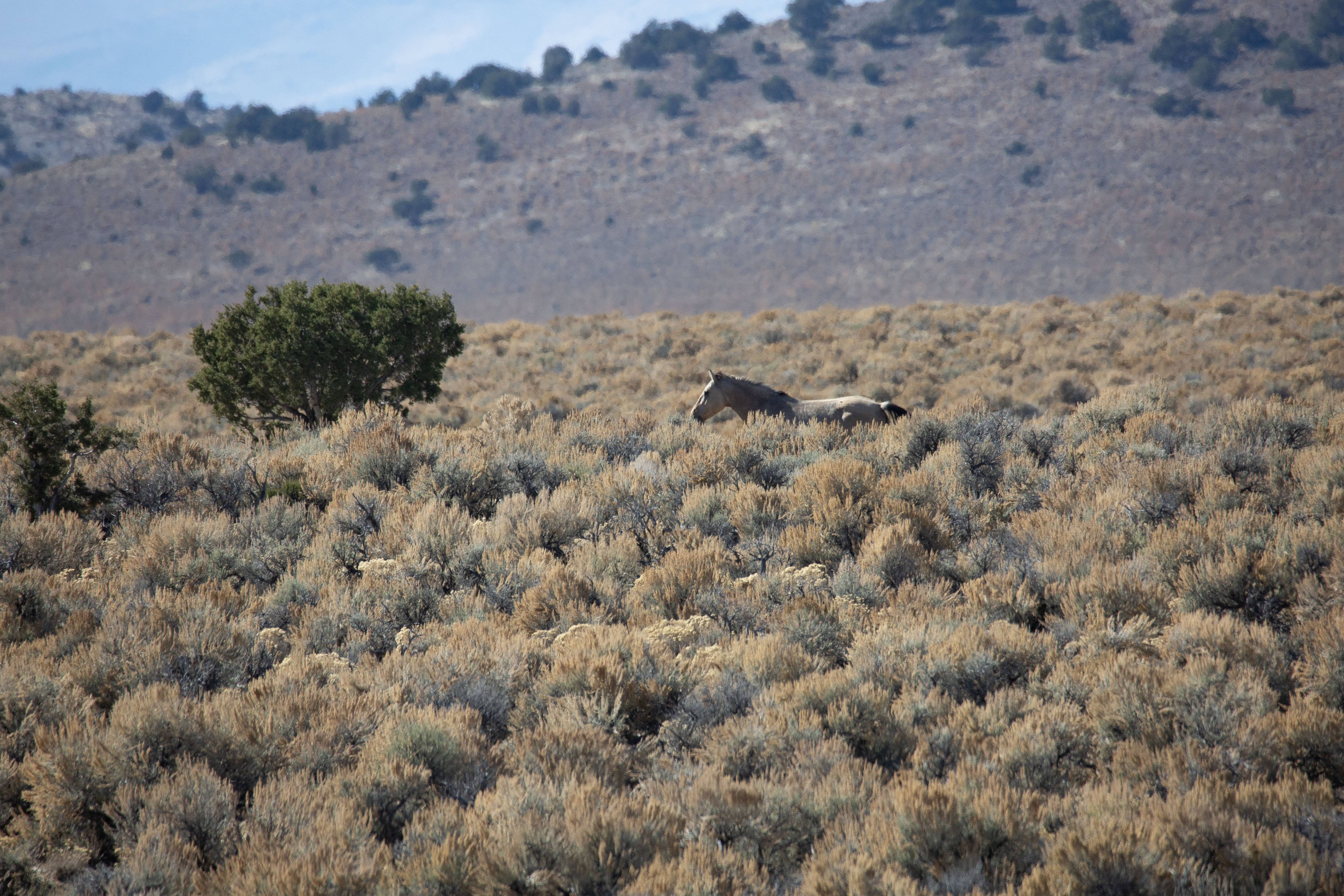
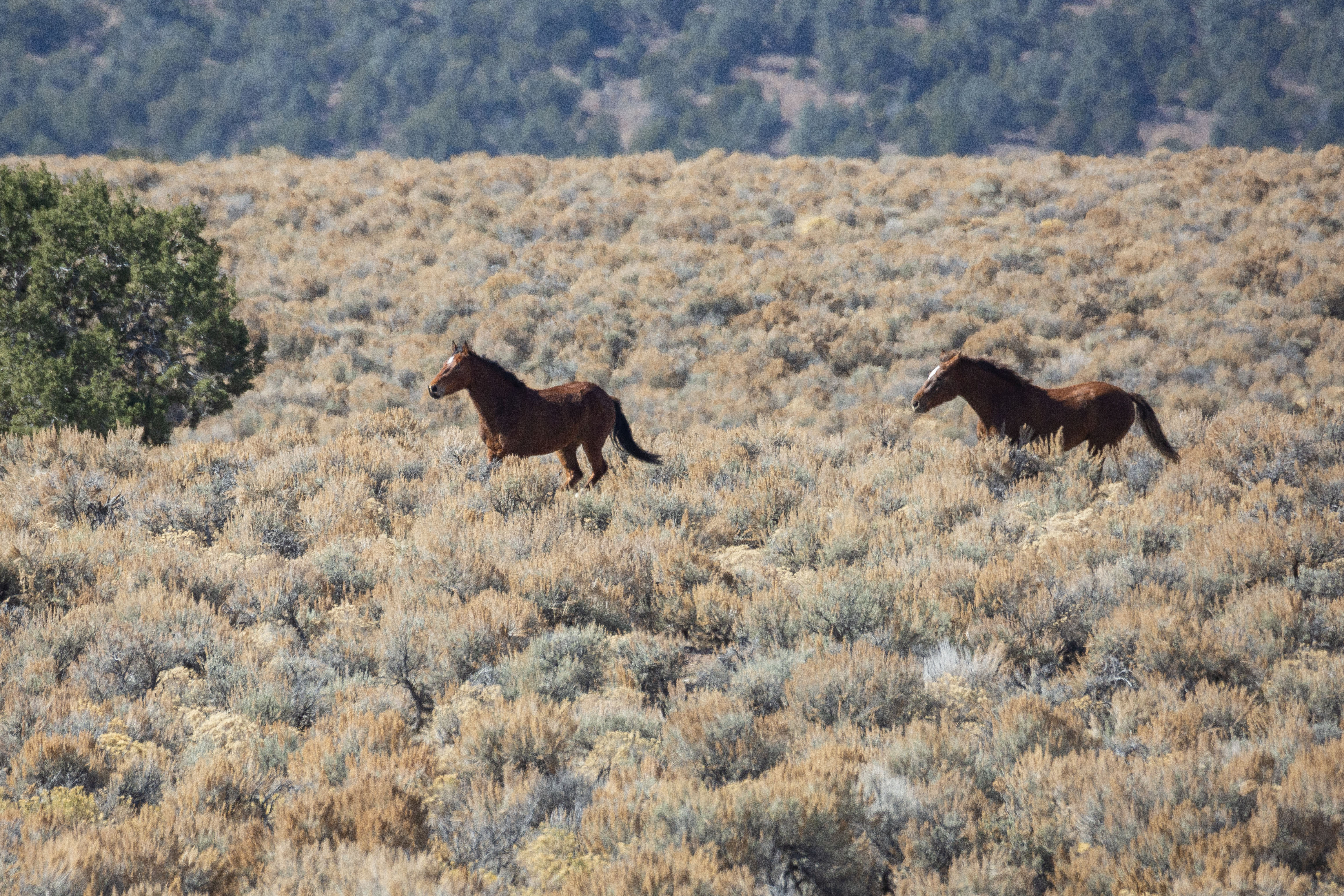
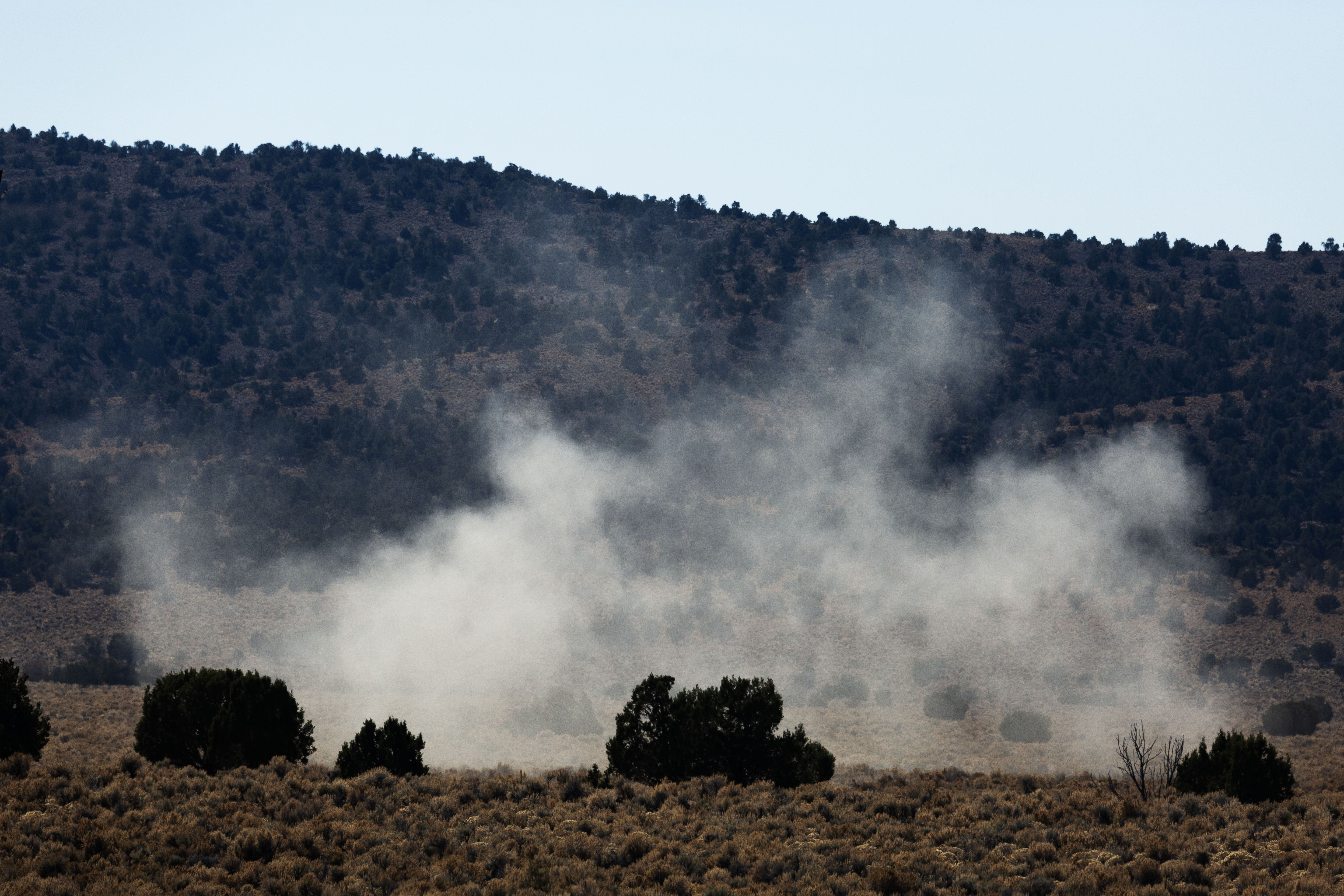
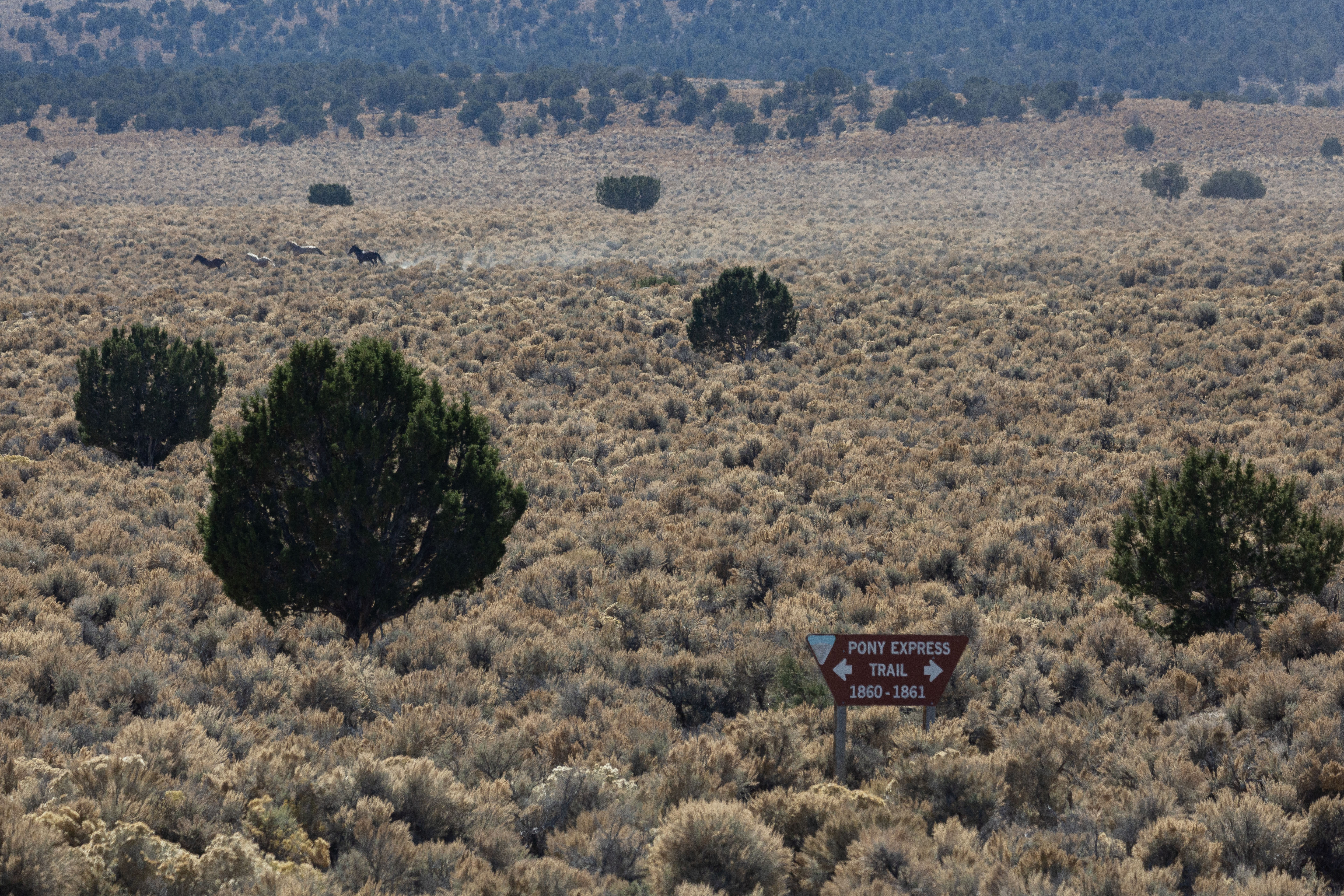
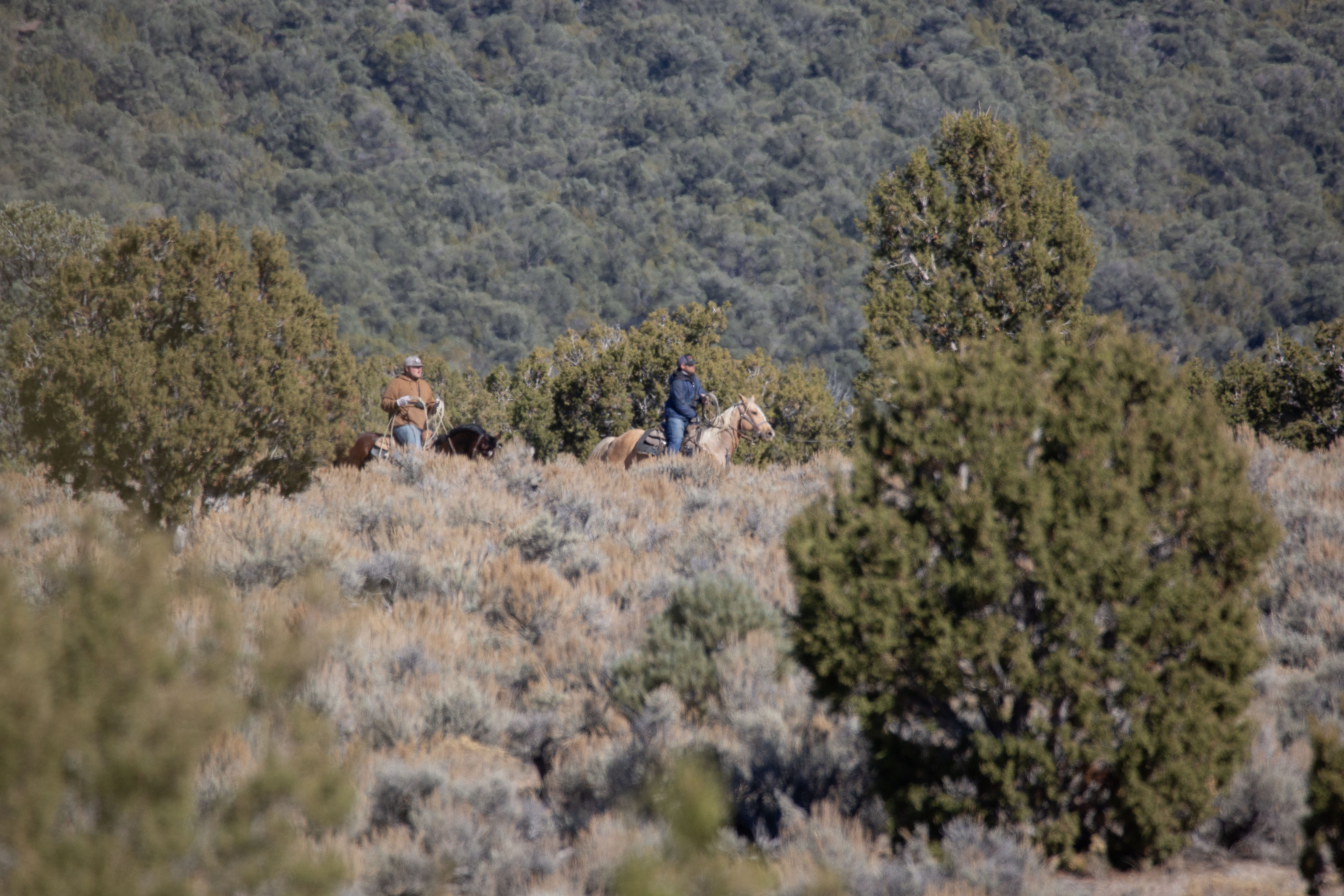
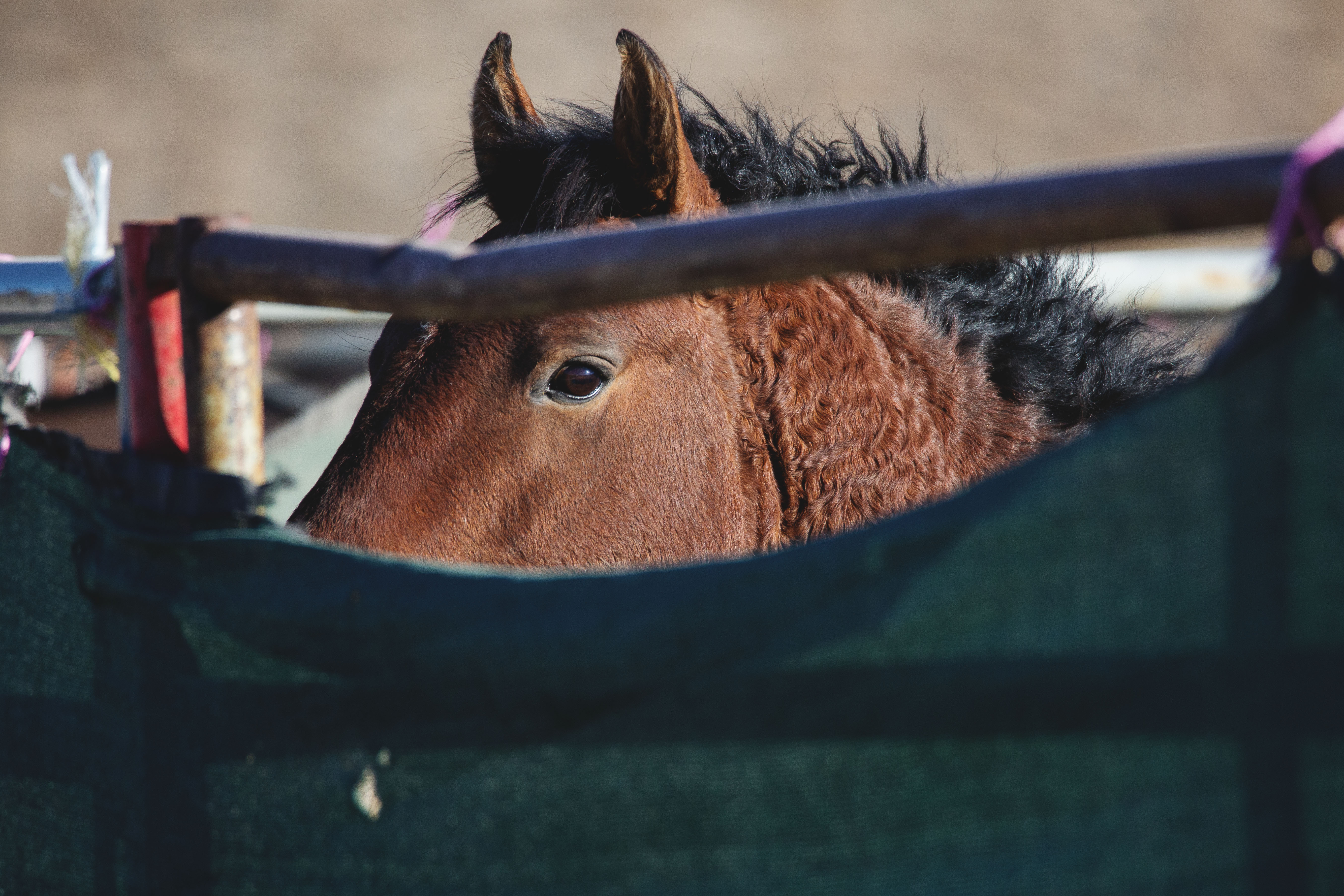
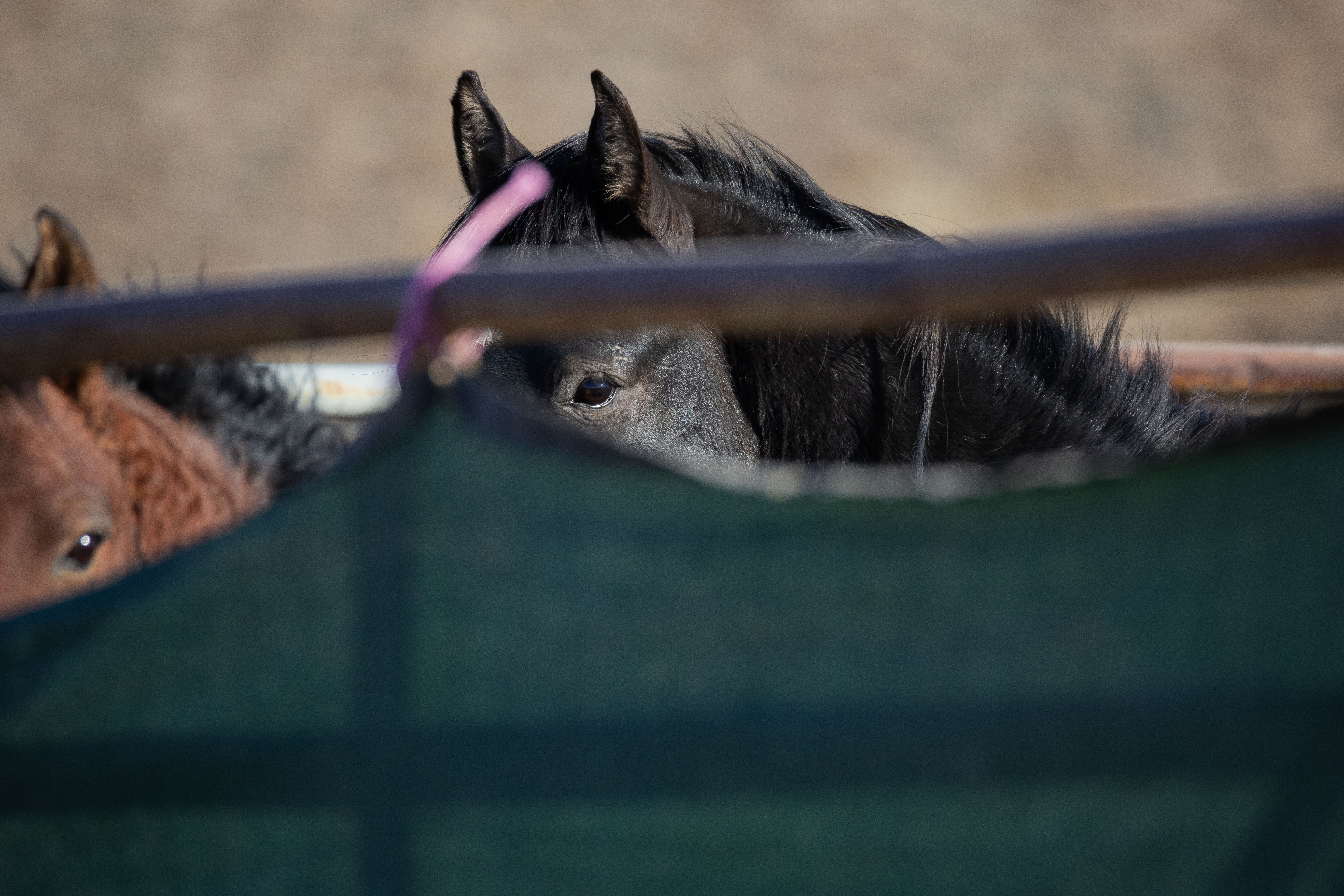
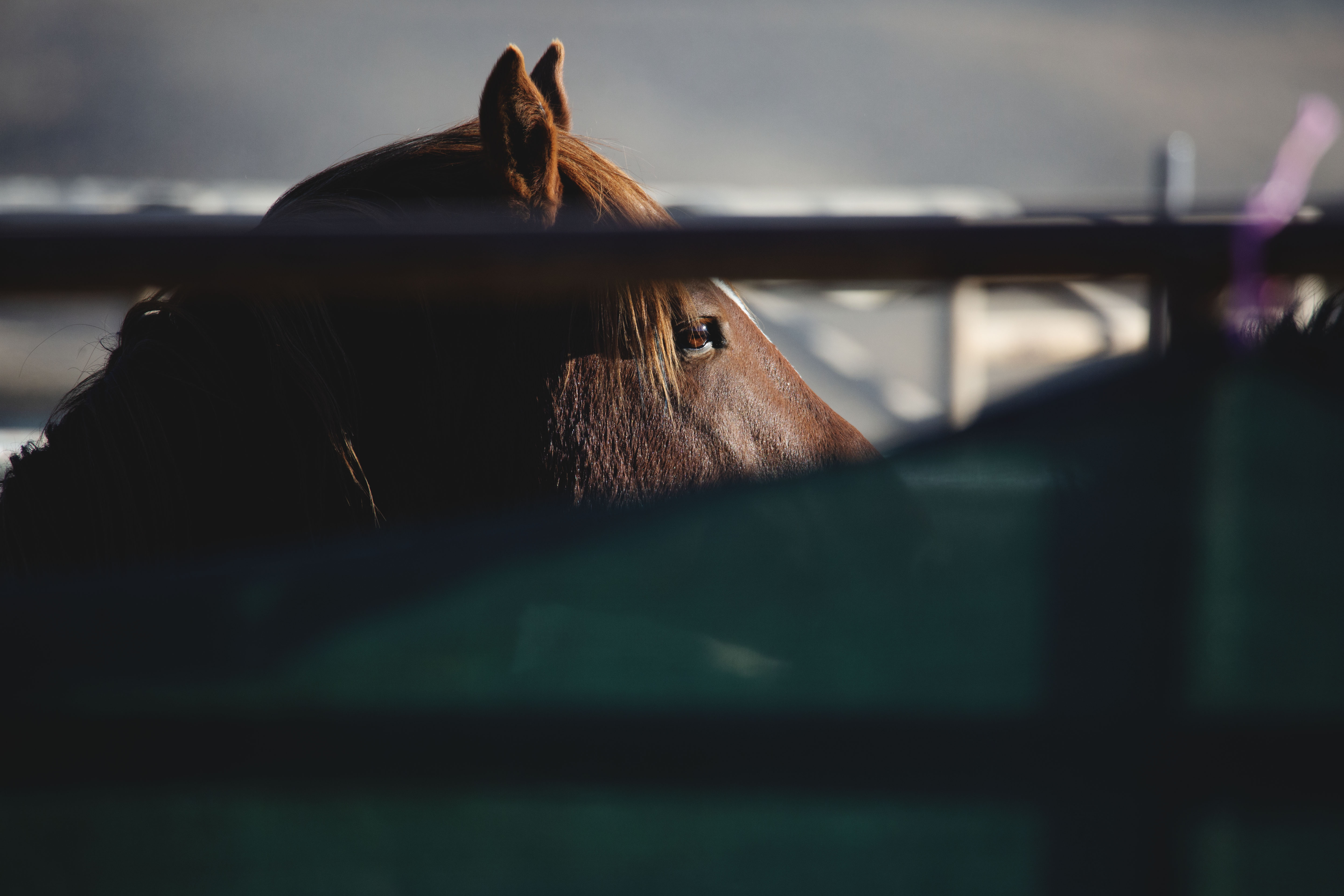
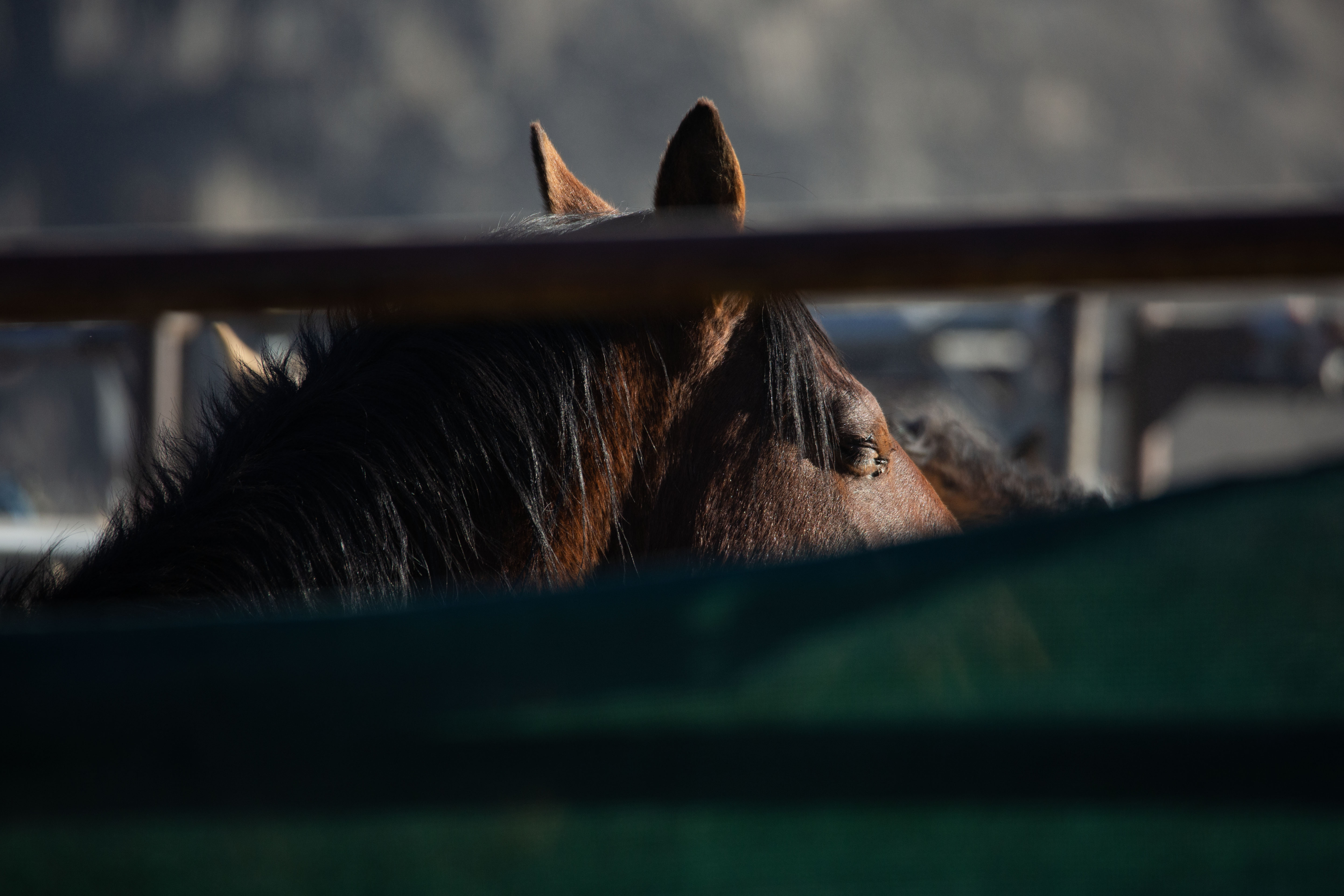
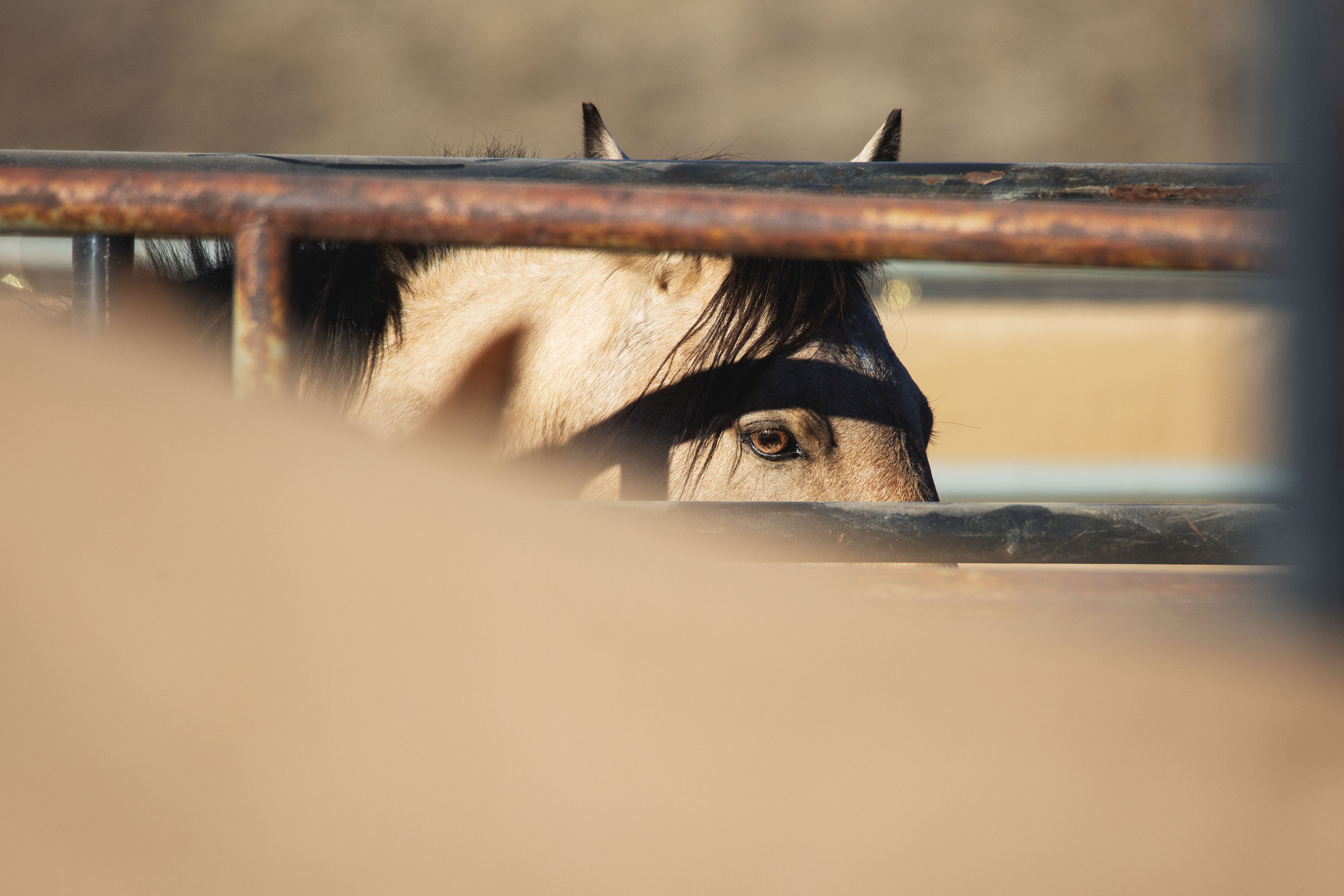
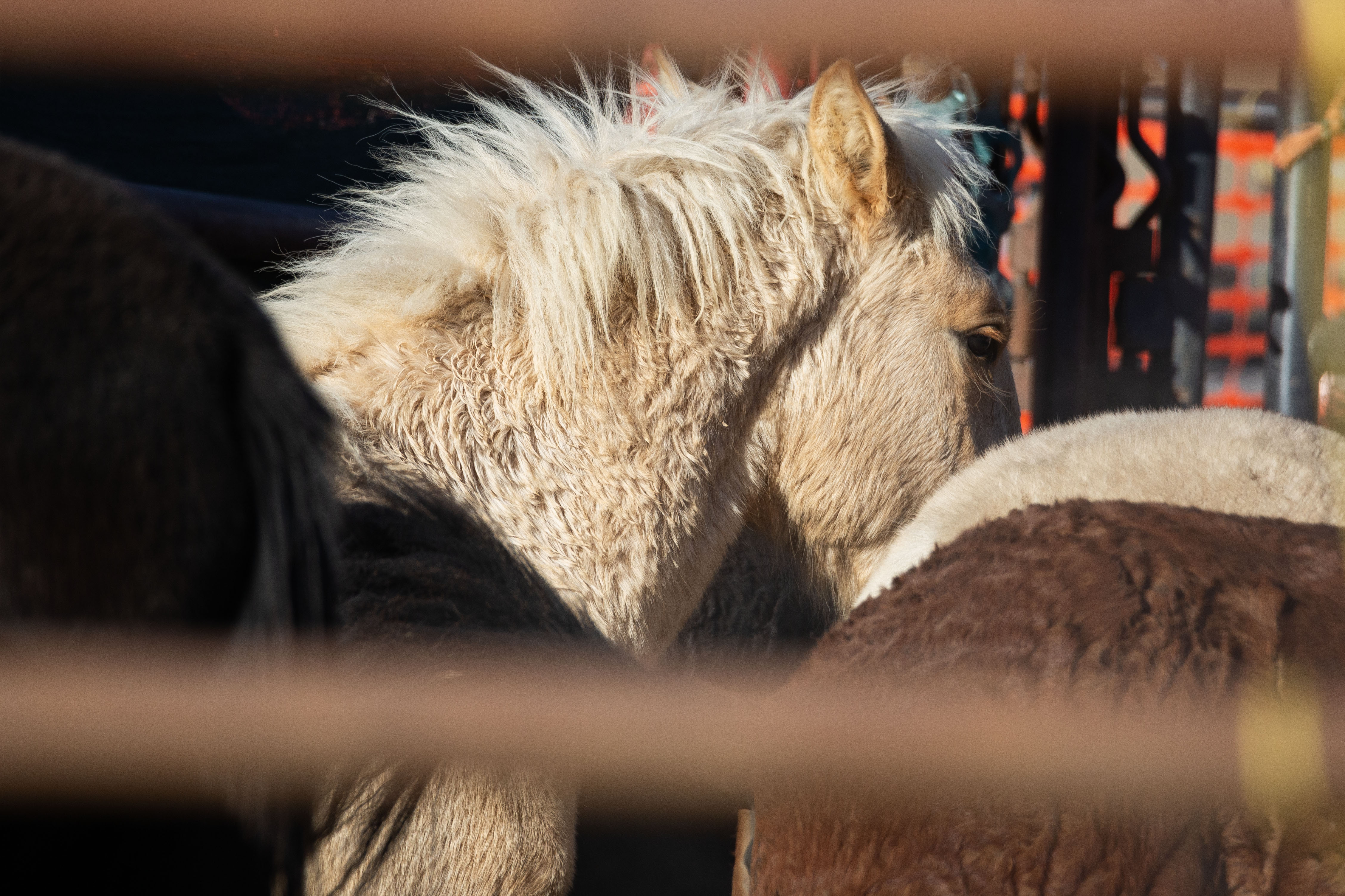
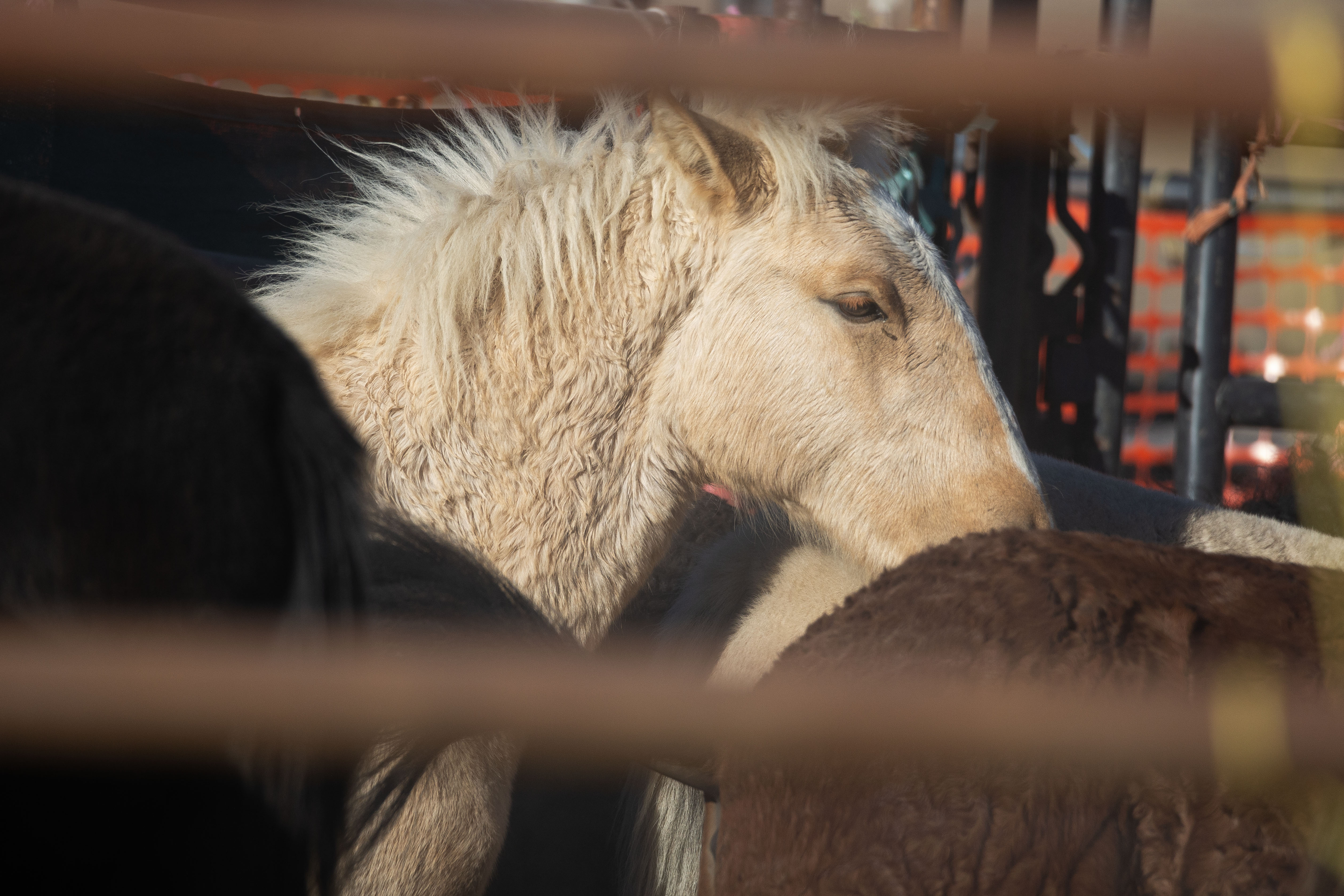
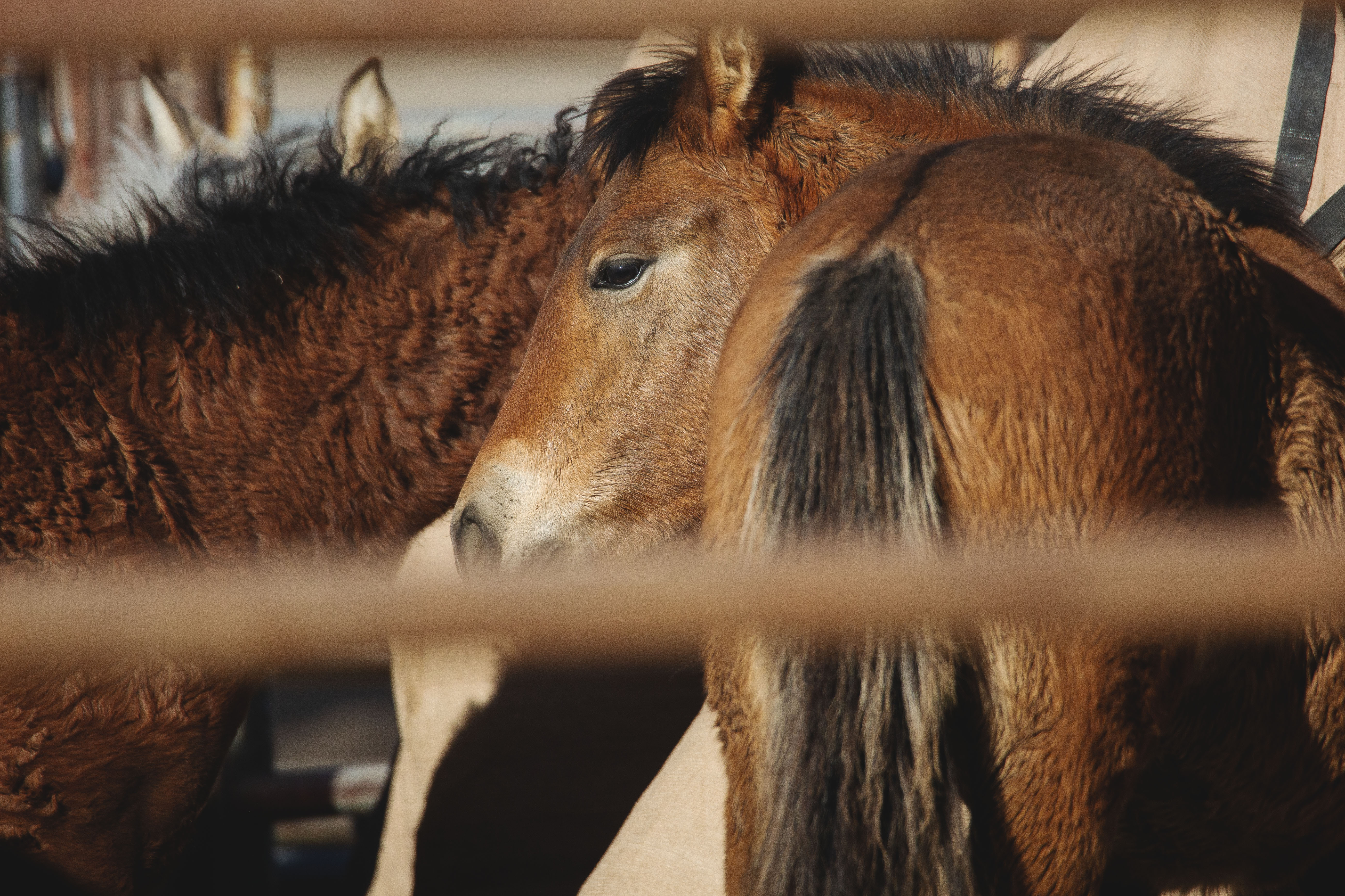
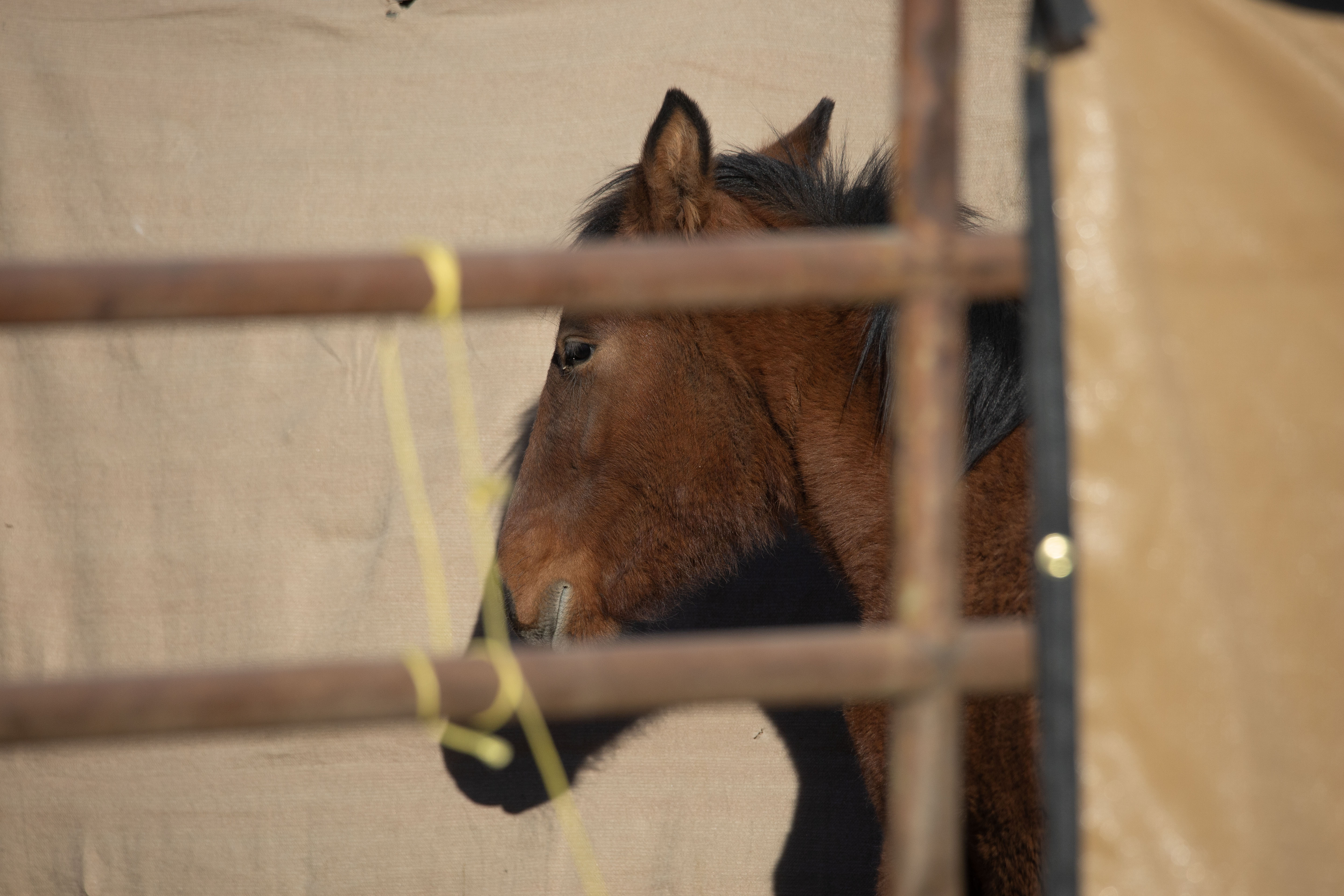
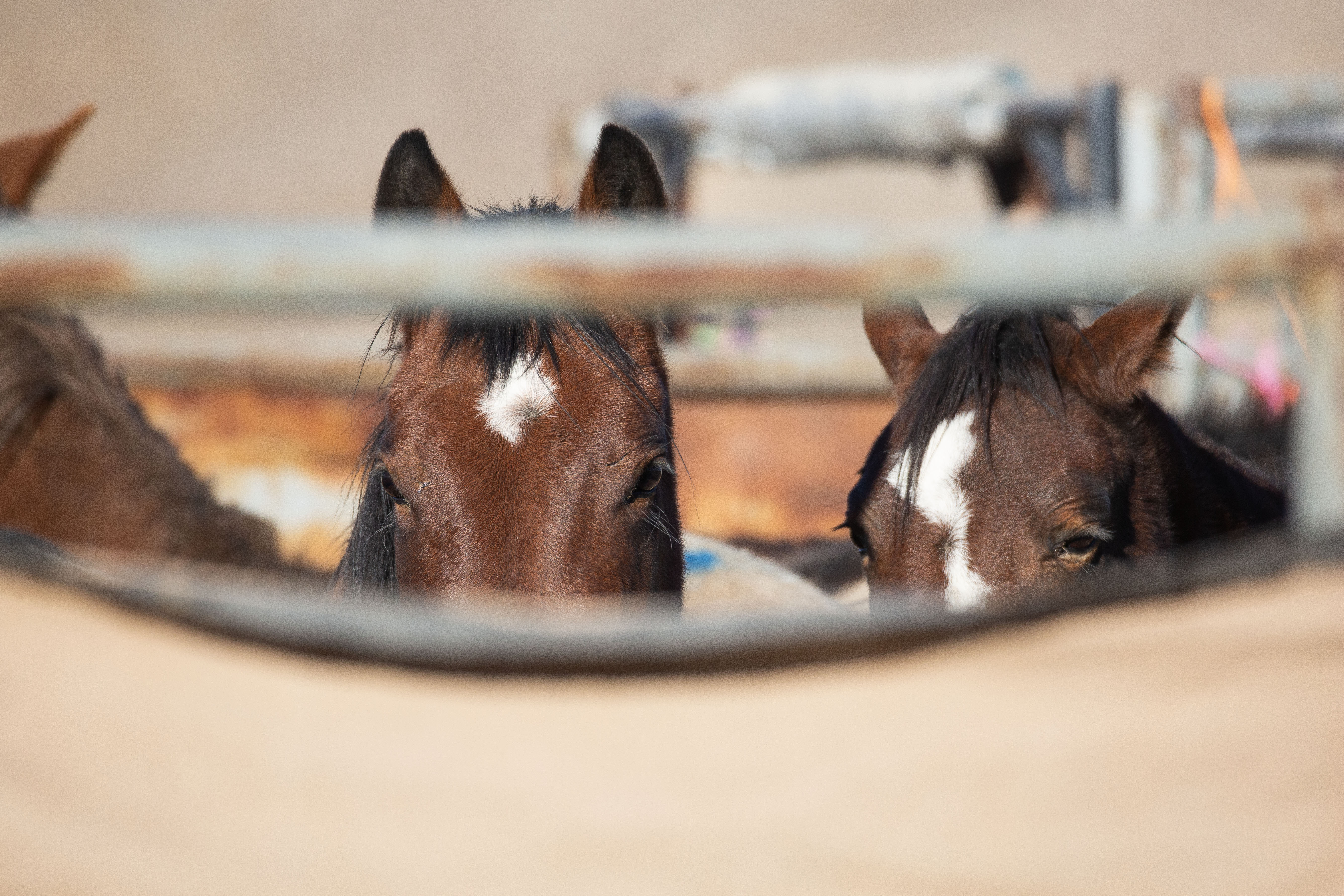
October 28, 2023: 114 wild horses were captured and there was one death after the BLM euthanized a 20+ year-old stallion who suffered a broken leg upon escaping the trap.
Today was another very cold morning with the low being around 15ºF. We left the Eureka Fairgrounds at 6 am to a new trap site (trap 3). This one is located within the HMA boundaries (previous trap sites have been located outside the HMA).
We traveled north on Roberts Creek Rd for about 10 miles before taking a road east closer towards Mt Hope. By 10 am the pilot had made several runs. The first run consisted of about 12 horses followed by a large run of 35 horses.
Some of the horses had diverted from the main group and the pilot had to go get the remaining 3 horses. Both runs went smooth despite the big numbers. The horses were very energetic during the runs but once they entered the catch pen most of them settled down and did well during the sorting.
However after 2 more runs (one consisting of around 20 horses the other just 5). A group of 3 horses came in, two bays and a big palomino stallion. I was watching the palomino closely as he seemed a bit flighty and all of a sudden I see him trying to launch himself over the panel. It looked like he was using the panels as stairs, I went down and then got up again.
There was no added pressure that ultimately made him do this. While all of this was going on, a wrangler quickly sprinted to his saddle horse getting ready to rope the palomino.
At this point I had no idea if he was okay or not since most of the view was obstructed by trees and the angle we were at. About 10 minutes later the IC (incident commander) came to tell us that he was in fact, not okay. As he launched himself over the panel, his hind legs got stuck and he suffered a compound break.
I was told they were able to rope him within 40 yards of the trap and end his suffering quickly. He appeared to be an older stallion. 1pm: 6 horses came into trap and one fell behind at the start of the wings. It looked like an older, skinnier horse.
Two ropers went out and successfully roped the horse. At 2:20 another 9 horses came in. Not much later we were notified that the day had concluded. Temporary horses: when I got to temporary holding I saw the staff handling a smaller foal and got it reunited with it’s mom.
Overall the pens are very crowded today. I noticed a separate pen of horses that were marked and it was assumed they were the mares that would potentially get released back on the range again.
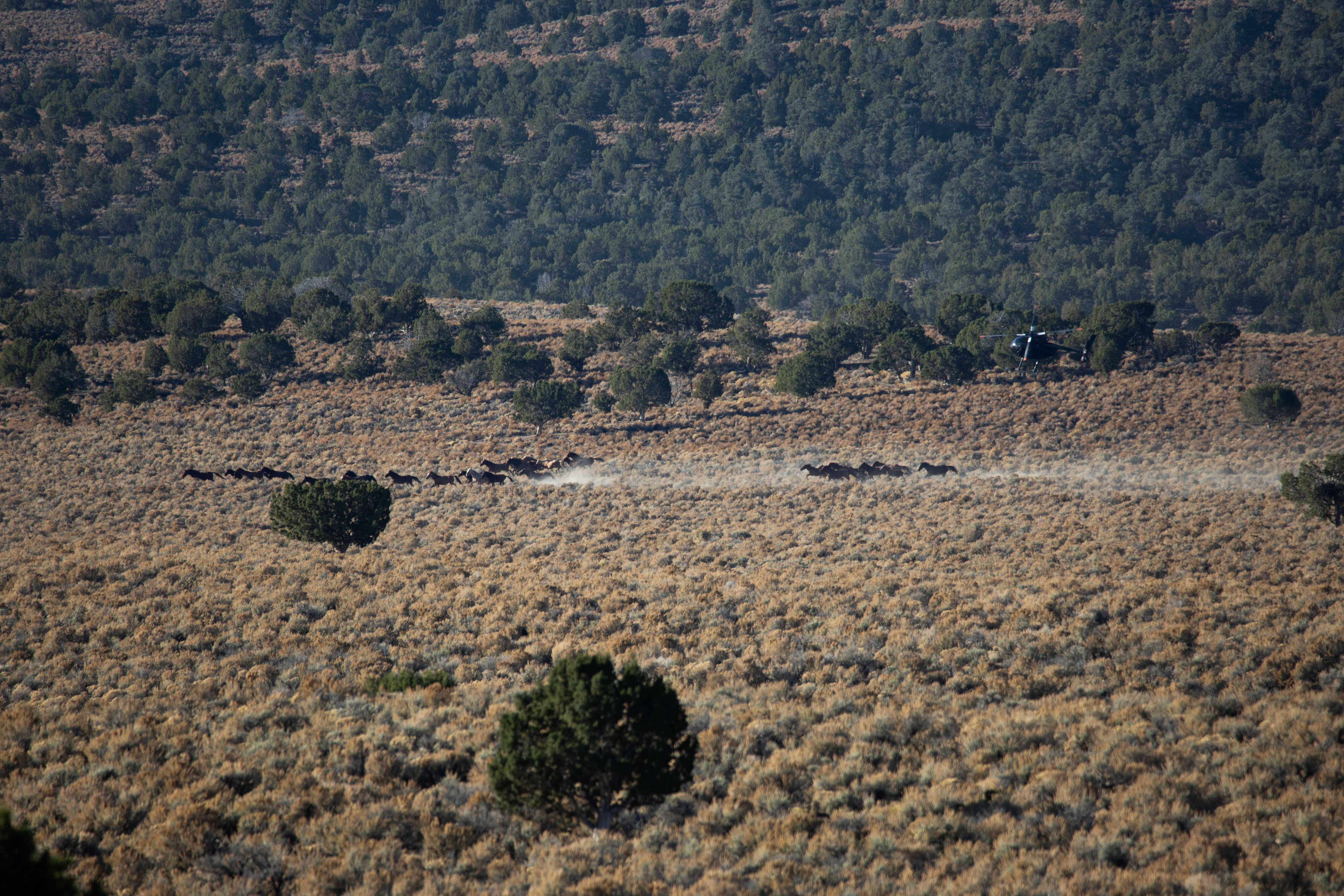
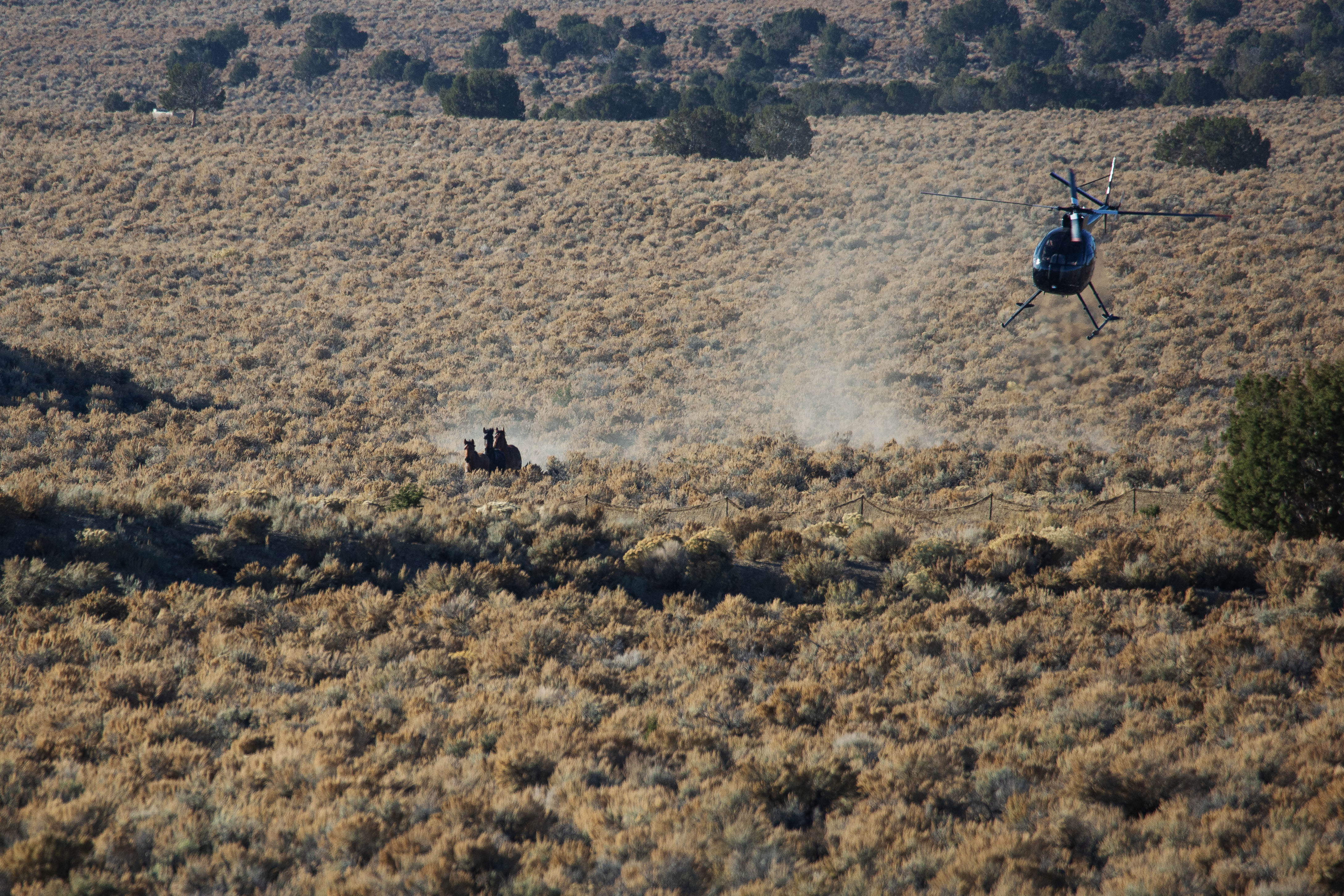
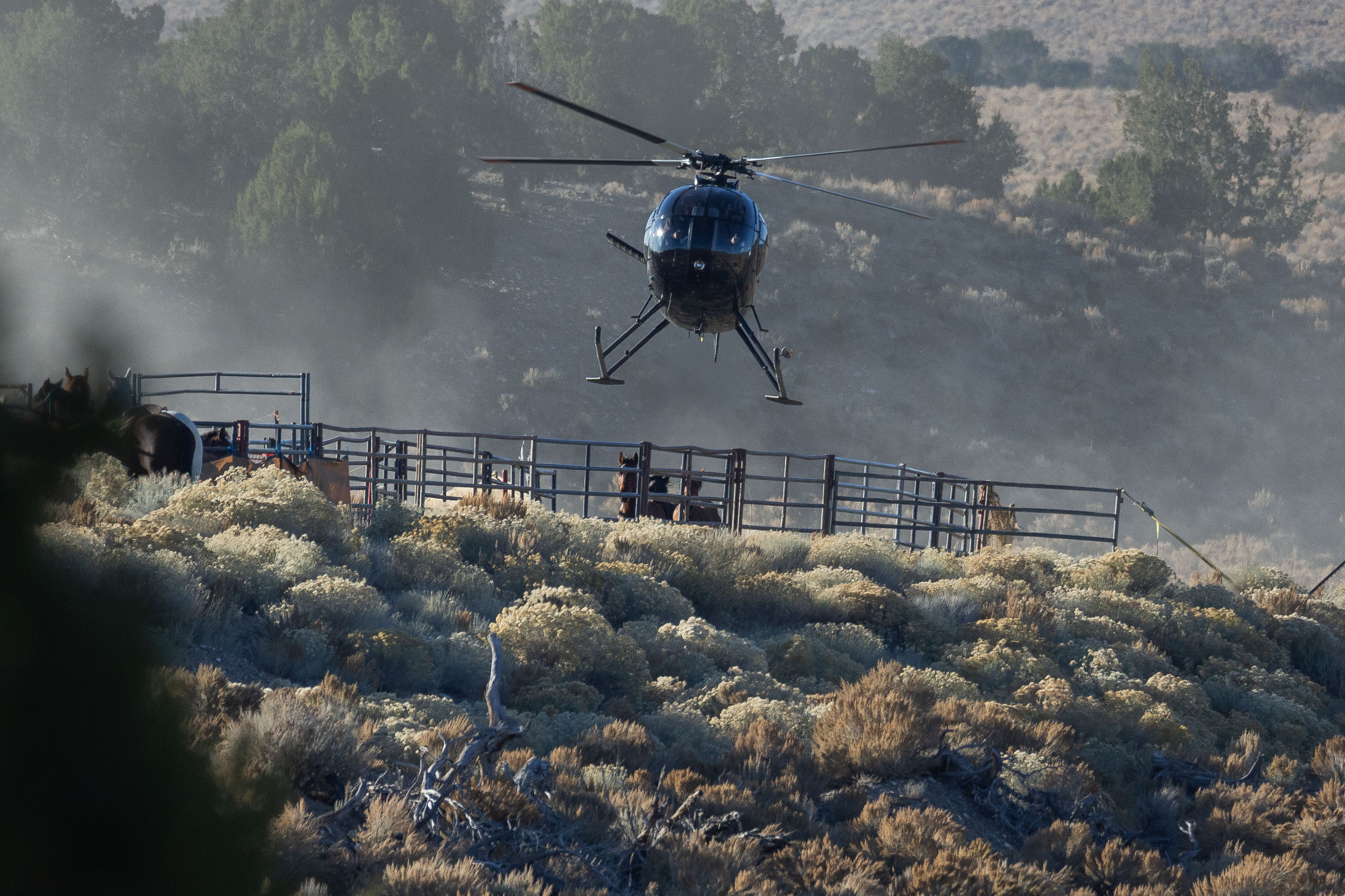
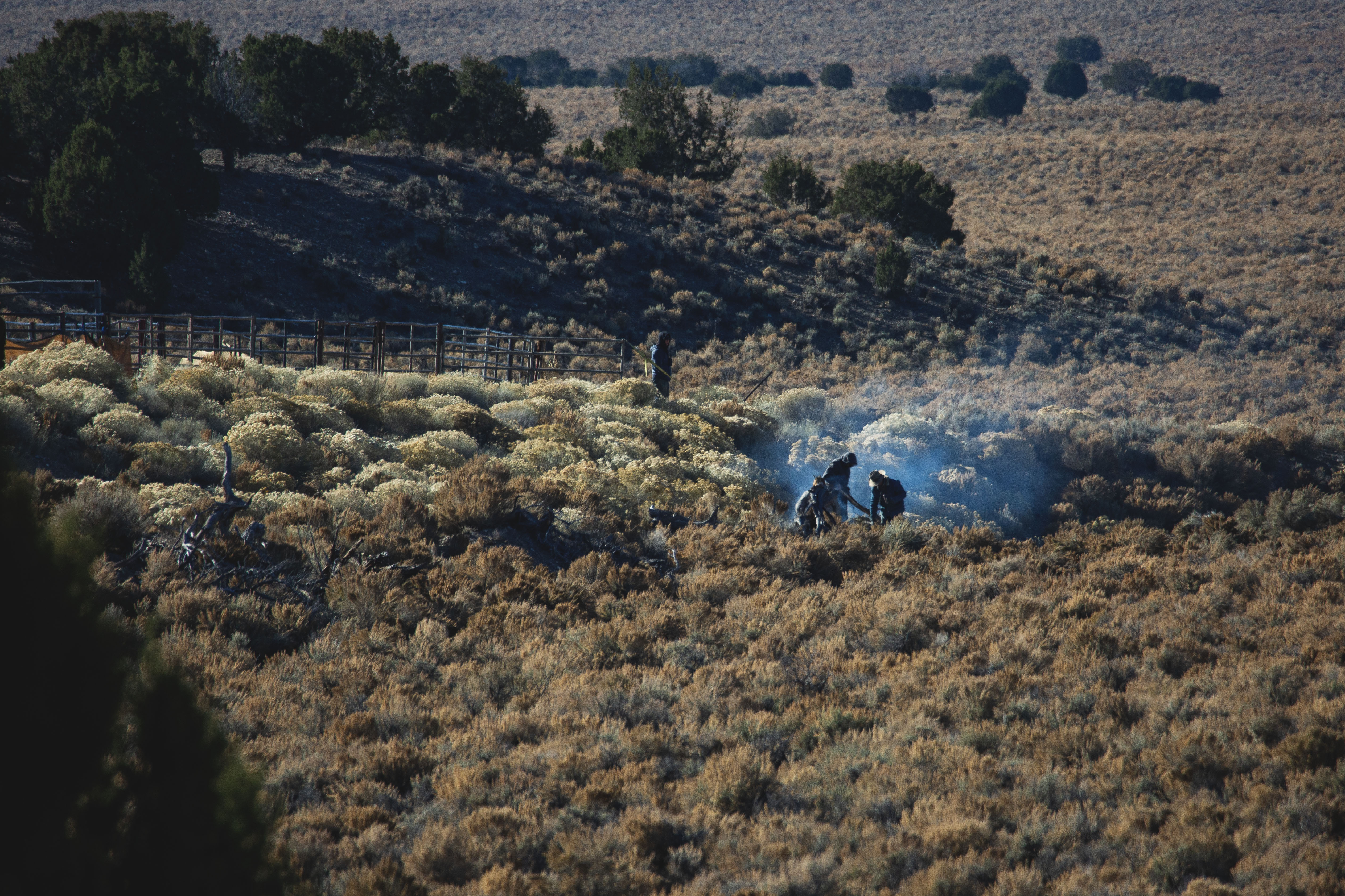
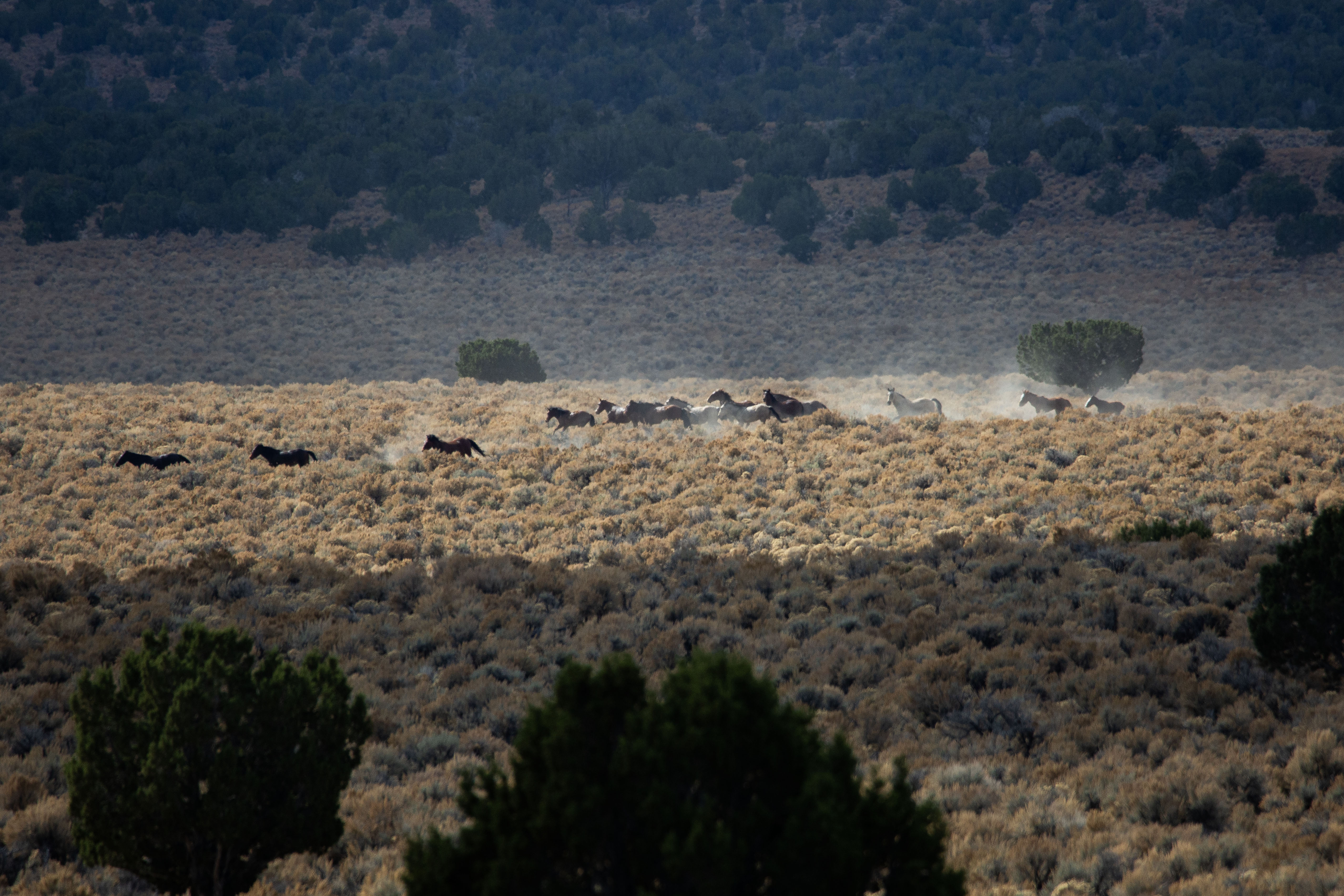
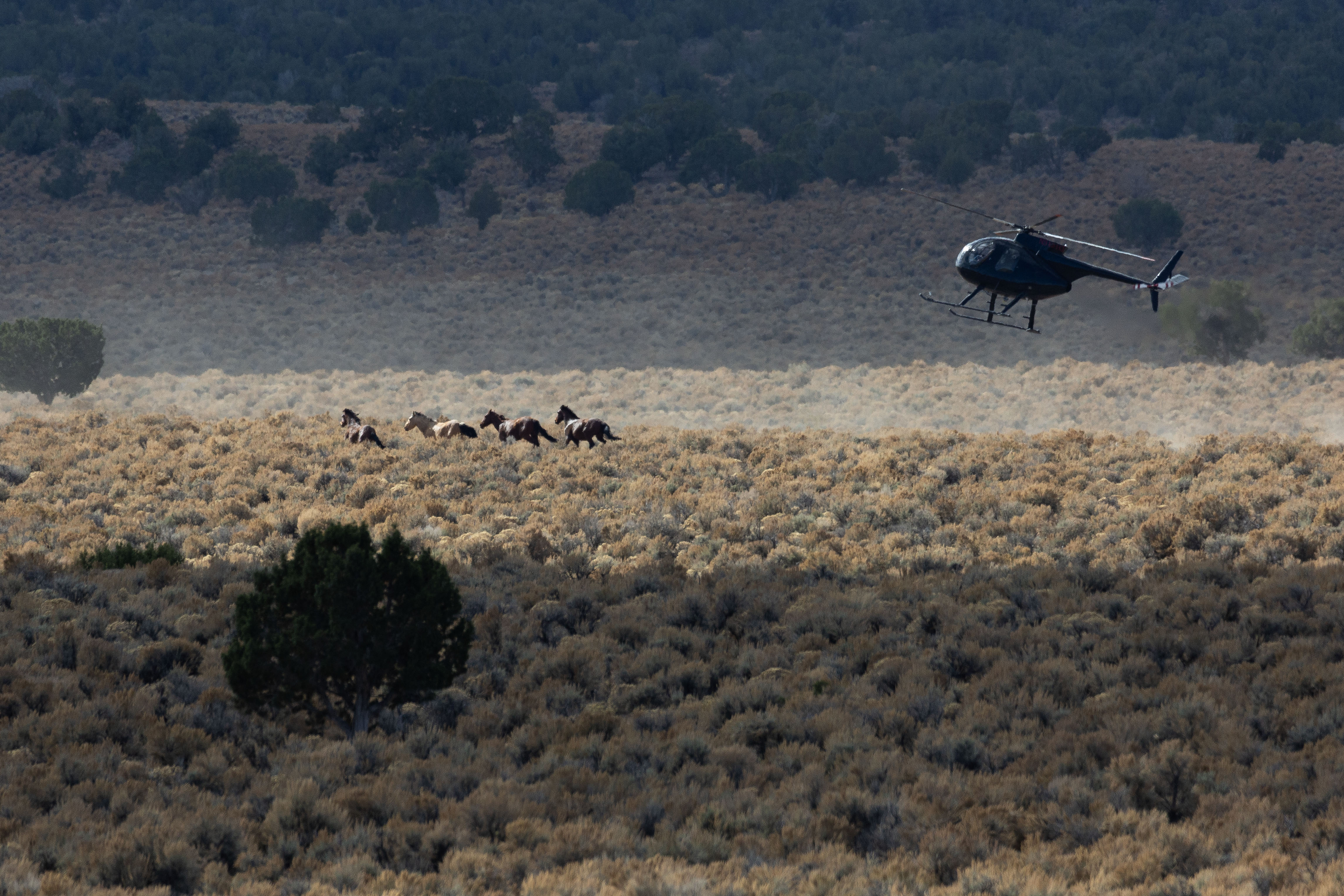
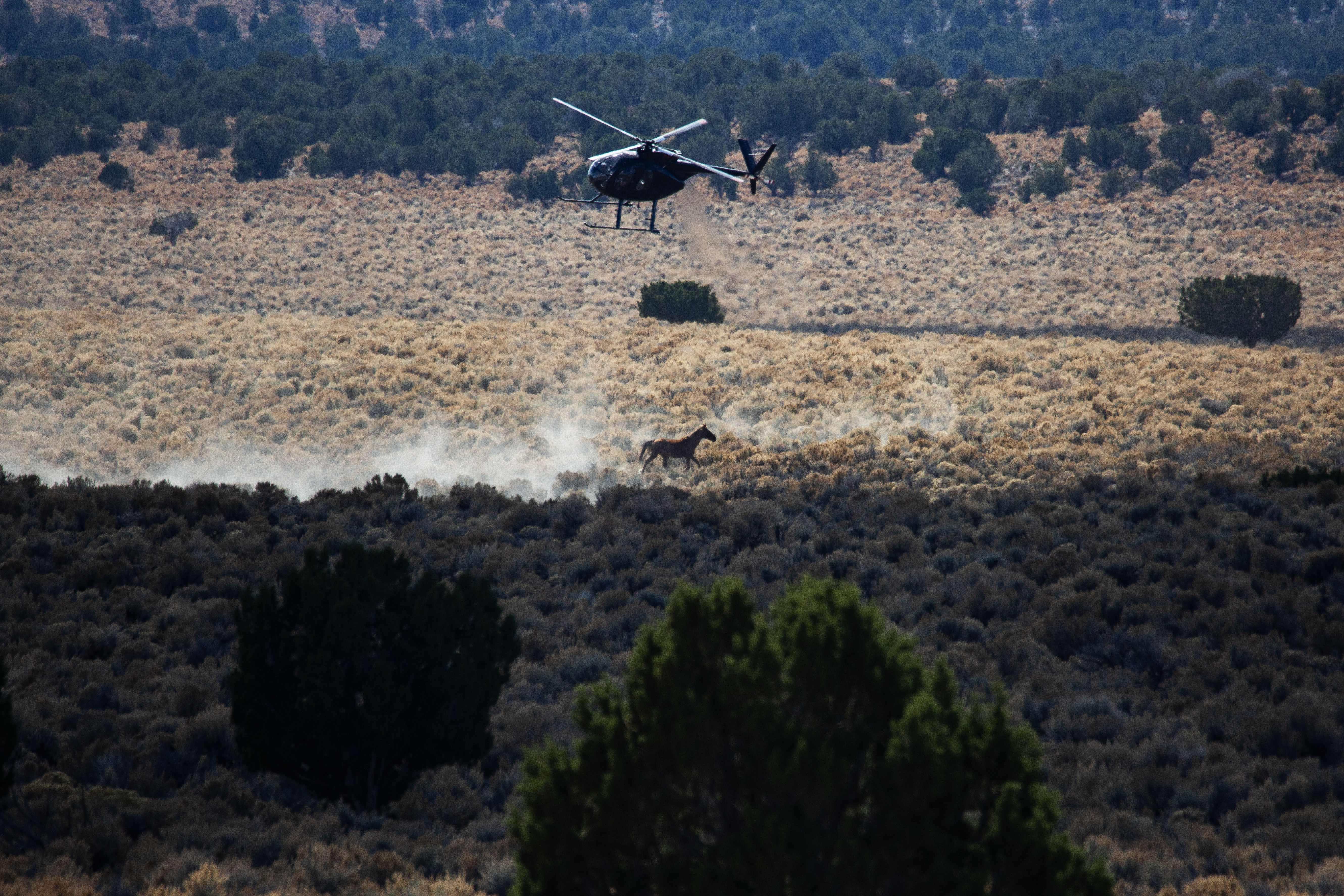
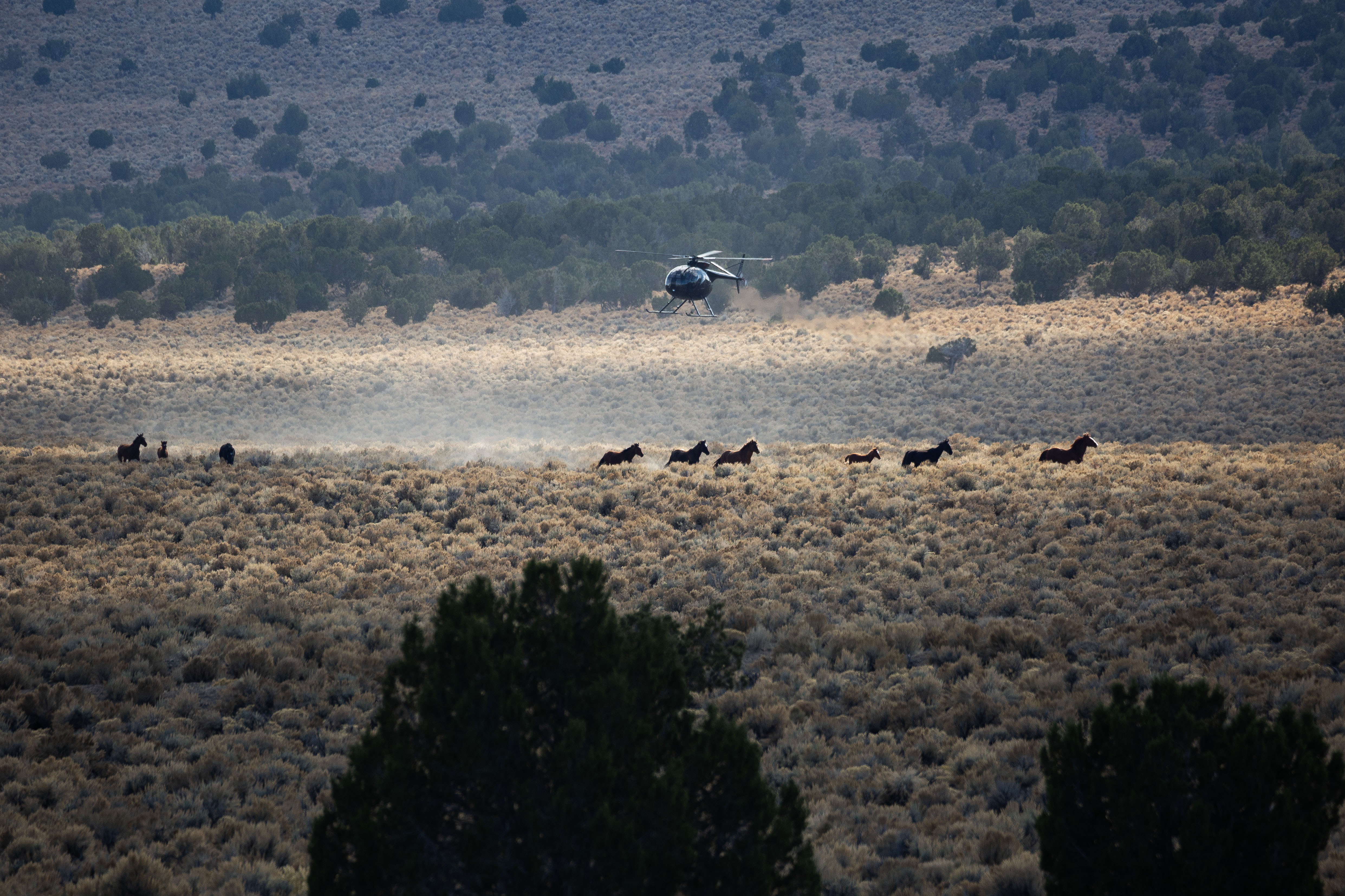
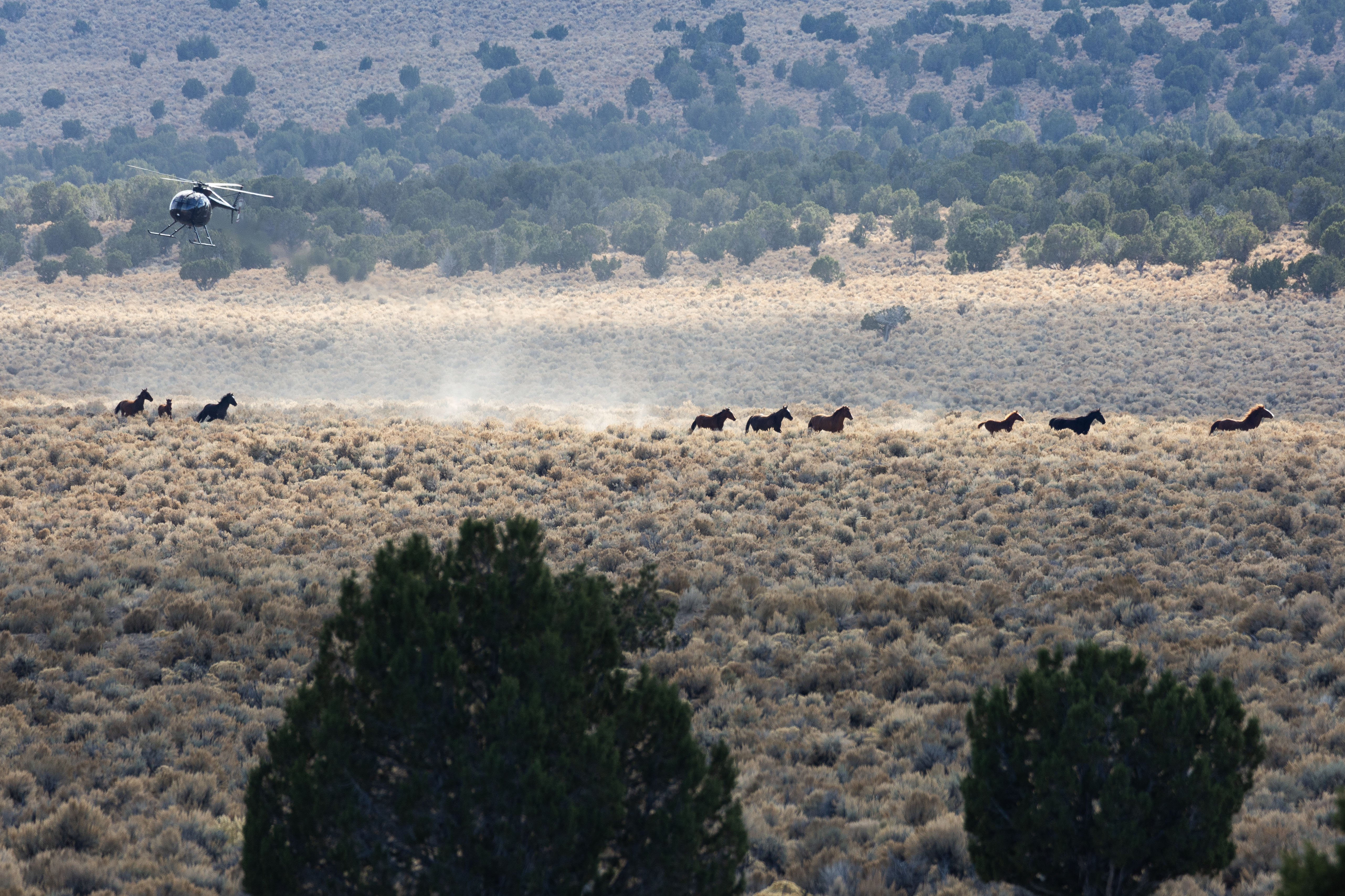
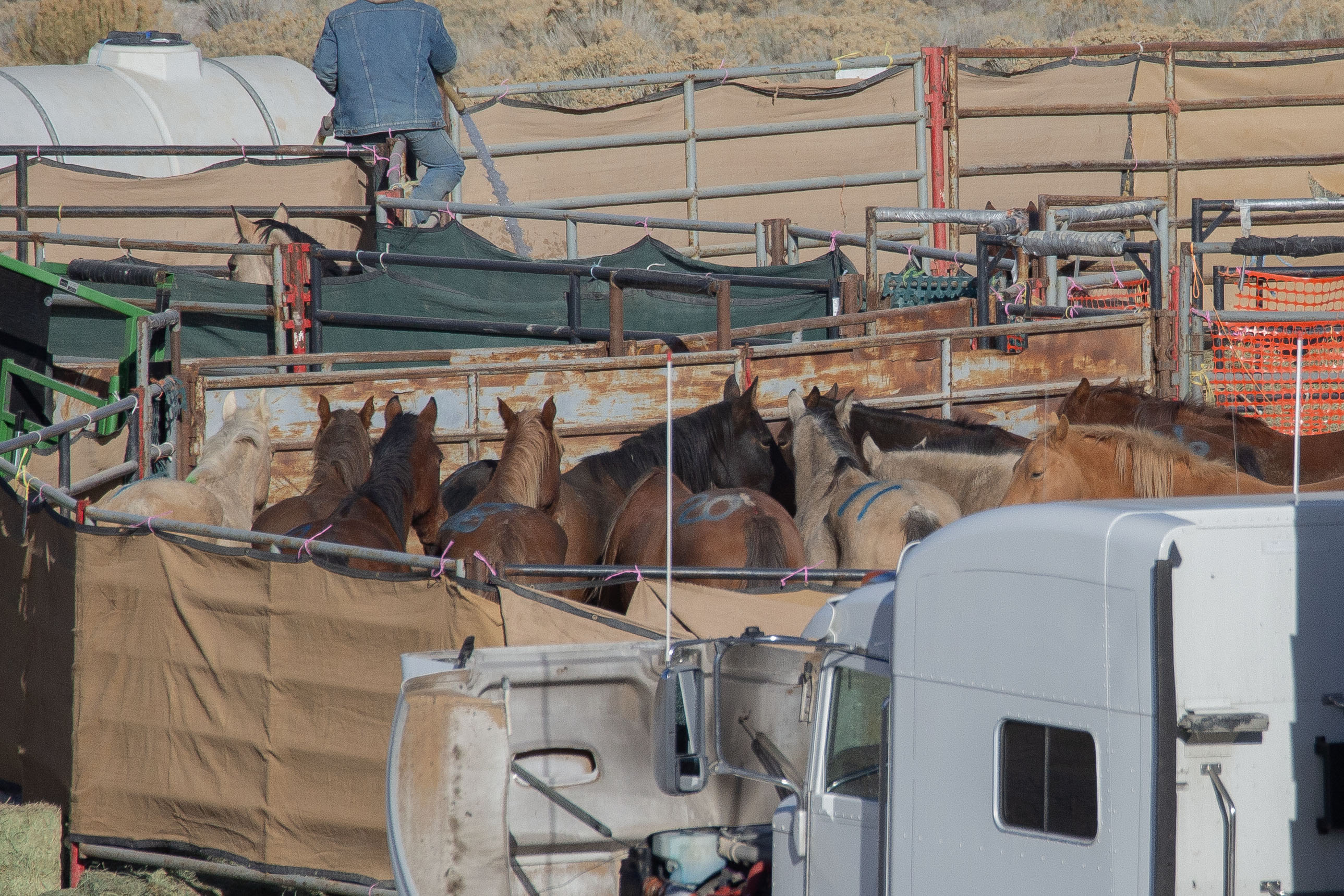
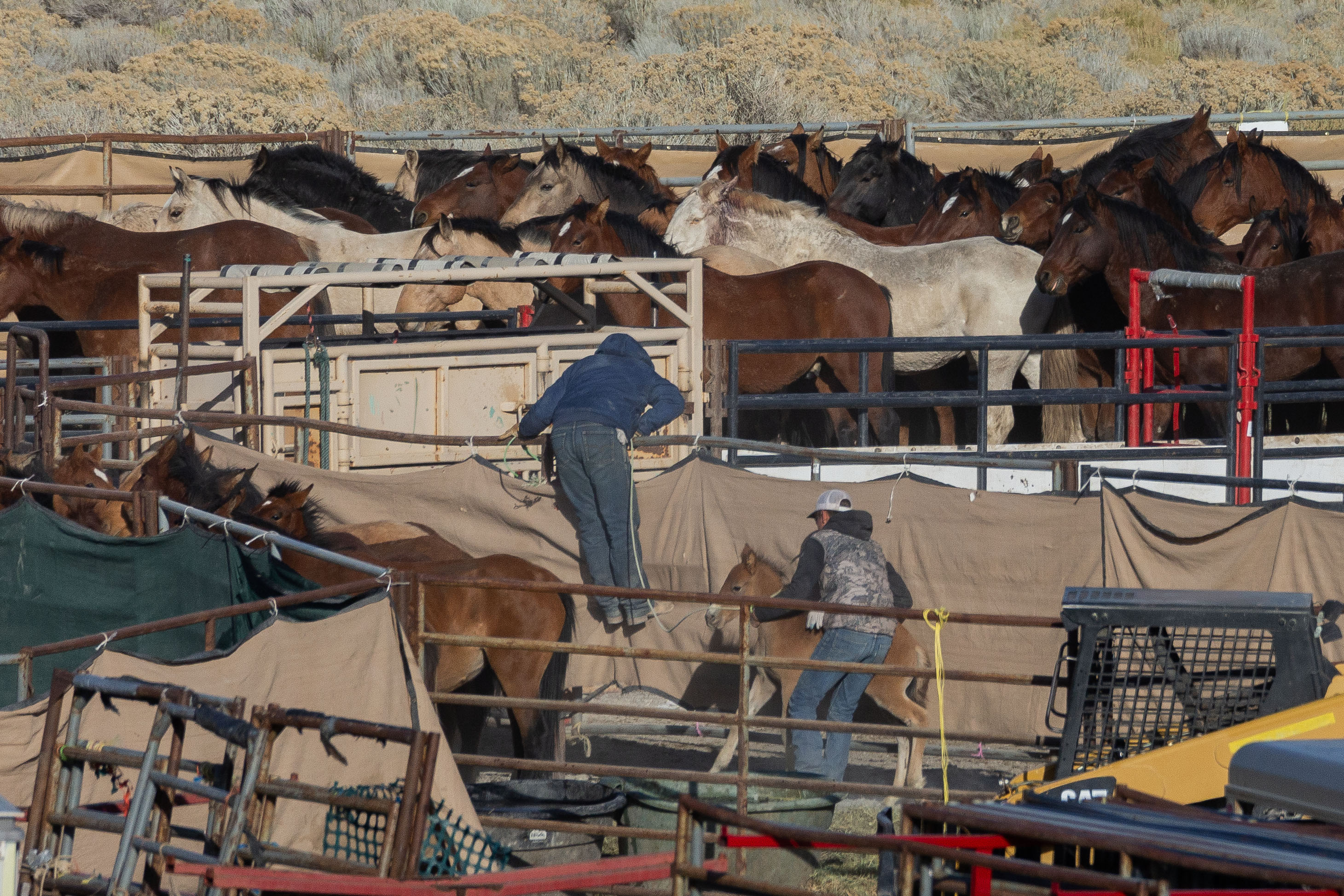
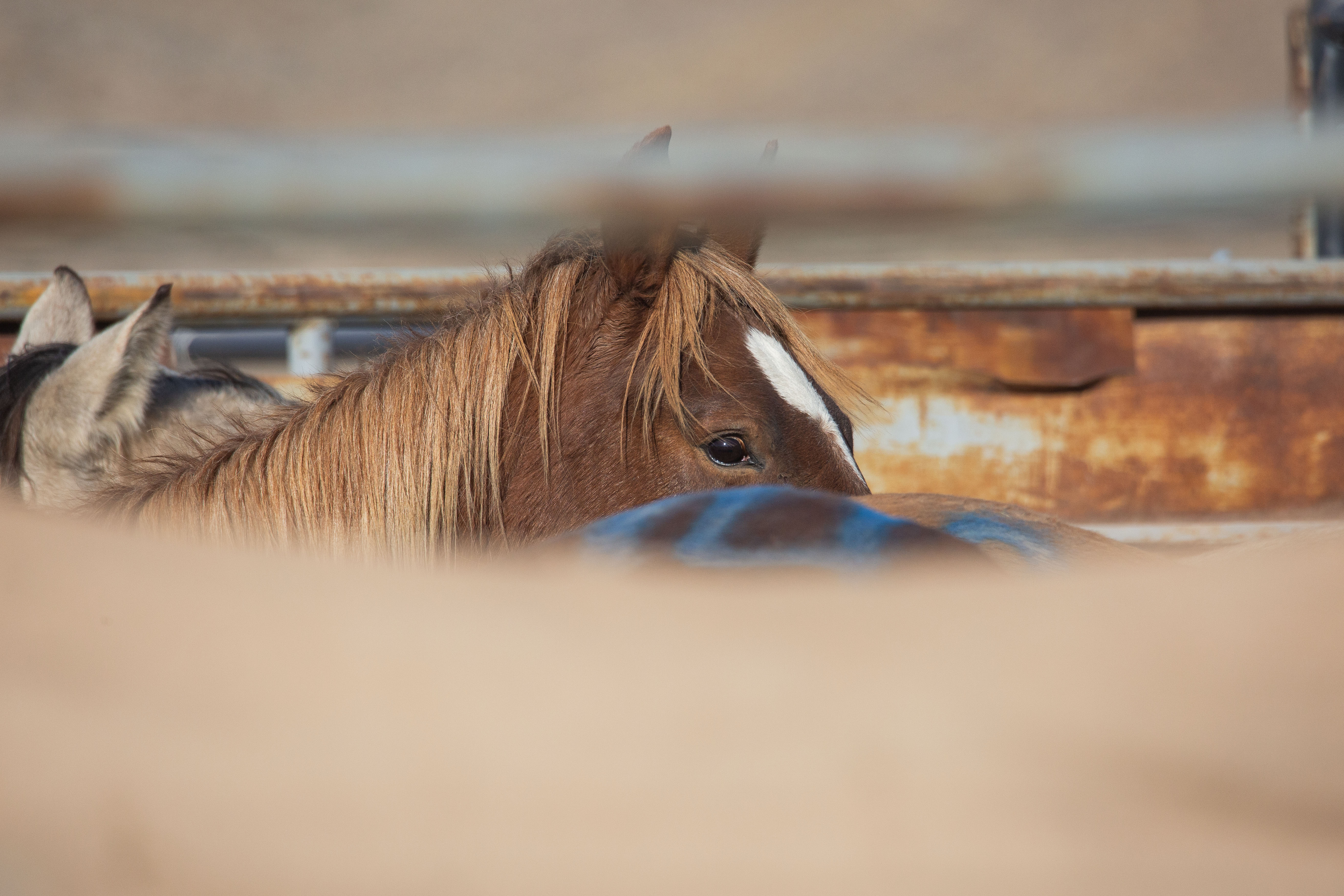
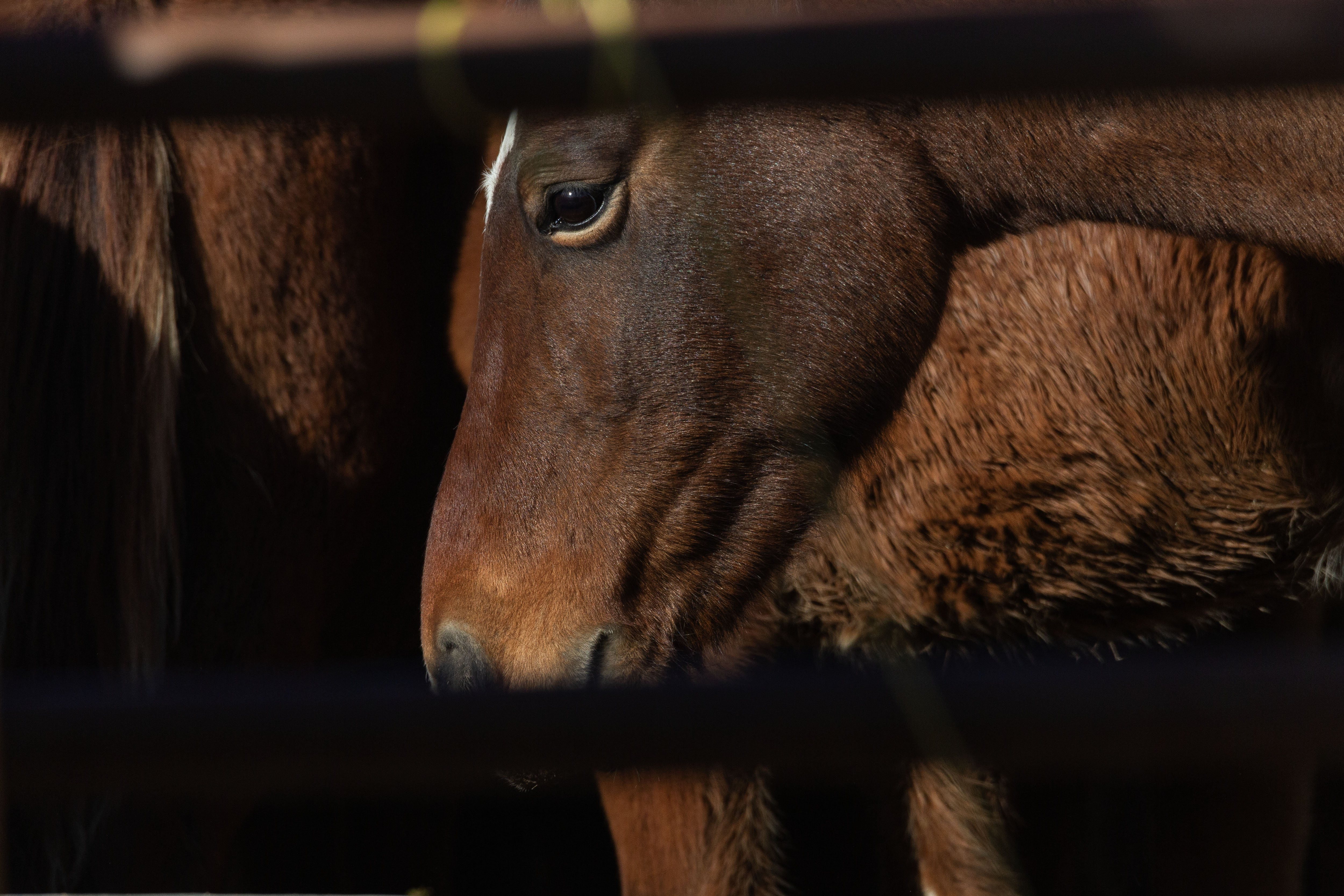
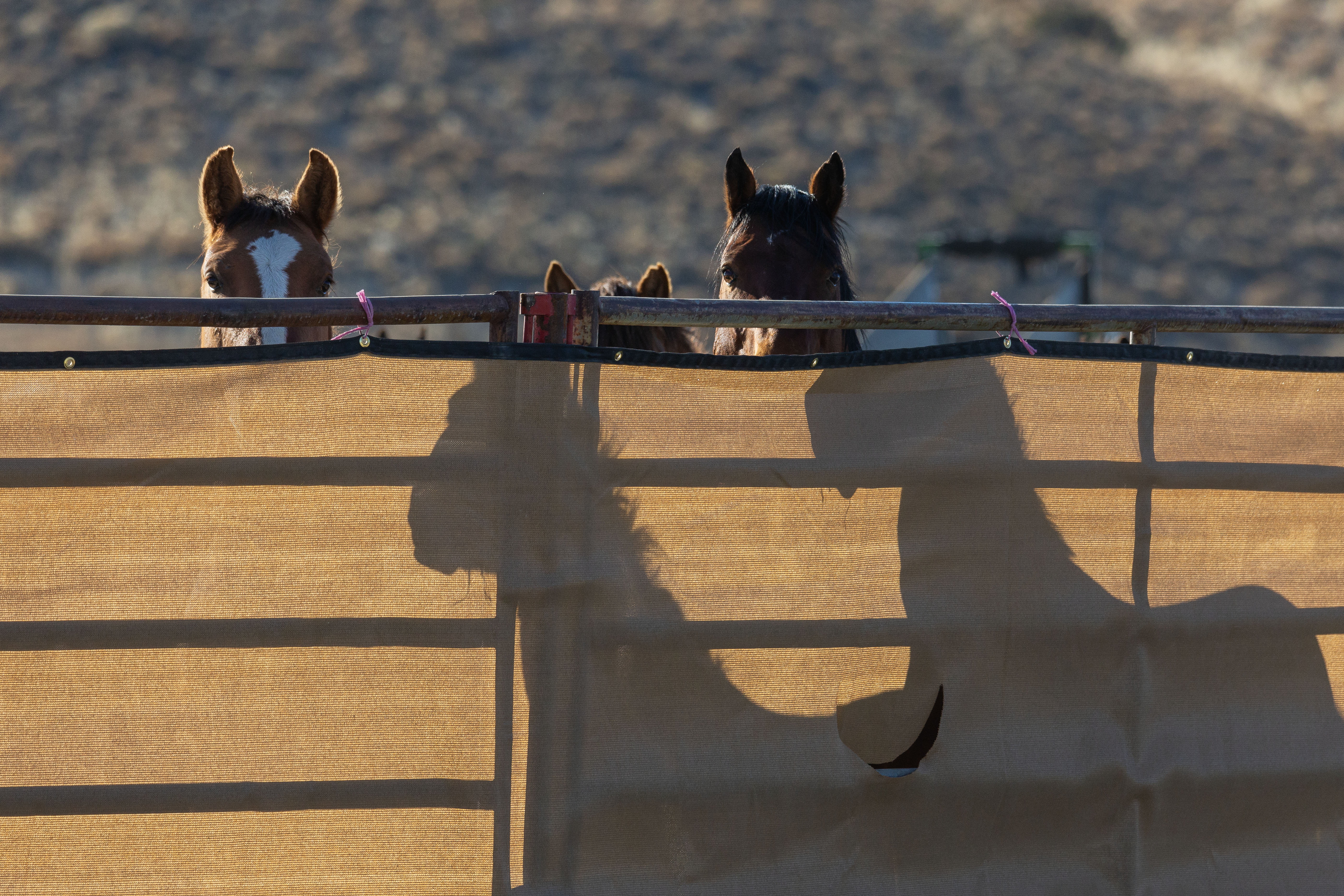
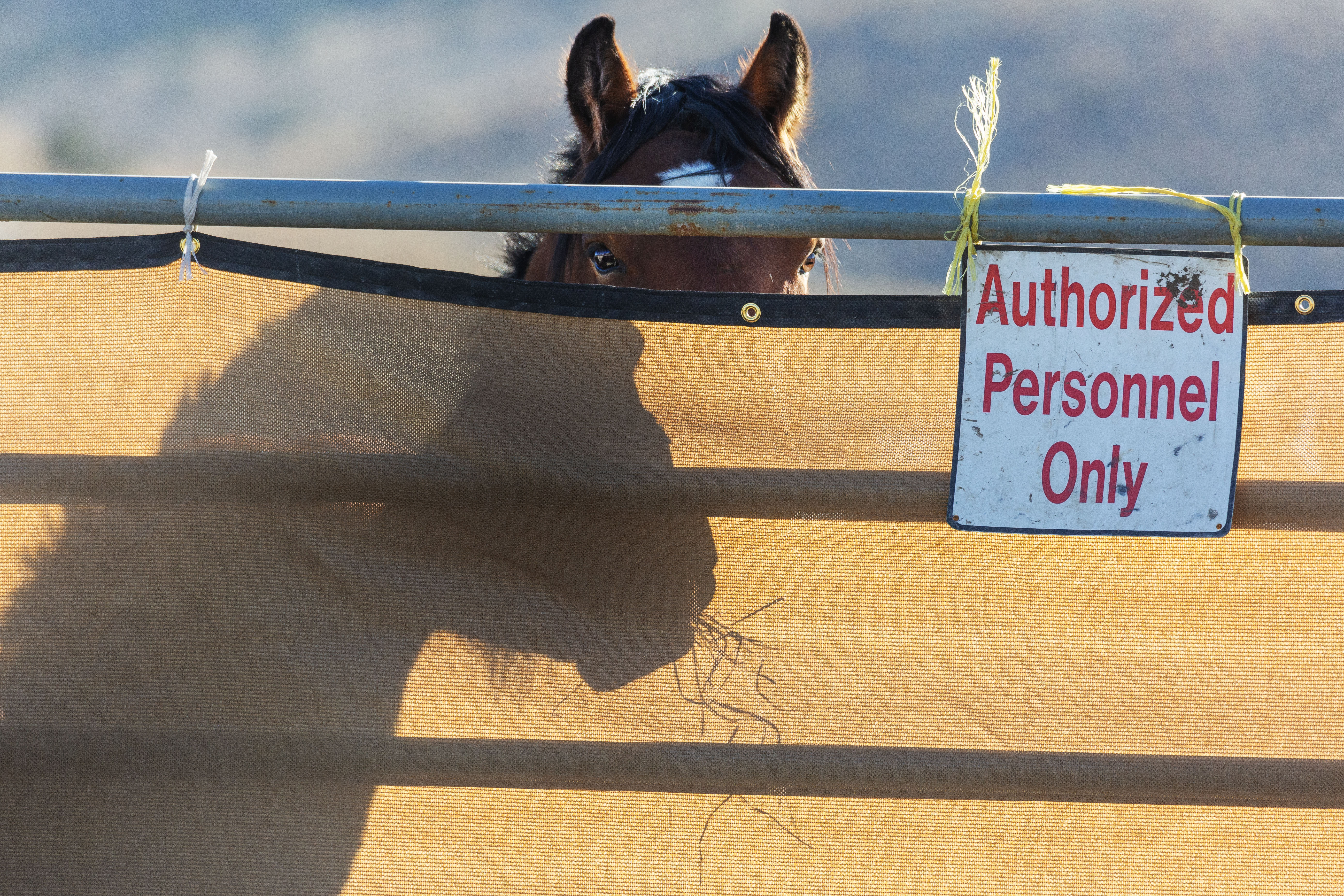
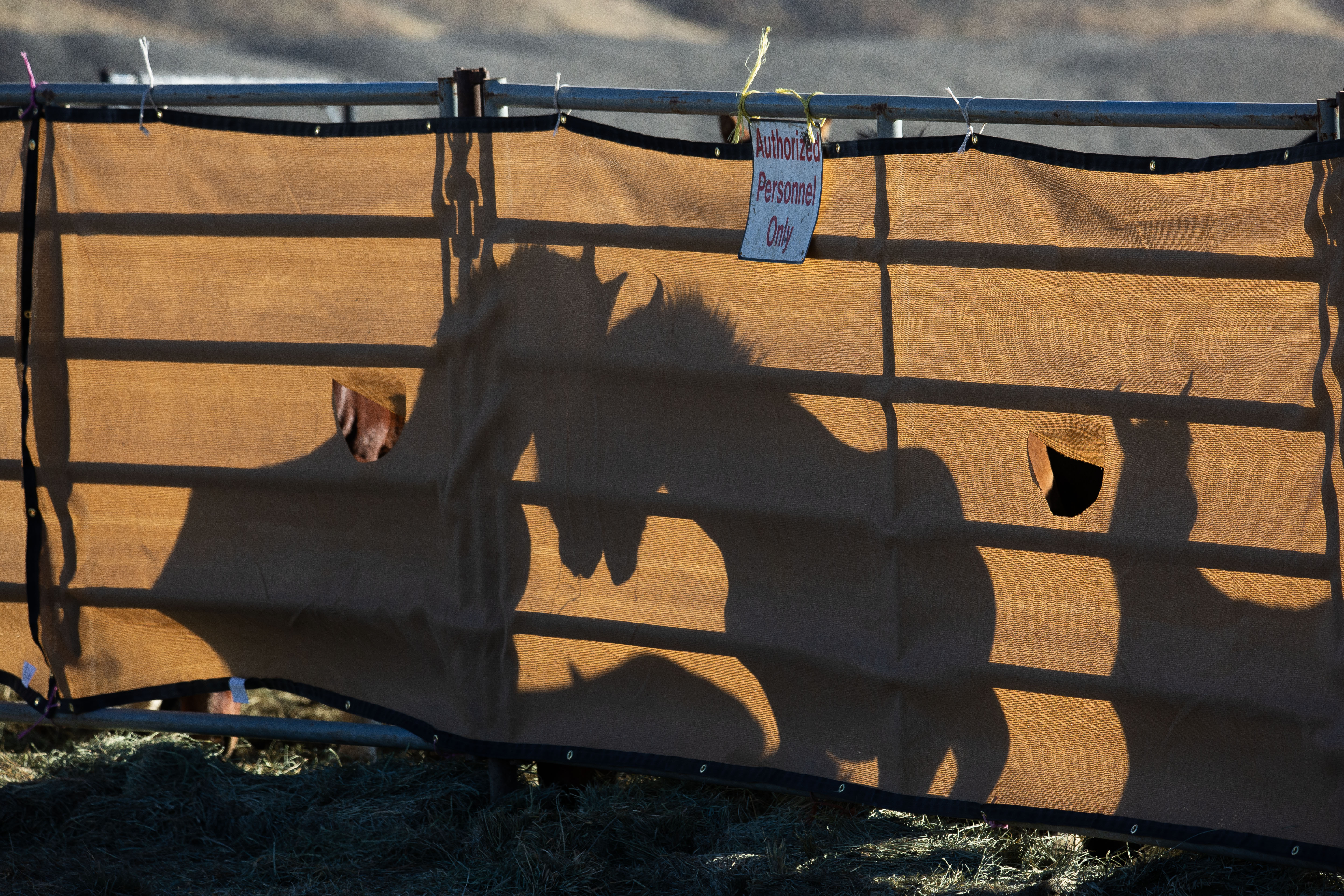
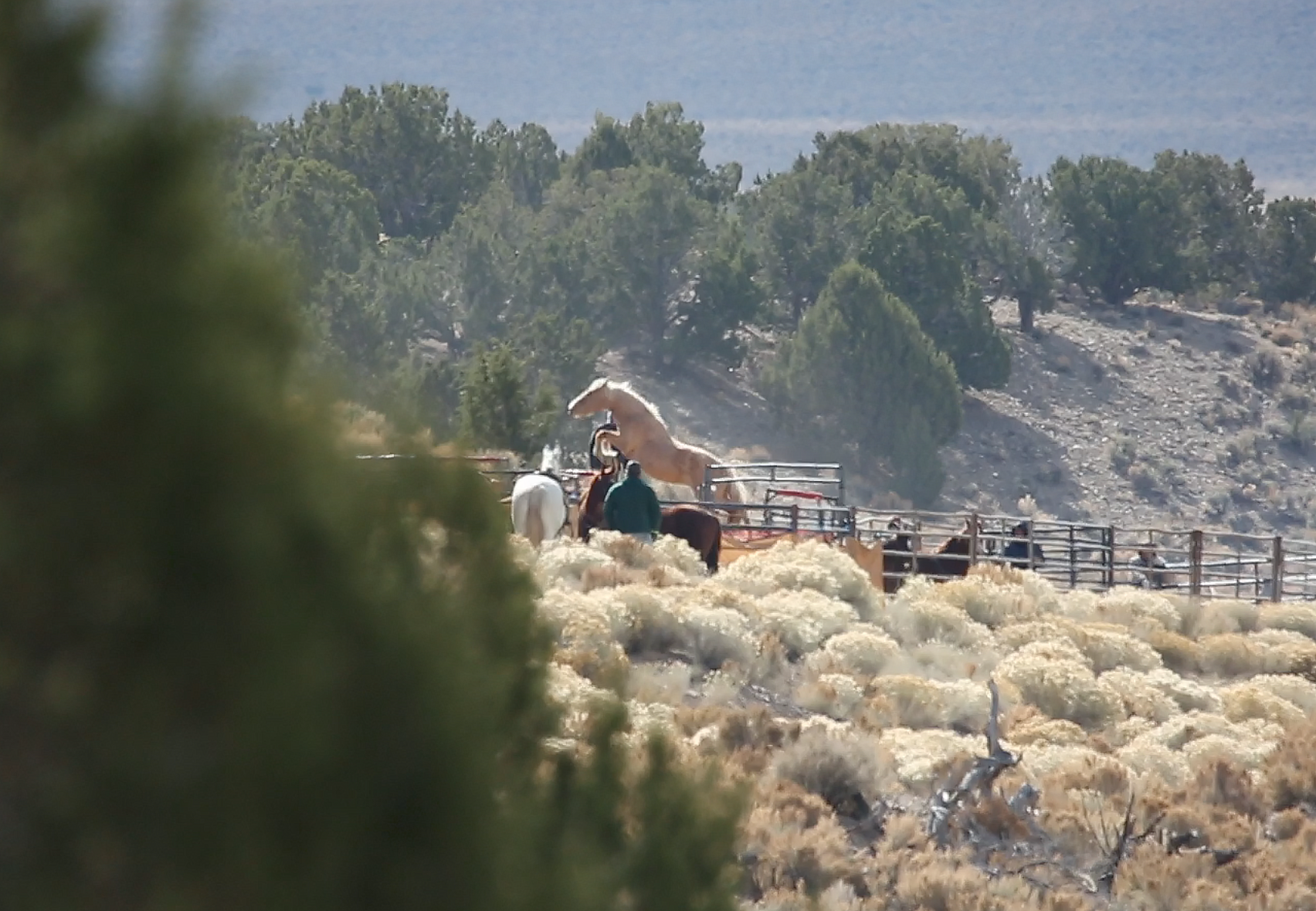
October 27, 2023: 17 wild horses were captured
We met at the Eureka Fairgrounds and left to the trap site at 6am. This morning was by far the coldest temperature we’ve had with a low of 13ºF. So as expected, the horses were quite fresh again. This is the 3rd day at this trap site with yesterday being the busiest day.
Today was expected to be a slow day and possibly the last day at this trap site. Between 9 and noon the pilot made 4 runs with each band consisting of about 4-5 horses.
Only one of the bands was hesitant before going into trap but the helicopter did a final push and they entered the catch pen.
Temporary holding: after the roundup concluded for today we headed to temporary holding and I observed unloading and sorting of the last trailer load. The horses were very calm in the pens except when they started sorting. But they didn’t do much more than trying to avoid staff walking in the pens. I was told that the mares haven’t touched the hay that is presented to them but the stallions have a tendency to snack on it right away.
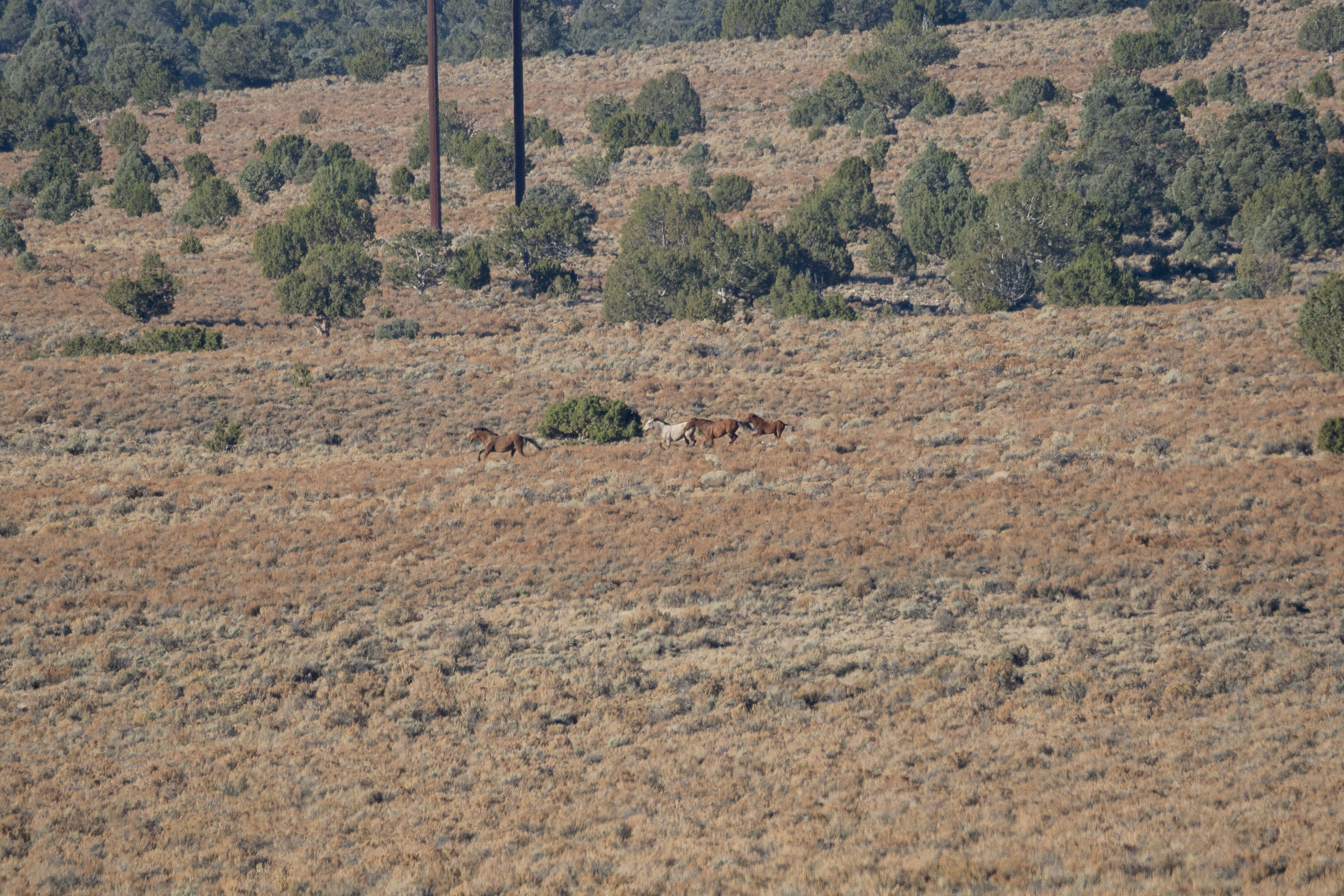
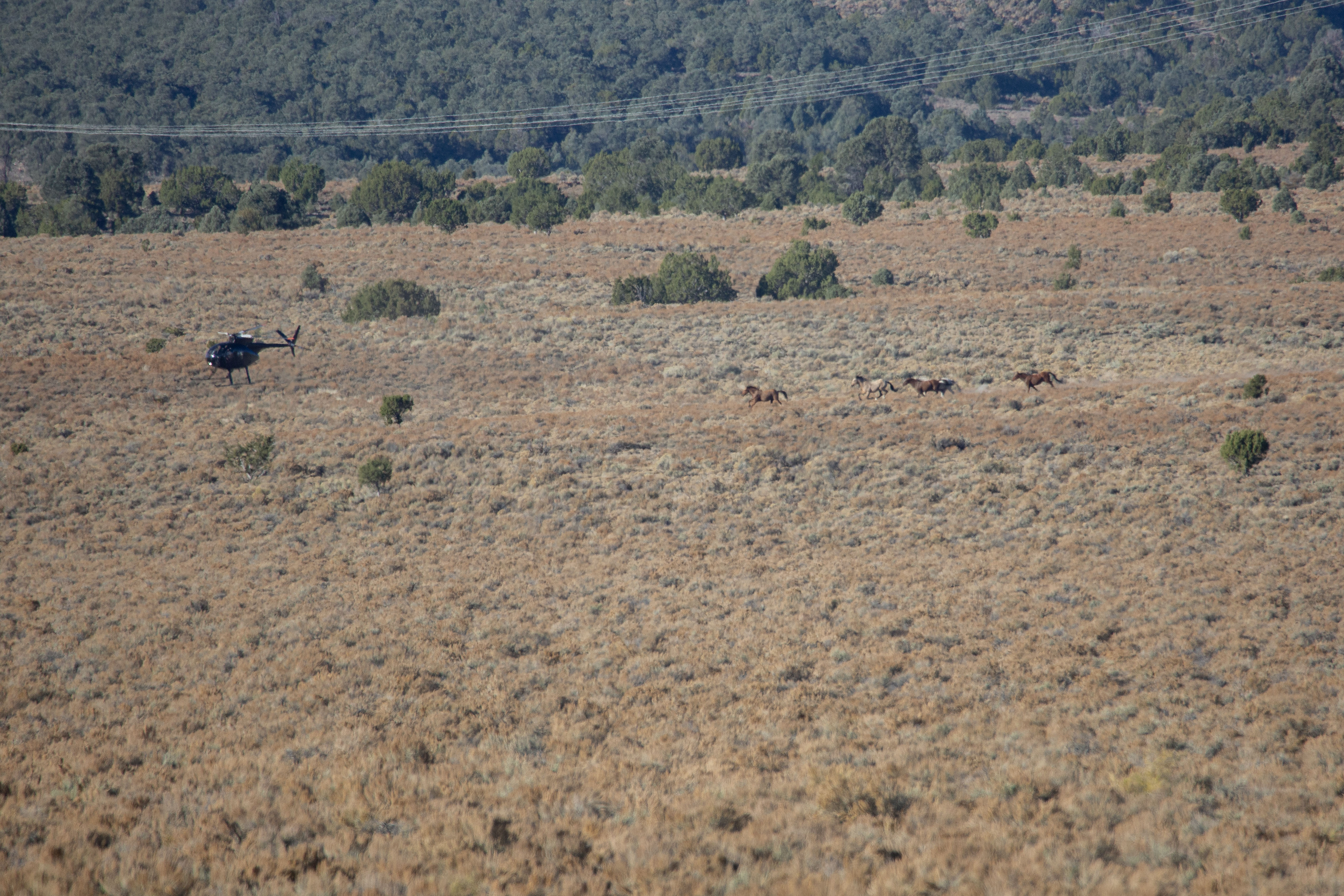
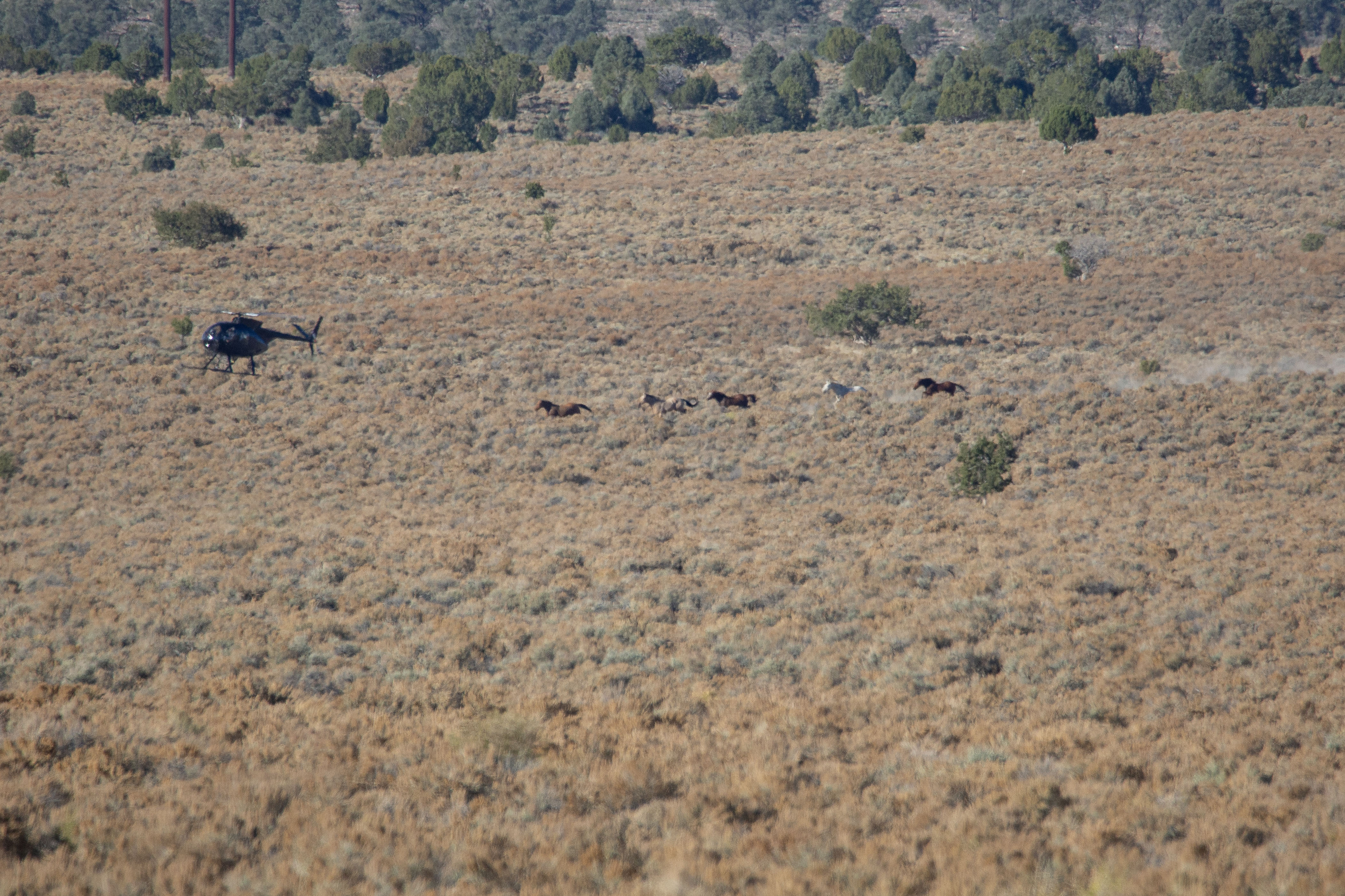
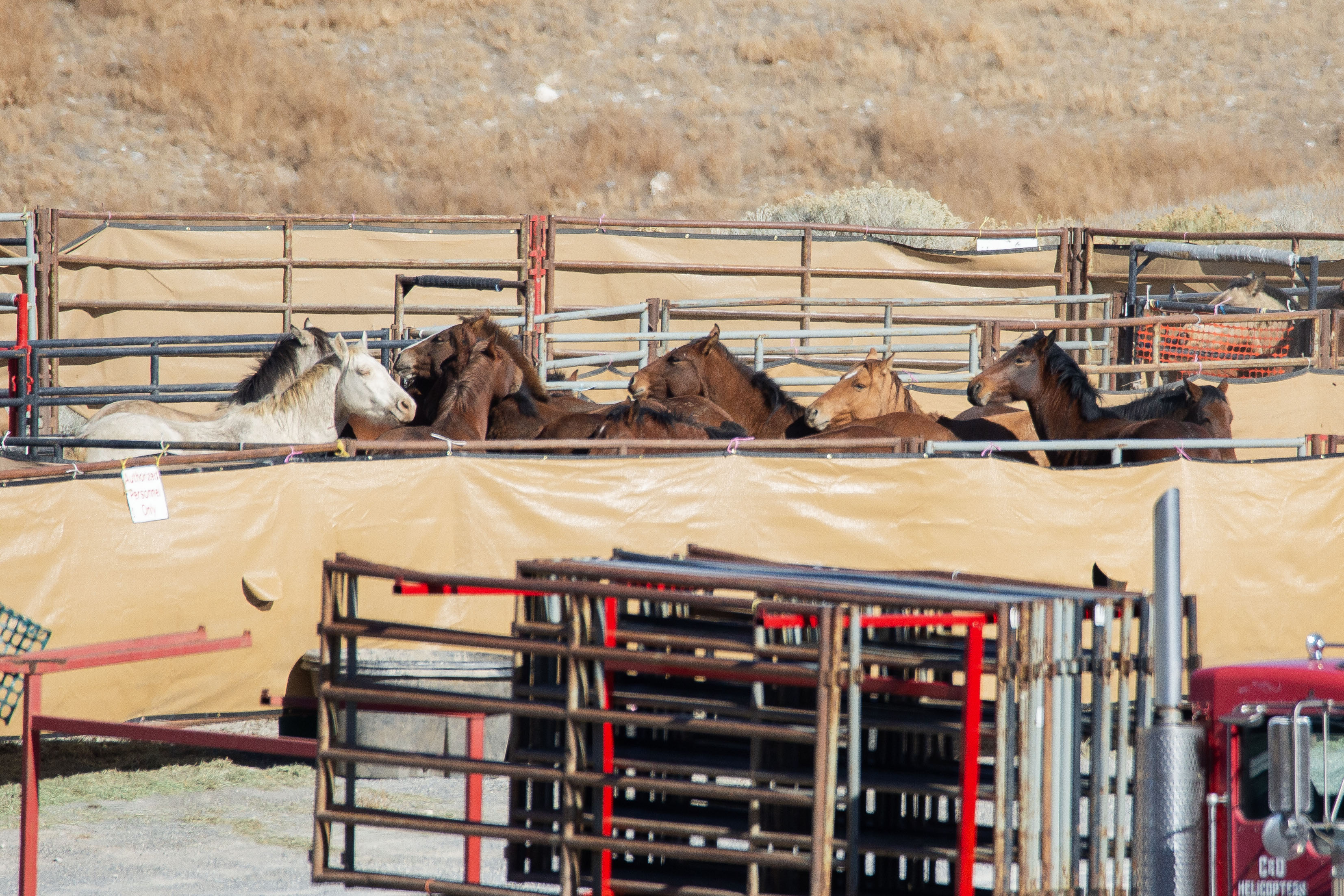
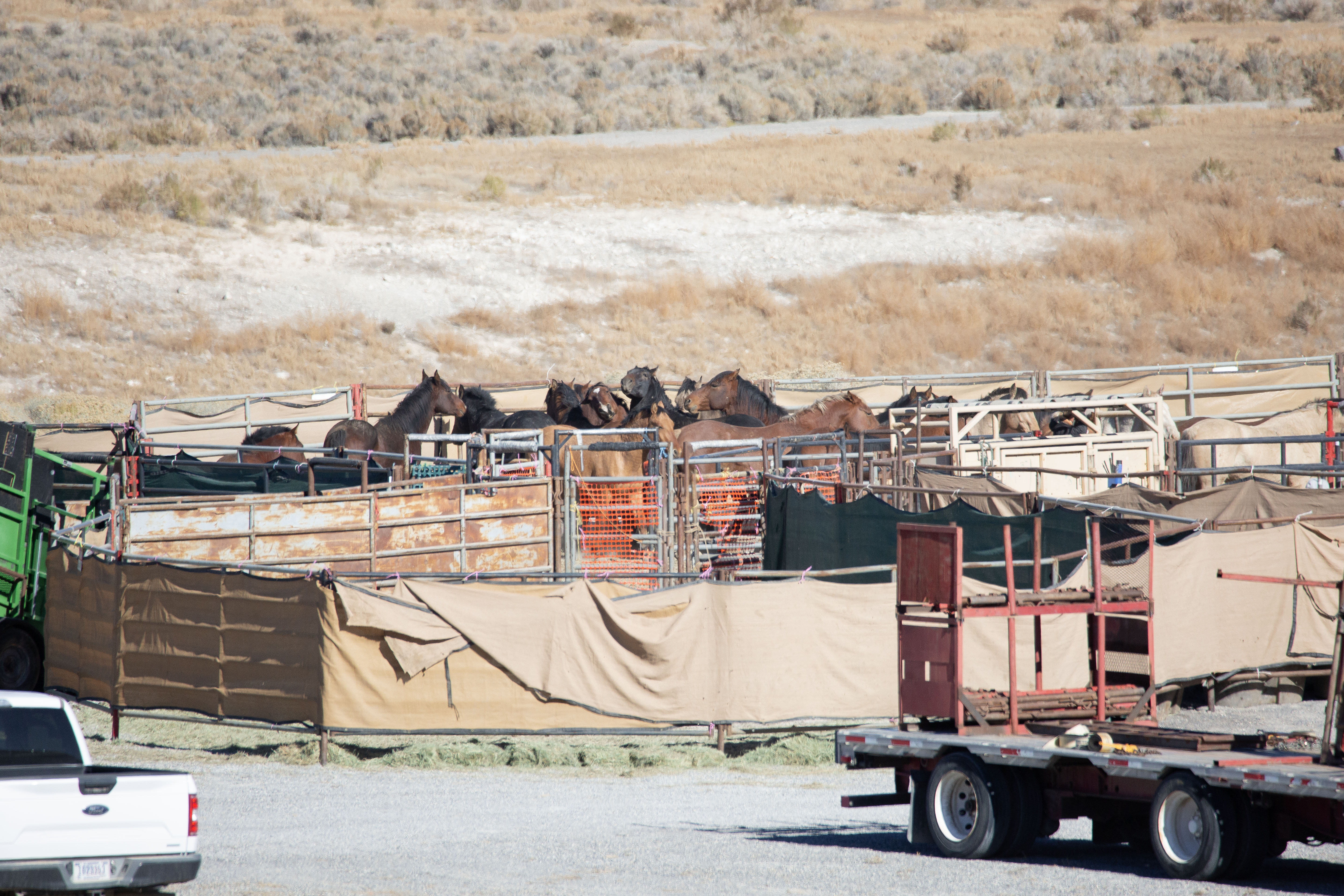
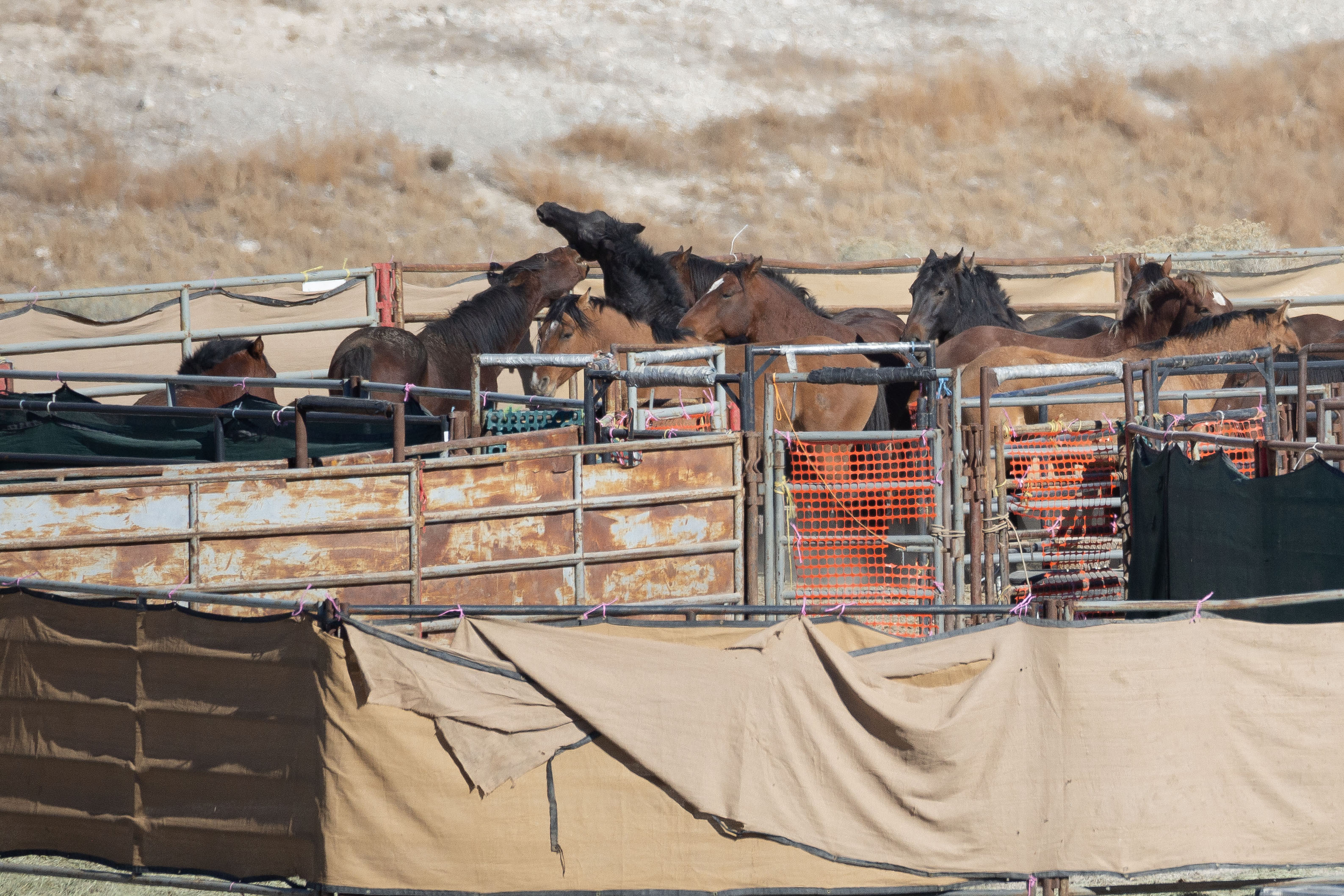
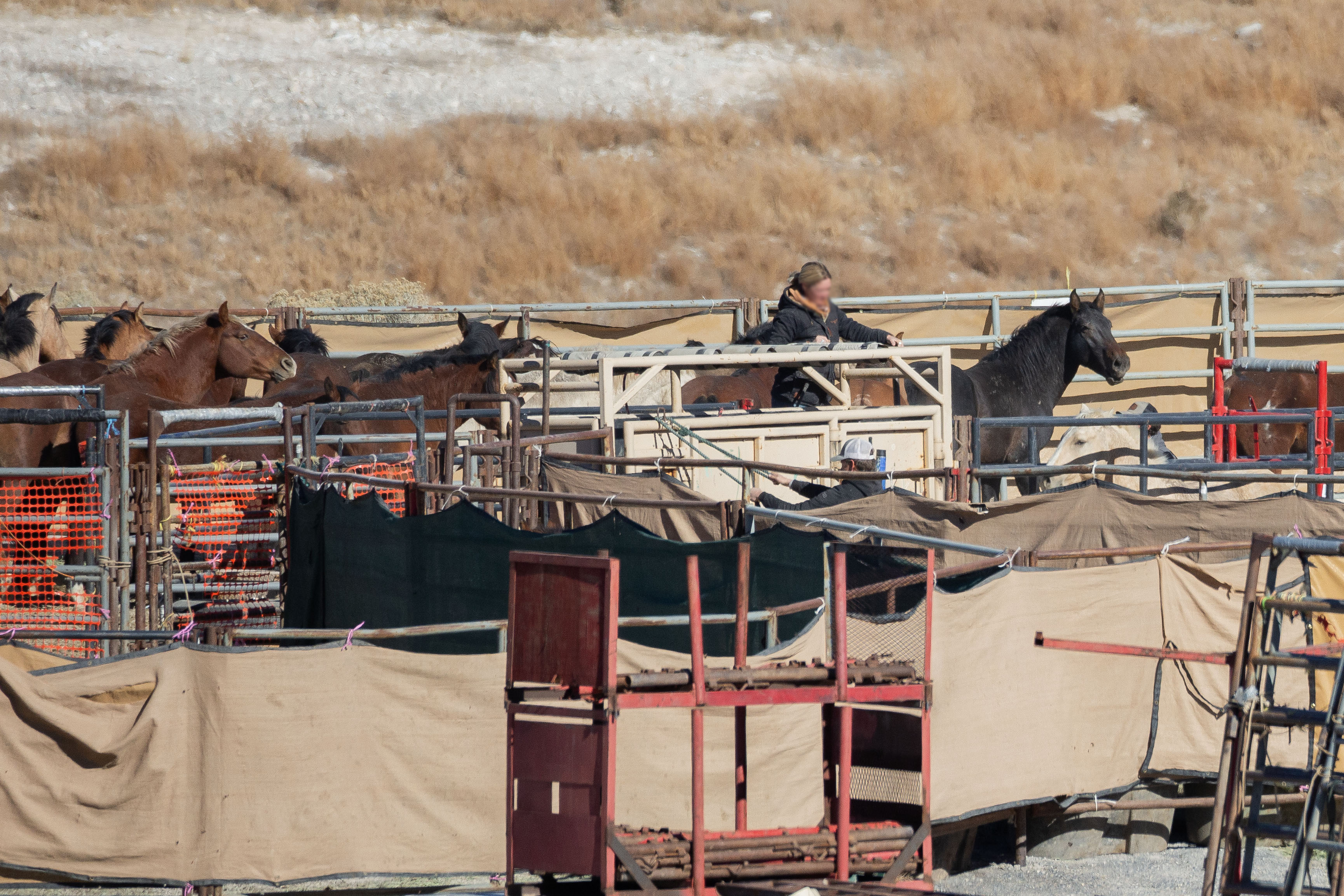
October 26, 2023: 90 wild horses captured
We met at the Eureka Fairgrounds and left to the same trap site (trap 2) at 6 am. The first hour of flying the pilot had made 4 runs. The first one had around 20 horses but as they got closer some of the bands diverted from the larger group and went other directions.
It was a cold morning and the bands were hanging in the valley nearby the trap site so the horses were very fresh again. After getting the bands that diverted from the group I observed the next run, I saw a stallion trying to snake his band while being pushed by the helicopter. By 8:40am the pilot had managed to trap at least 40+ horses.
At around 9 I saw a single bay horse running on the ridge followed by a light buckskin (there was quite the distance between them). The pilot decided to pursue just the single buckskin as the bay disappeared out of sight. Chasing a single adult horse while there are other bands in the area has never made sense to me.
The only thing I can think of is that the horses are right next to a busy highway and outside of the “HMA boundaries” so they are trying to get everything out of this area. The buckskin ended up escaping the wings and booked it right past the trap site. Not much longer I saw two wranglers head out and successfully rope the adult horse.
Shortly after I lost sight of them. Some time has passed and all of a sudden I see the two wranglers bringing the bay horse (roped) into trap (they came from over the hill so I did not see the roping happening).
The last run I observed was at 9:40. It was a group of 9 horses. At 10 AM the first three trailer loads headed out to temporary holding. At 11am I left for personal reasons and was unable to observe the rest of the day and temporary holding.
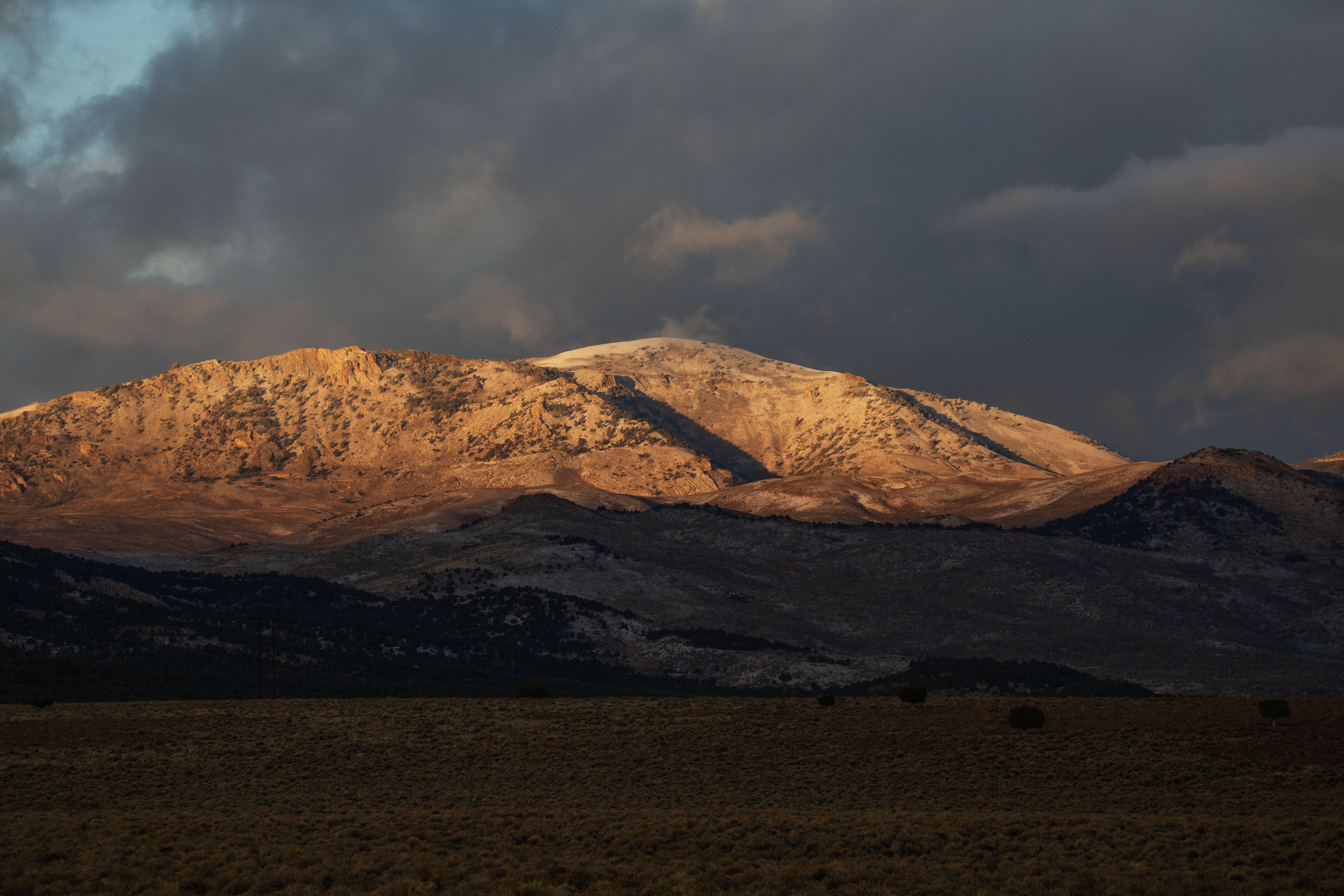
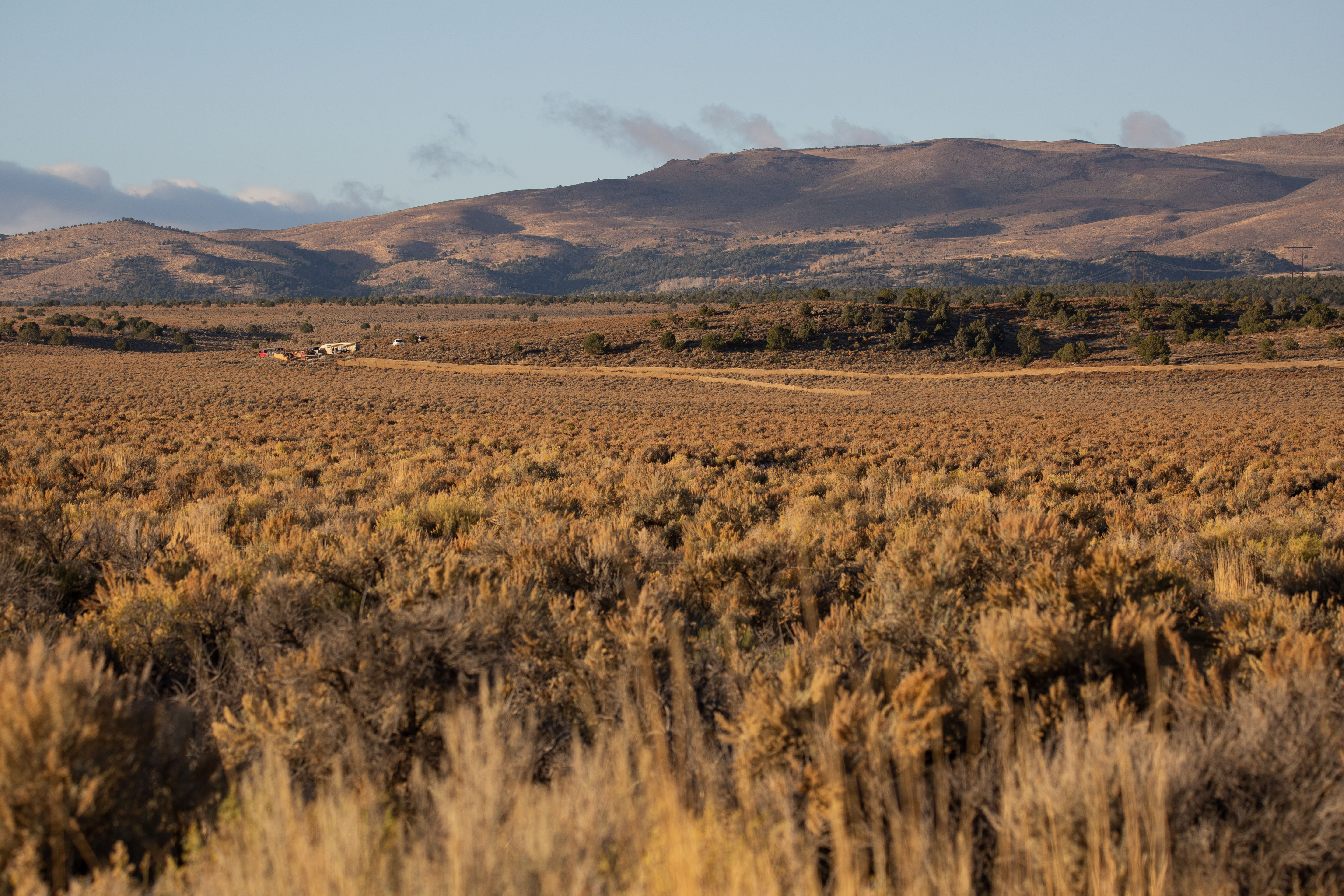
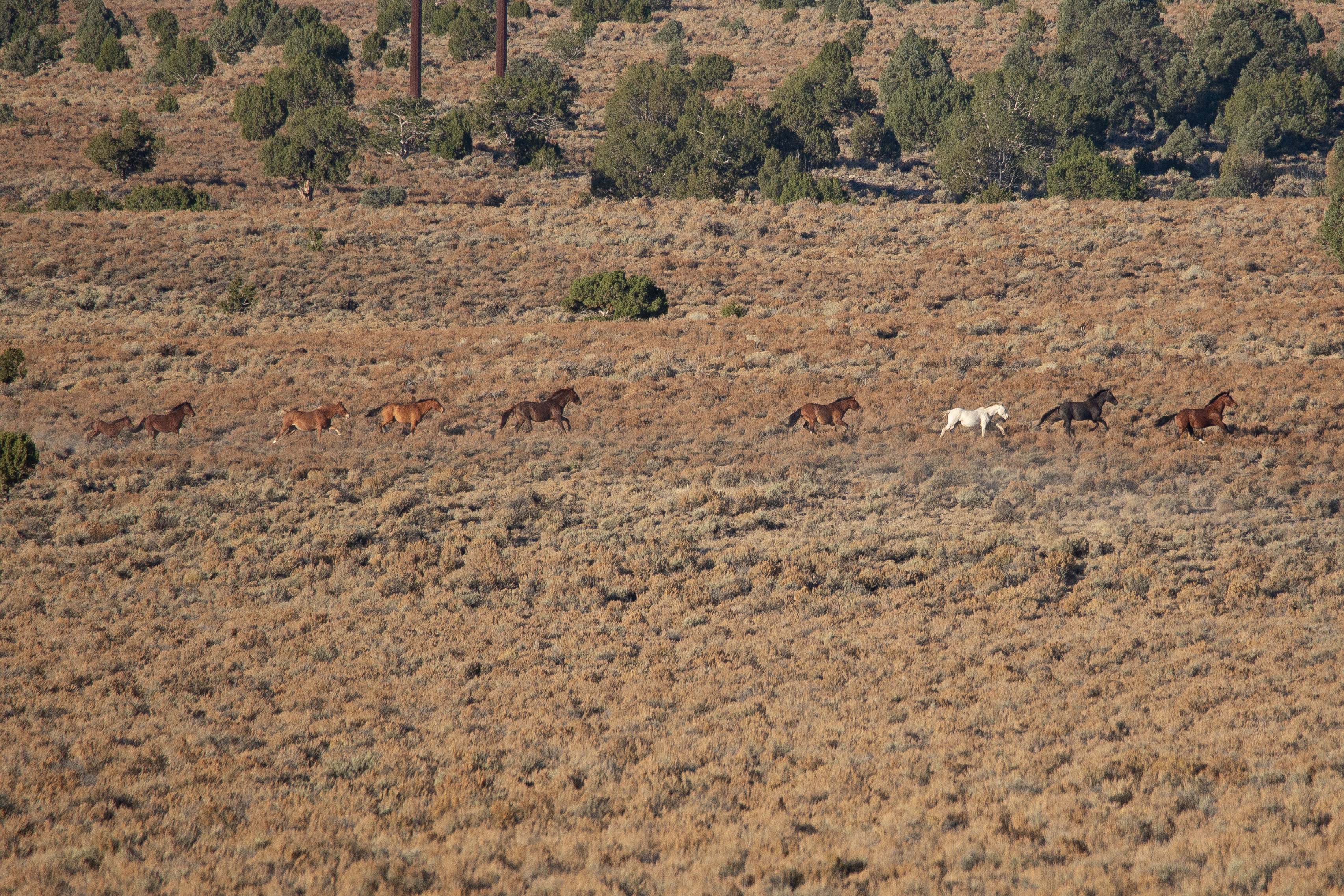
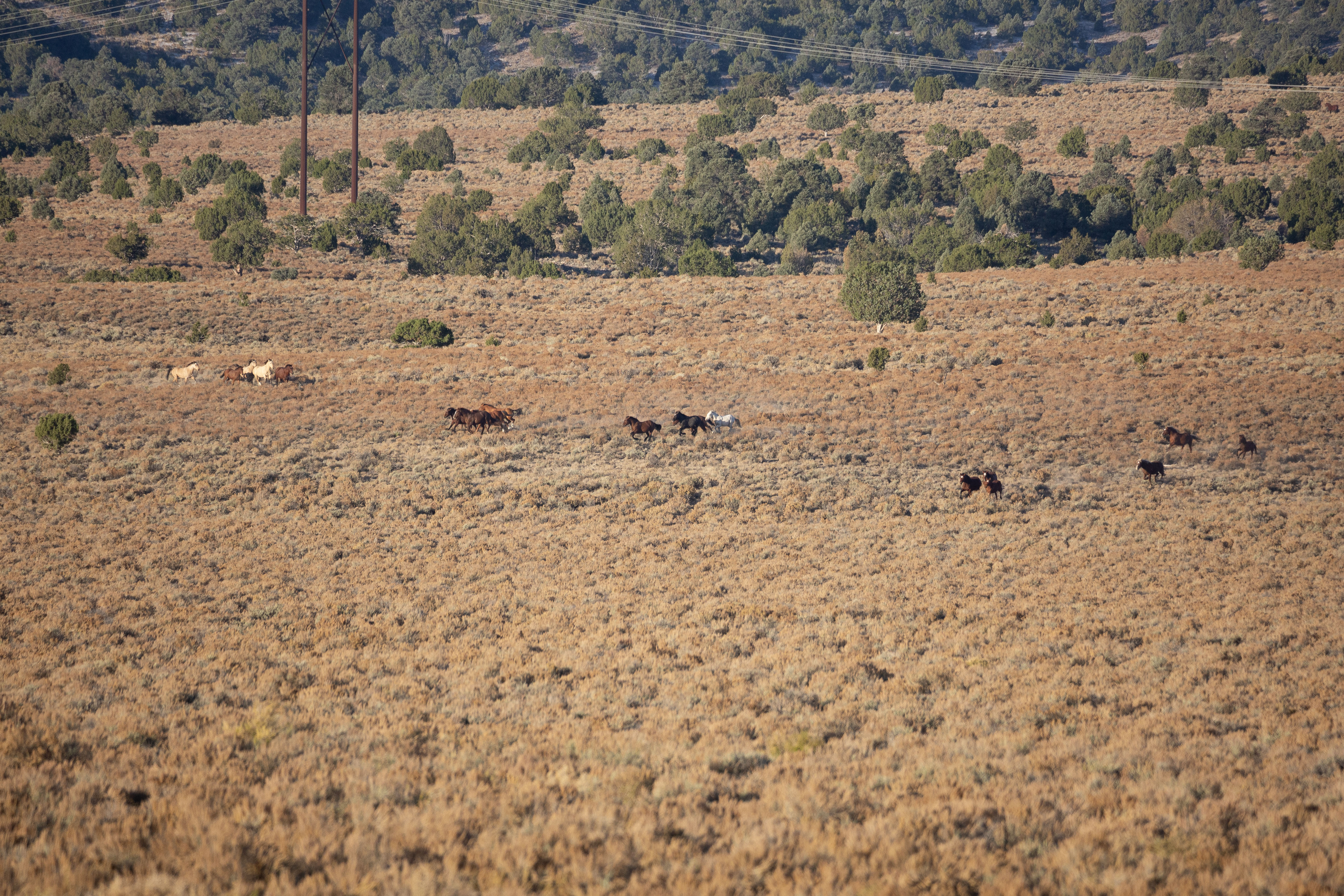
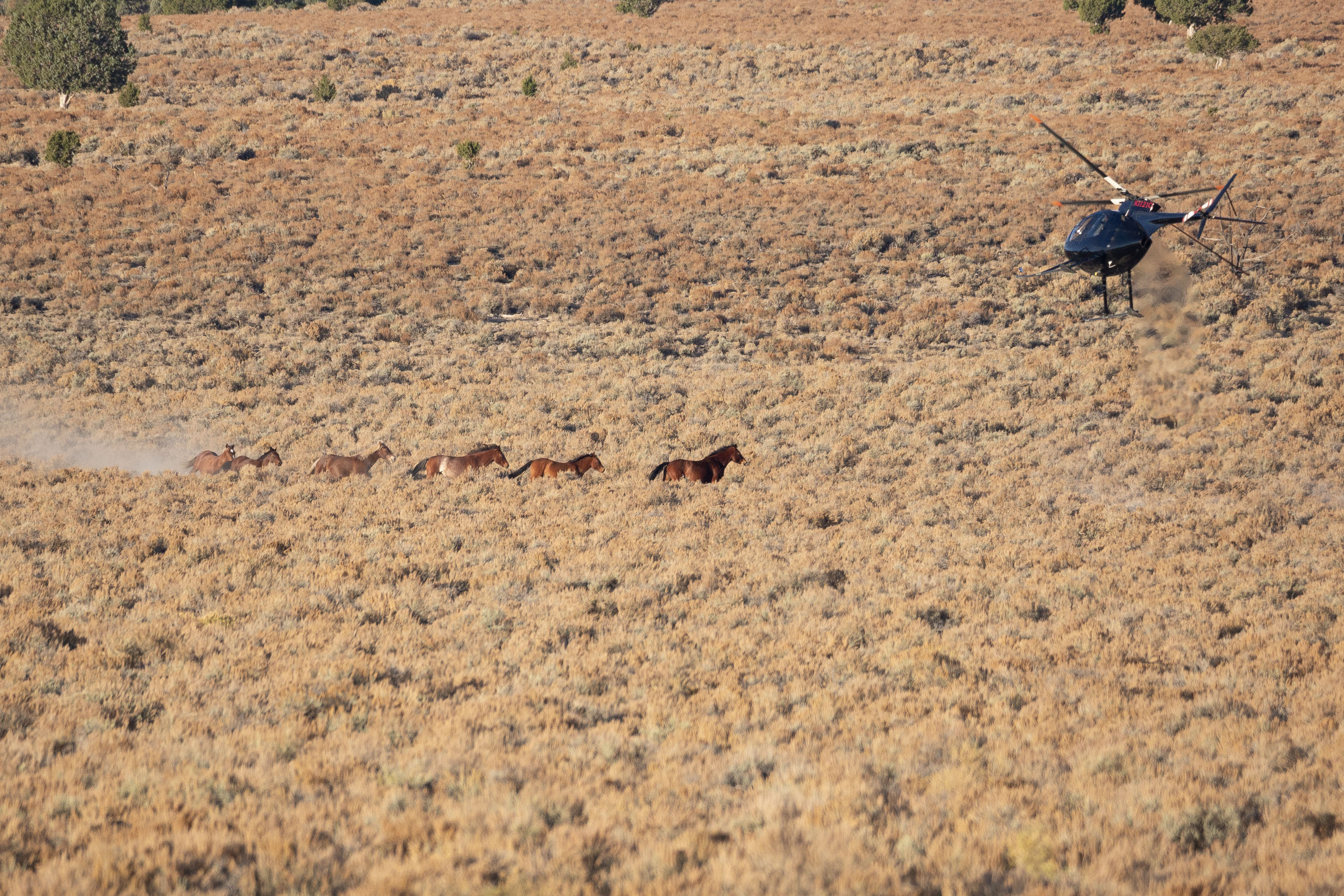
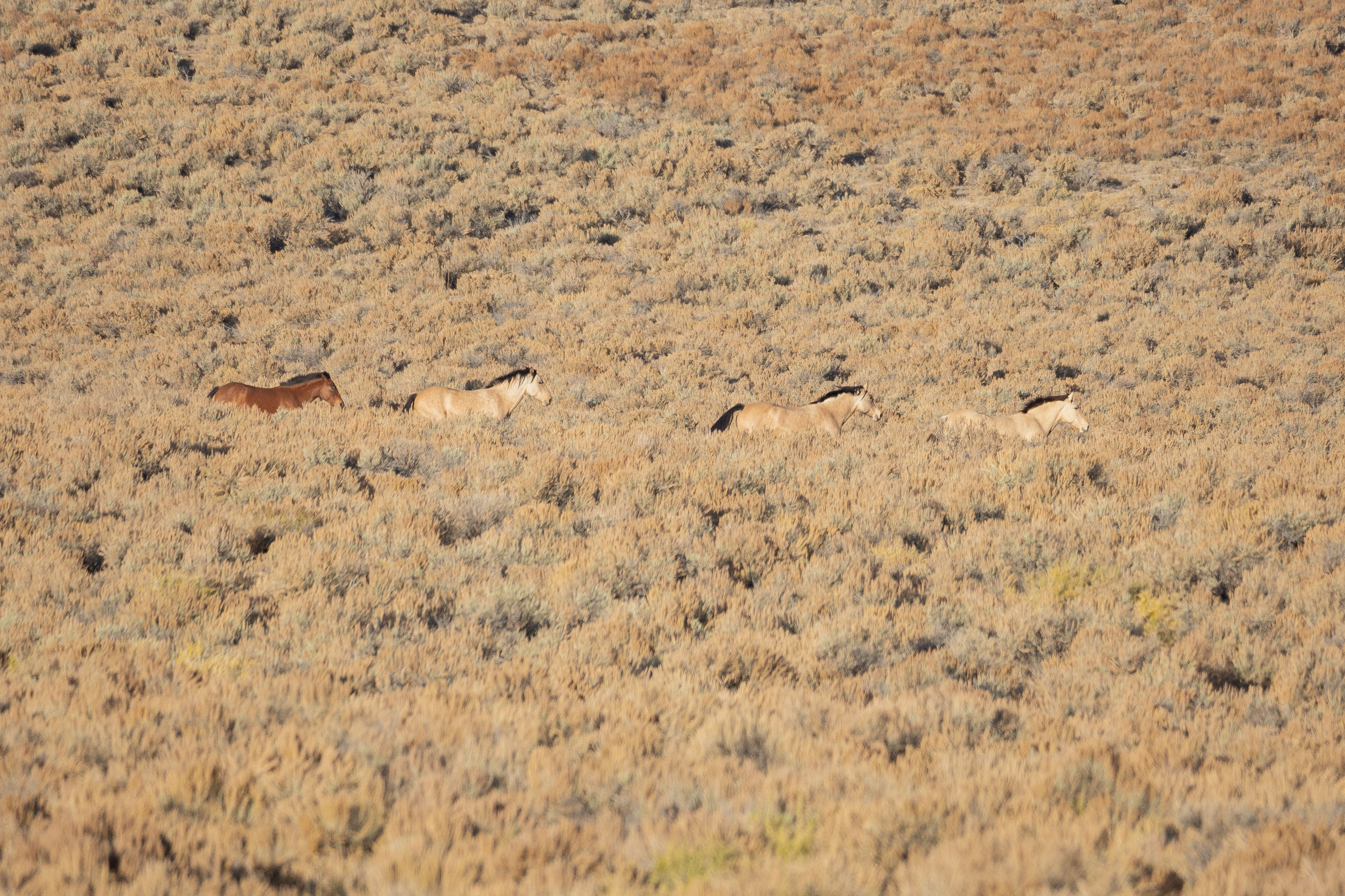
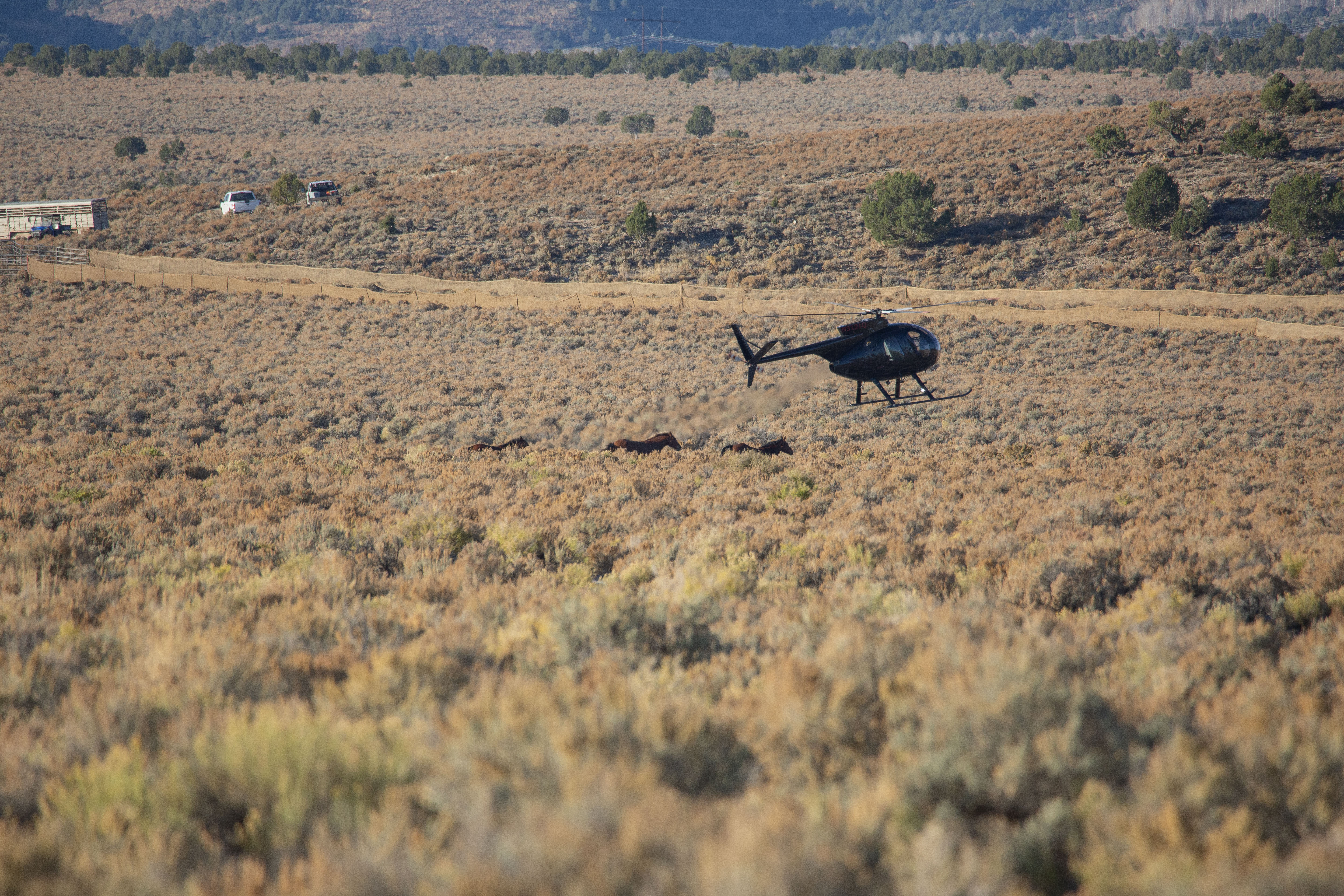
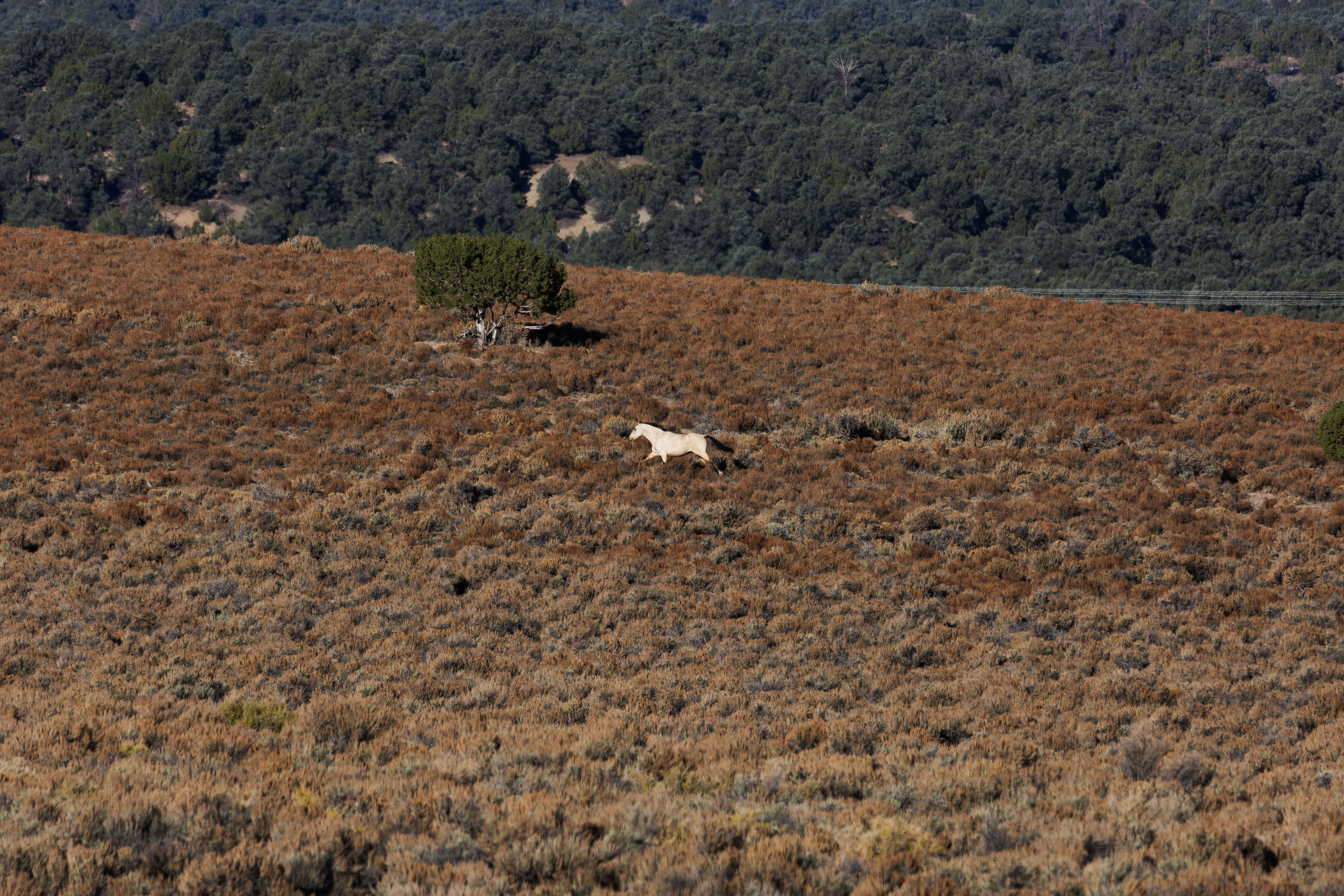
October 25, 2023: 39 wild horses were captured.
We left the Eureka Fairgrounds at 6 a.m. to the new trap site (trap 2). This time we were 10 miles south of the previous trap. The new trap allowed much better viewing, we could see the entire wing setup and trap site + trailering.
Within the first 40 minutes of flying the pilot managed to do three runs. The horses were cantering fast as they were not coming from very far. There appeared to be a lot of horses in this area. Luckily all the runs went smoothly and the Judas horse helped slow down the horses as they came into the trap.
There were no horses frantically running around in the catch pen, they all just came to a standstill.
I was observing one of the runs when all of a sudden I heard hoofbeats on the ground very close to us. I quickly shifted my camera and saw a band of 4 horses canter right in front of us. I don’t think they had been part of any of the runs but were just traveling through the area.
They continued traveling and came to a stop once in a while eventually disappearing behind a hill. We saw them again a little later but they never got captured. Around 11 am we were notified they were done flying for the day. I estimate the number around 45 horses with the largest run consisting of around 20. A total of three trailer loads headed out to temporary holding.
There were still horses in the trap waiting to be trailered. After waiting for 2 hours one of the trailers had returned to pick up the rest of the horses. We headed to a temporary holding shortly after. Temporary holding: I was allowed to climb up the hill again so I could observe the last trailer load come in + sort.
I noticed the stallion pen was very crowded so I assume they hadn’t shipped any of them yet this morning. Overall the horses were quietly standing in a group together. The stallions were moving around more but there was rarely any commotion between them.
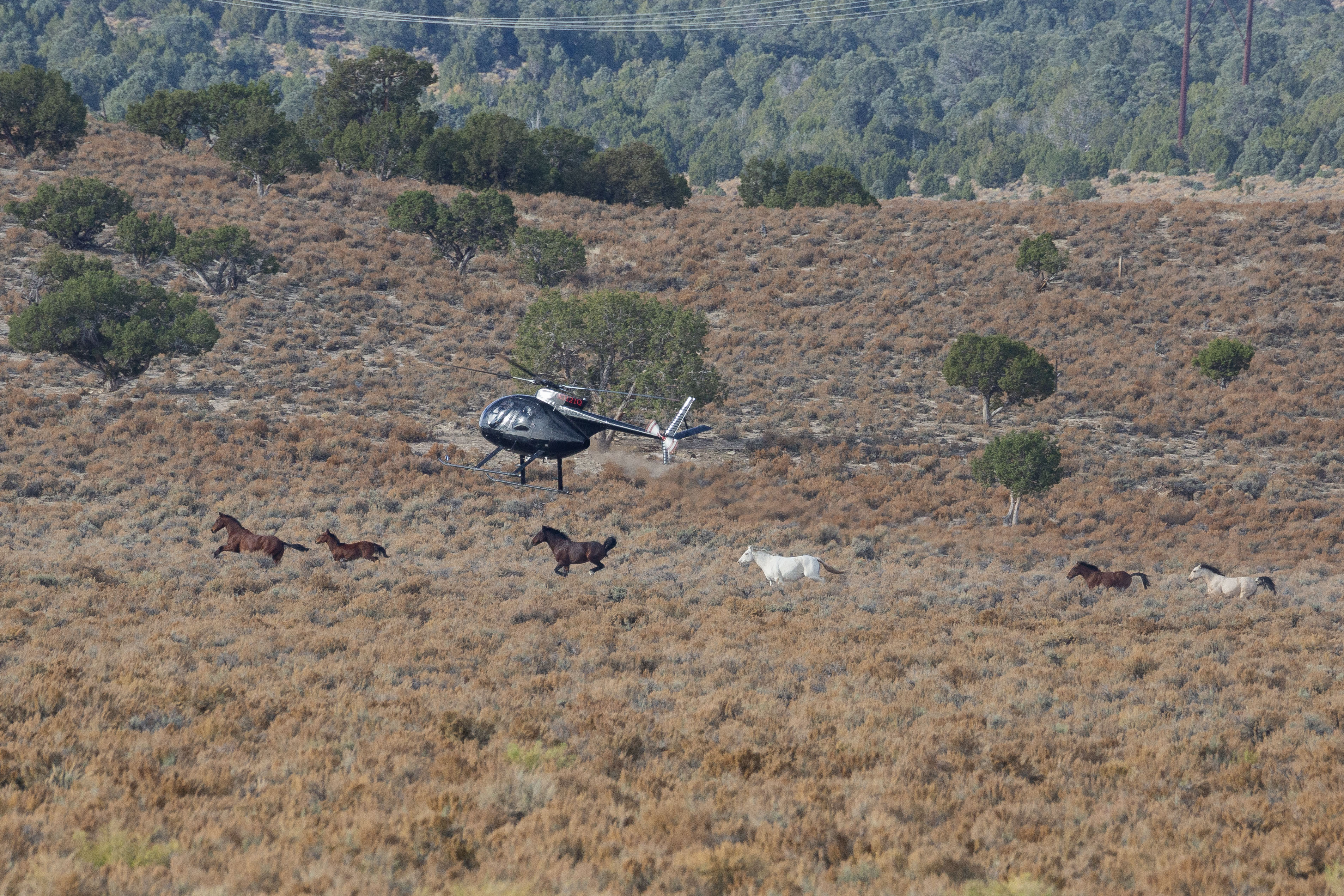
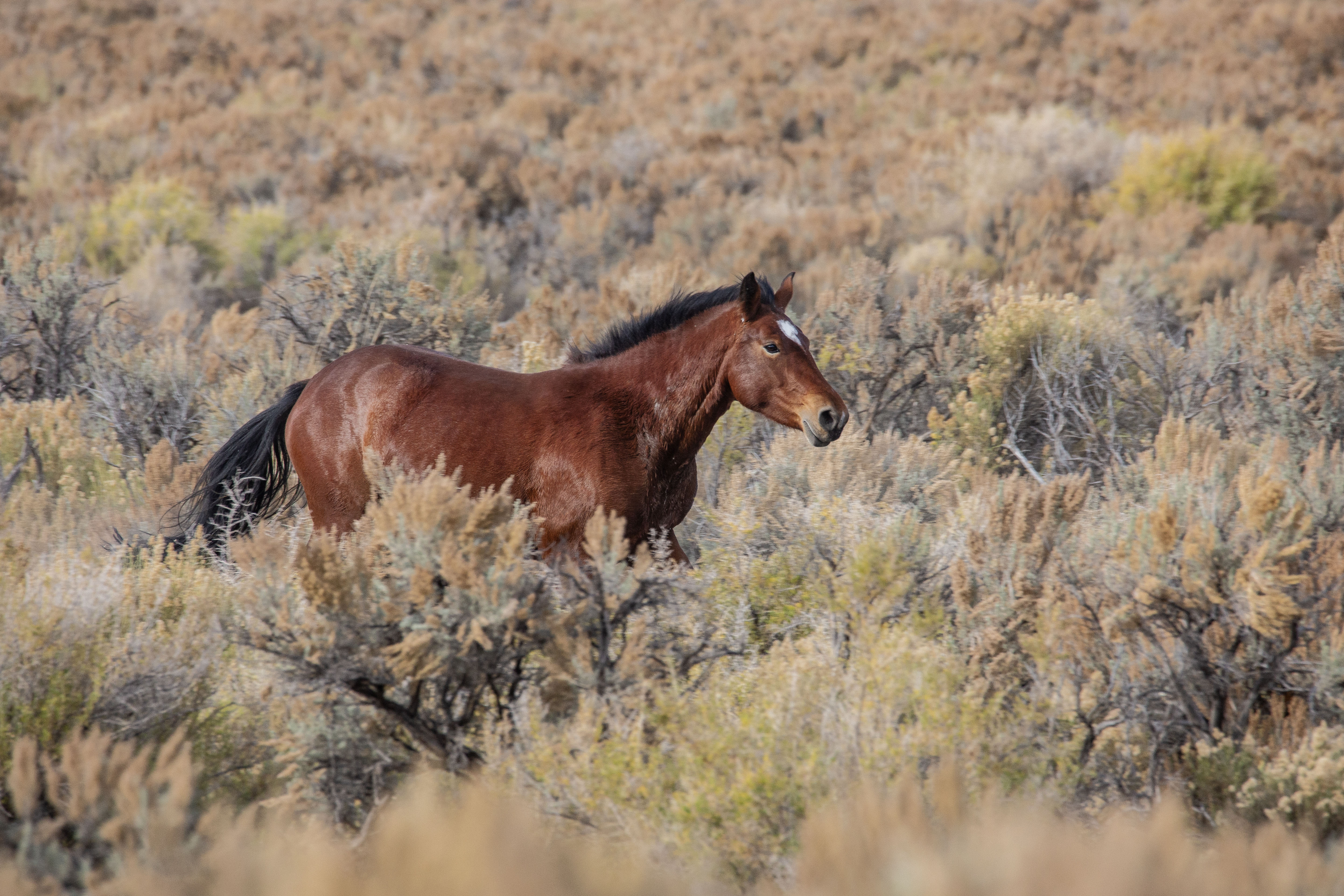
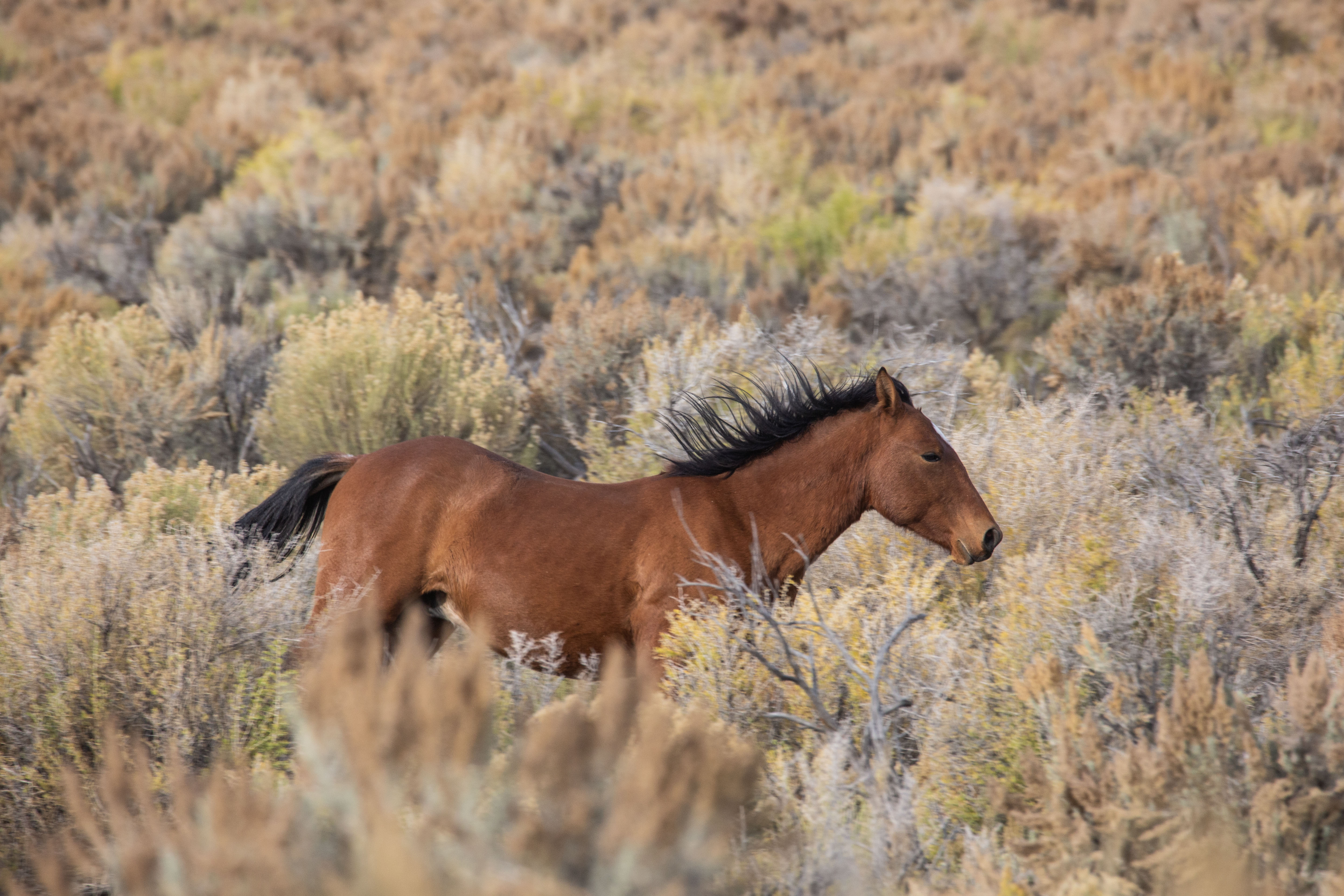
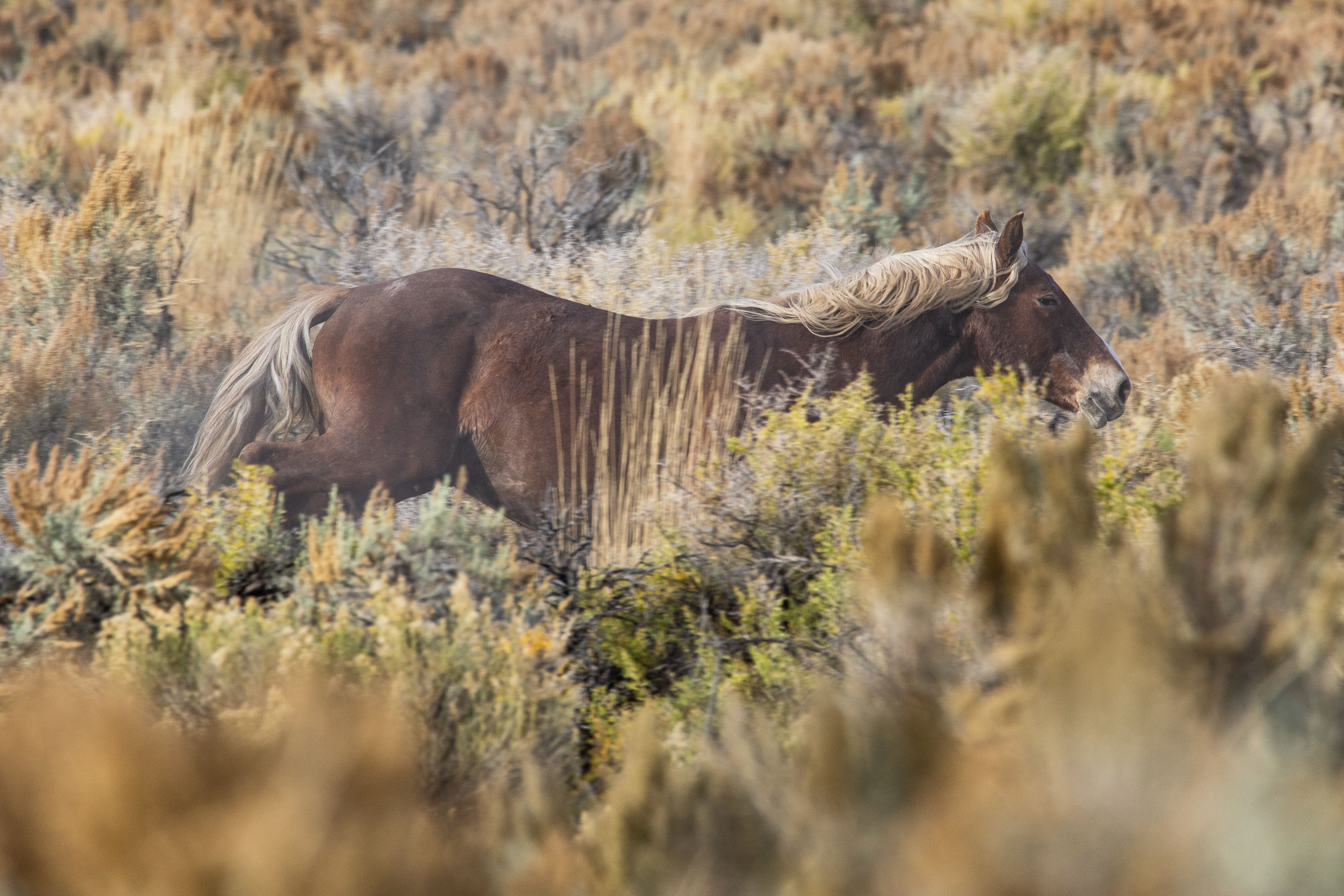
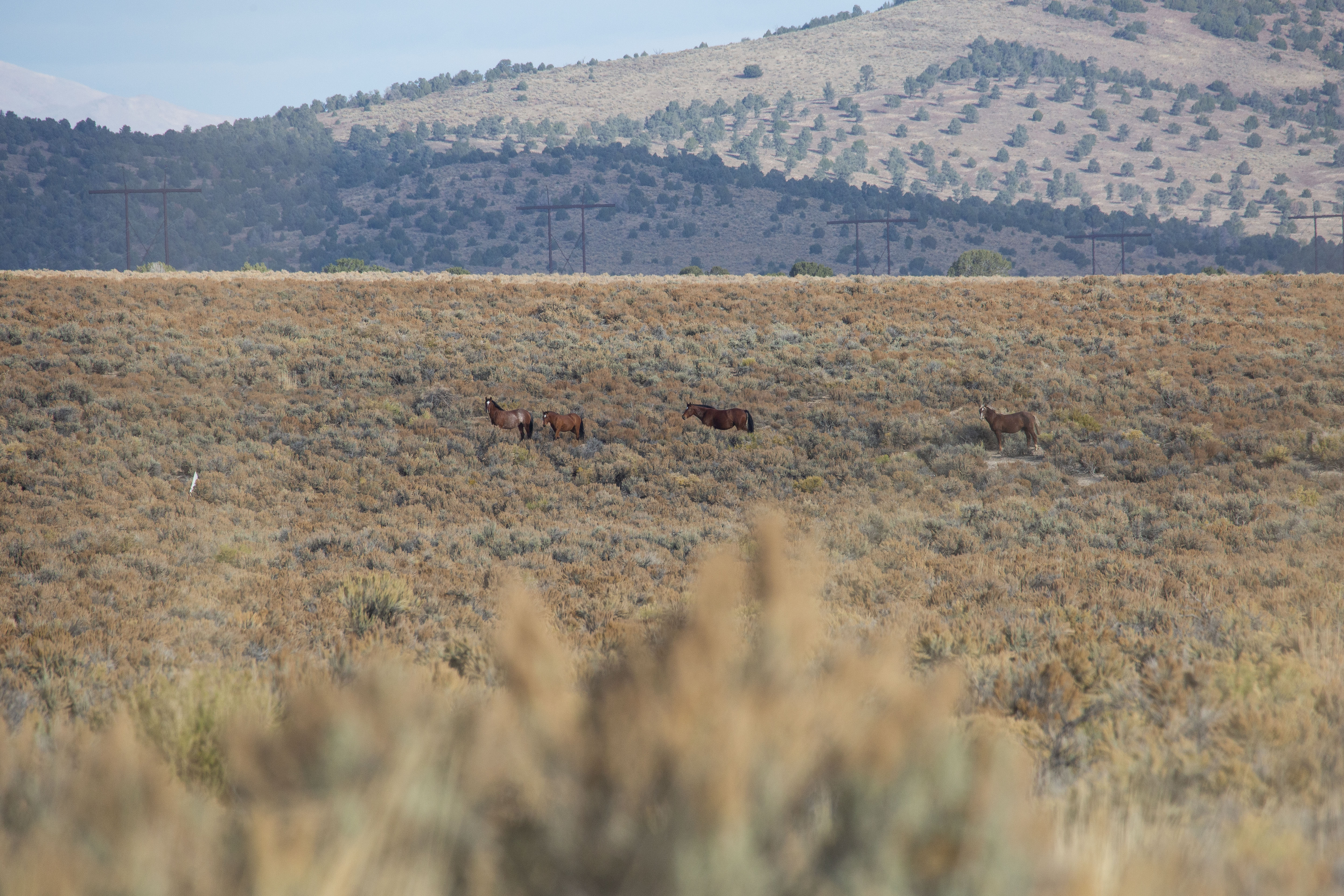
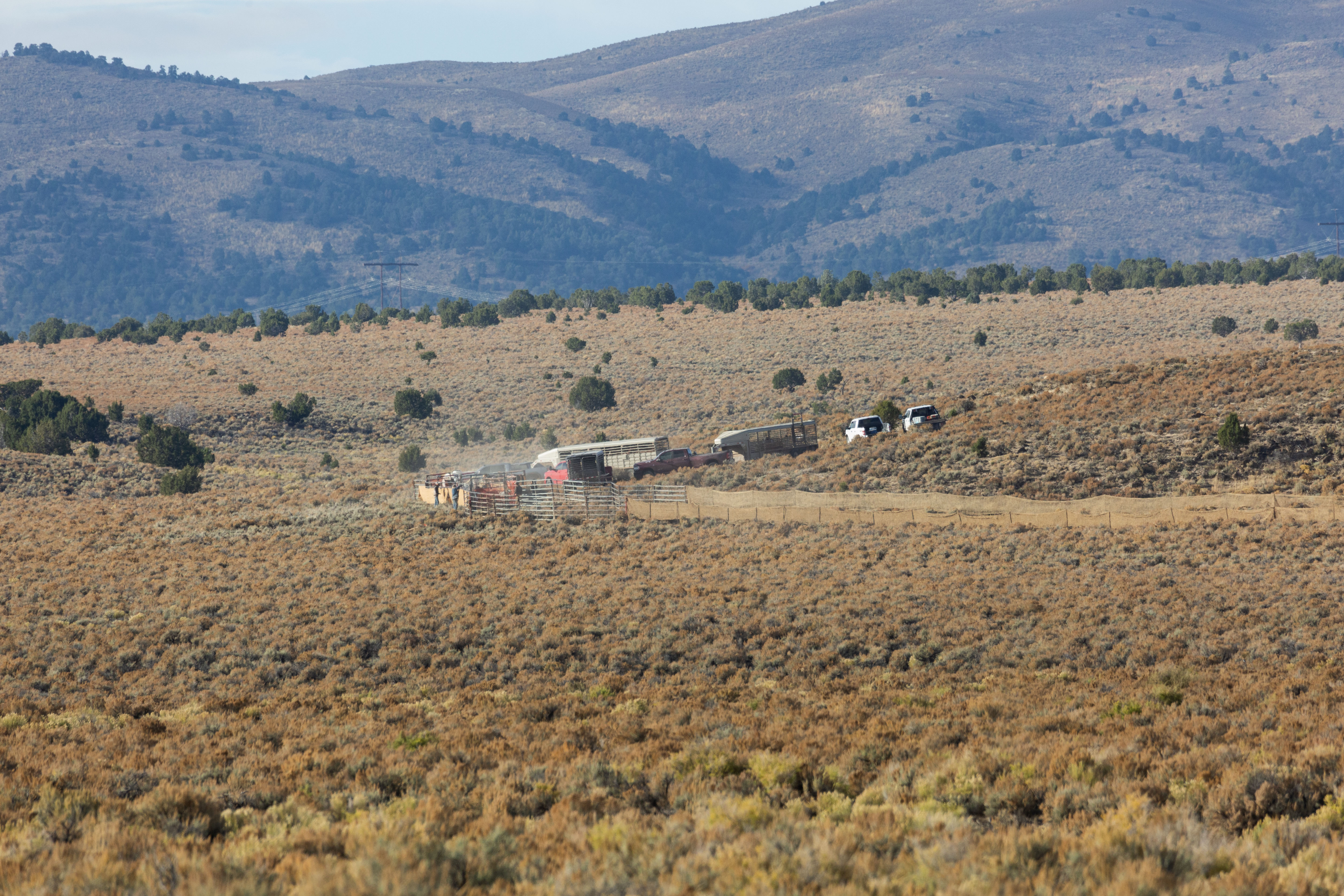
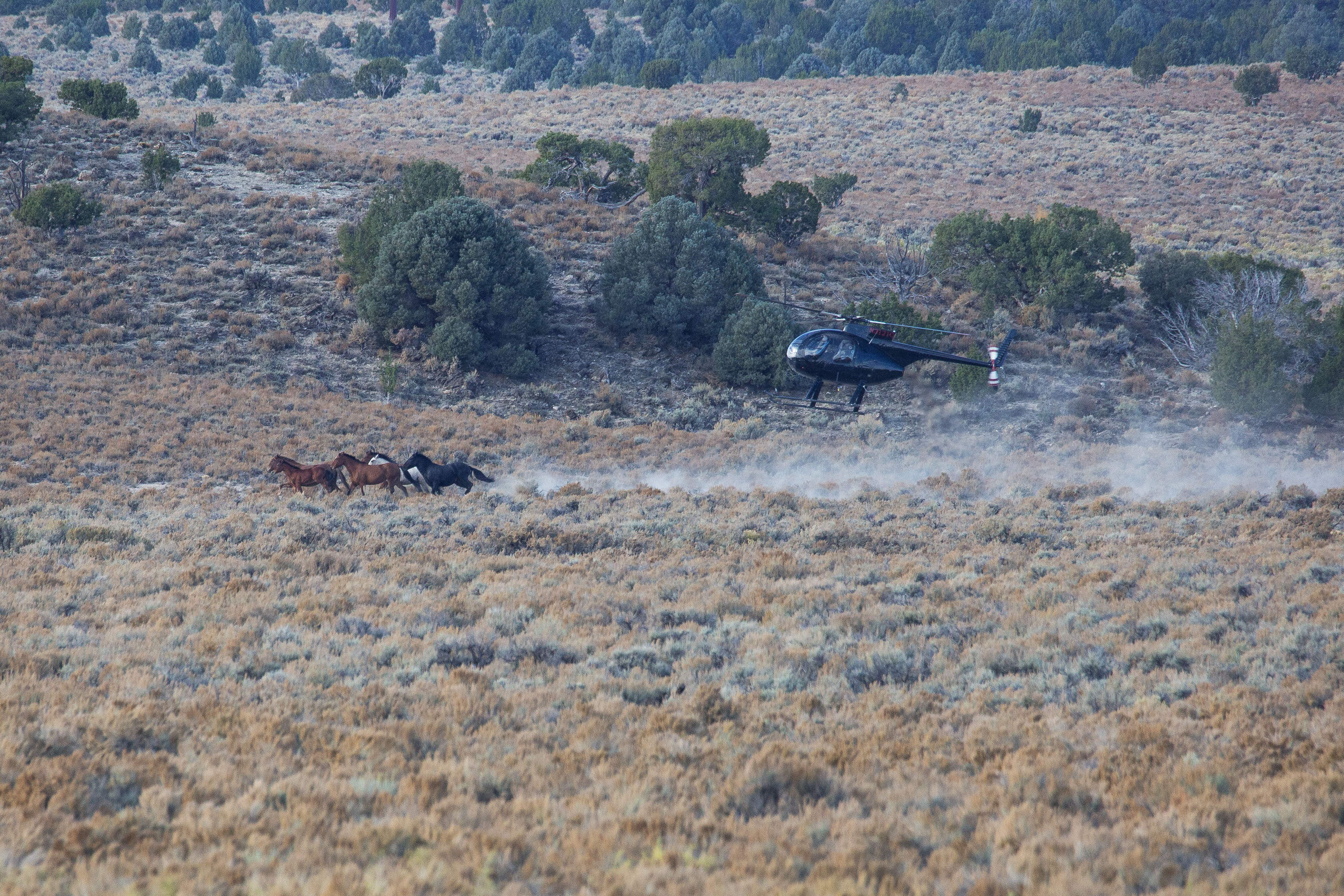
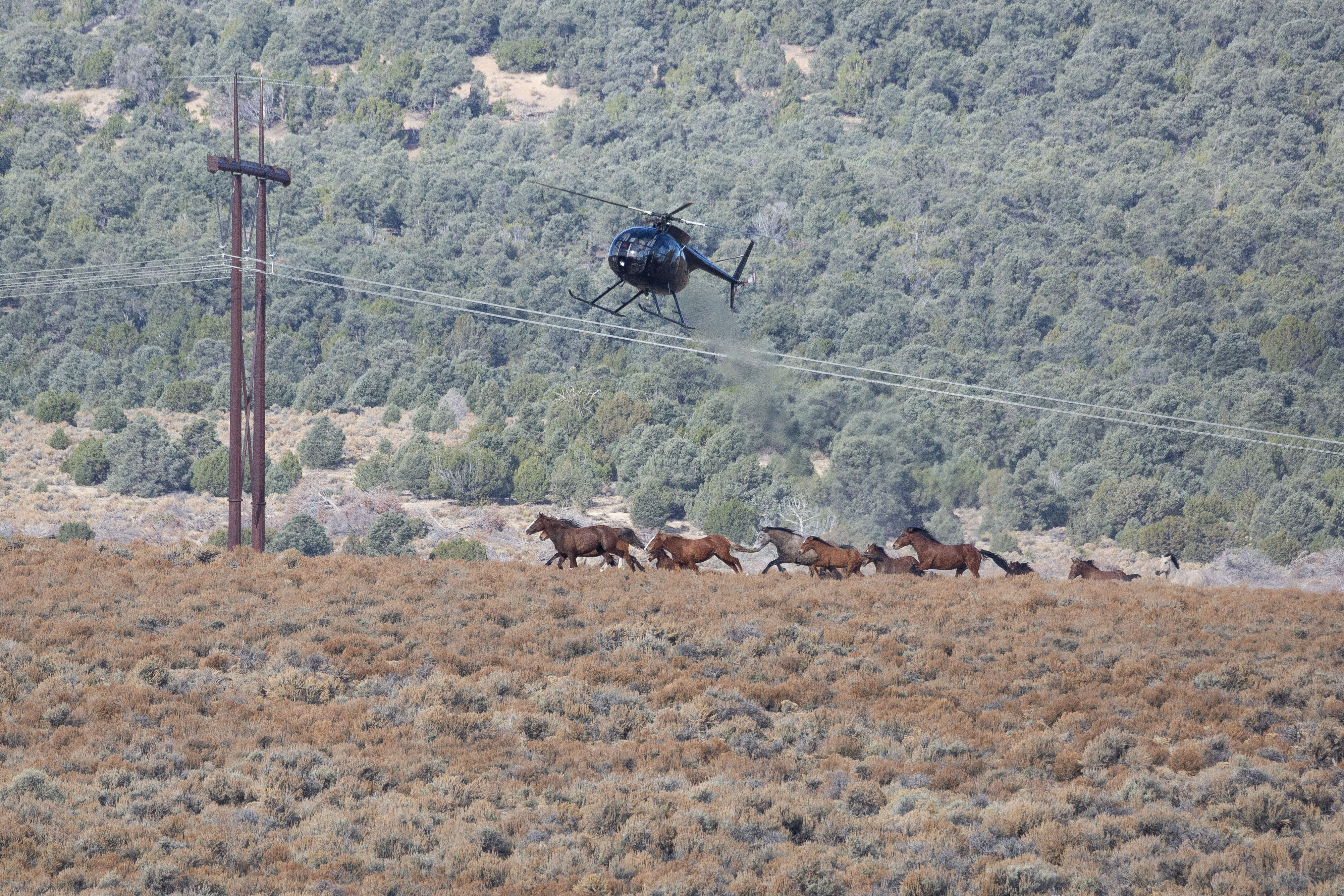
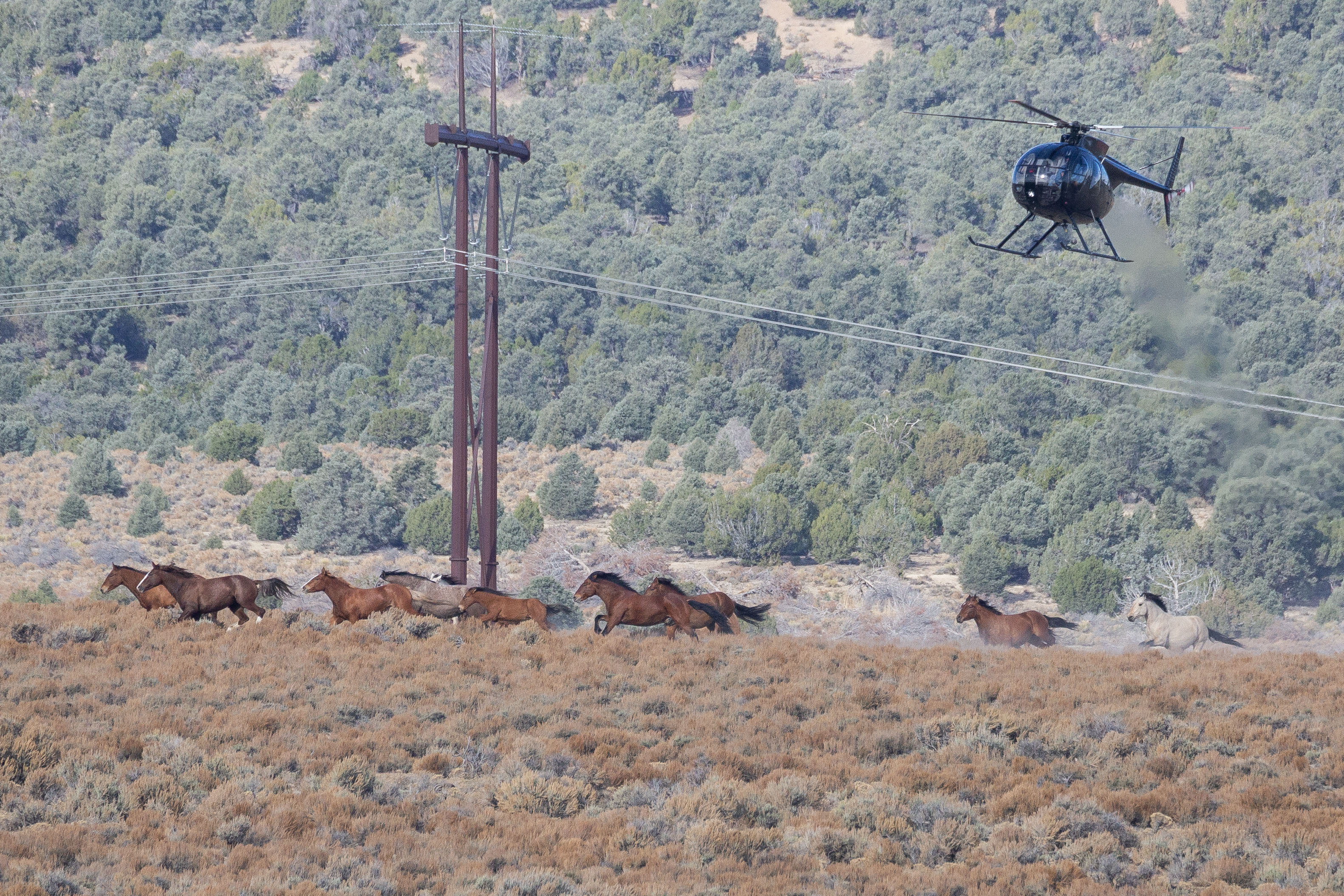
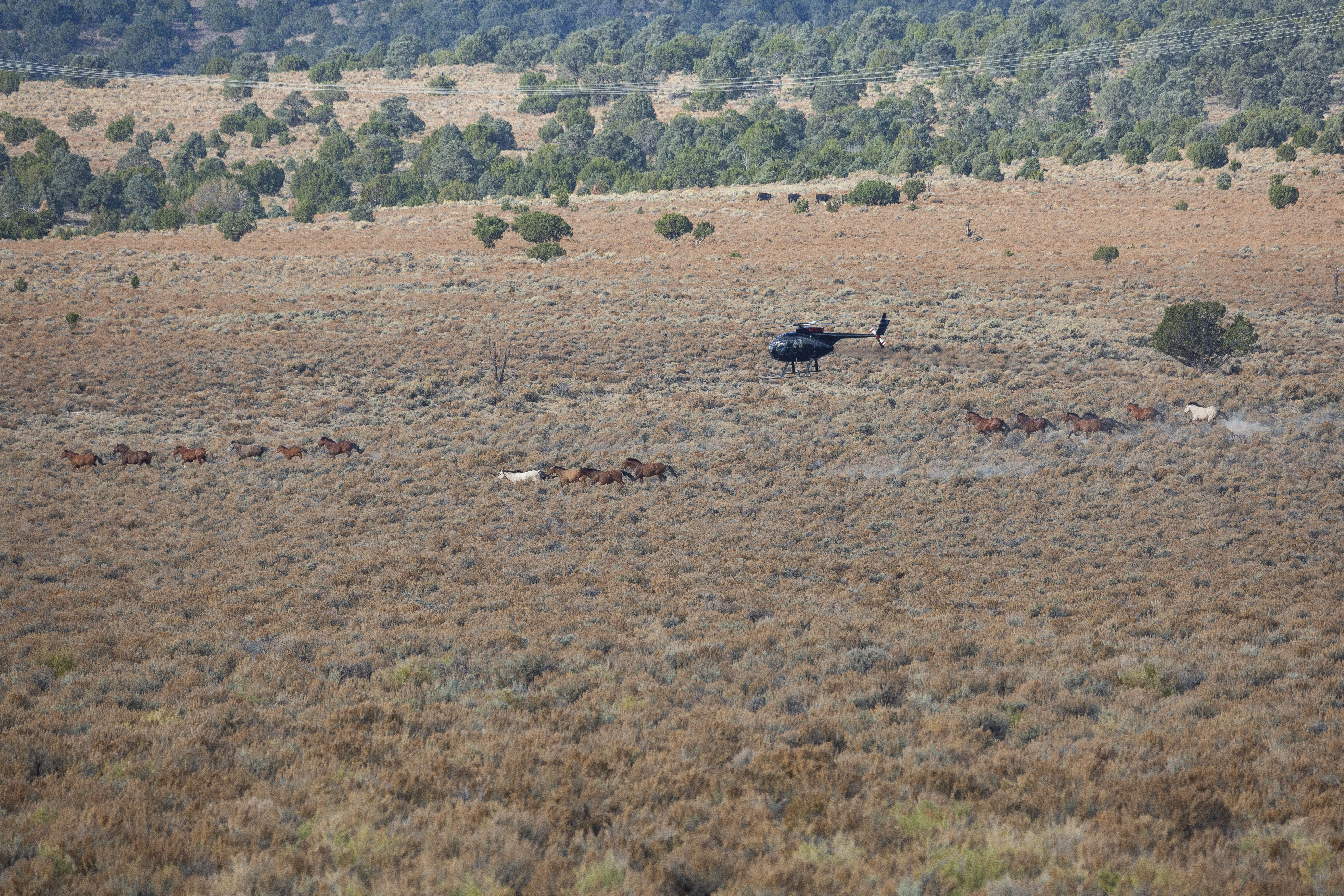
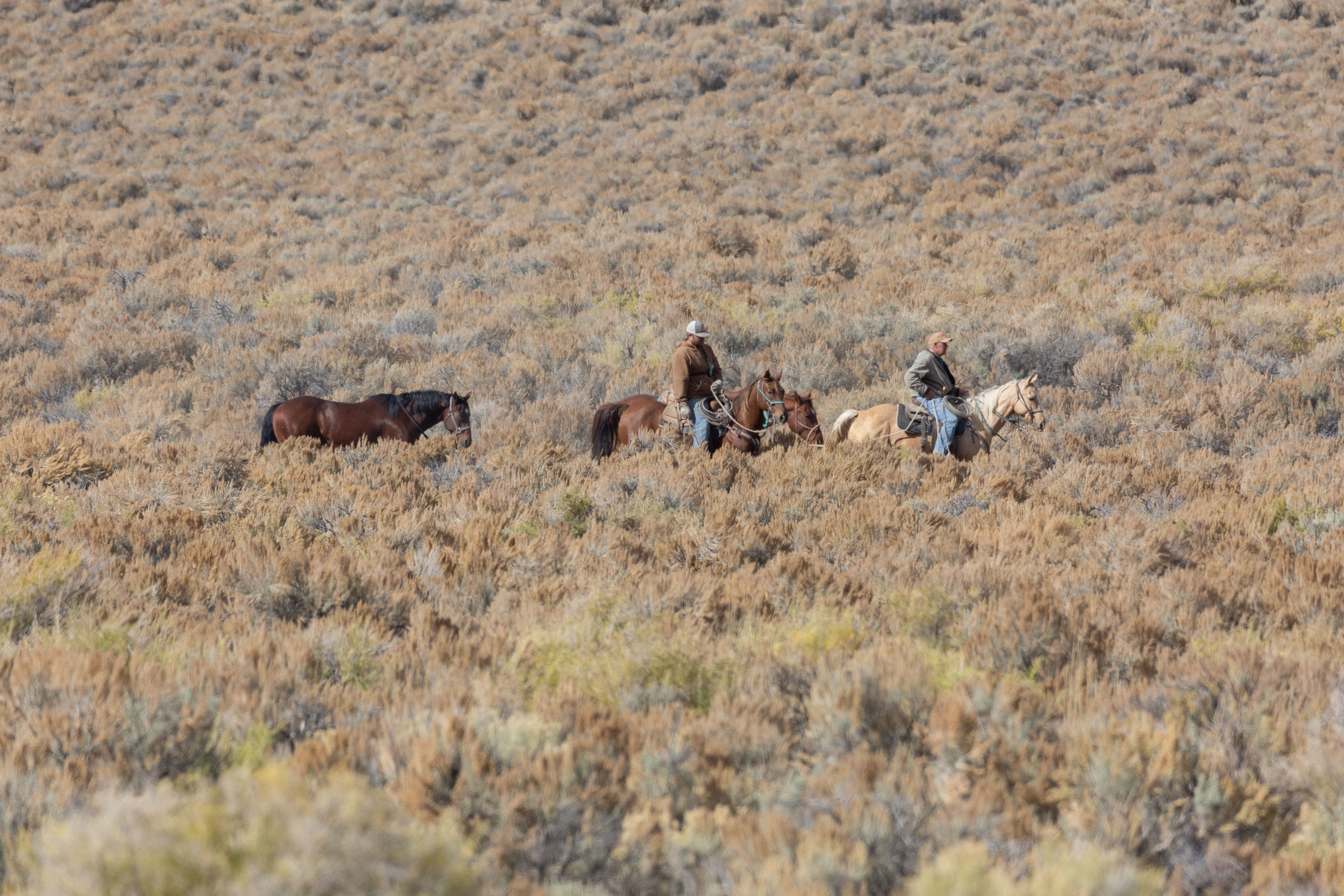
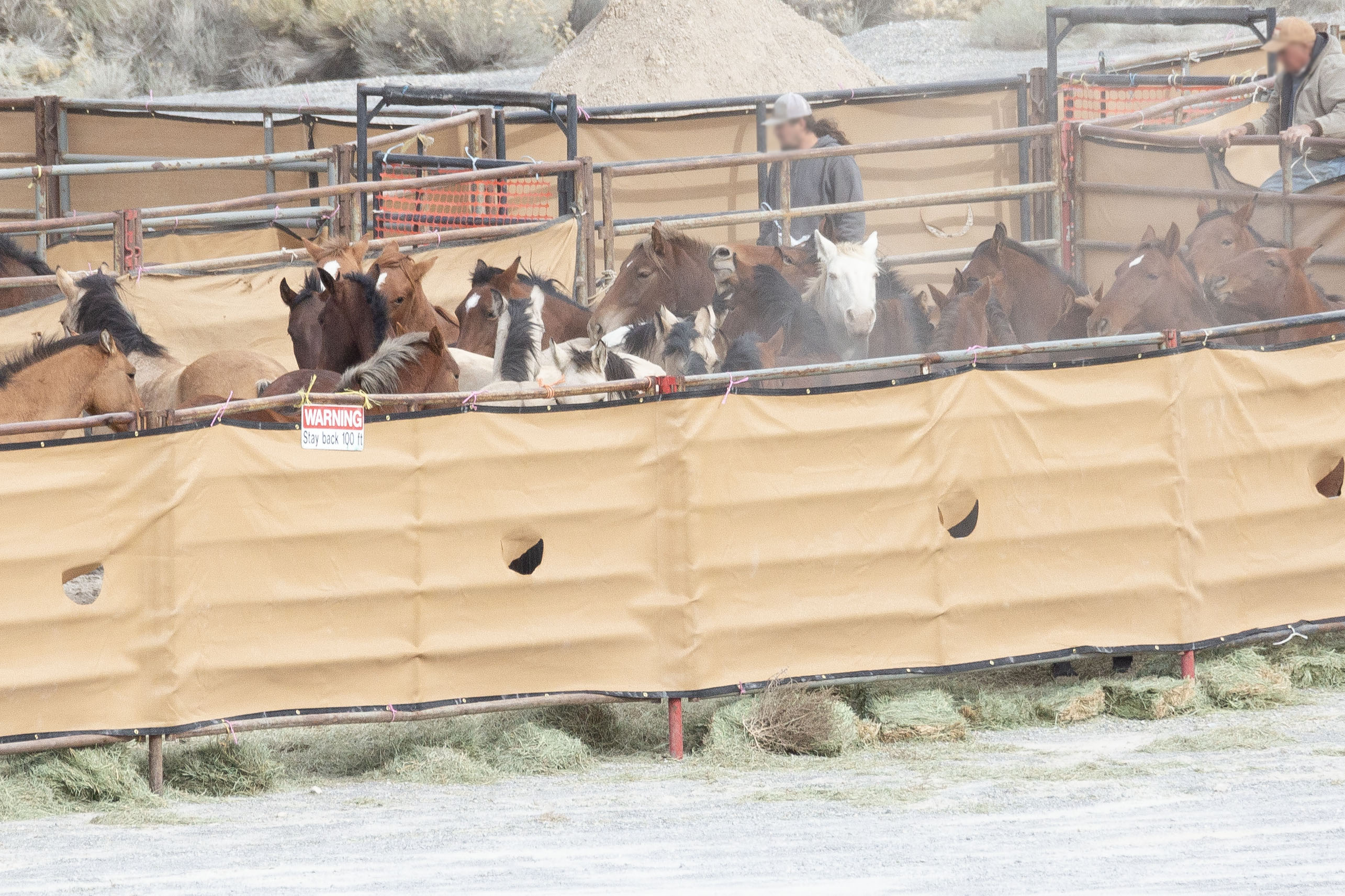
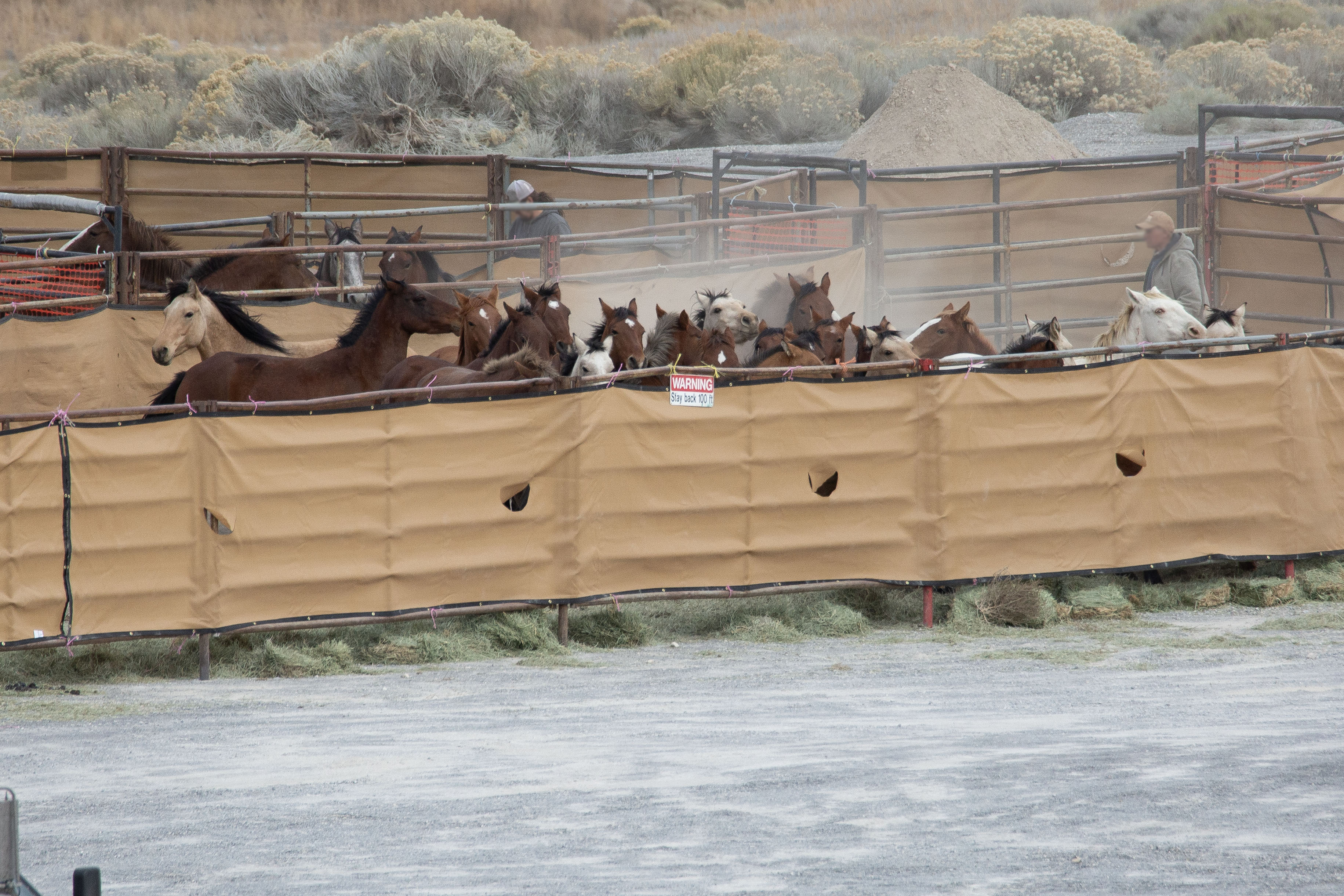
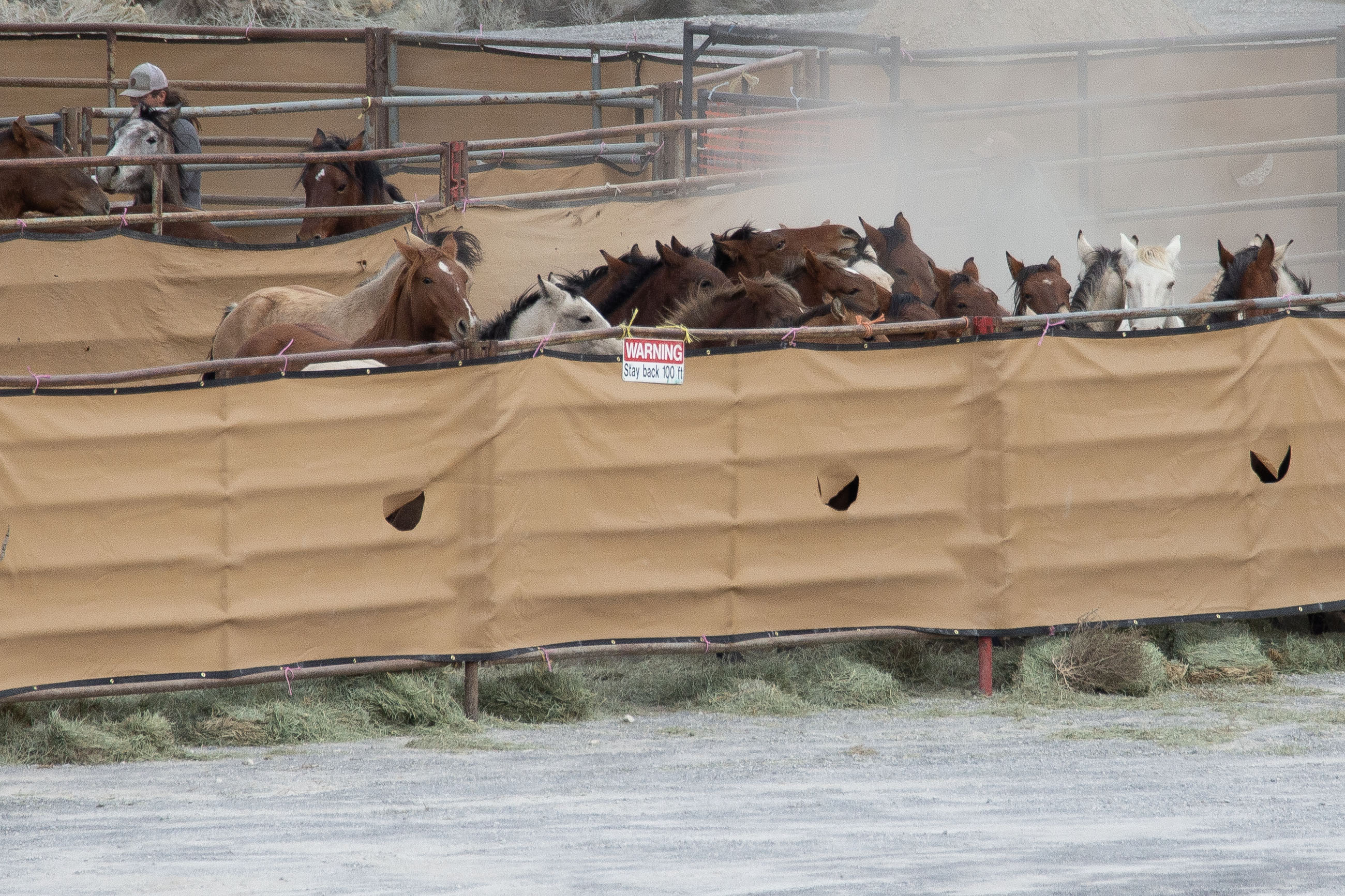
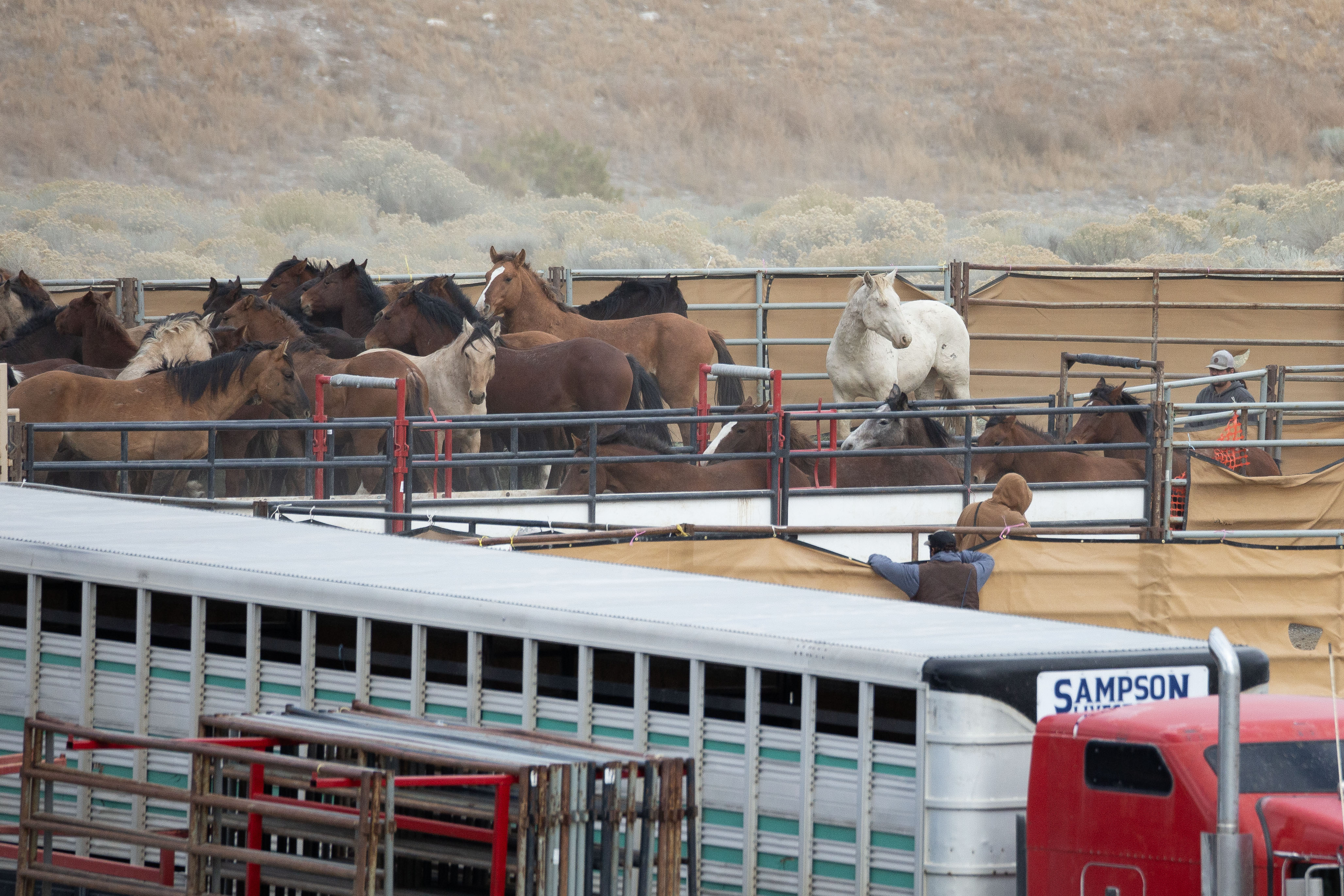
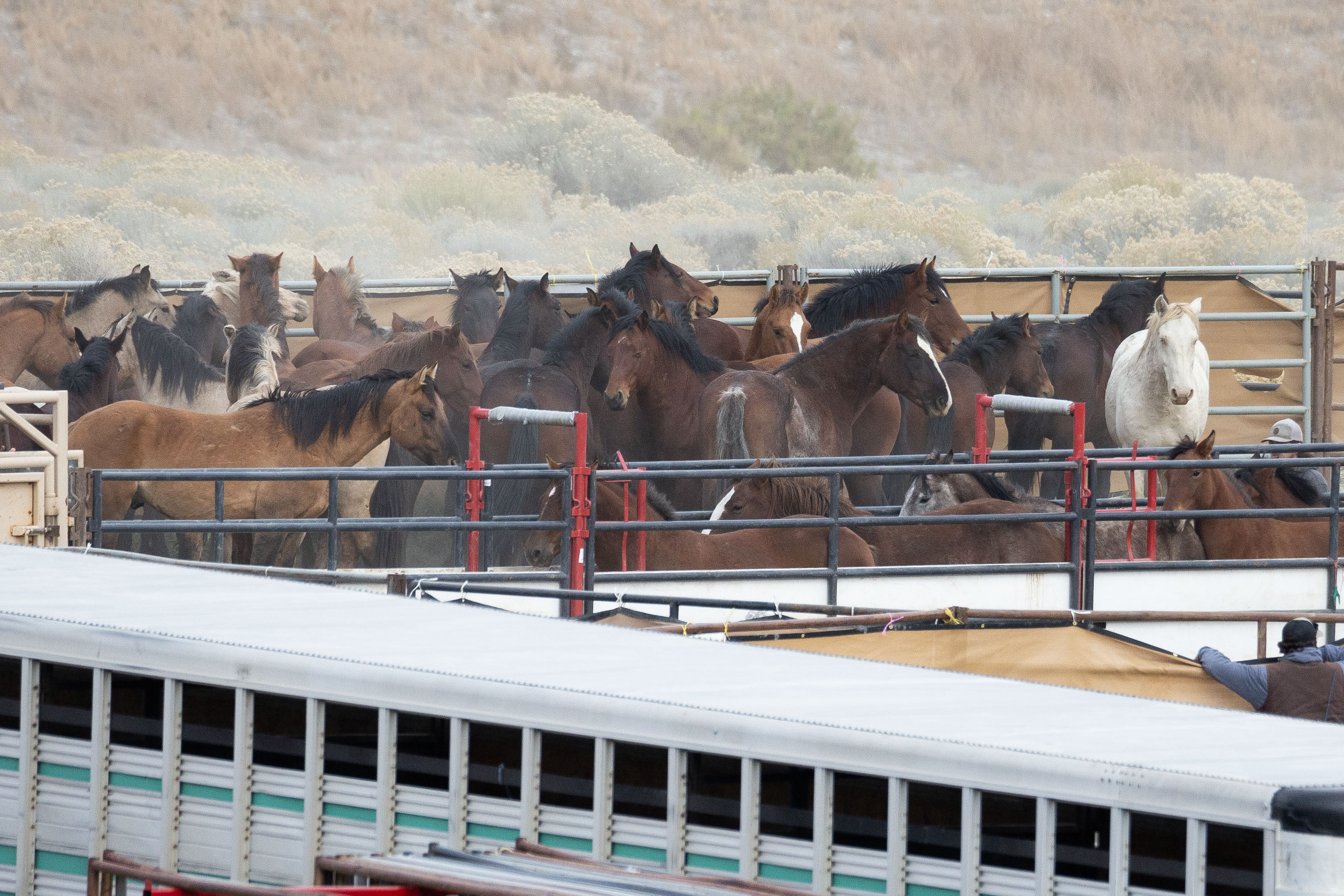
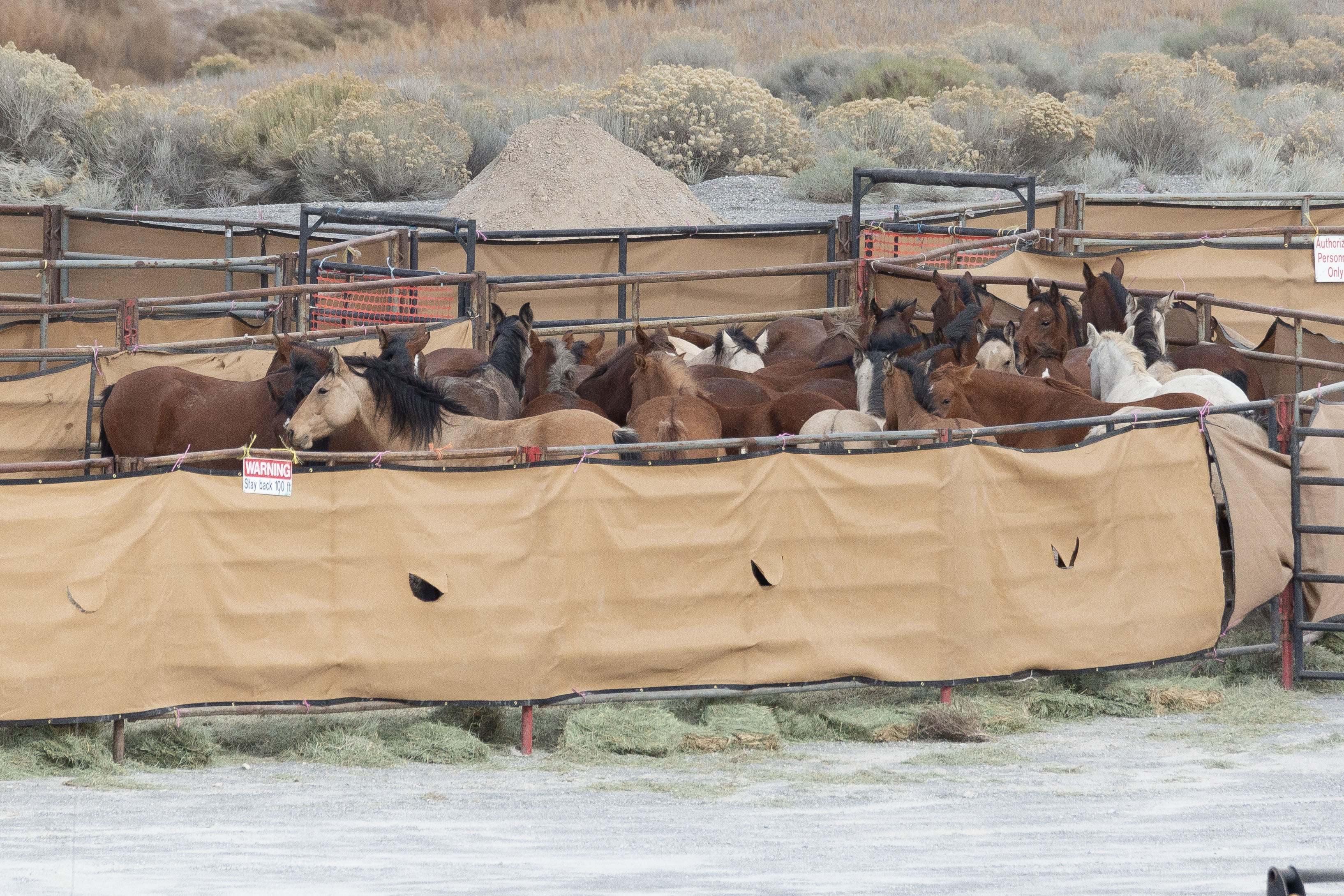
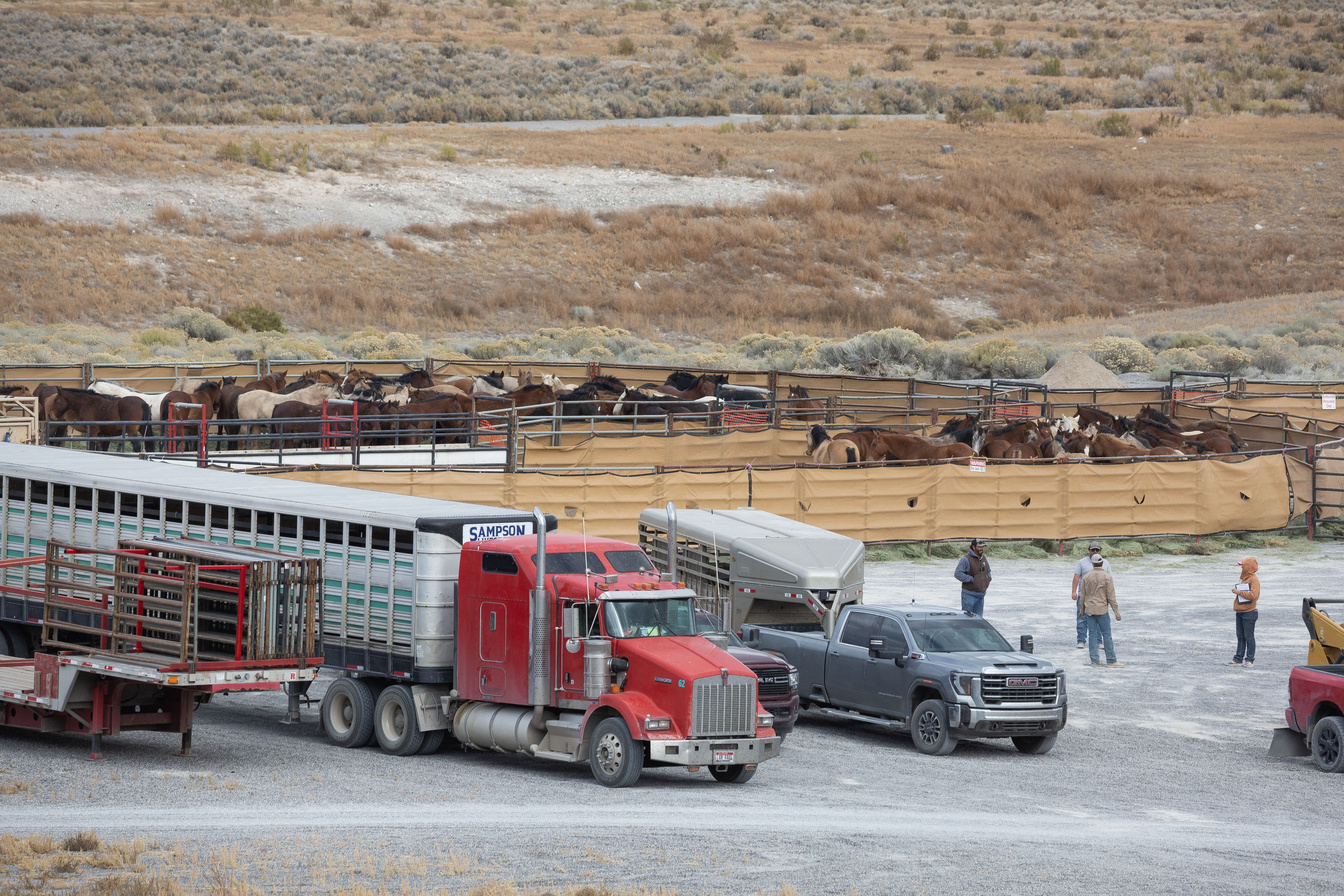
October 24, 2023: 67 wild horses were captured and there was one death after the BLM euthanized a 15-year-old mustang for blindness in their right eye.
Today we met at Eureka Fairgrounds and left at 6am to the same trap site (for the last day). They thought the plane would be done spraying the mountains but he was back at it this morning.
The first run came in at 9 am. Most of the run was not visible but it looked like it went well, the horses came in at a light trot breaking into a canter and entering the jutes. I counted 7. The second run came in at 10 am. Again, we were only able to see a small part of the run. These horses came in at a faster-paced canter but went right into trap without any issues.
We are only able to observe half of the jute, hopefully, that will change at the next trap site. Around 11:15 the pilot came down with a larger group of 20. I noticed a mare with a smaller foal in tow. He pushed them toward the area where the barbed wire fencing was dropped the previous day. Right before came through, 4 horses broke off from the larger group up the mountain. The pilot tried to retrieve them but they were set on getting away and would not turn around.
The pilot then left them to continue the larger group of around 16 horses to the trap. As they were trotting through the valley in front of us they seemed very tired. Definitely the most tired I’ve seen the horses come in. At least the pilot was staying at a safe distance as long as they were headed in the right direction.
They trotted most of the way to trap, sometimes going at a walk. The mare with the foal in tow was able to keep up. He immediately headed to the direction of the 4 horses that escaped (I assume) and not too much later we saw them coming down through the mountains. However, he had to work them pretty hard to get them into the valley and eventually had to give up after 15 minutes. After getting fuel the pilot went back to the same area and around 12:45 we saw around 10 horses coming down the valley towards the gate/fence area.
They came through the fencing and then ran along it to the left. The light was at an angle where you could see the sun reflecting off their sweaty coats. The temperatures might only be around 55-60, but when the sun is out it definitely feels much warmer. The pilot directed them a different way than before, now they came between us and the trap site. They looked tired and easily complied with the maneuvers of the helicopter. 1:30 the pilot brought more horses down from the east over the mountains. he seemed to have some difficulty pushing them through what I assume was a gated area that we could not see.
They traveled between us and the trap area again, this time much closer to the trap before making a U-turn into the jute. They seemed just a little hesitant going forward in the jutes but the pilot was able to push them in without any turning around. Out of all the trap sites I’ve seen set up this one has had almost no issues.
The only thing worth noting is that the trailer for loading is parked upslope so that might make loading more difficult. After this run we were told to pack up our equipment, and then the pilot found another group. Nothing notable happened in this run. We packed up again and were allowed to drive right by the trap with horses still in the pens. As we drove by I saw the scared and confused looks, I felt bad driving past them. There was another trailer load that had been sitting on the side of the road.
They then go just a few miles up the road where they are all loaded onto a big semi-trailer to drive to holding in 45 minutes. Then the next morning they are loaded and shipped again to the Axtell facility in Utah which is a 5 hour drive.
Temporary holding: as they were still loading at the trap site we headed to the temporary holding. It was so quiet at temp holding I almost thought there were no horses in the pens. All the horses were very quiet and taking naps. With the solid tarps around the pens we are unable to see anything at ground level, but today we were allowed to climb up a hill (still at a good distance from the pens) and we were able to see much better. We waited until the large stock trailer arrived and watched sorting and unloading.
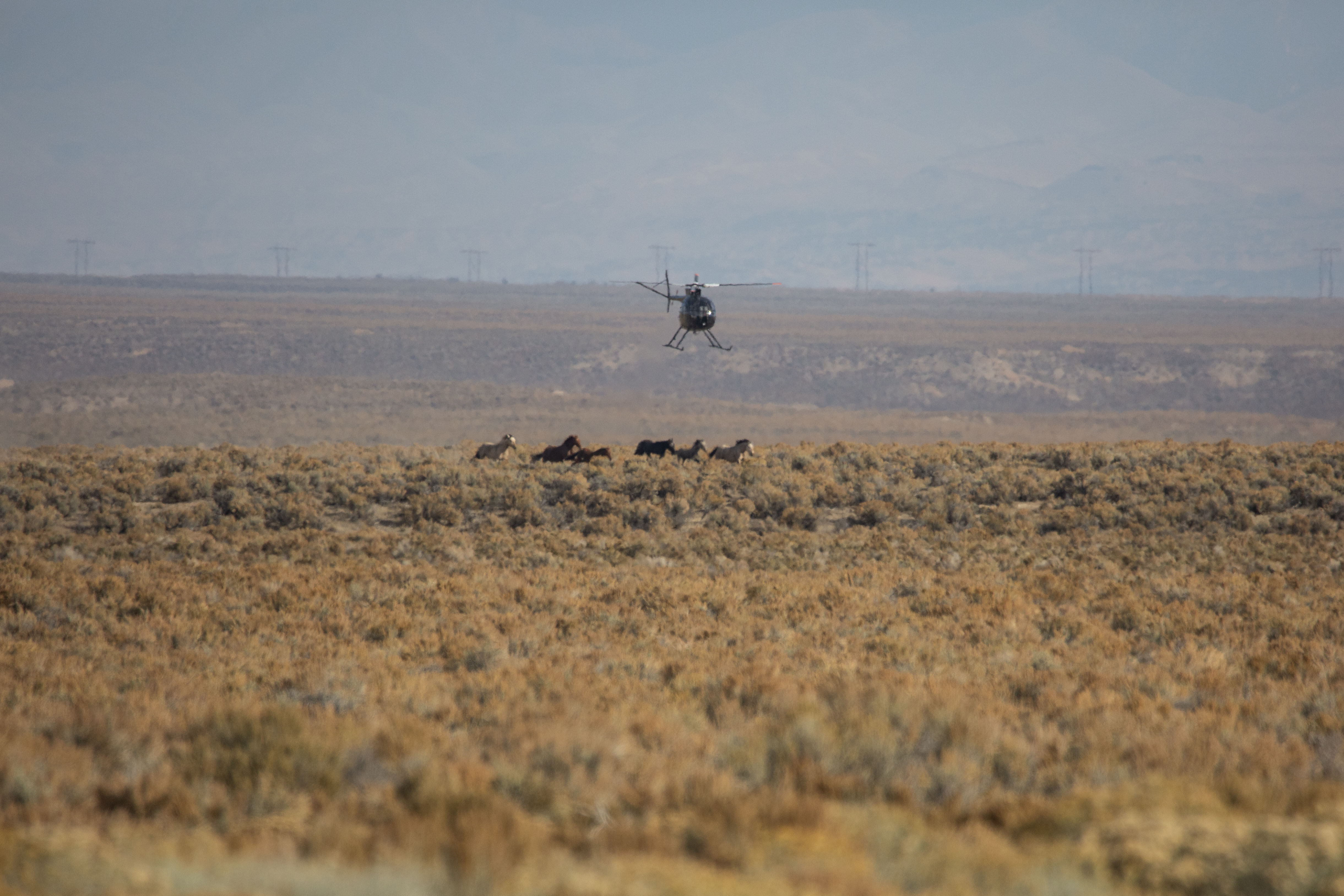
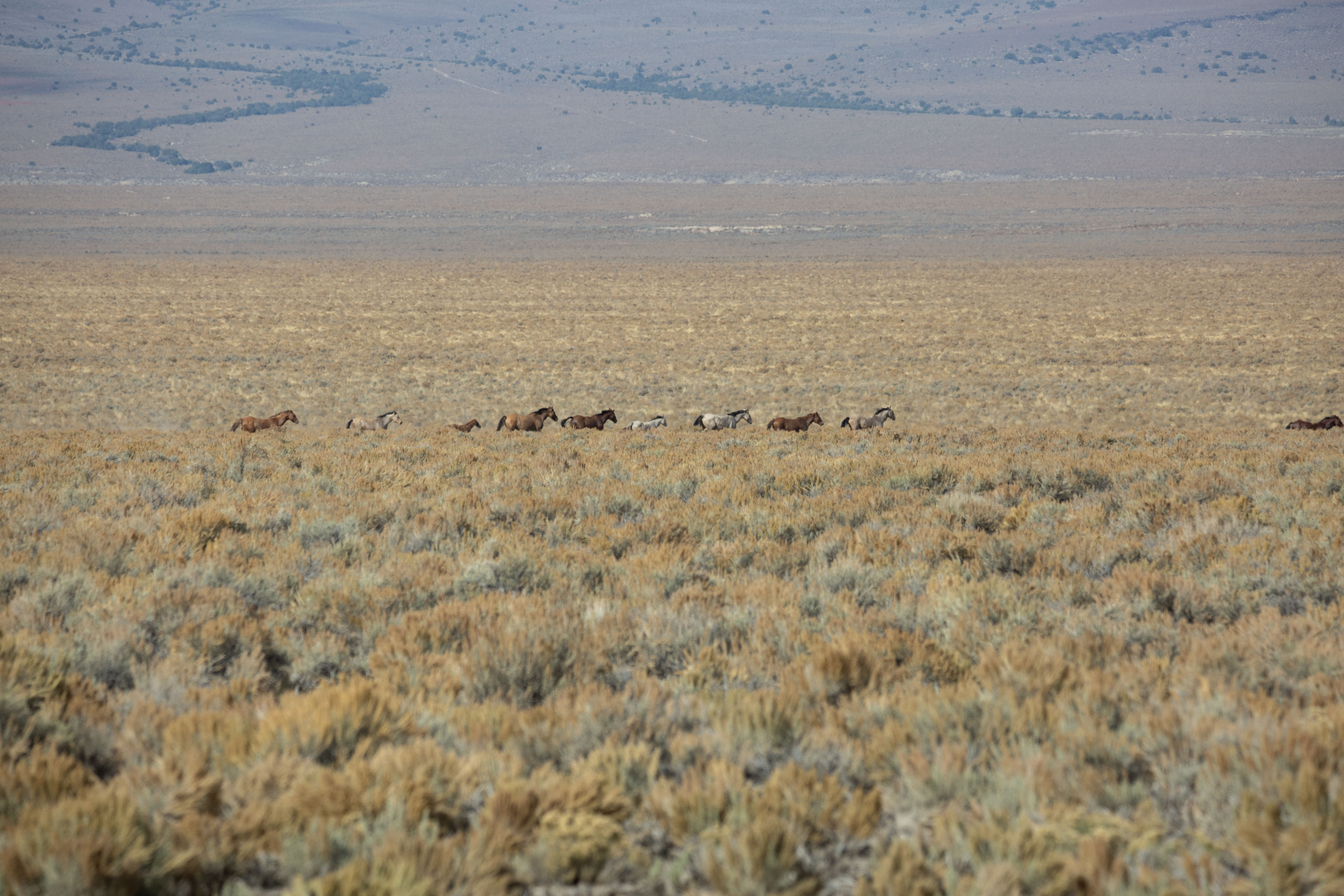
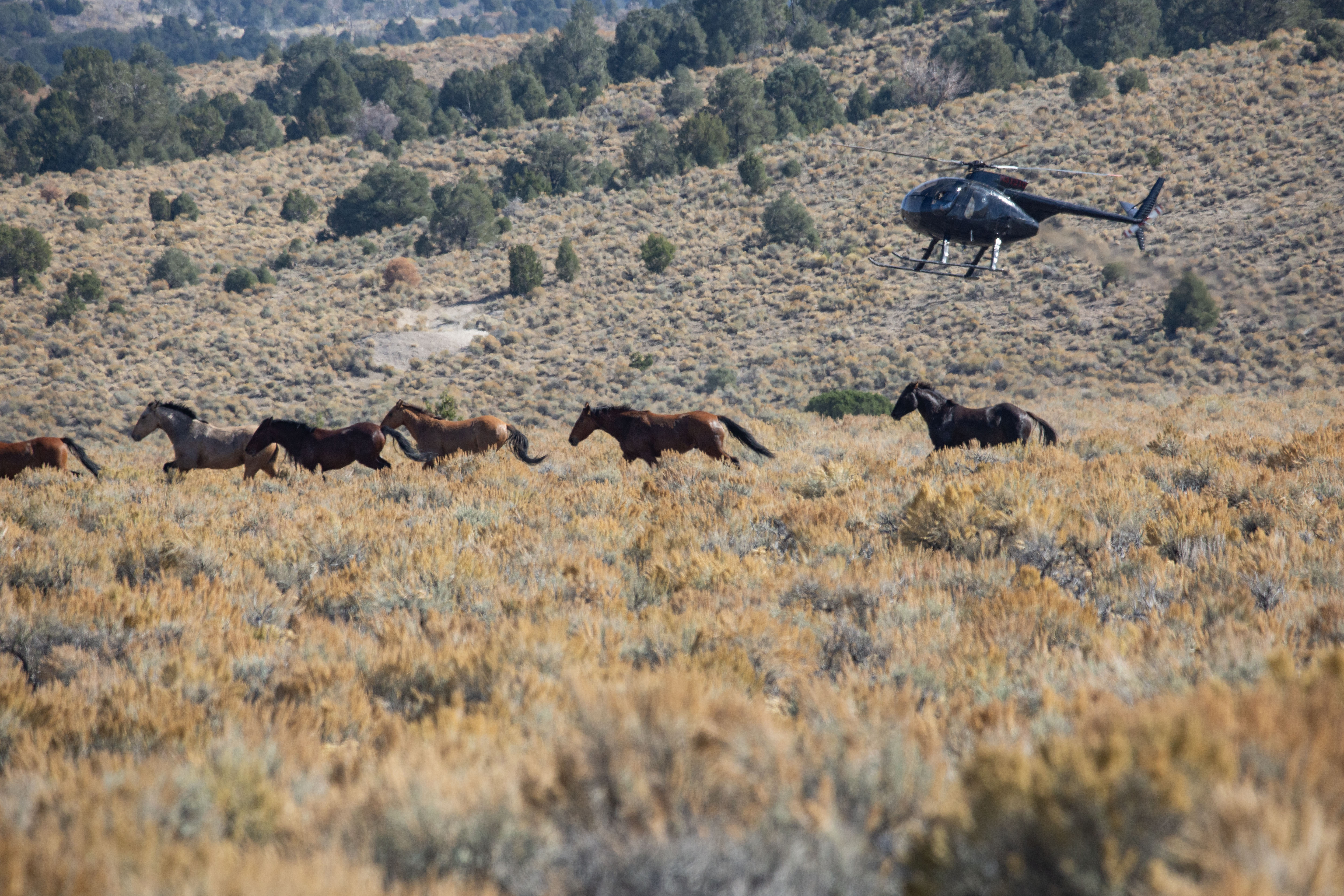
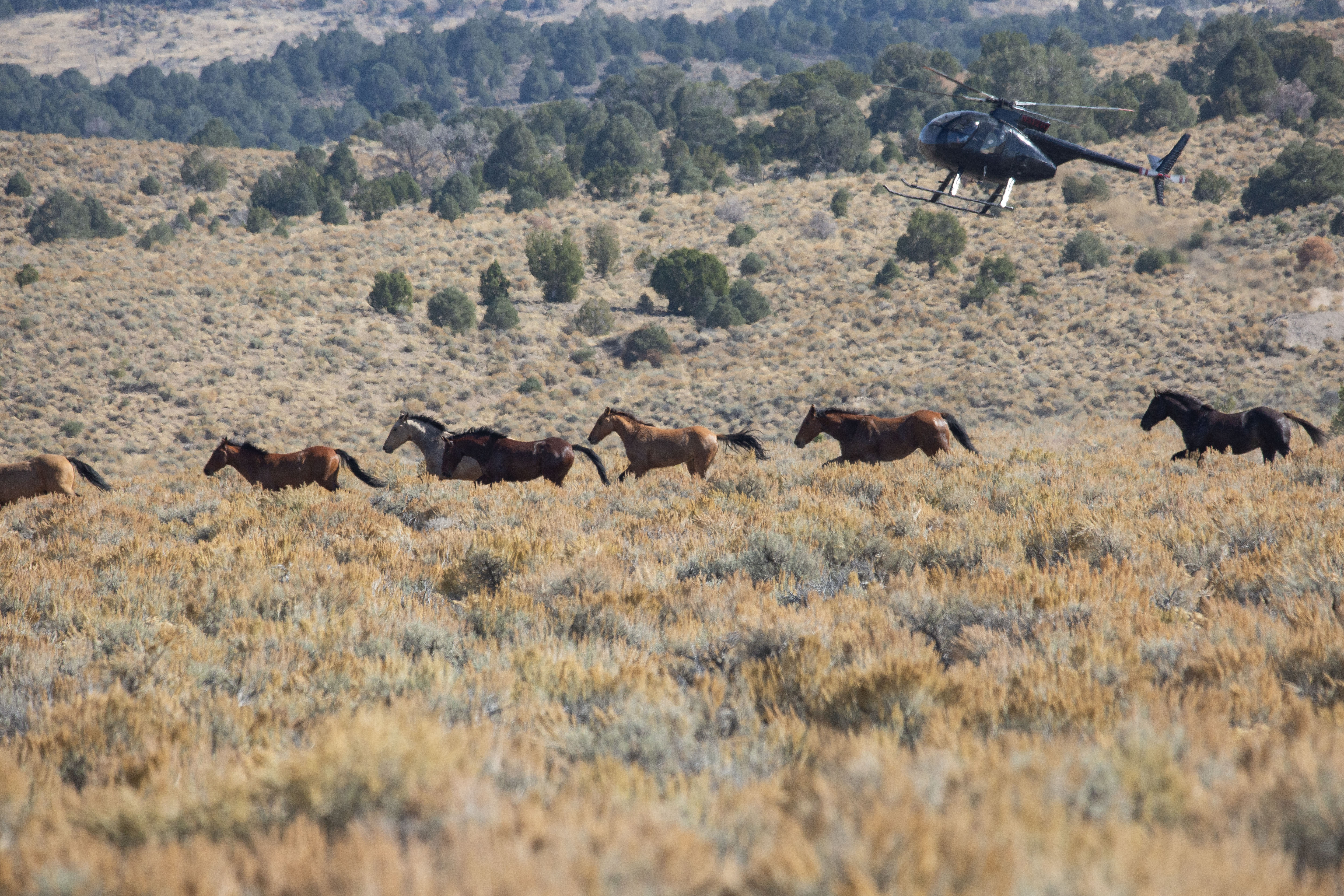
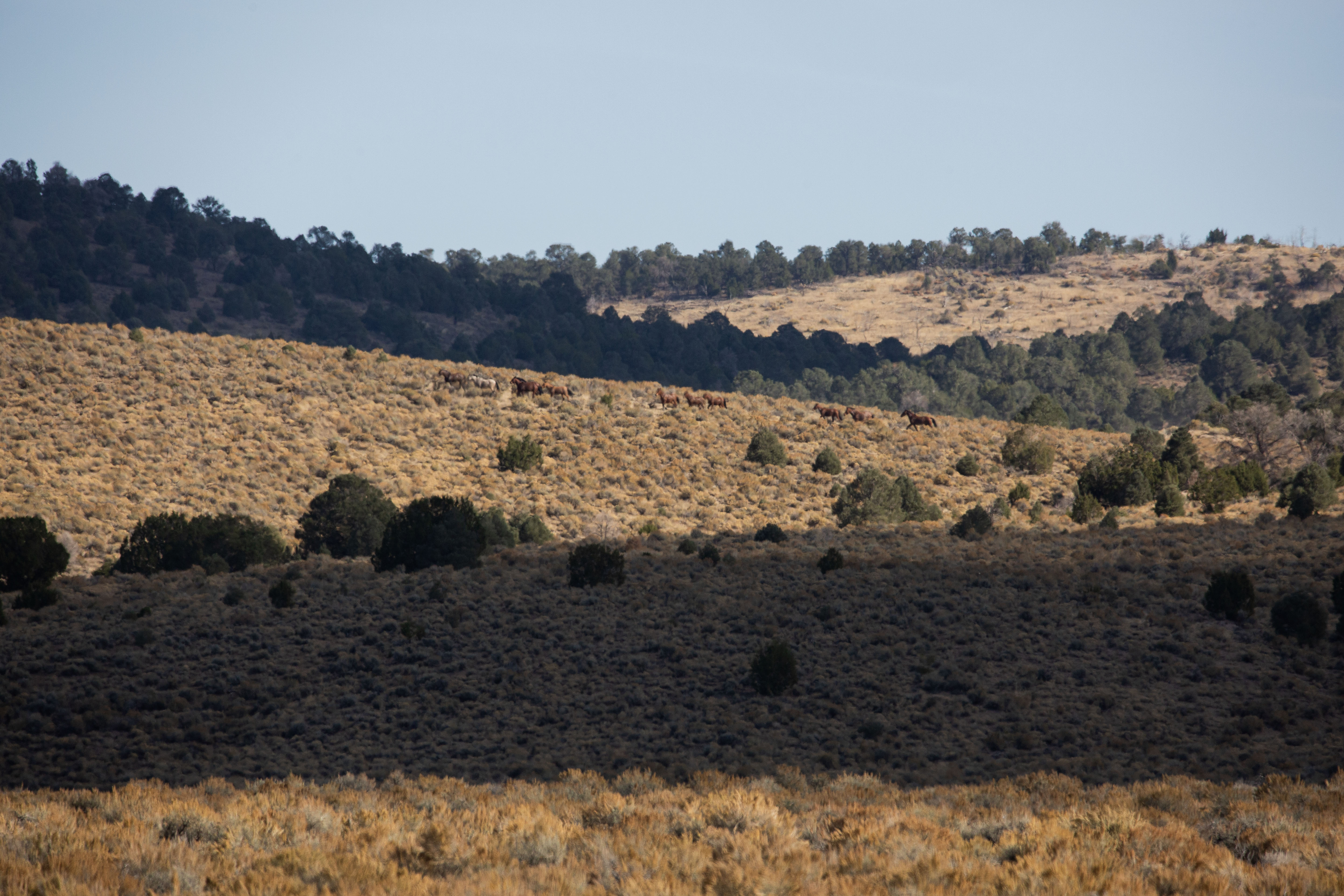
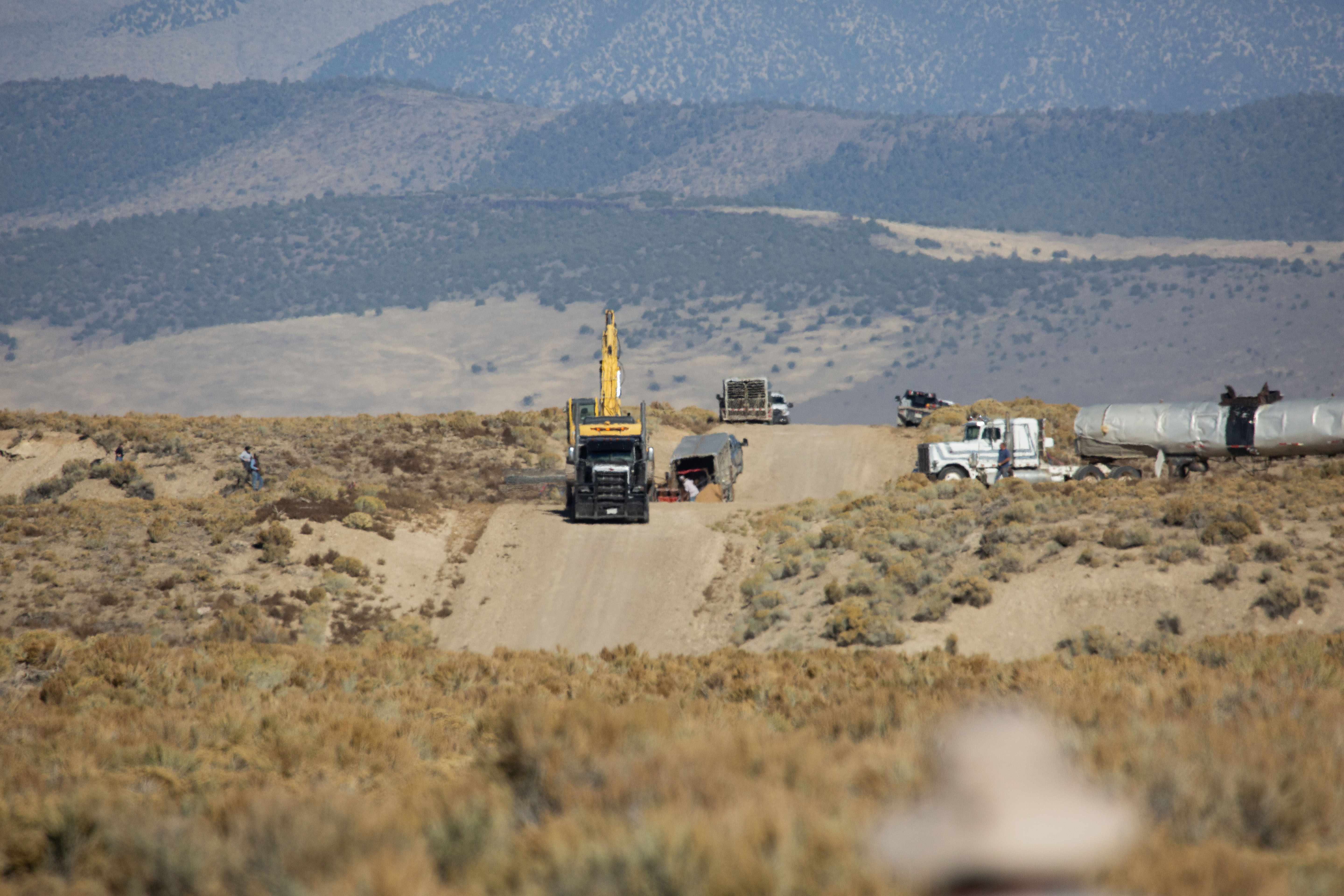
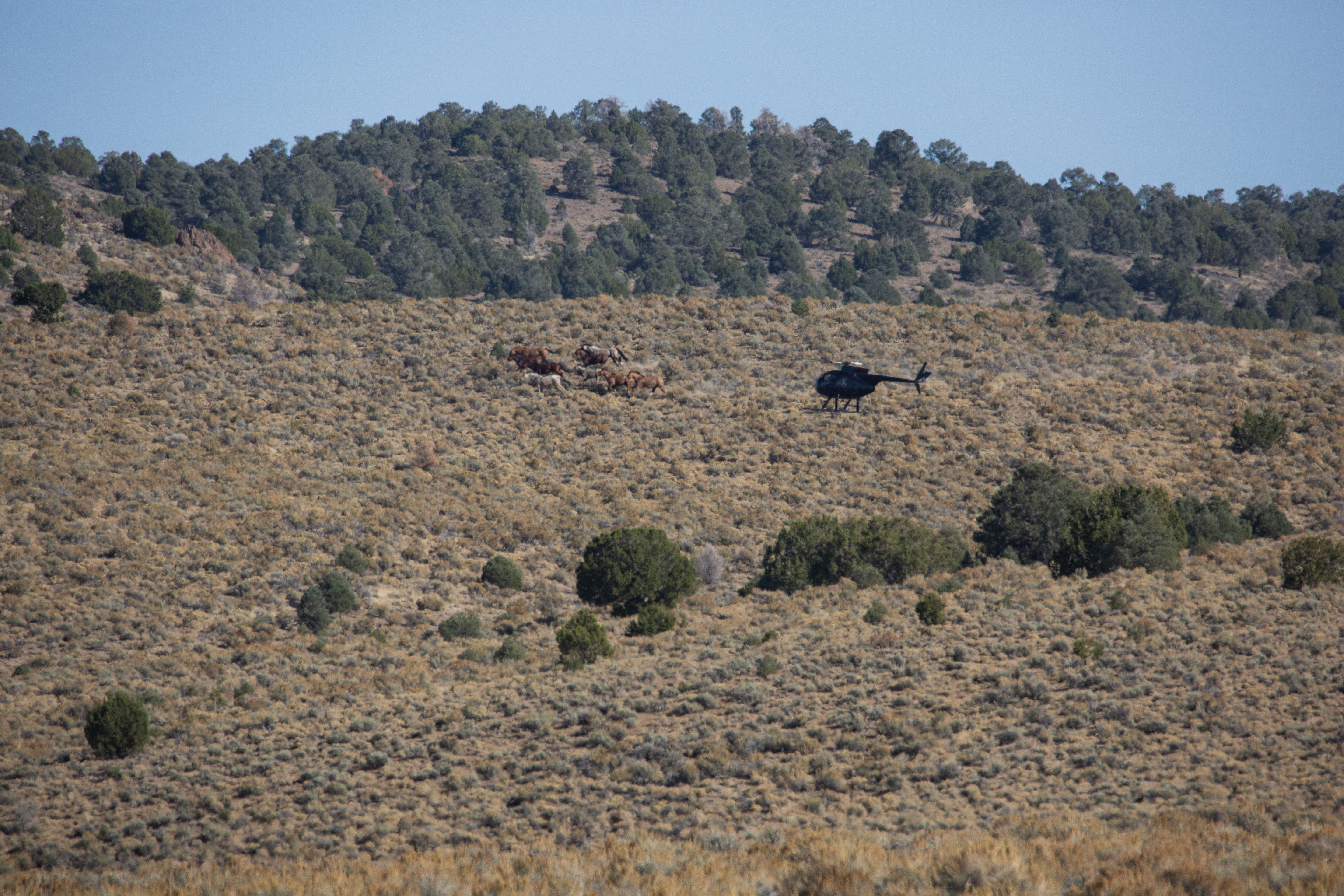
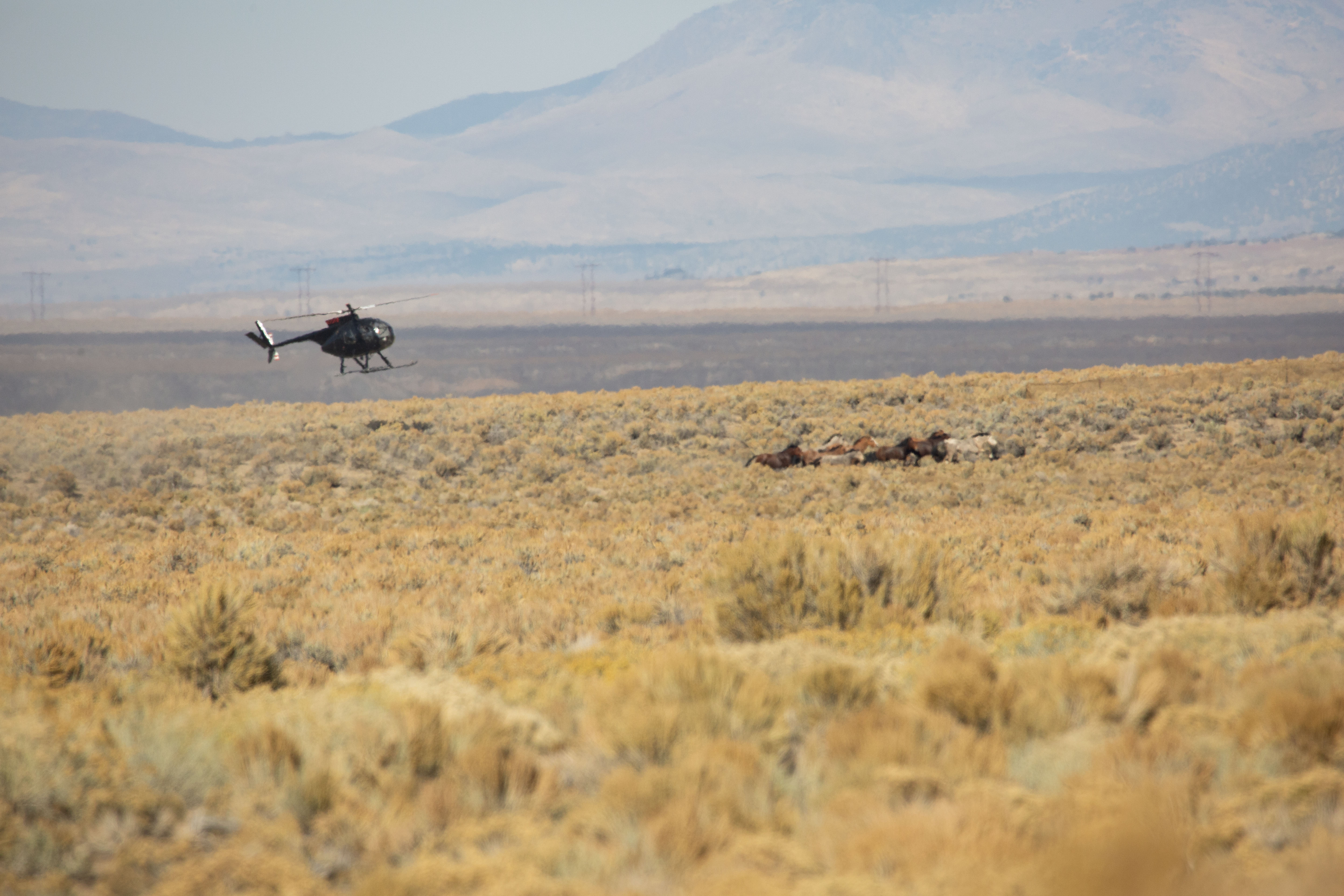
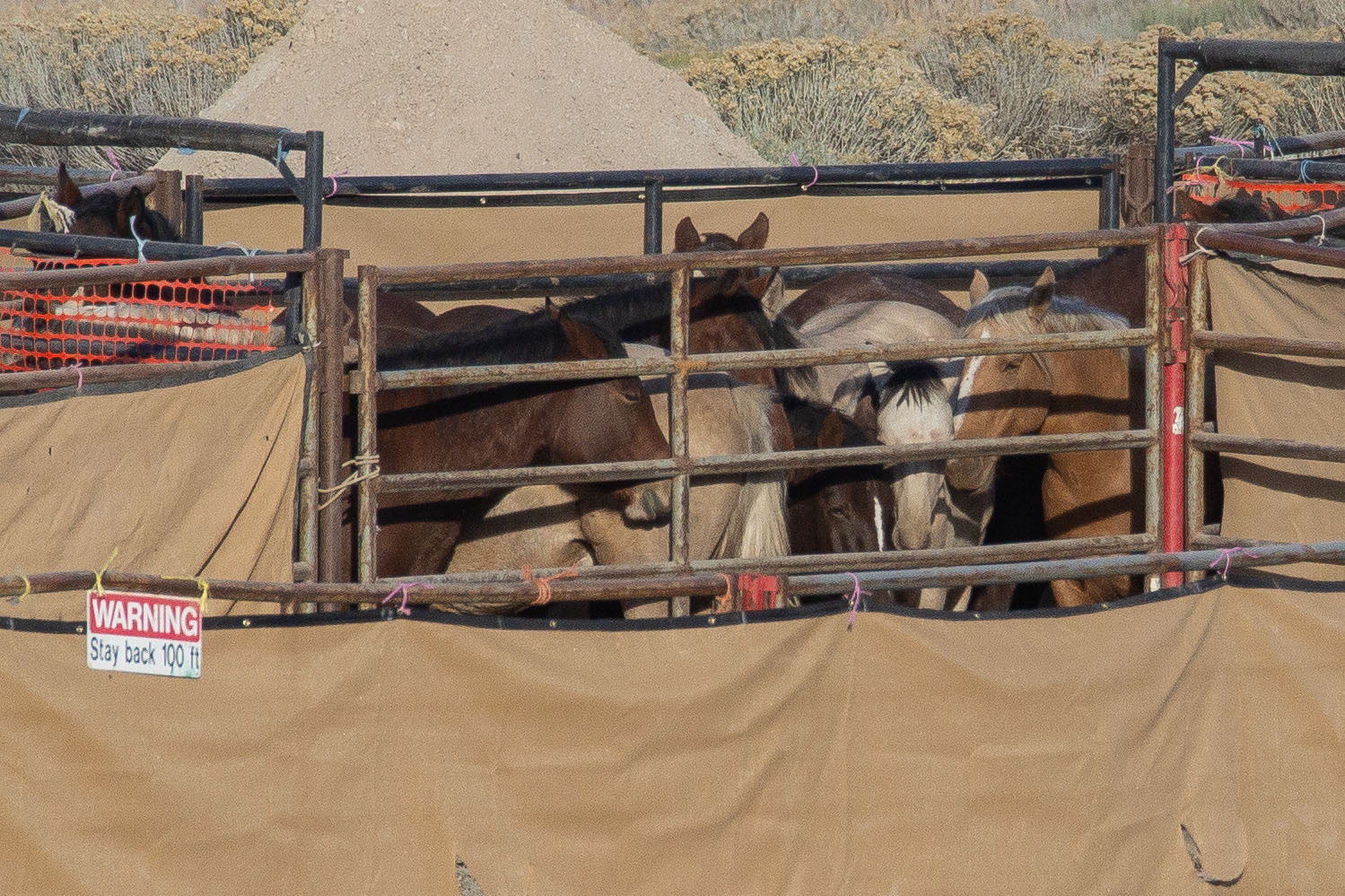
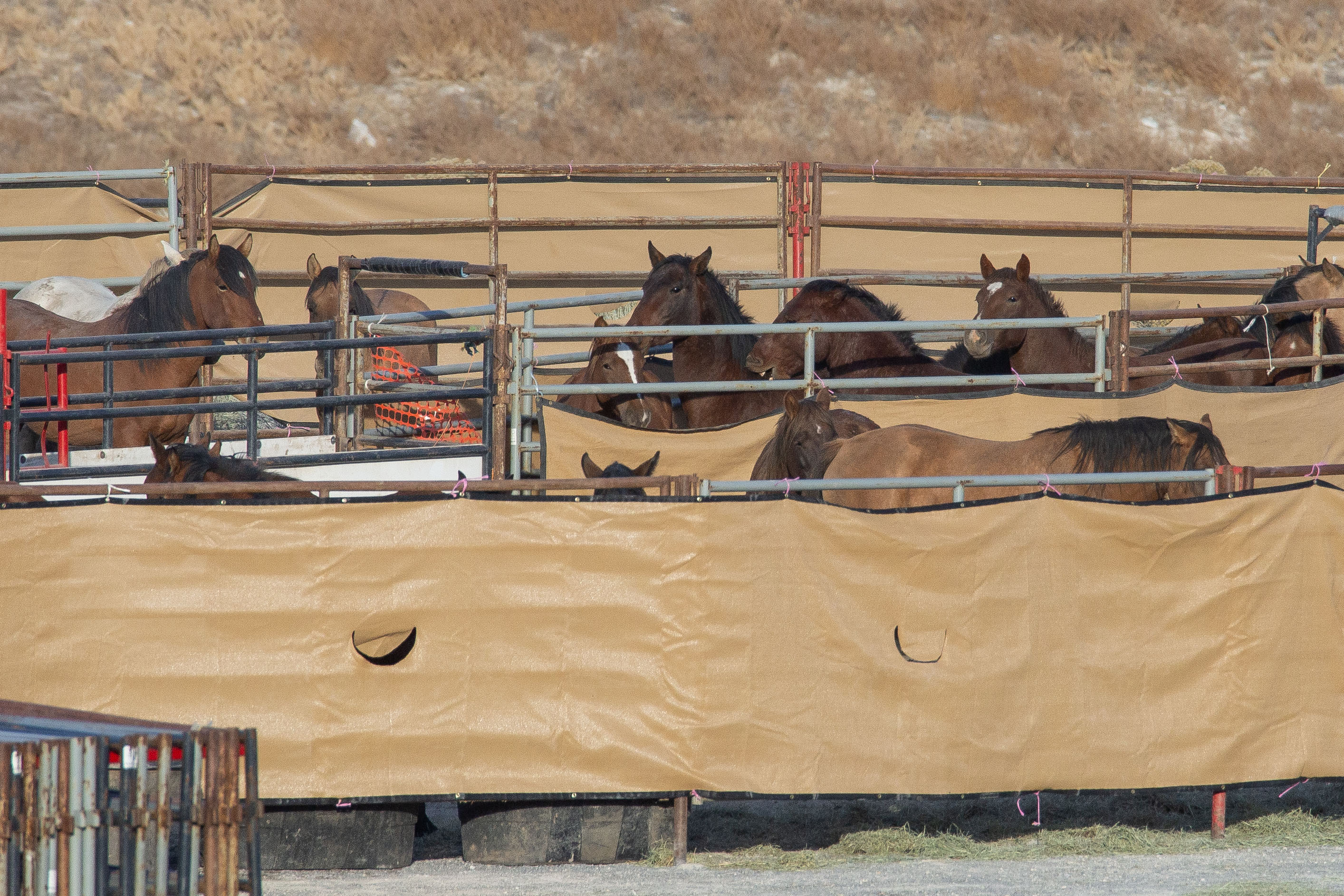
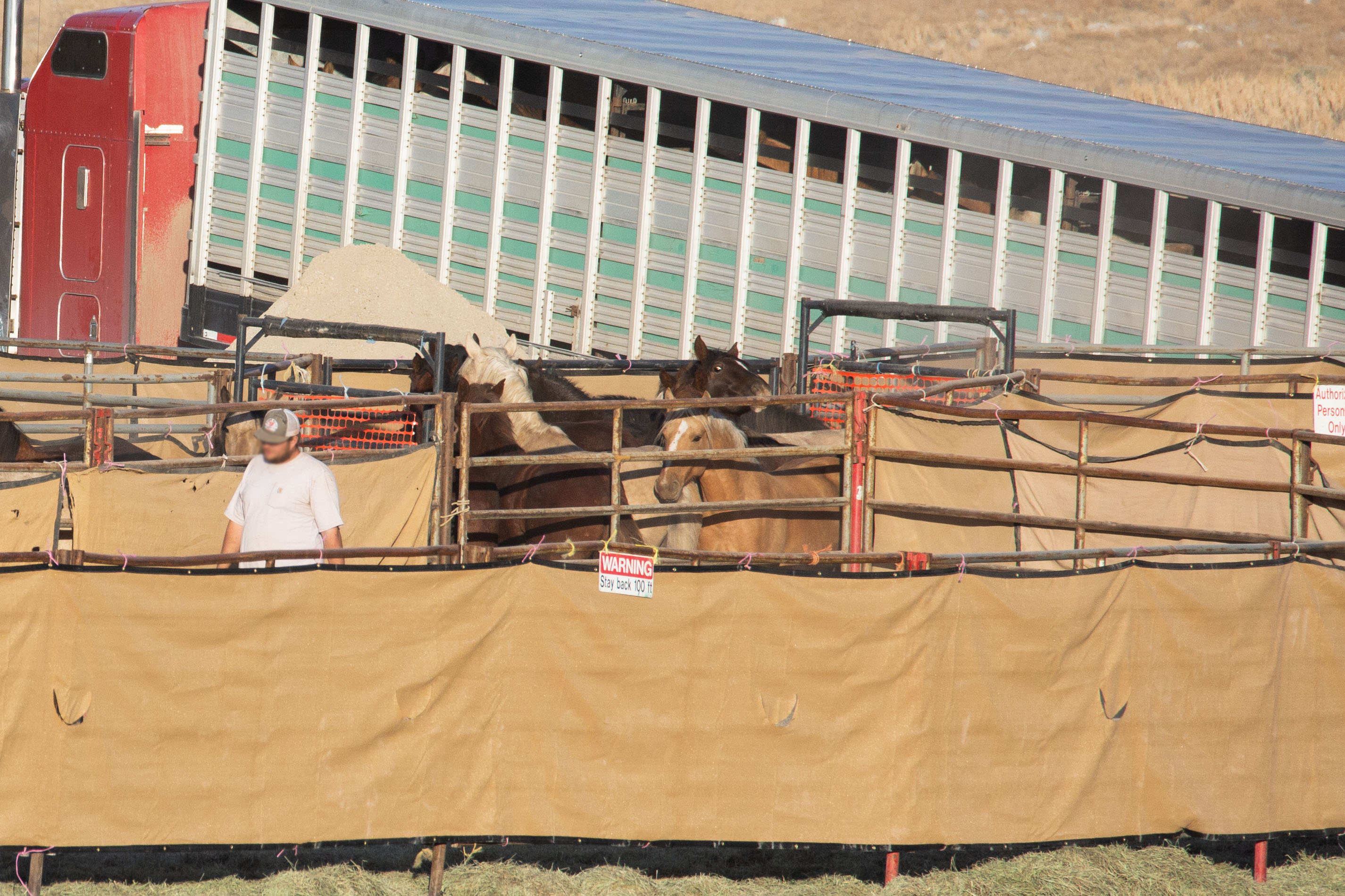
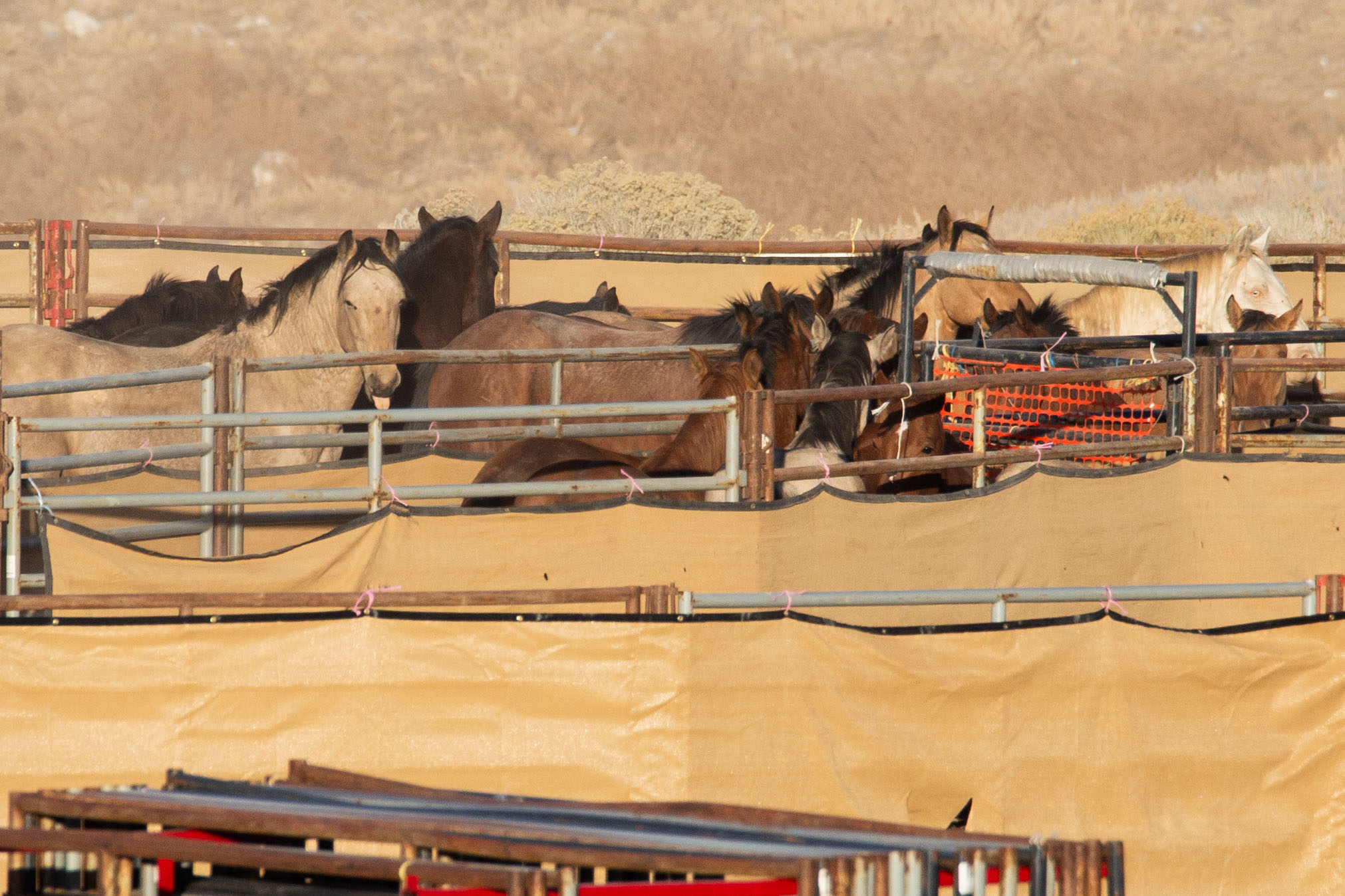
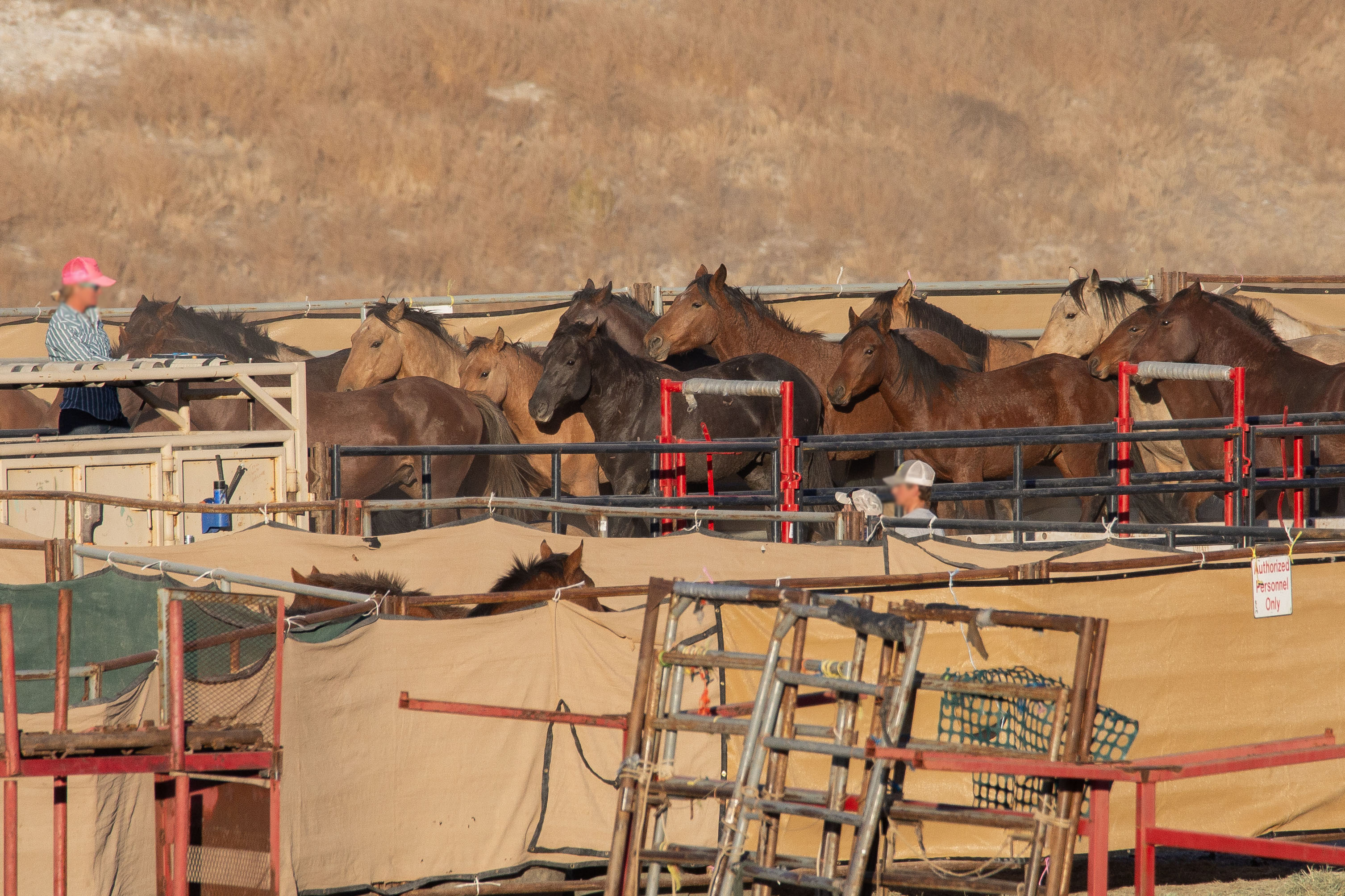
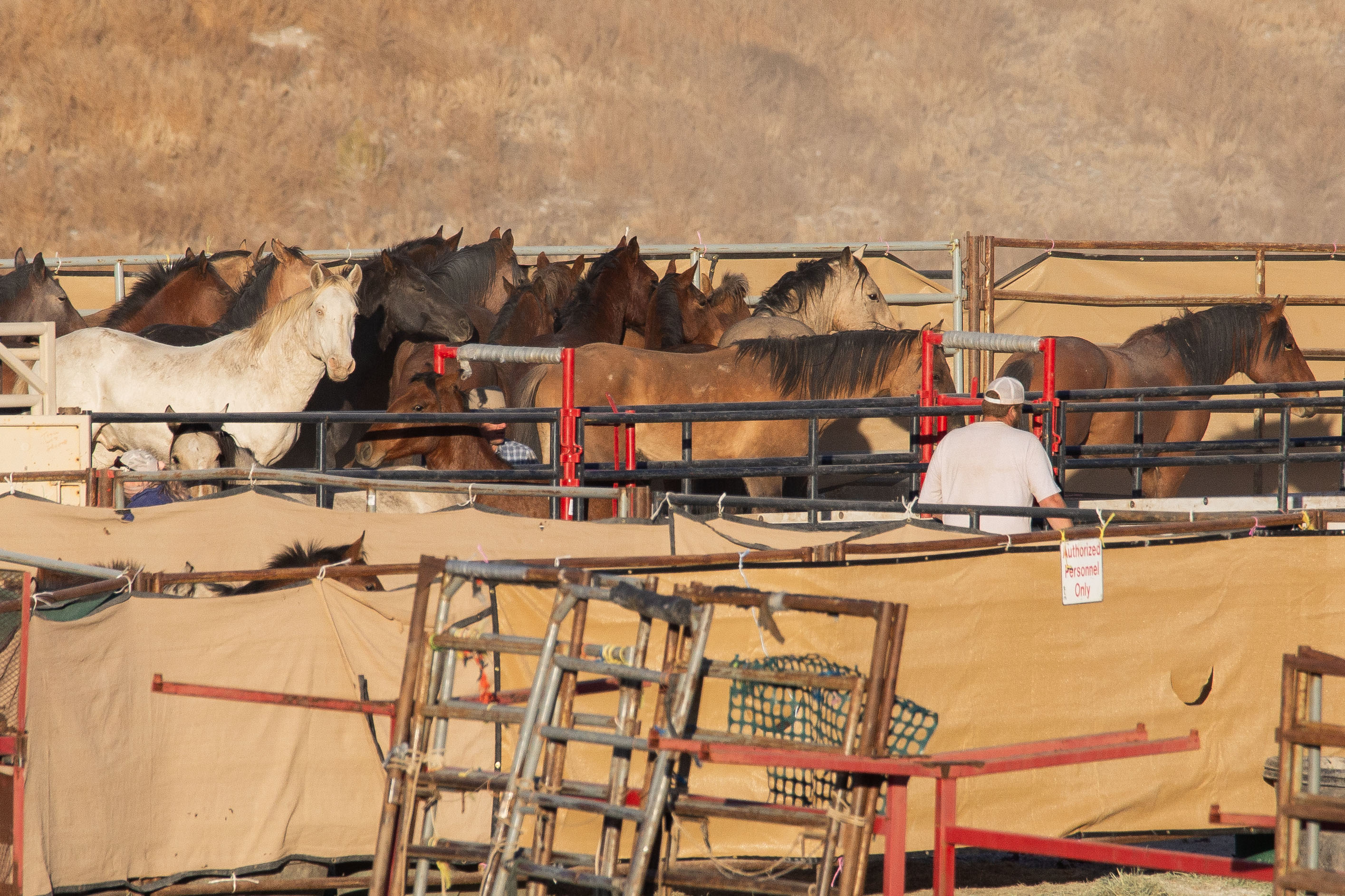
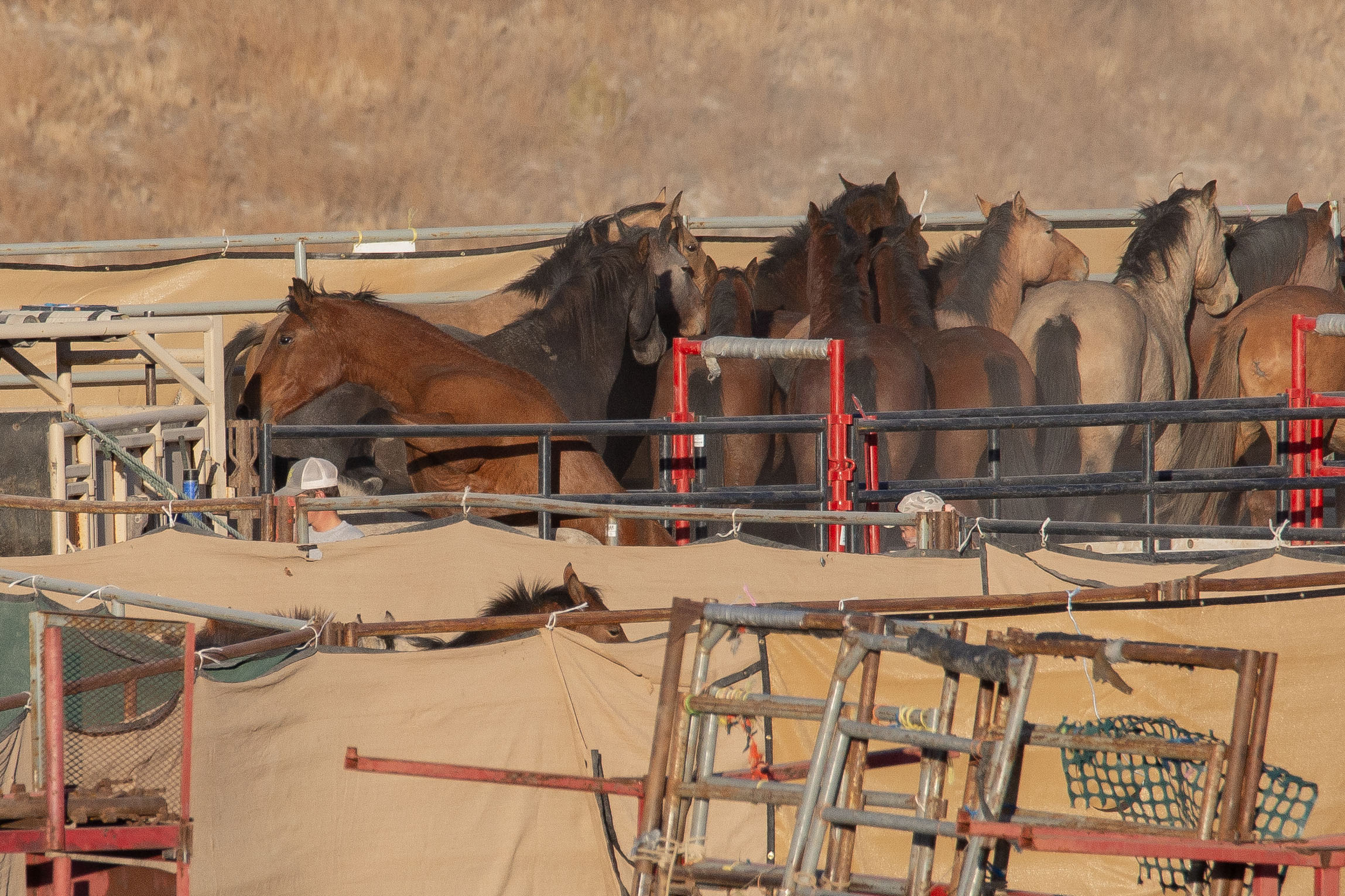
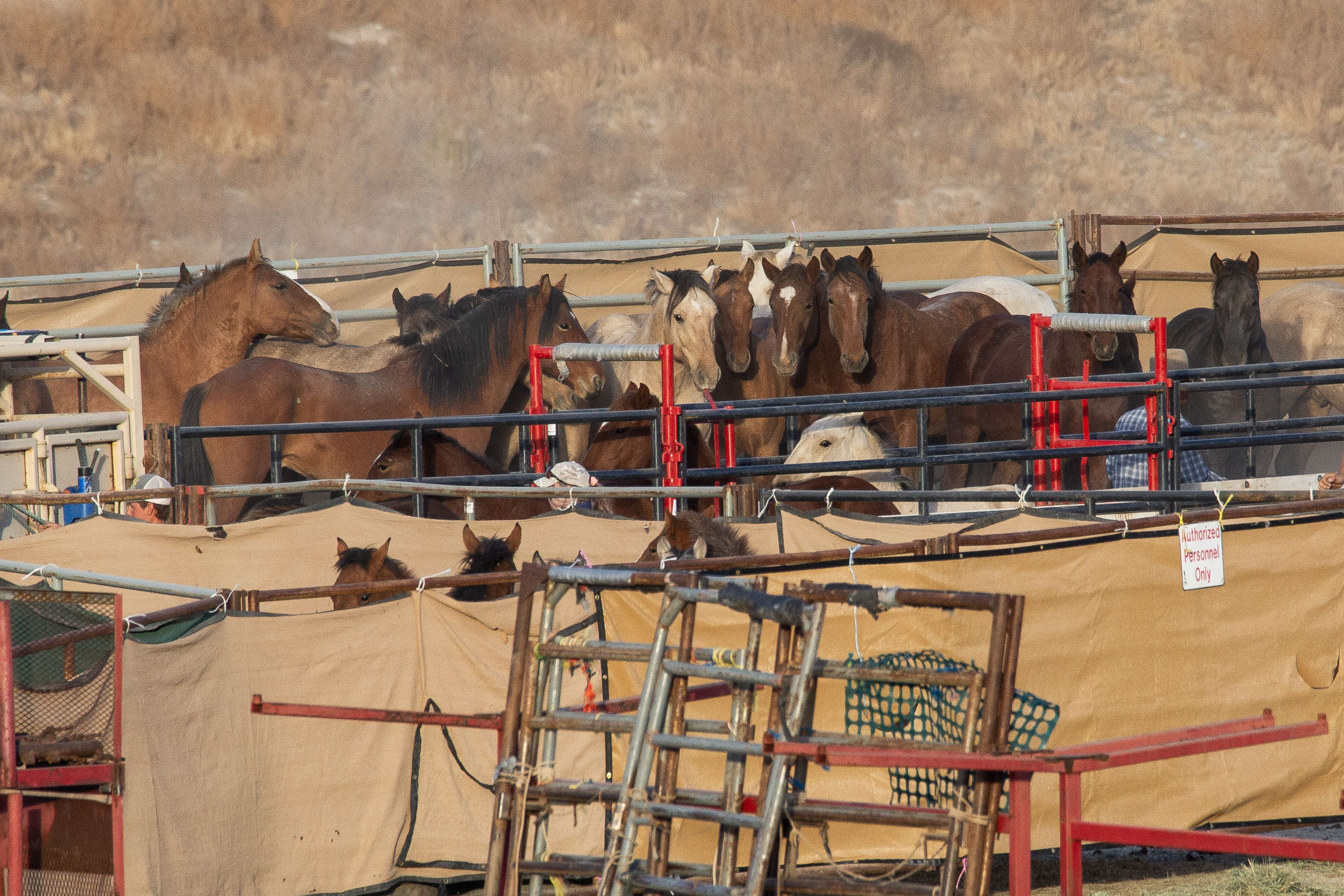
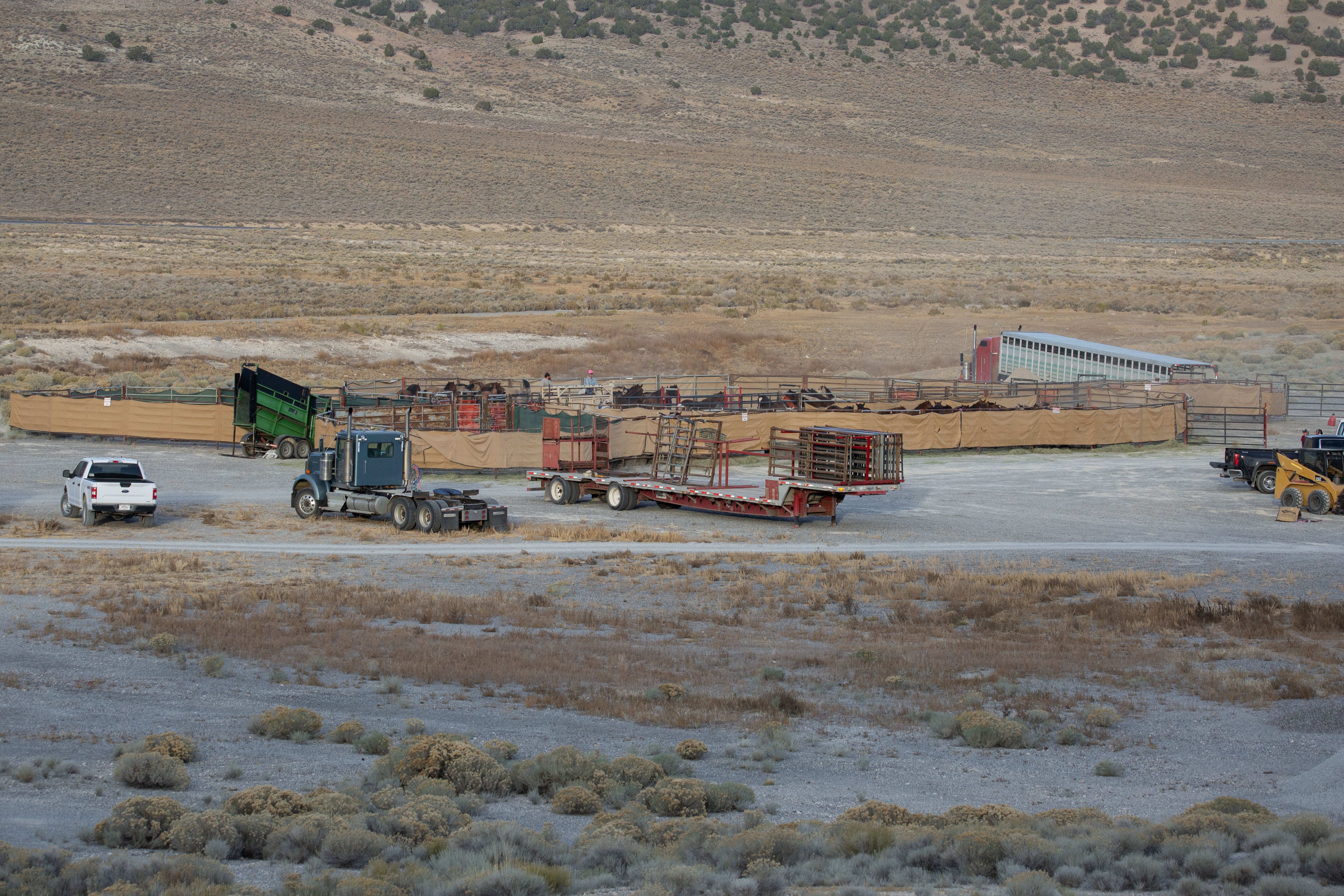
October 23, 2023: 90 wild horses were captured and there were two deaths after a horse broke its neck and the BLM euthanized an aggressive horse who was blind in one eye.
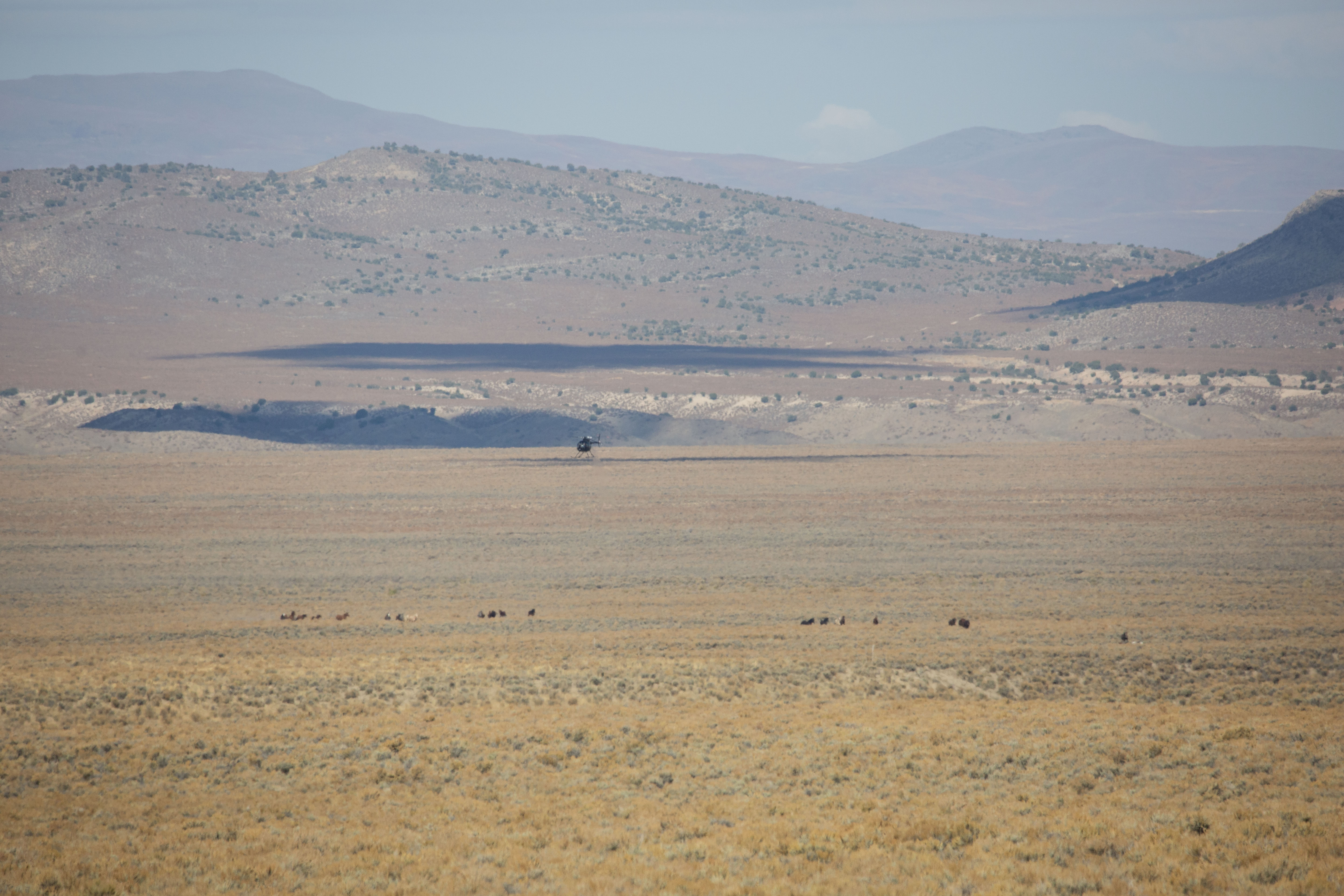
Today, we met the BLM (Bureau of Land Management) at the same time and location as the previous day. The trap site remained unchanged. We noticed a helicopter flying at 8 am, and based on its behavior, we assumed it was stampeding horses. Due to the landscape, our visibility was limited, and the helicopter disappeared for a while. At around 9:30 am, 15 horses emerged from over the hill and headed towards the trap. This time, the pilot was able to maintain a safe distance as the horses entered the trap, traveling at a light canter.
During the next run, the horses came from a different area, and we had a clear view as they passed through the big valley. This was the largest group we've observed so far, consisting of approximately 30 horses. They moved smoothly at a light canter, and the pilot had no trouble guiding them into the trap without scattering them. Once again, the pilot maintained a safe distance throughout this run.
It's worth noting that for the past three days, a plane has been flying in the morning, spraying weed killer in the mountainous region behind us. Initially, the BLM staff was unaware of this activity and had no means of communication with the plane. However, they eventually identified the plane as being contracted by a nearby mine. This additional stress factor may have impacted the horses in the area.
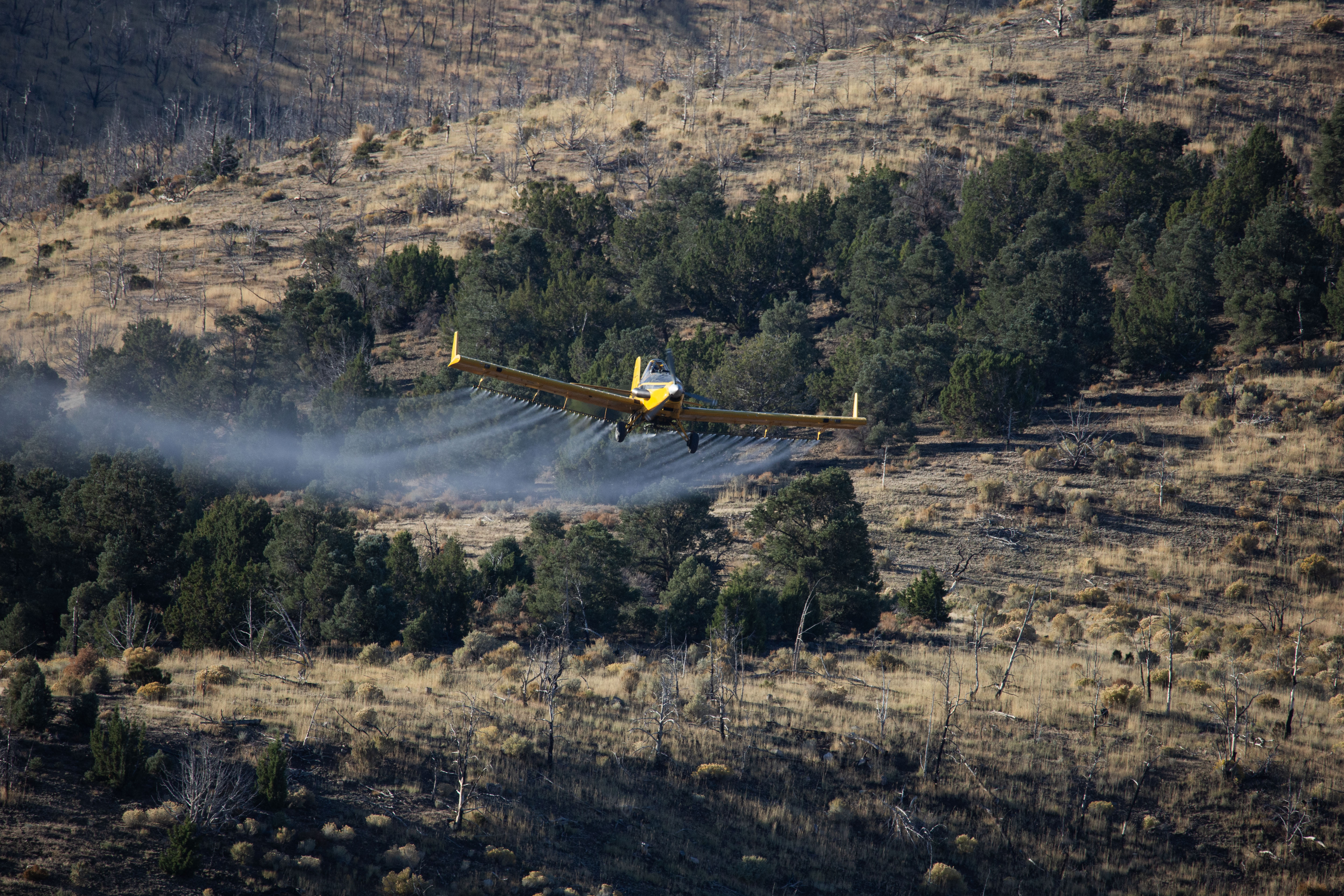
The following run involved horses coming from the area where the plane had been spraying. Three horses ran along the barbed wire fencing until the pilot found an opening and directed them towards the trap. An ATV was used to open the fencing, making it easier and quicker for the horses to navigate towards the trap. Surprisingly, another larger group of 25 horses followed suit. They passed through the fencing without any issues, coming within 200 feet of us at a canter before continuing into the valley. Once again, the pilot maintained a safe distance while guiding them.
The rest of the day proceeded smoothly, with the pilot bringing in a group of 4 horses followed by another larger group of 15. Both runs went without a hitch. However, when the pilot went out again in search of horses, he found a band of approximately 7 but was unable to bring them within half a mile of the trap. Eventually, he had to abandon the attempt, and our operations for the day concluded.
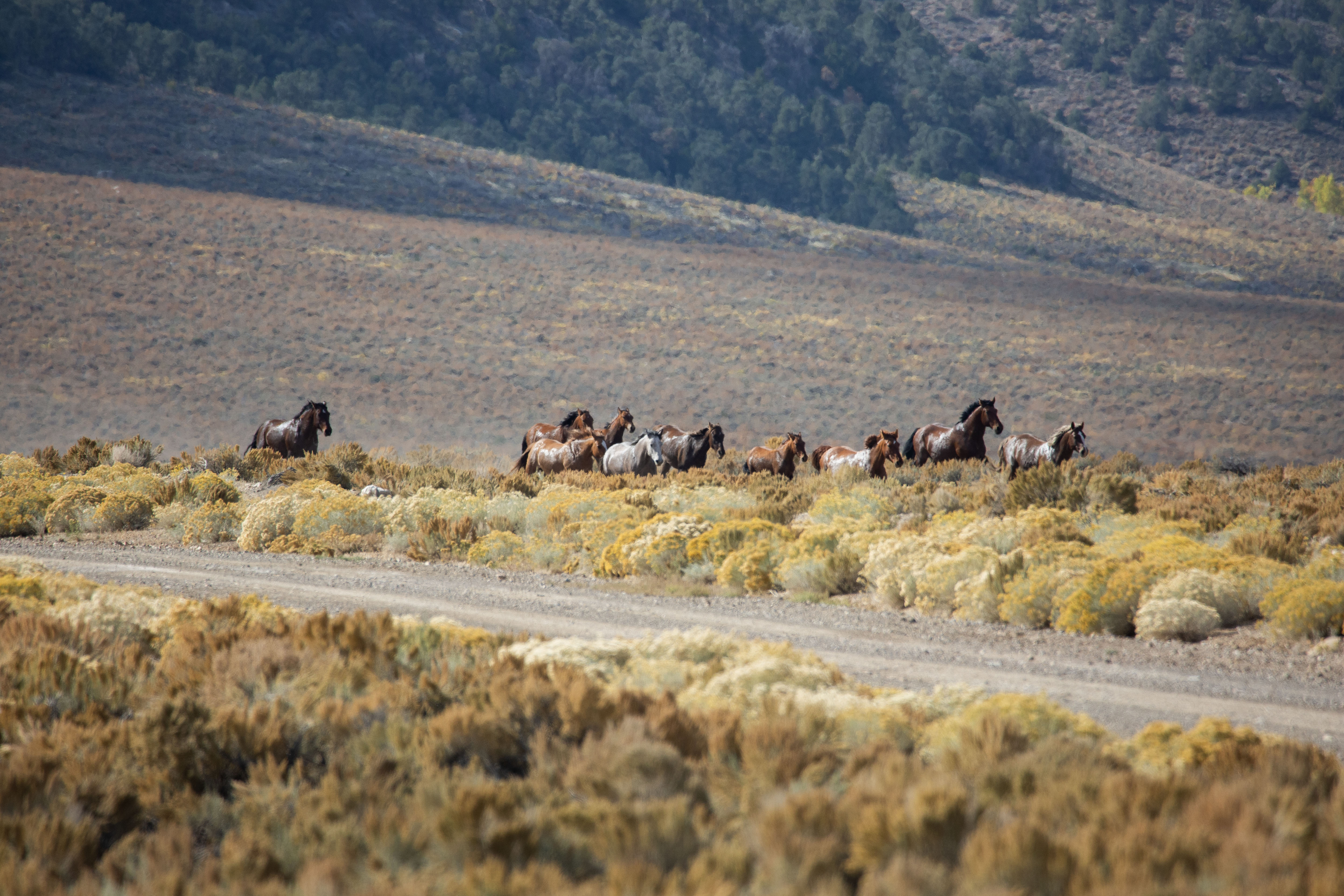
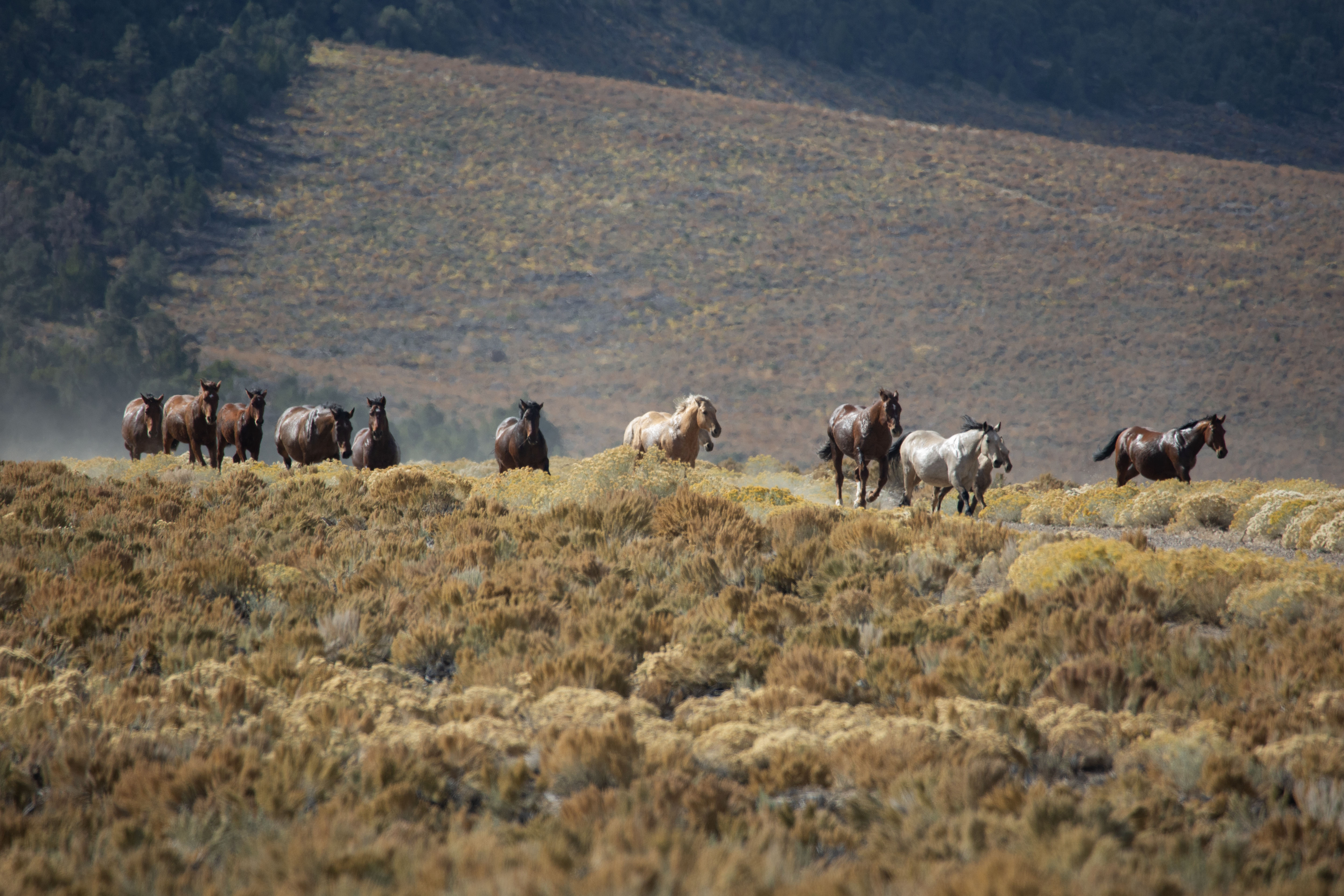
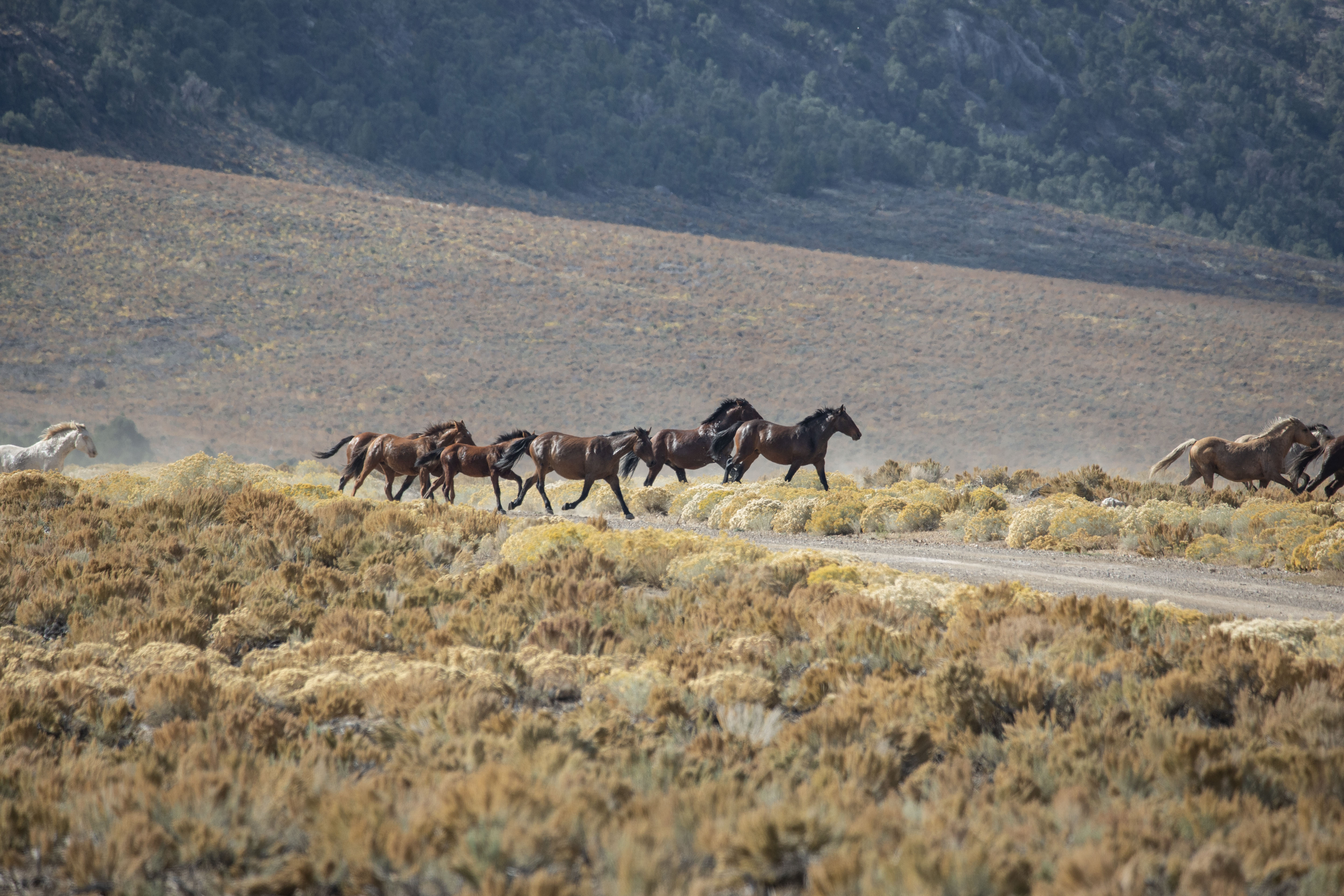
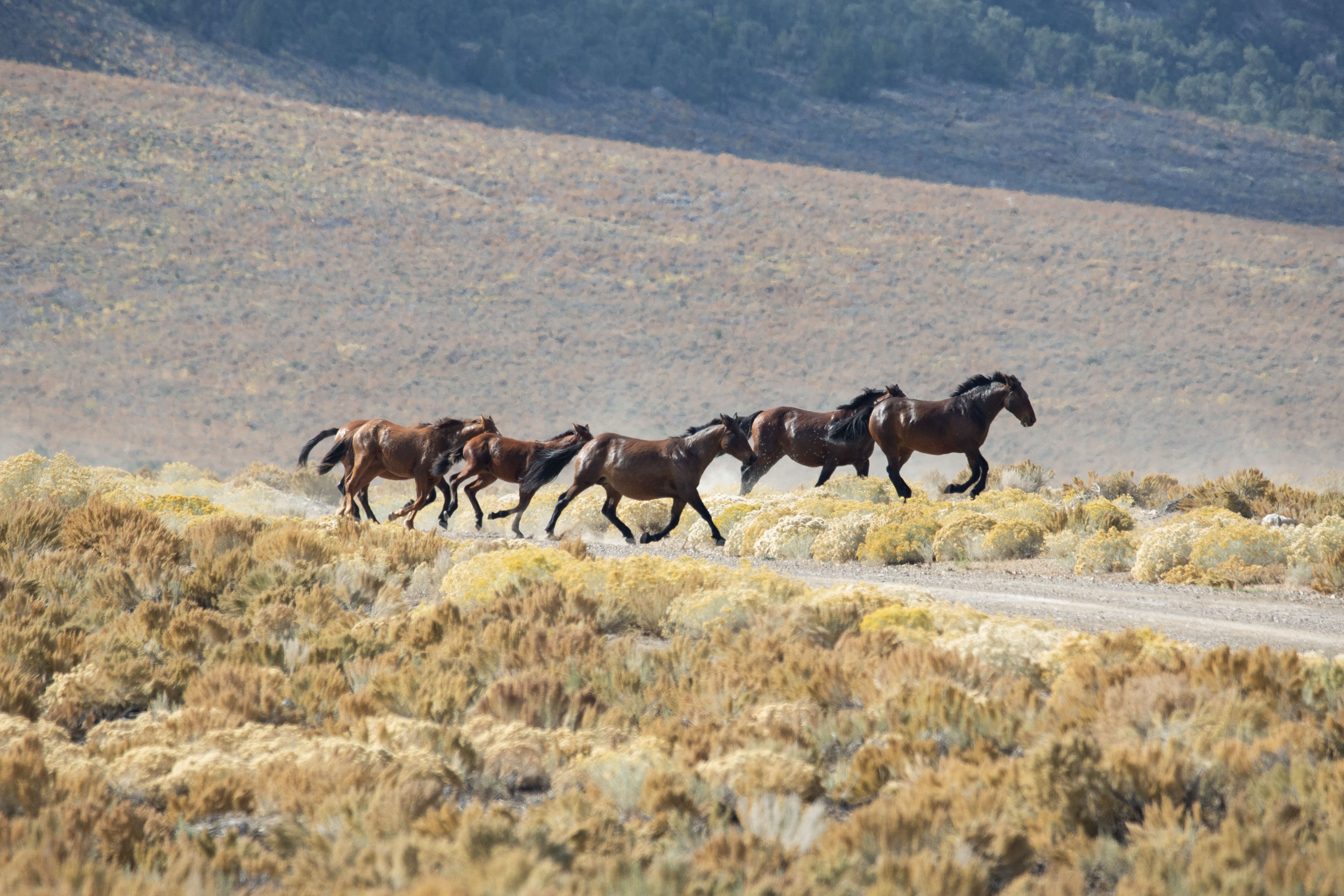
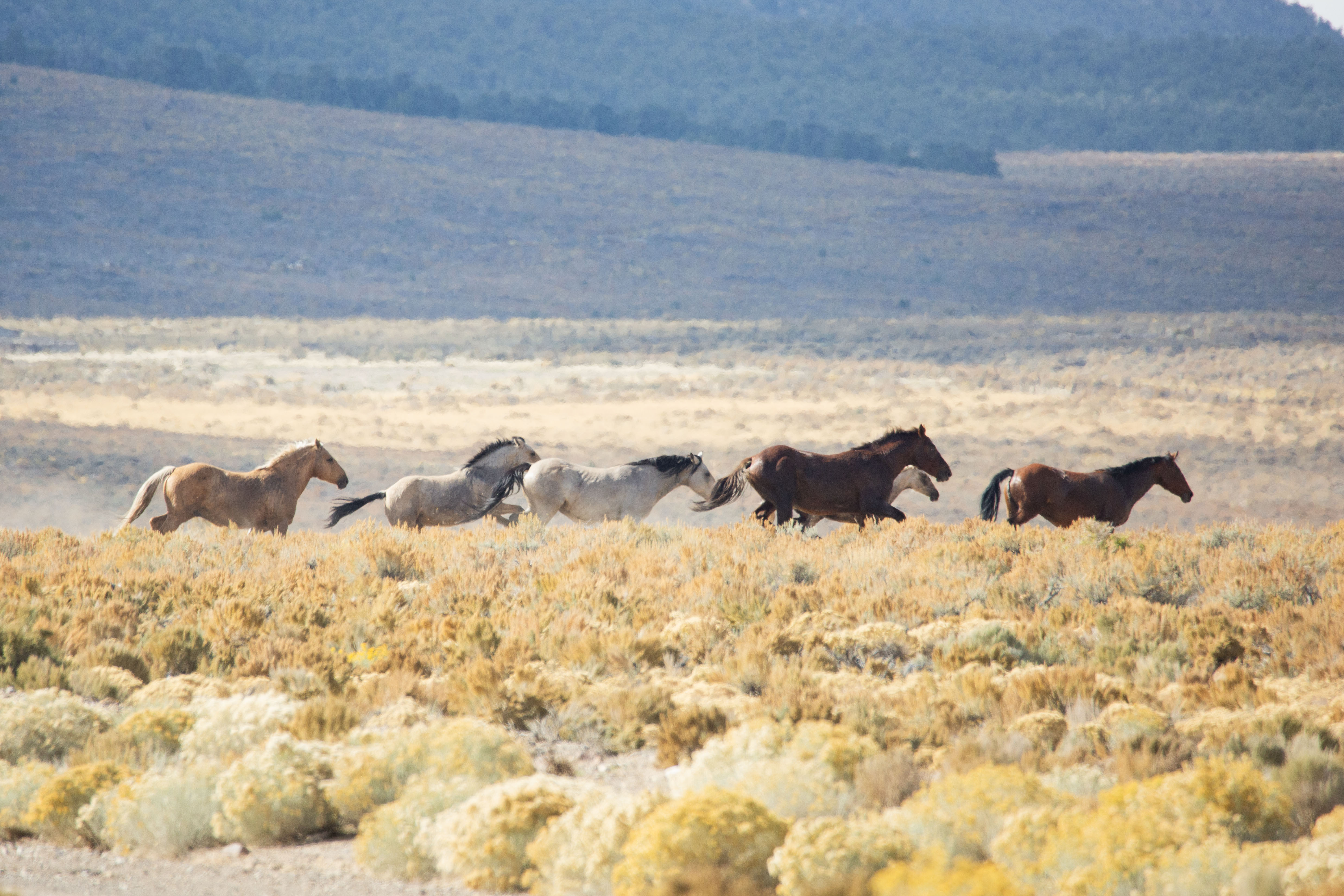
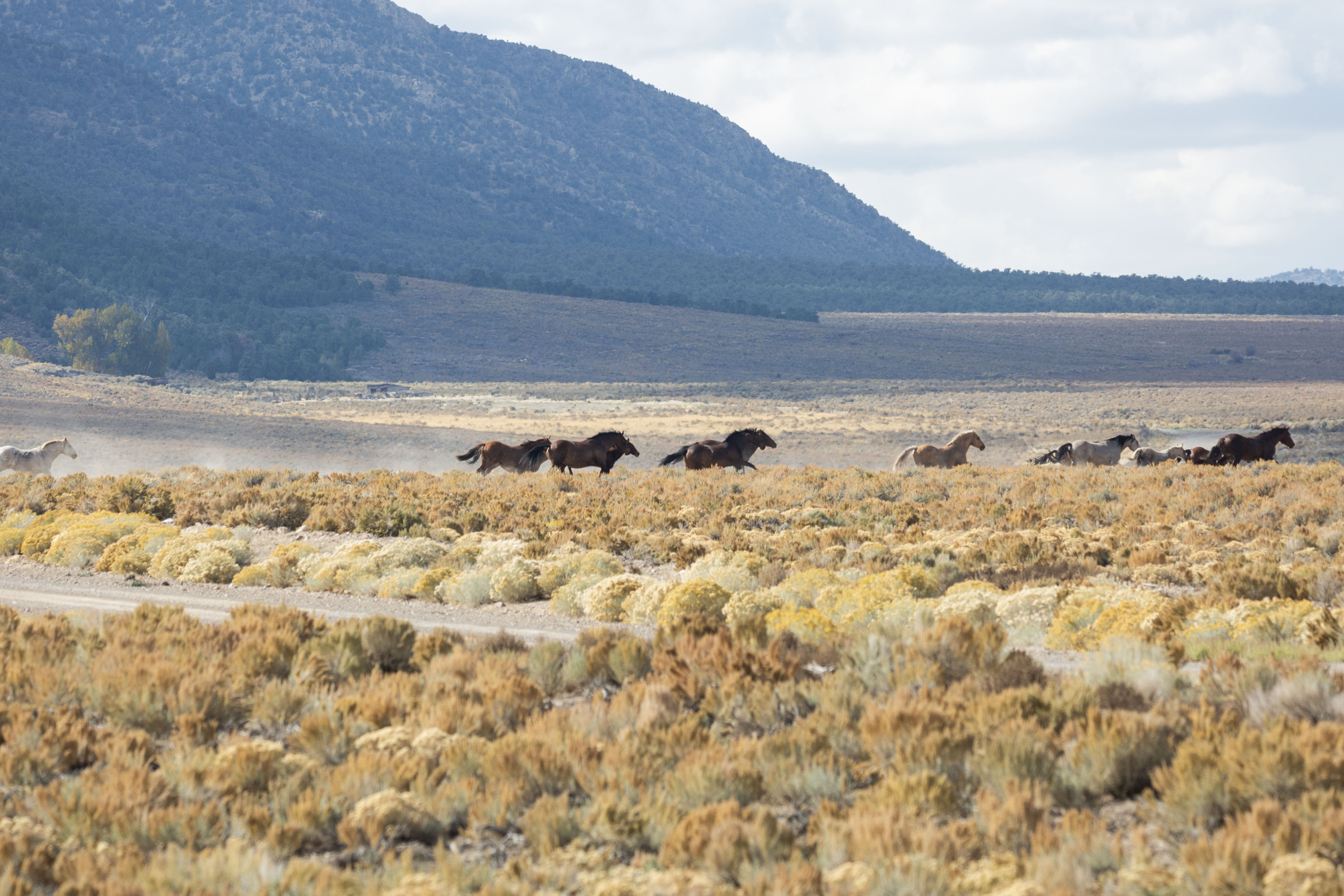
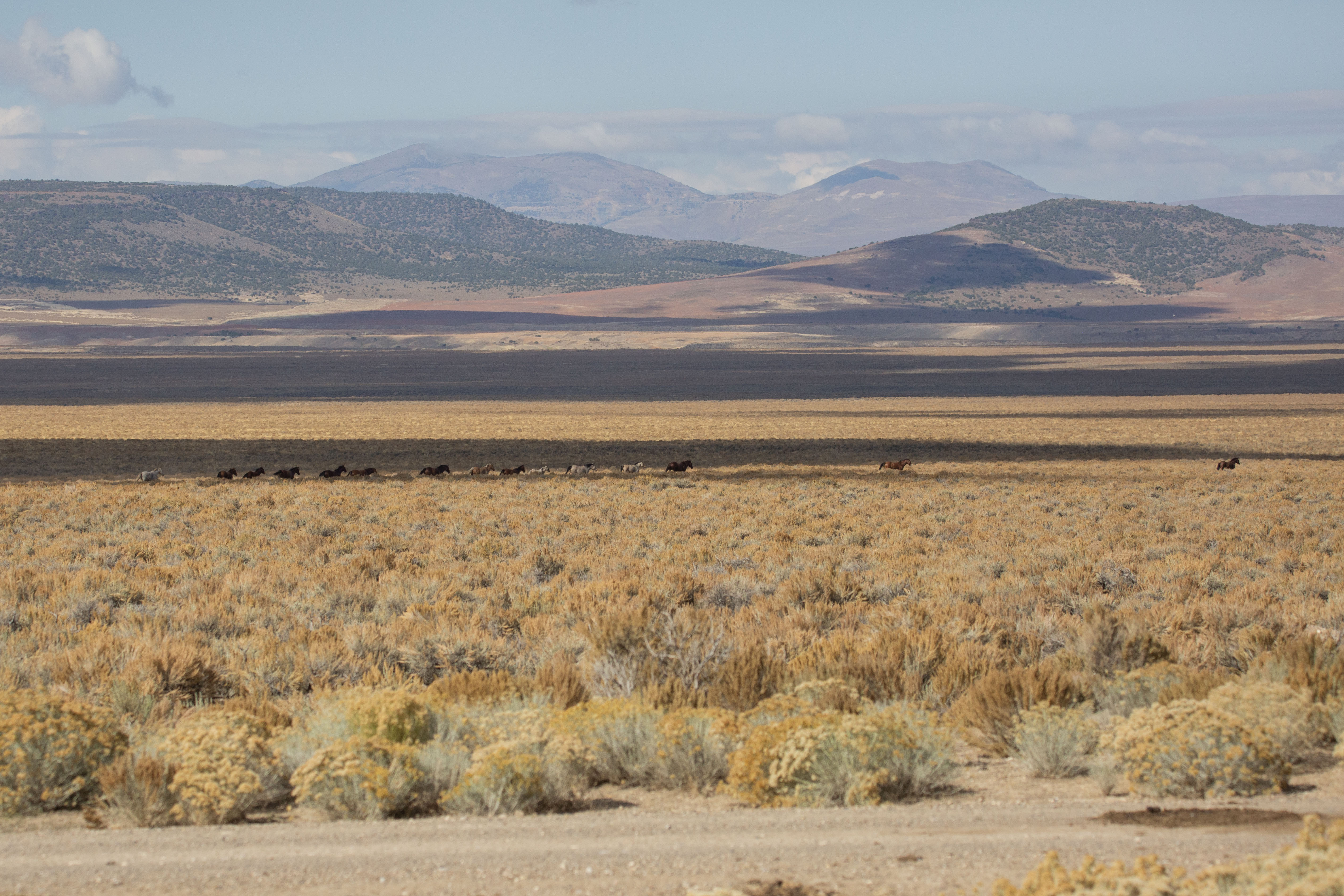
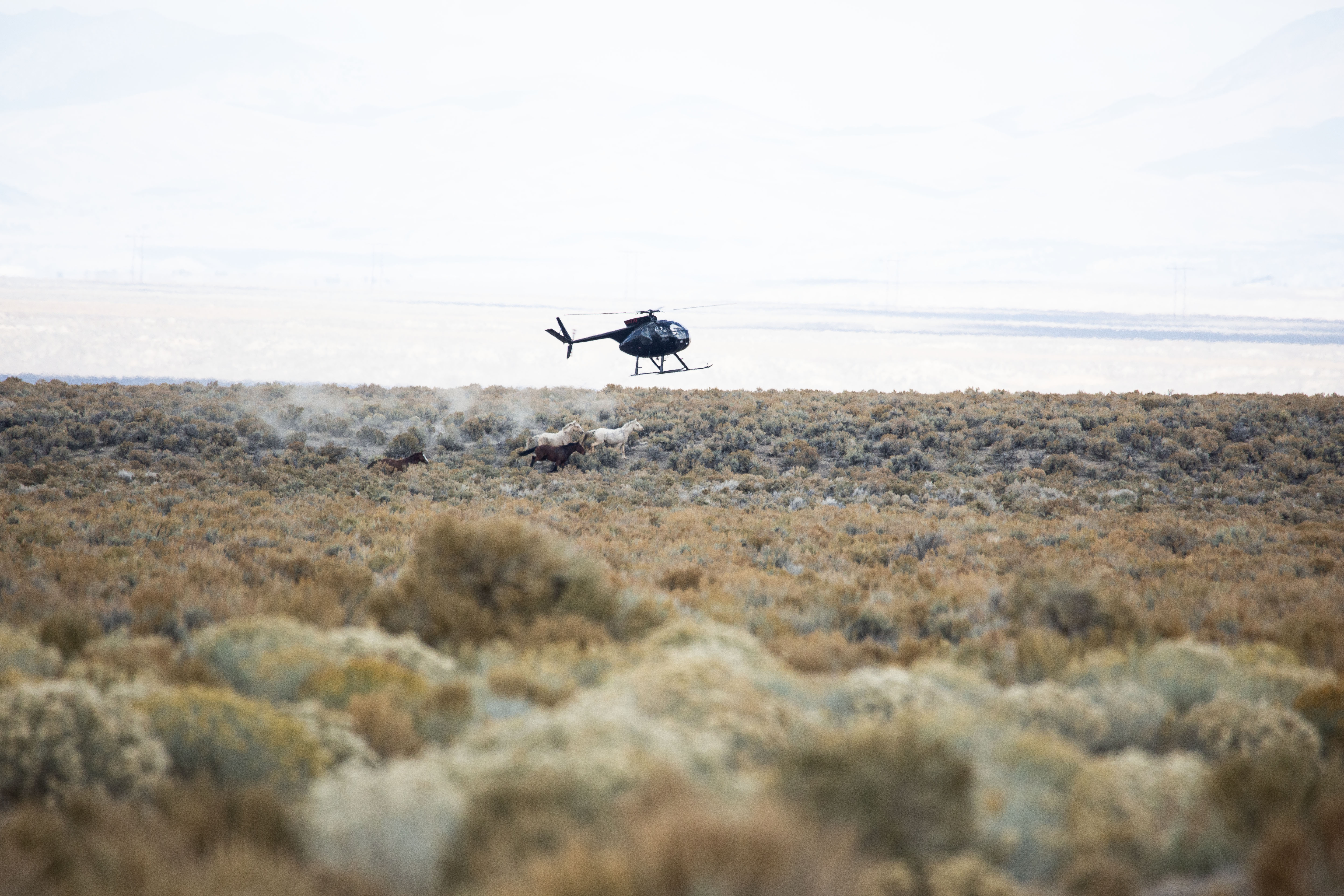
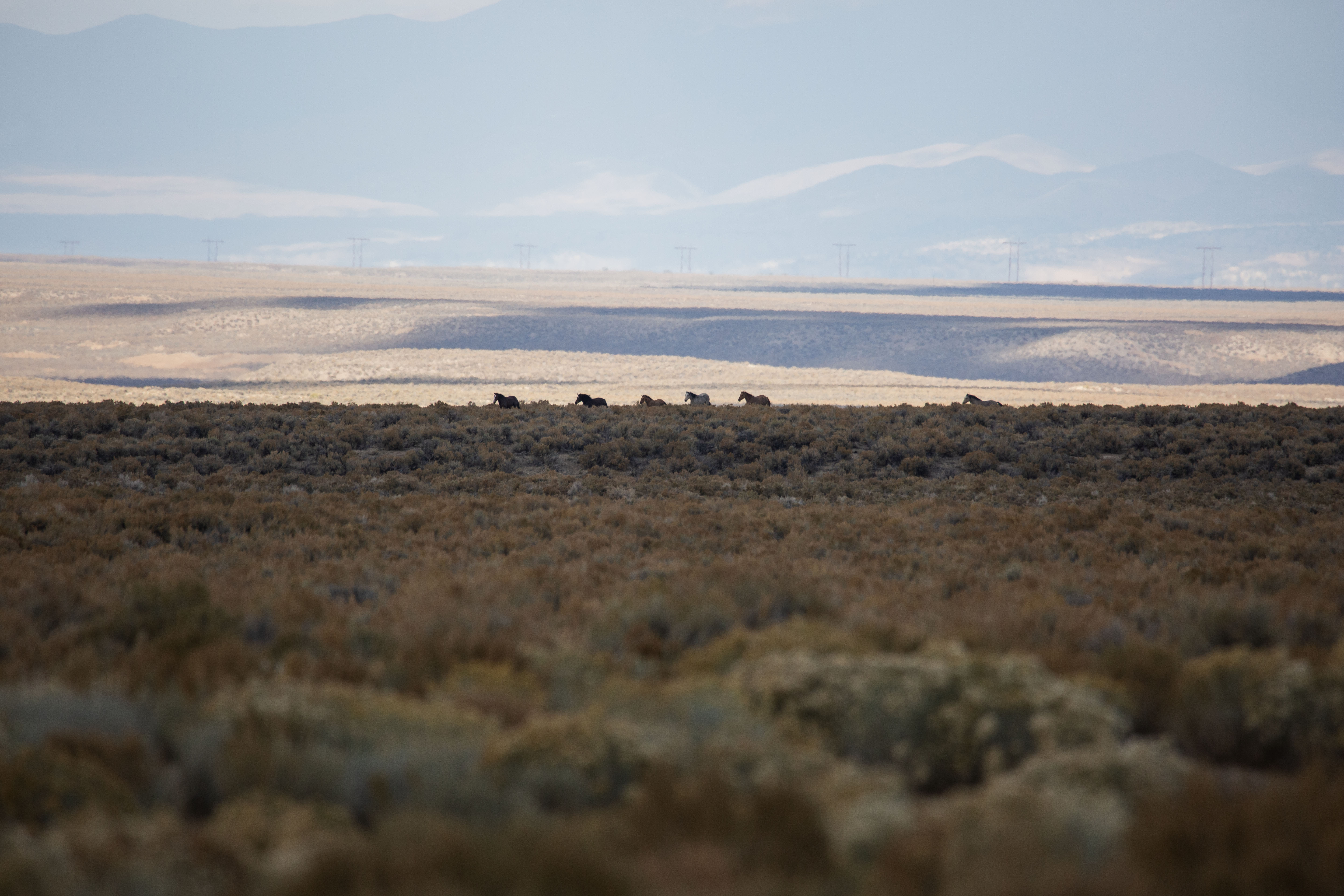
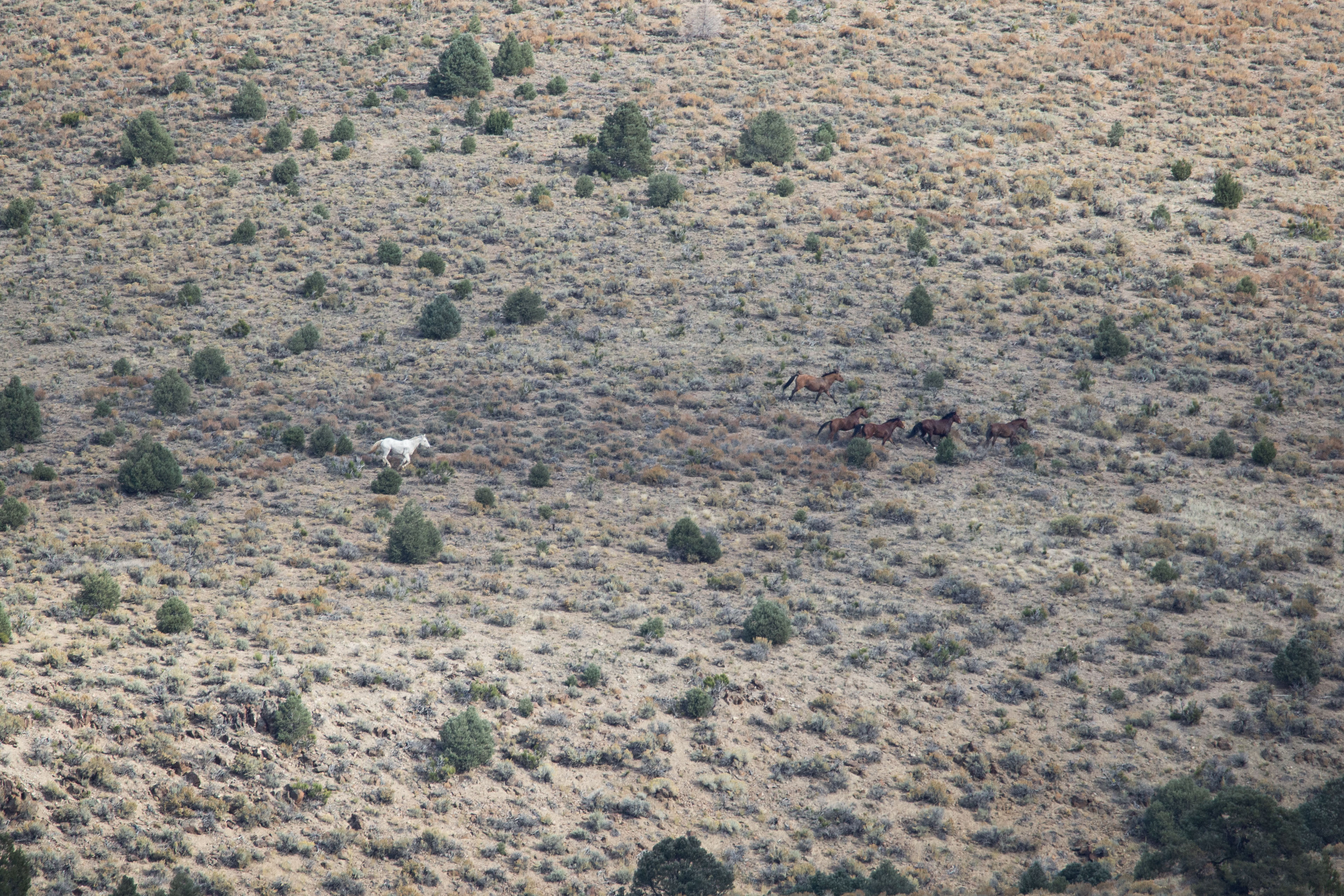
October 22, 2023: 86 wild horses were captured.
We arrived at the Eureka Fairgrounds at 5:15 am and left at 5:30 to go to the first trap site, which is about 5 miles southwest of Alpha in a big valley. The trap site is located on the far north side of Roberts Mountain HMA. To reach the observation area, we drove 0.59 miles past the trap site and parked our vehicles in a big pit to keep them hidden and minimize distractions.
We noticed a lot of horse bands in the big valley, and they were expecting to capture a high number of horses that day. As we were setting up our chairs and gear, a band of 6 horses came trotting past us within 50 feet, seemingly unfazed by our presence.
During the first hour of flying, the pilot managed to bring in 3 different bands, each consisting of around 6 horses. The pilot's maneuvers were quite intense right from the start. The horses, being fresh and energetic in the cold morning, may have been less cooperative. However, once they reached the mouth of the trap, they rarely hesitated, and the trapping process seemed to go smoothly. None of the horses turned around once they entered the jutes.
The trap was located about 0.59 miles from our observation point. We could see most of the jutes, but the trap itself was mostly hidden by a hill as it was situated in a "dip." We had a view of the trailer loading, but it was too far away for me to see any details with my 600mm lens once the sun came out.
Around 8 am, another band of 6 horses came in, followed shortly by two ropers. The helicopter hovered around an area for a few minutes before leaving to bring in another band of 5 horses, which arrived at 8:23 am. At 8:30, a foal was successfully roped and guided to the trap site at its own pace. At 8:47, another band of 6 horses came in, and although one horse took a tumble, it quickly got back up and appeared to be fine. After this run, the pilot landed and refueled.
An hour passed before the pilot brought in the next group of 15 horses. The larger group had a smooth run, but the 4 horses that veered off required intense maneuvering once again. After 15 minutes, they entered the trap. After this run, the pilot found two separate bands, each consisting of 4 horses. He attempted to have the two bands follow each other into the trap, but one band's smart horse led them in the opposite direction, veering off to the west. The cooperative band entered the trap without any issues, while the other 4 horses moved closer, coming directly towards us. The pilot tried to get them to turn around, but they were determined and kept going. Eventually, they ran within 50 feet of the closest observer. The helicopter was almost directly behind us, putting us in the middle of the action. Surprisingly, the horses paid no attention to us as we stood as still as possible. They appeared to be sweaty. The pilot chased them for a while but eventually had to drop them and return to refuel.
At noon, a larger group of 12 horses was spotted in the distance. This time, the pilot gave them more room to travel at their own pace, which wasn't possible in the previous runs we observed. As they approached the mouth of the trap, the pilot had to make low maneuvers again, but the run went smoothly, and the band entered the trap.
Over the next two hours, there were 3 more runs, one with a band of 13 horses and two with smaller bands of around 6 horses. All 3 runs seemed quick and without any issues.
At 3 pm, the roundup concluded for the day, and we headed to temporary holding. Temporary holding is set up off of Highway 50, about 48 miles from where the horses were rounded up that day. The fencing in the temporary holding area is solid, making it difficult to see the horses except for a few heads popping over the fencing. It's impossible to assess the condition of the horses. The mares seemed to be the most restless, which is understandable as some of them have foals they are protective of. Overall, the pens were fairly calm, and the horses had access to food and water.
